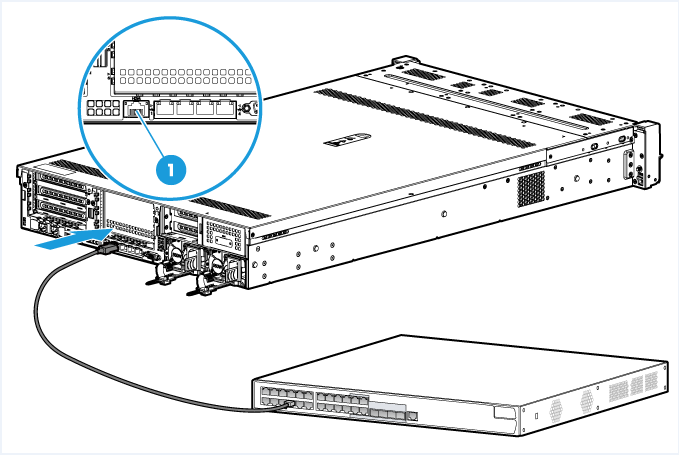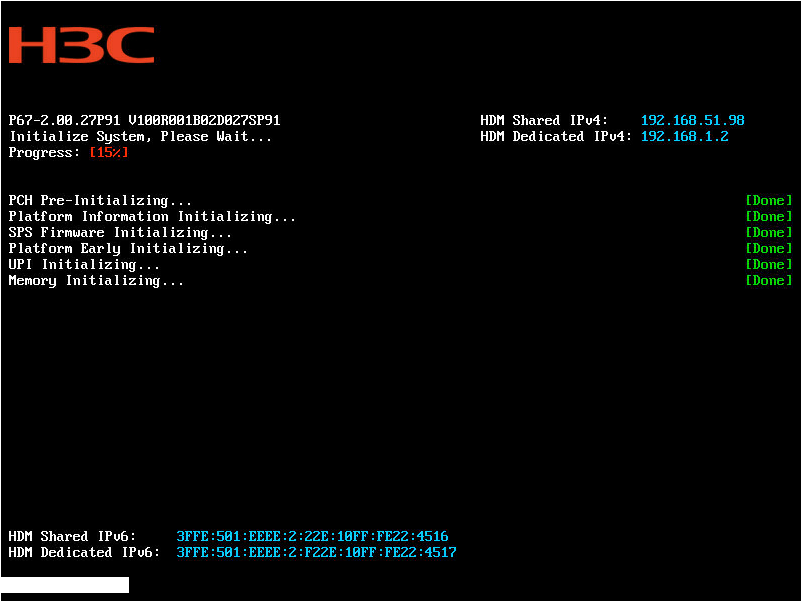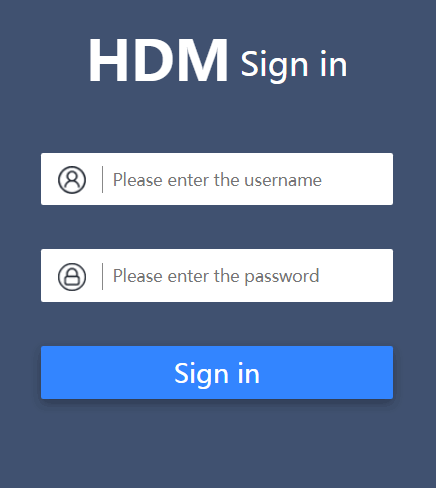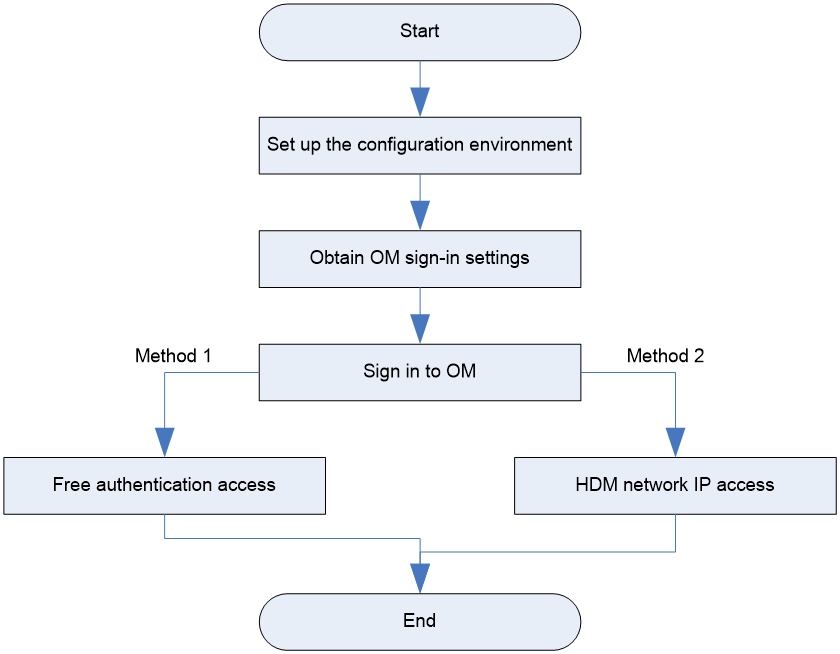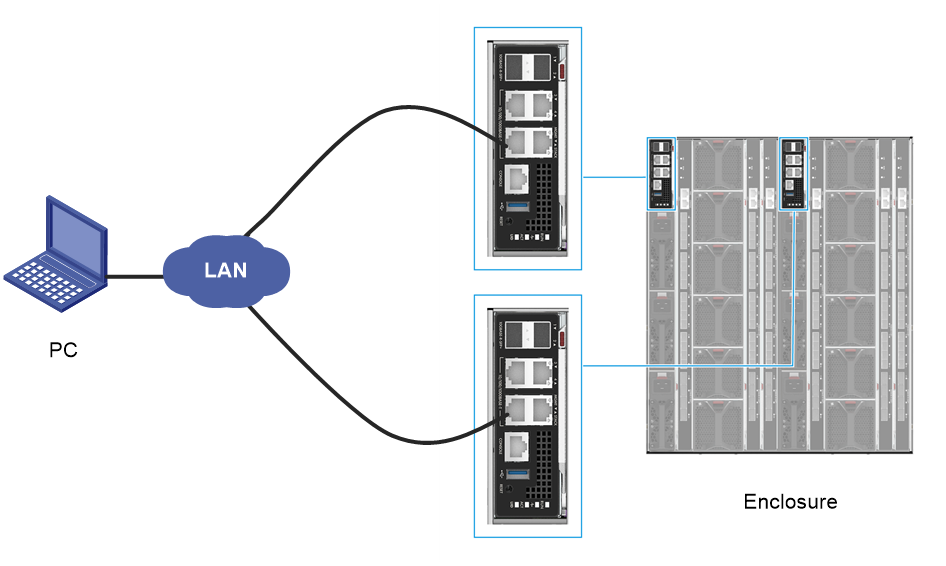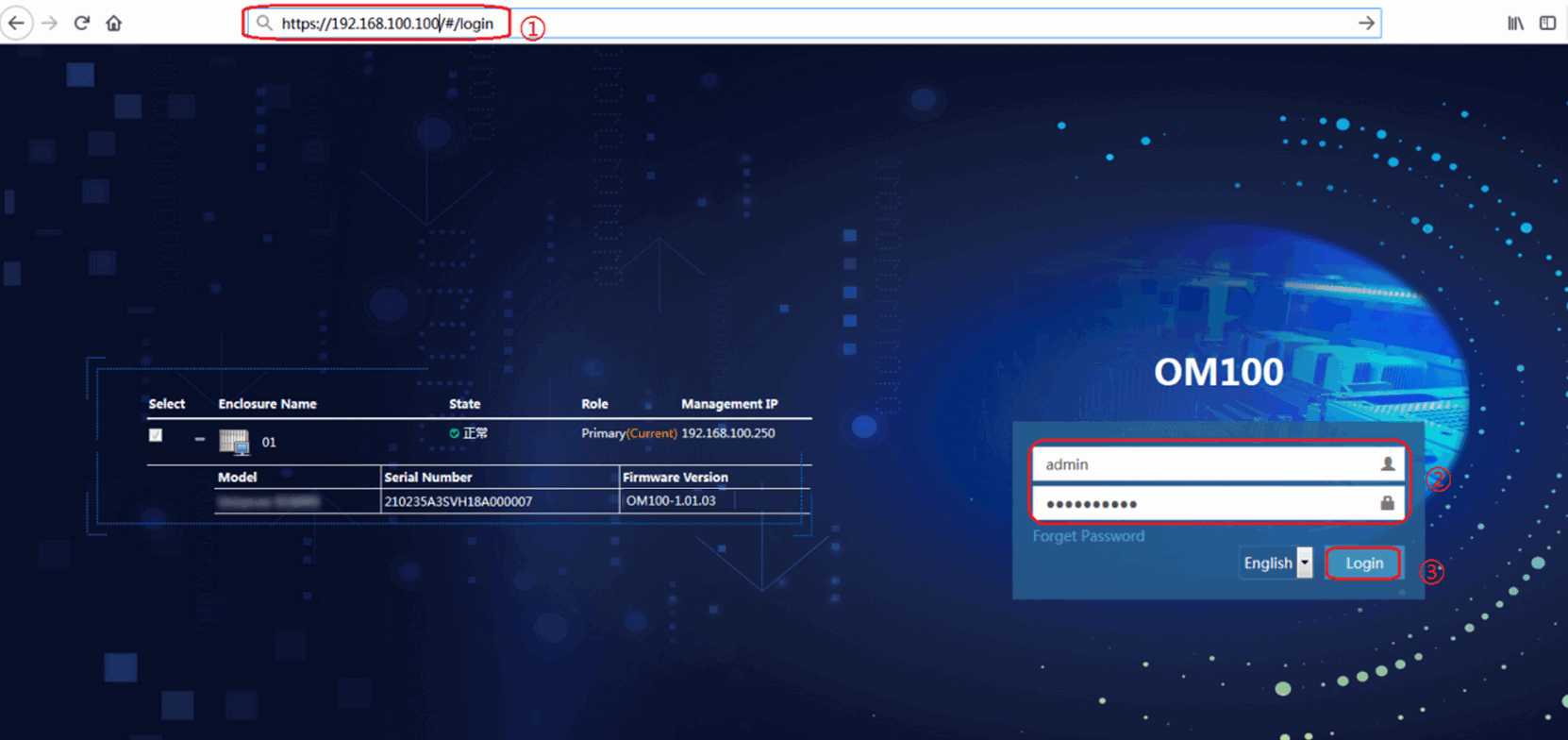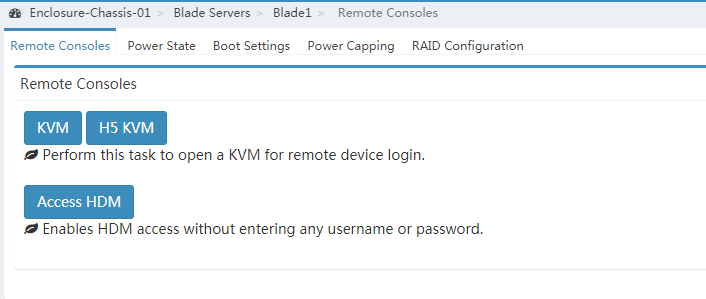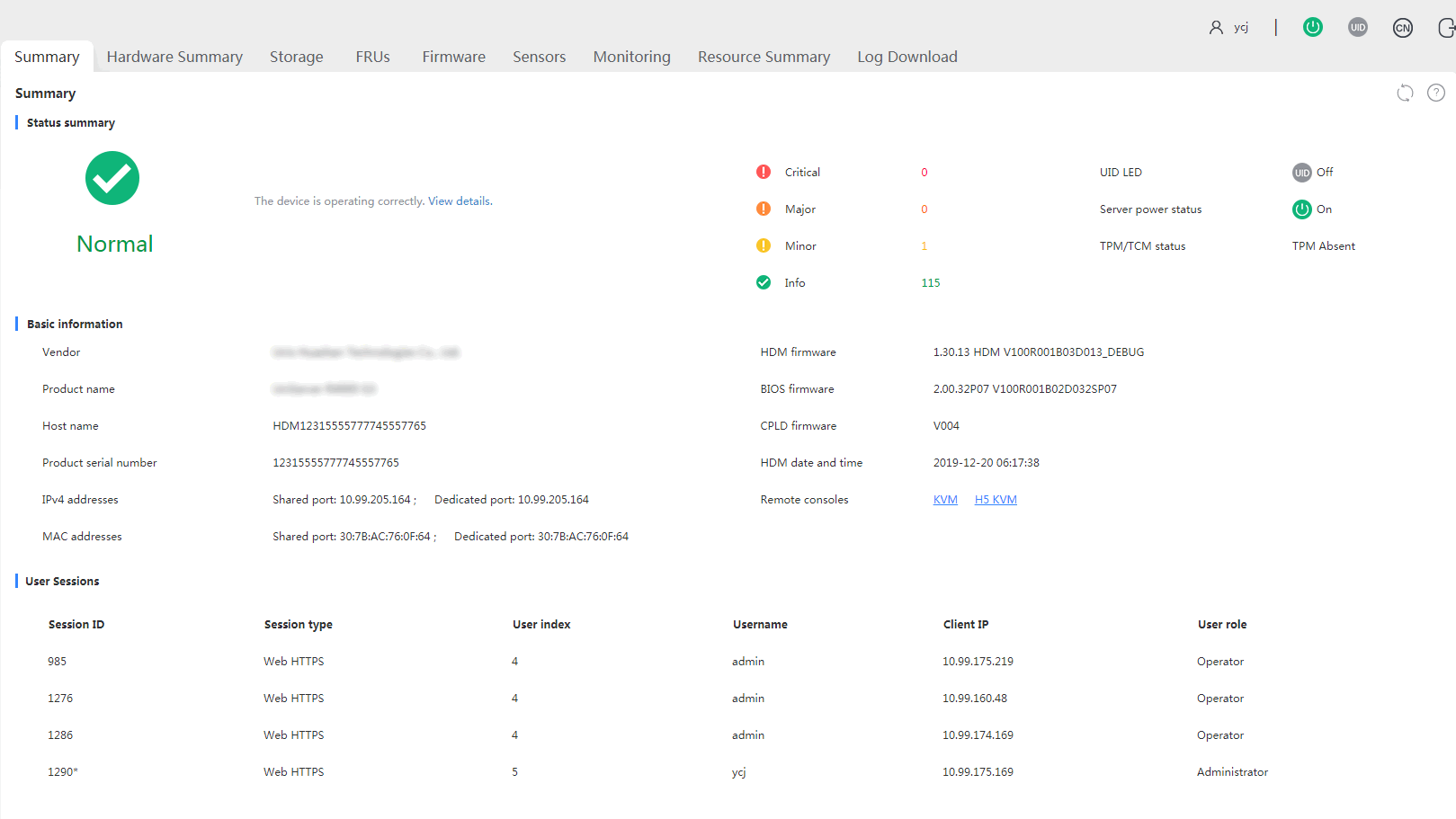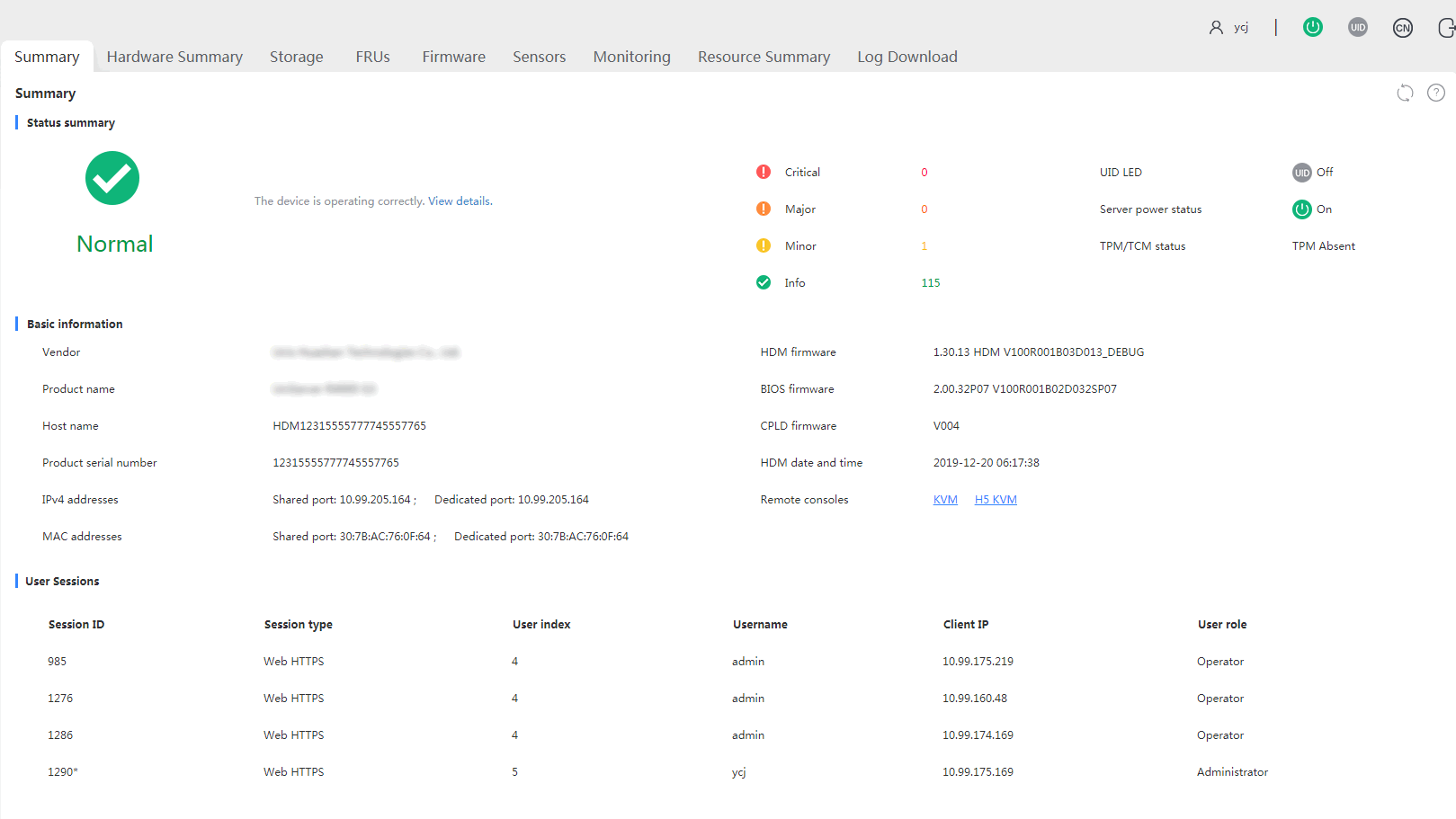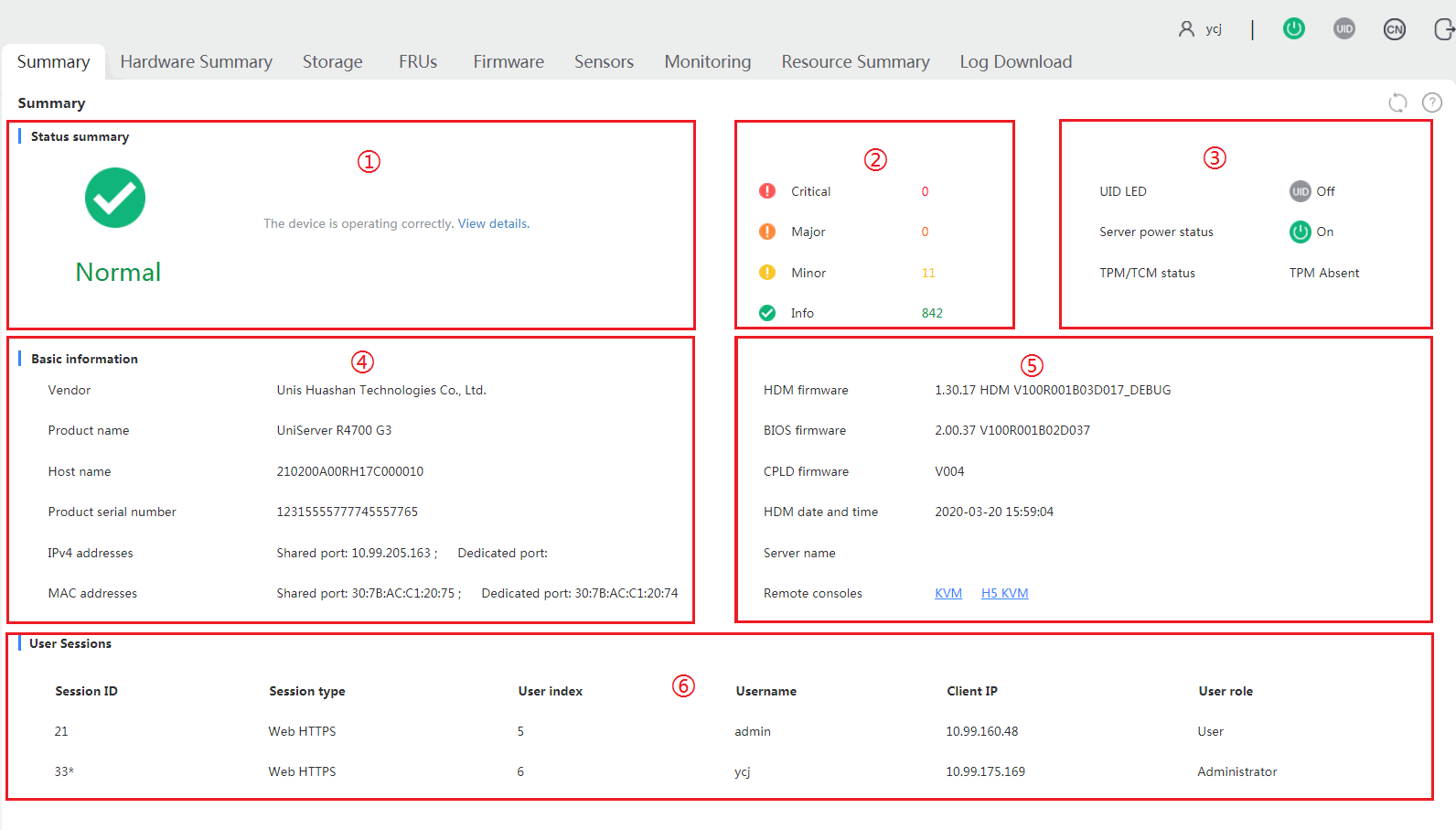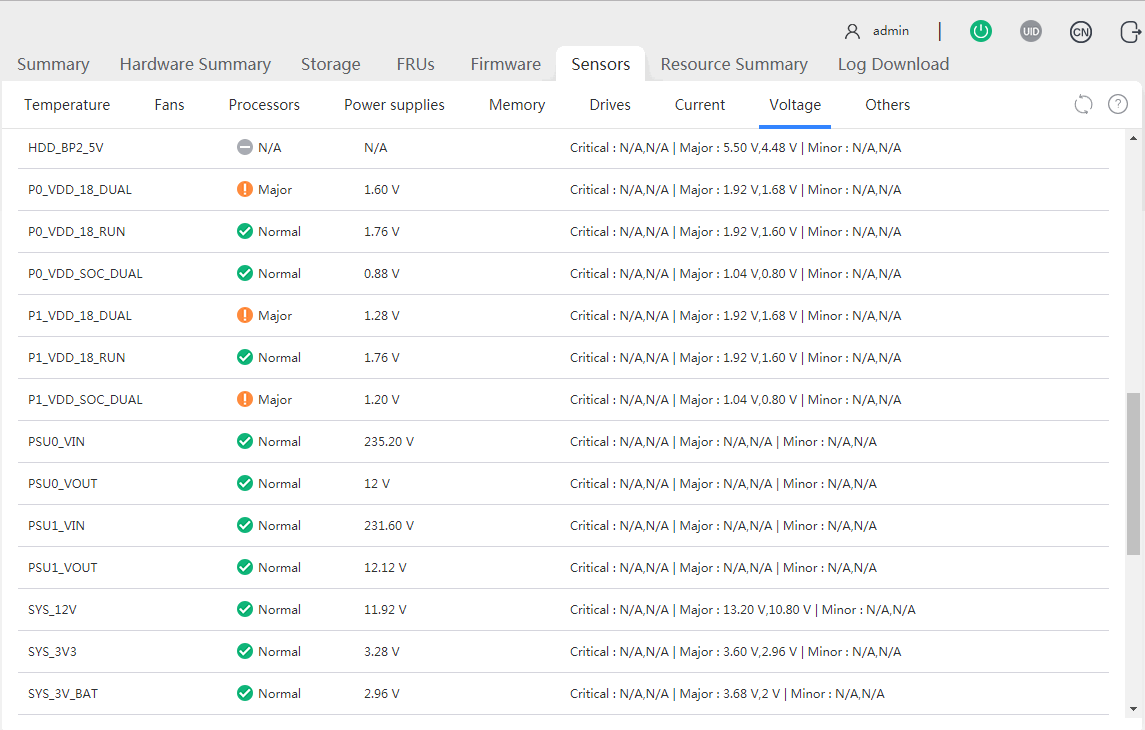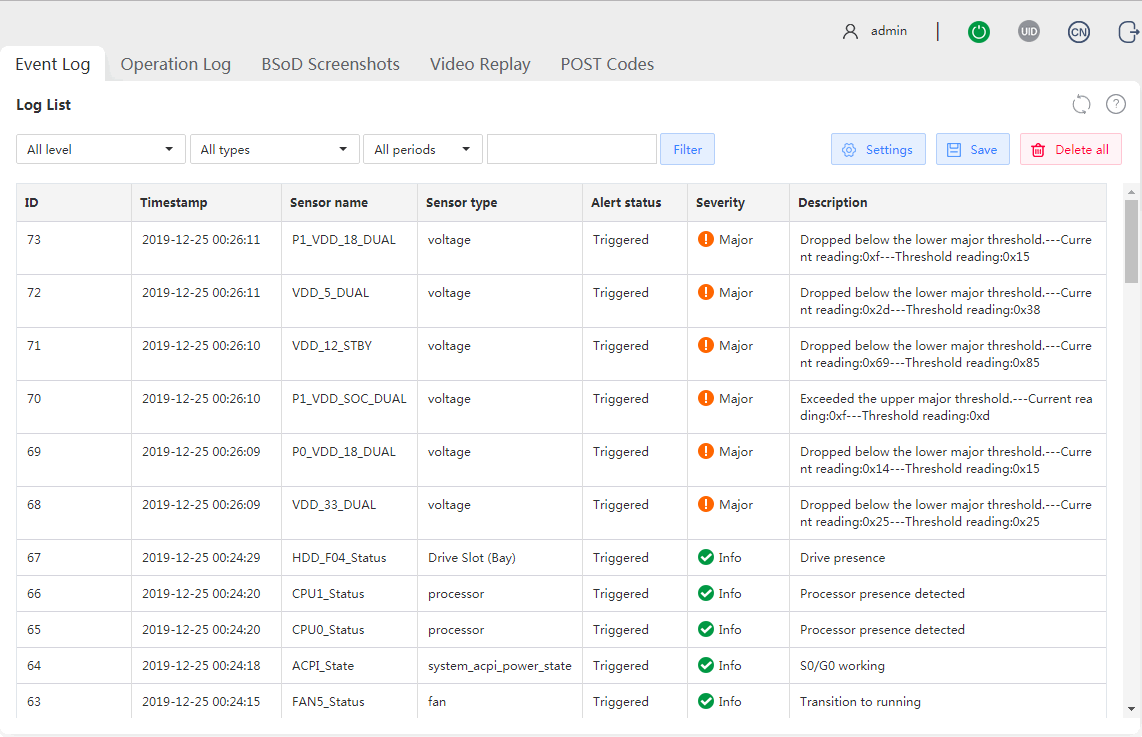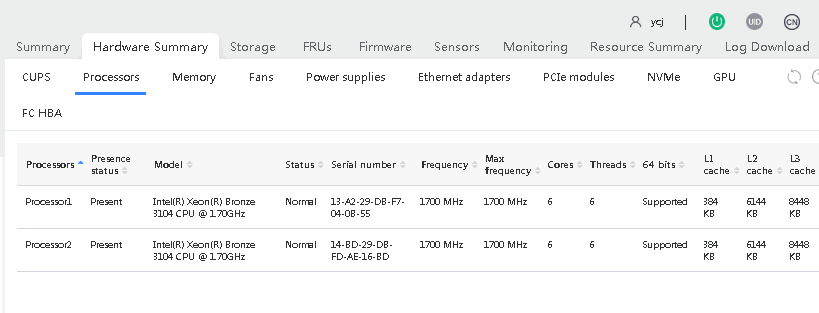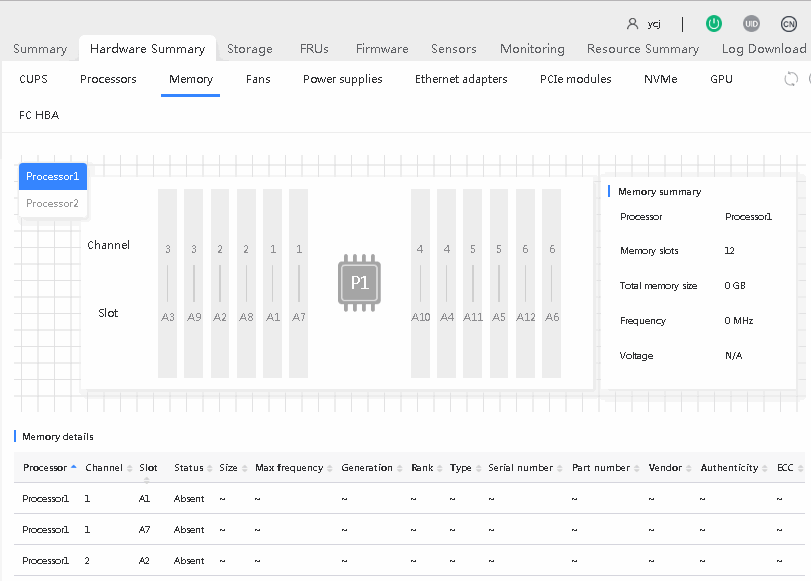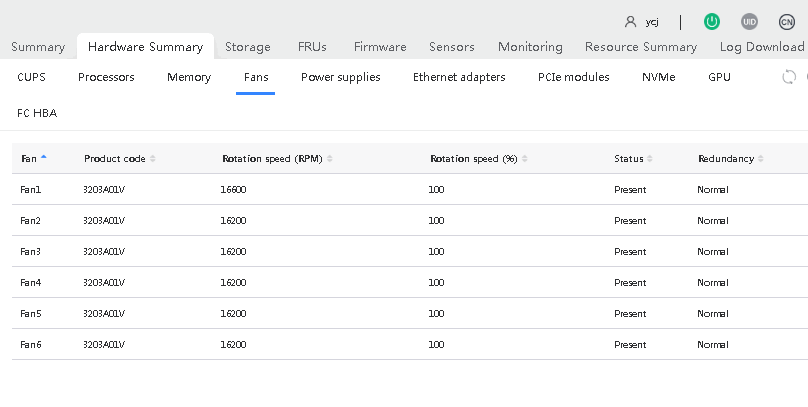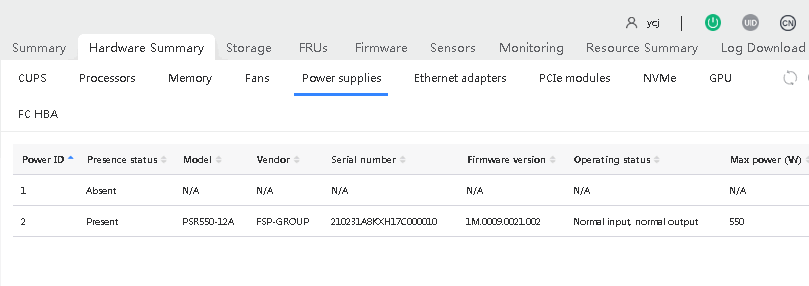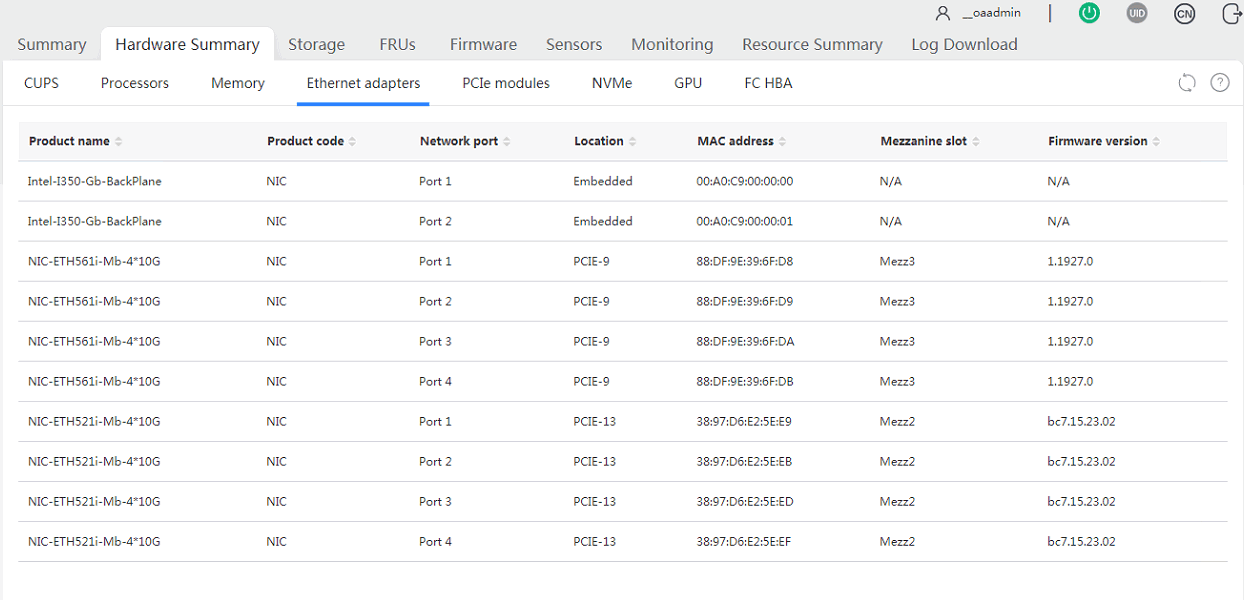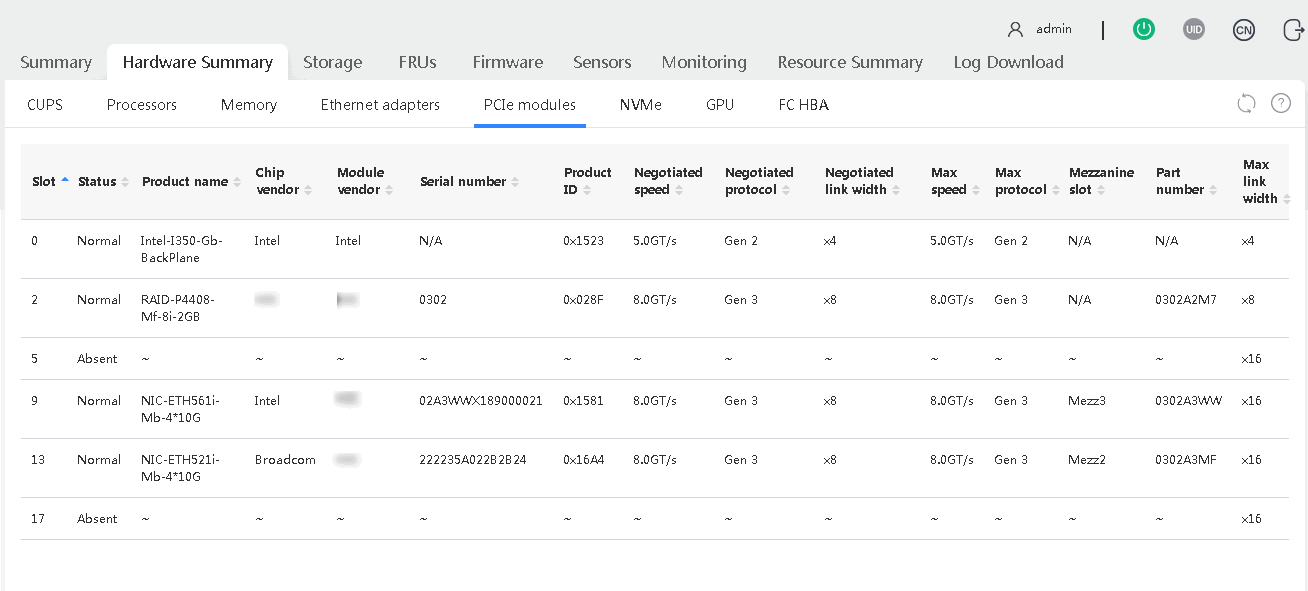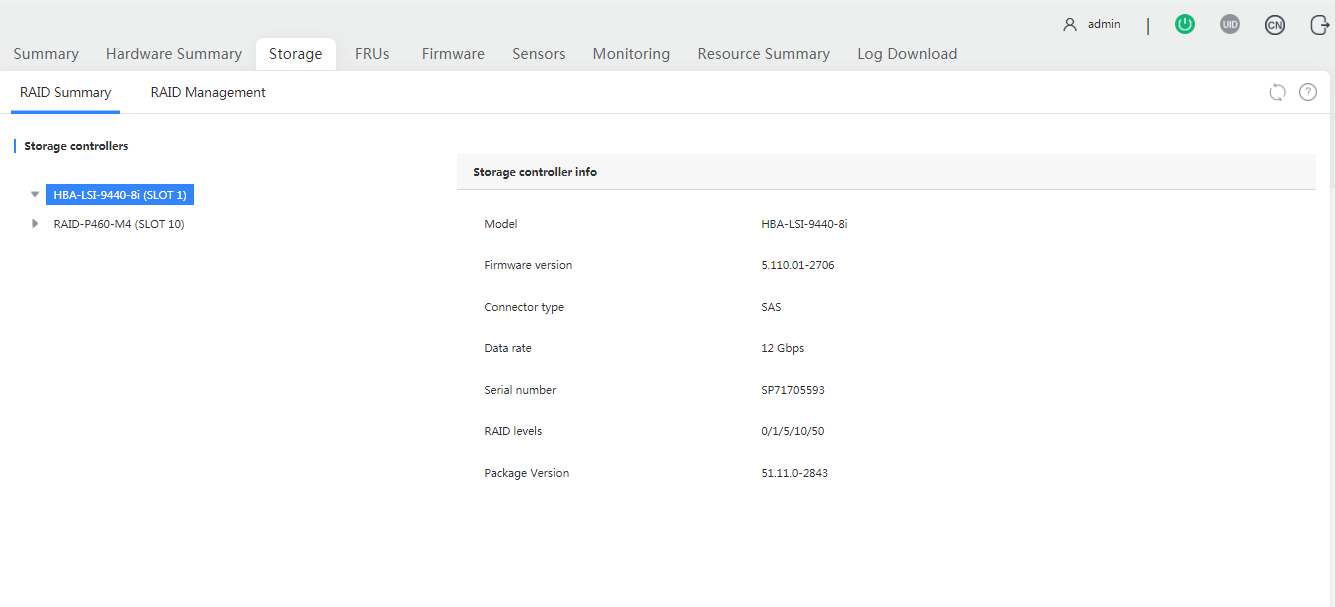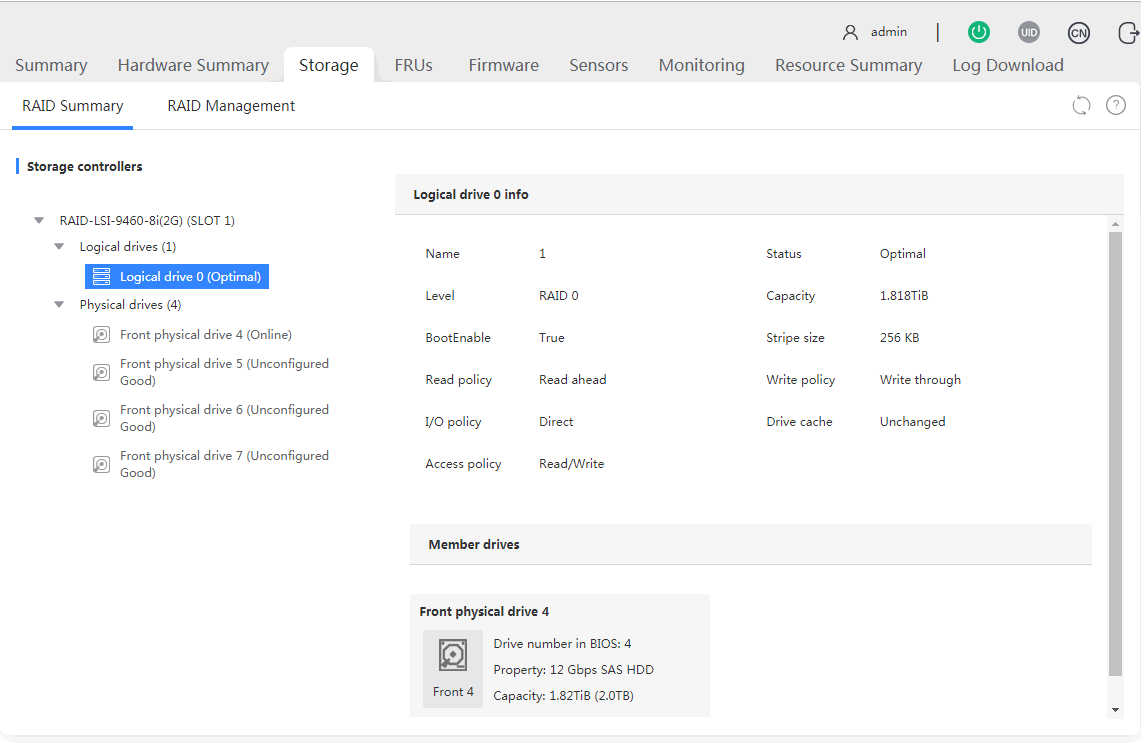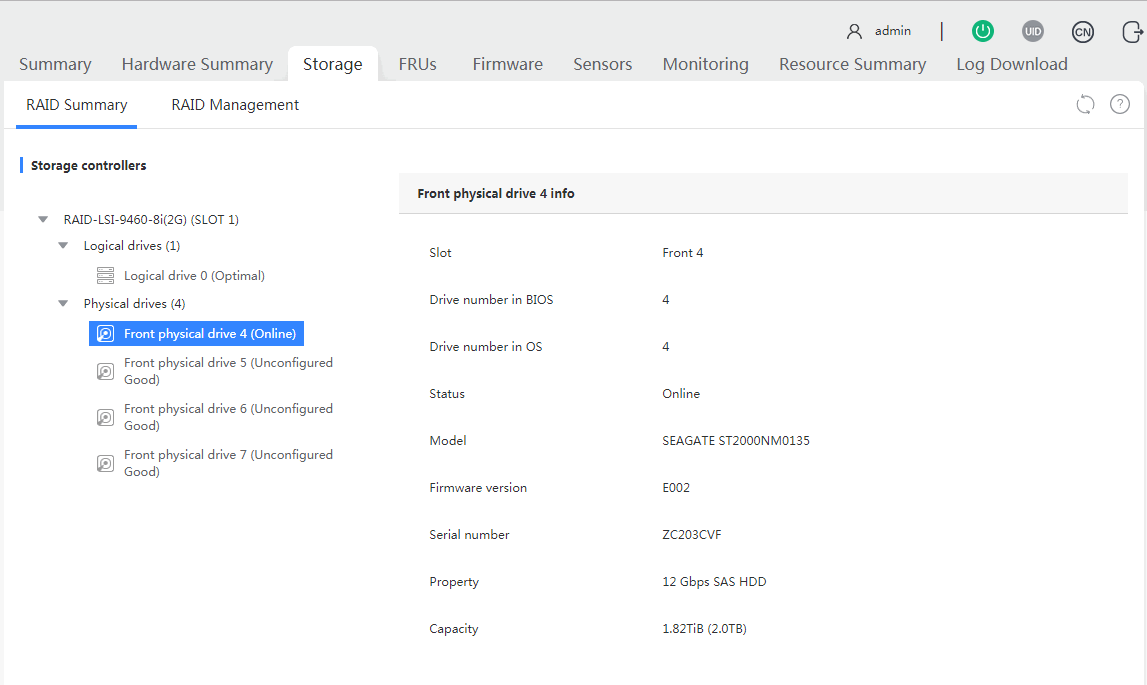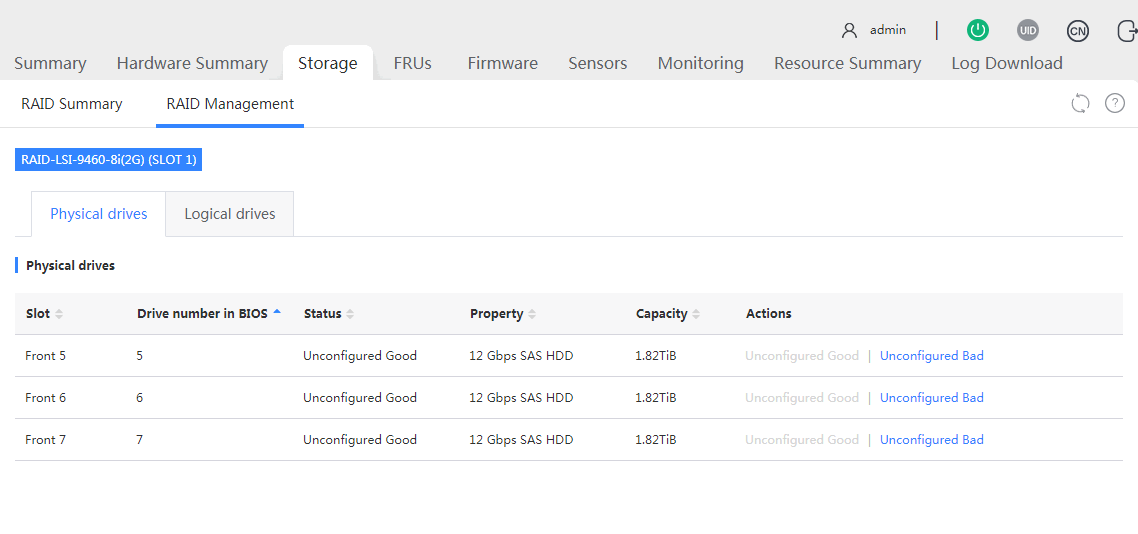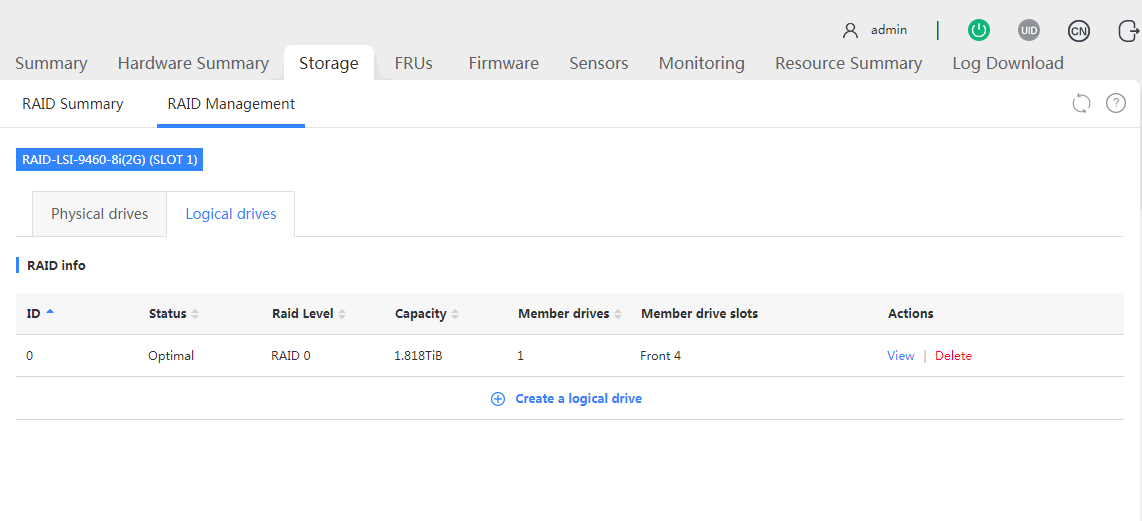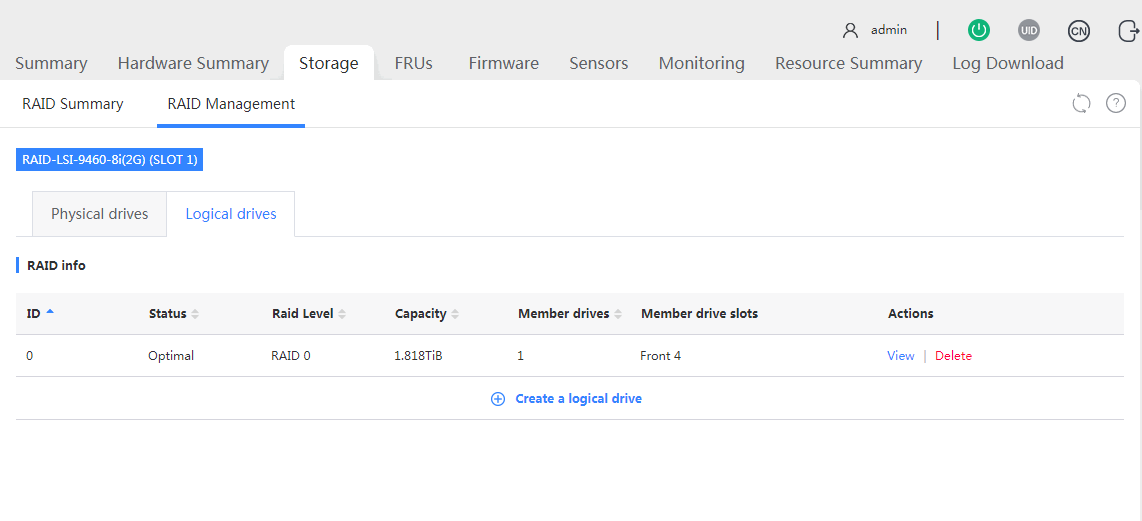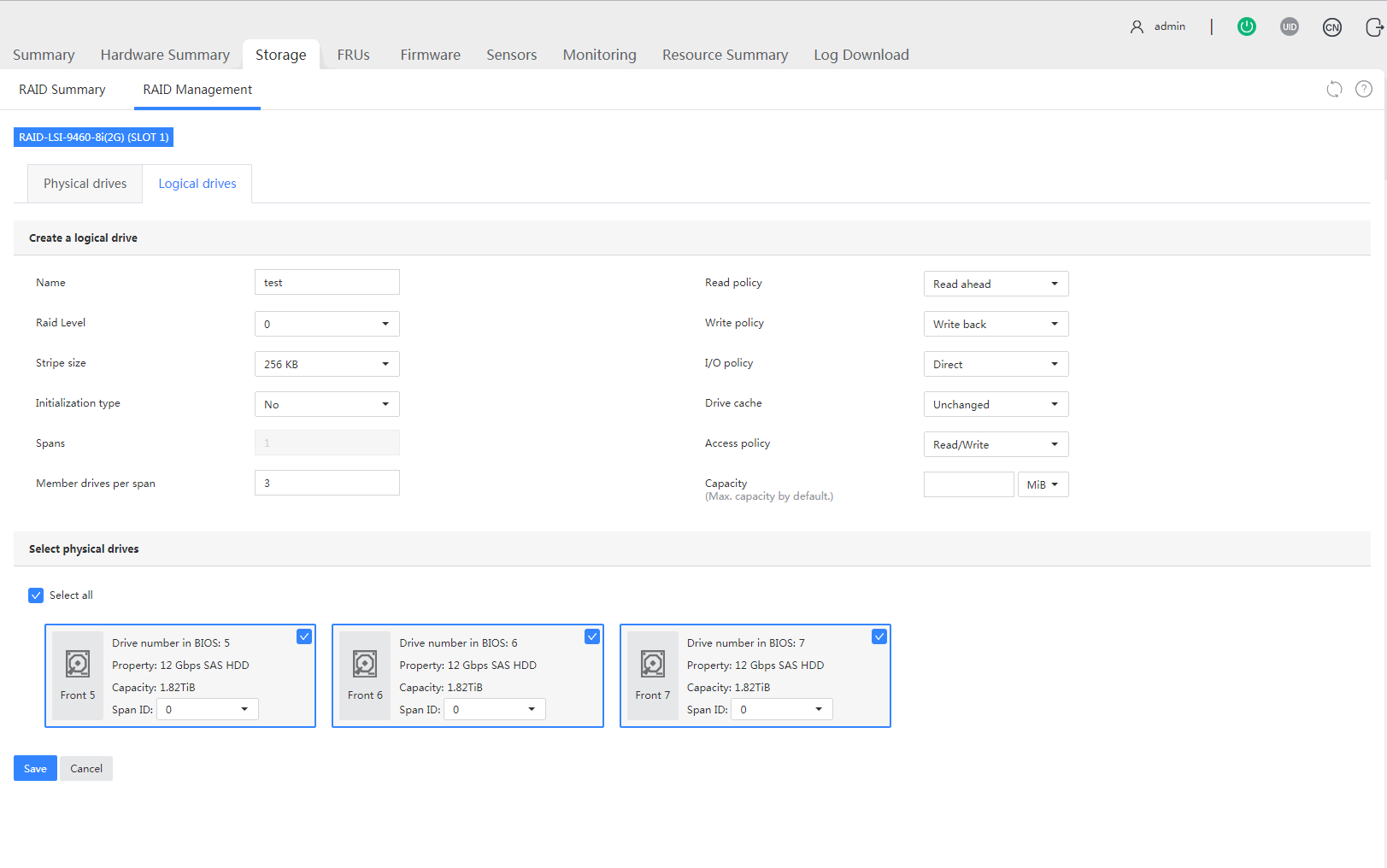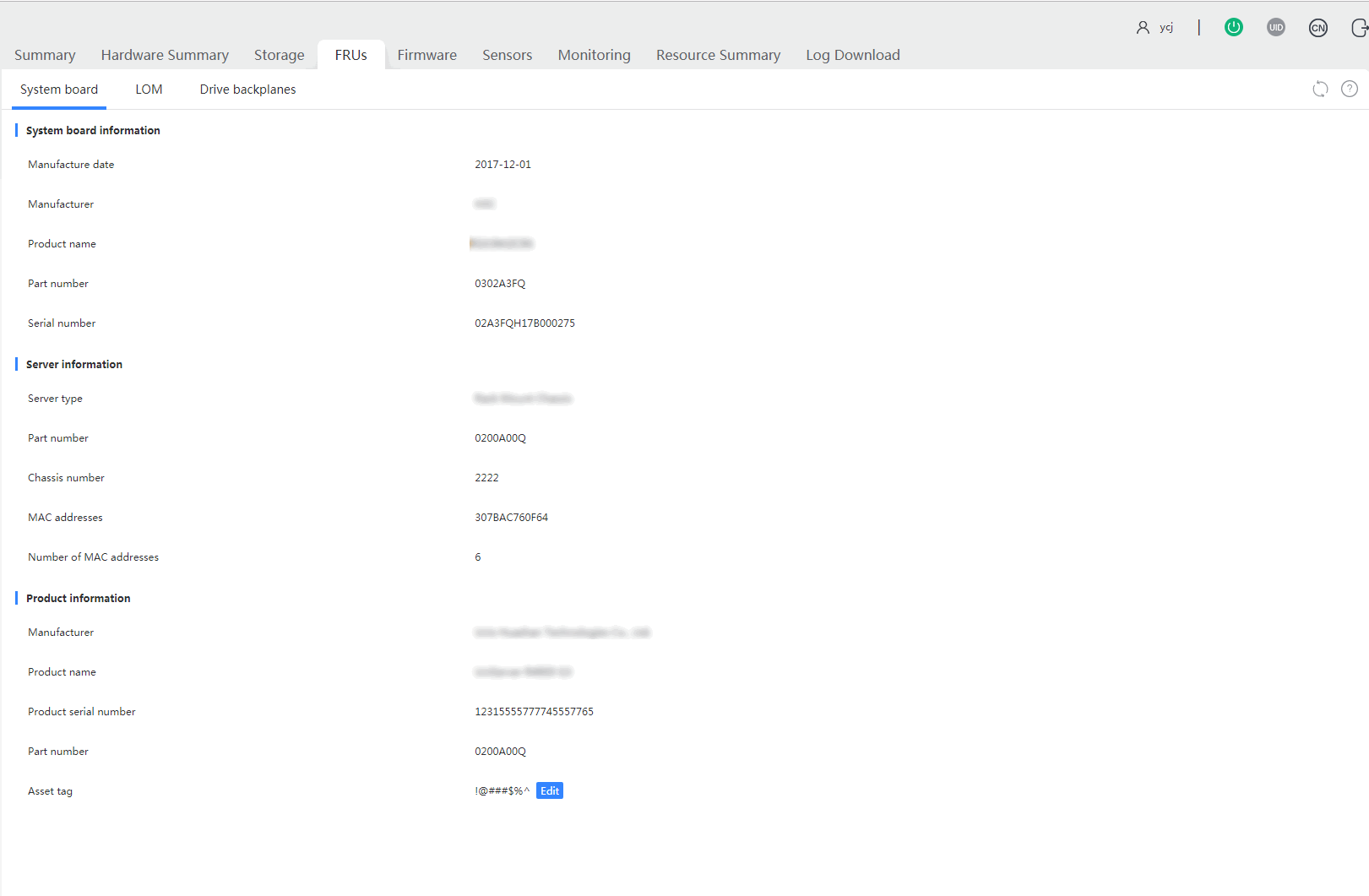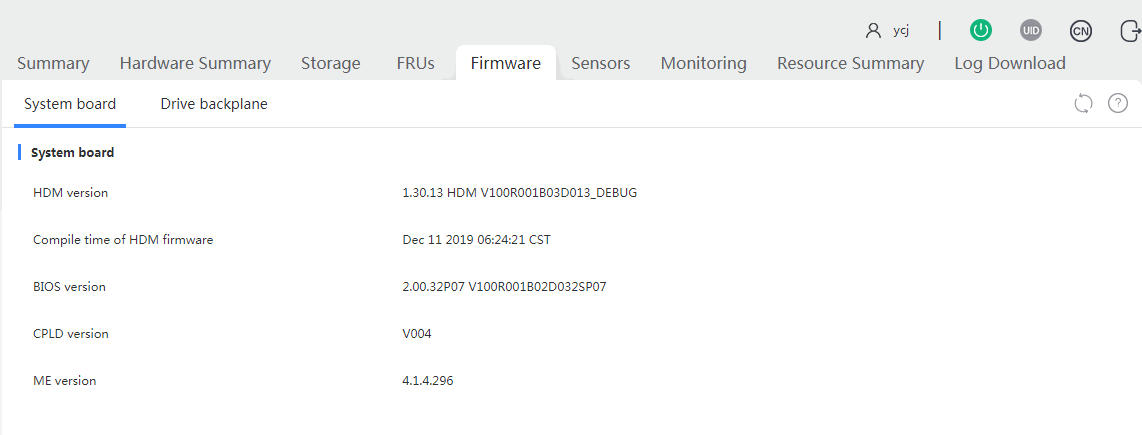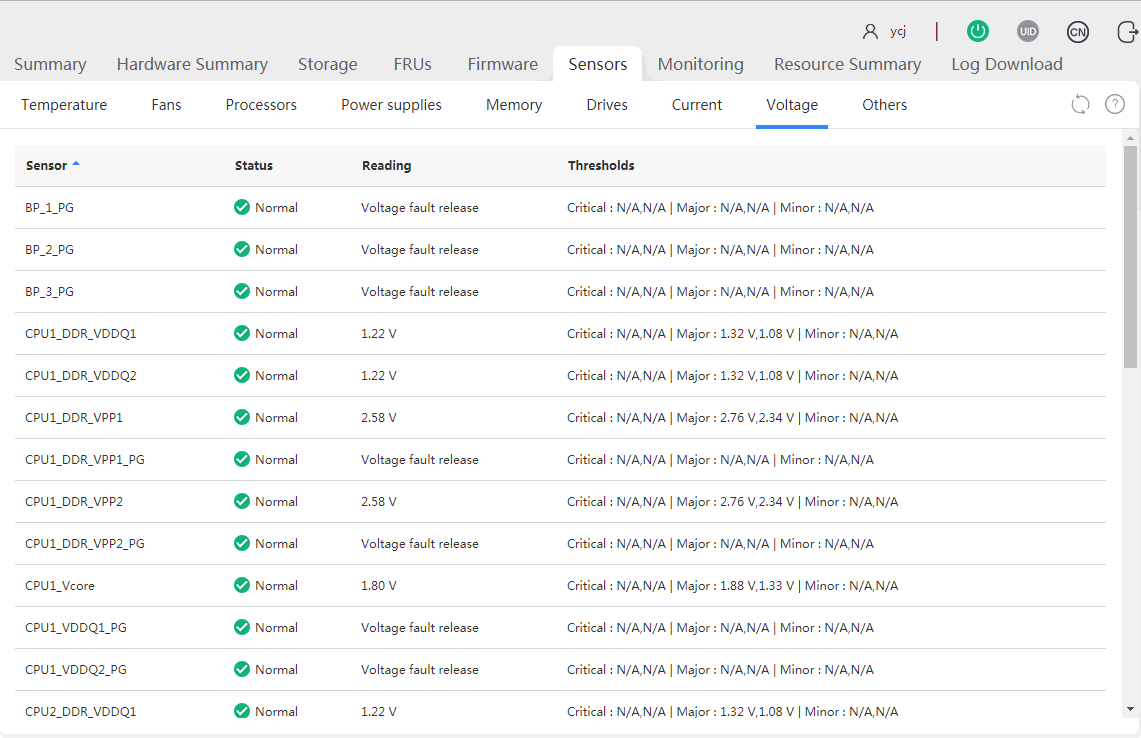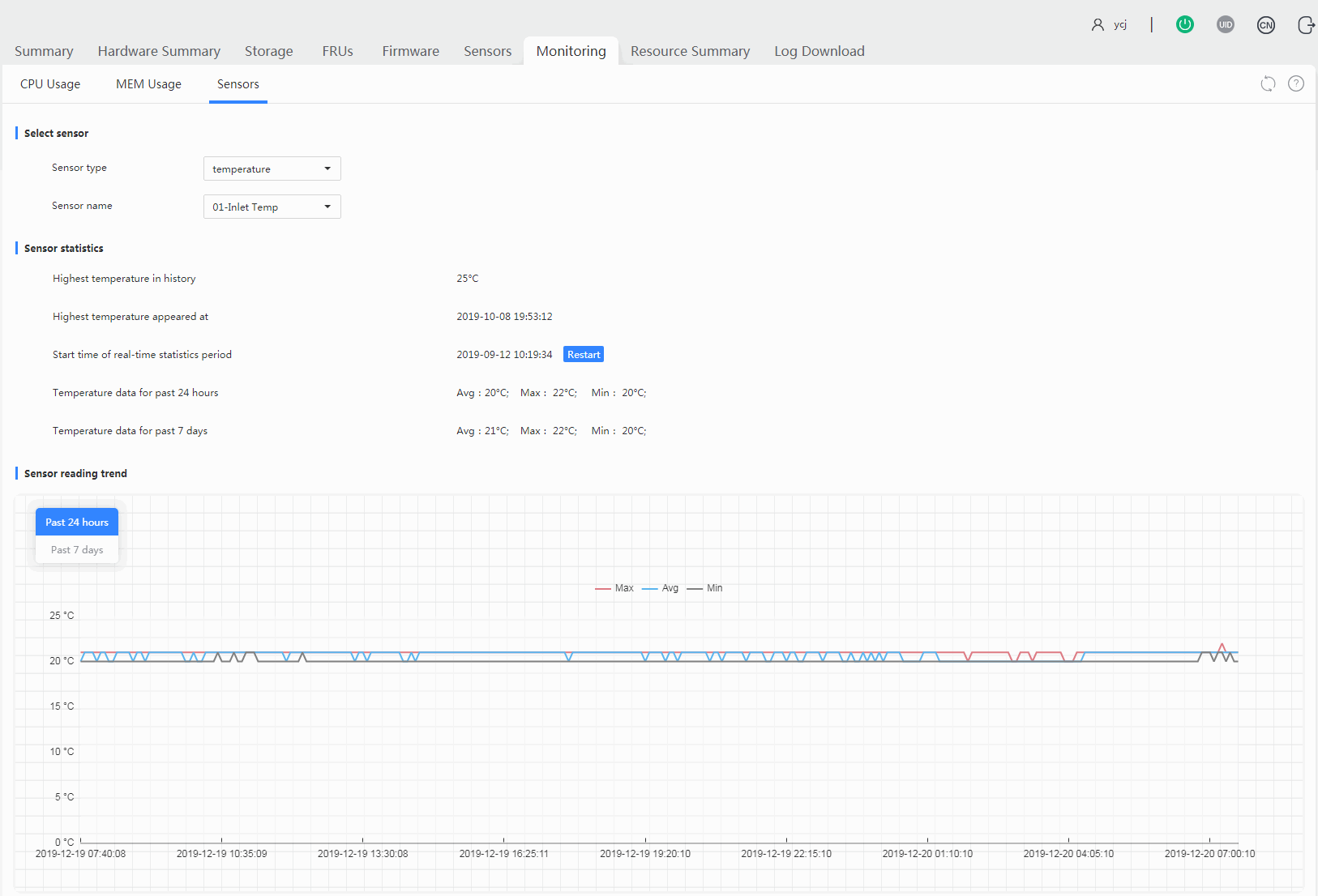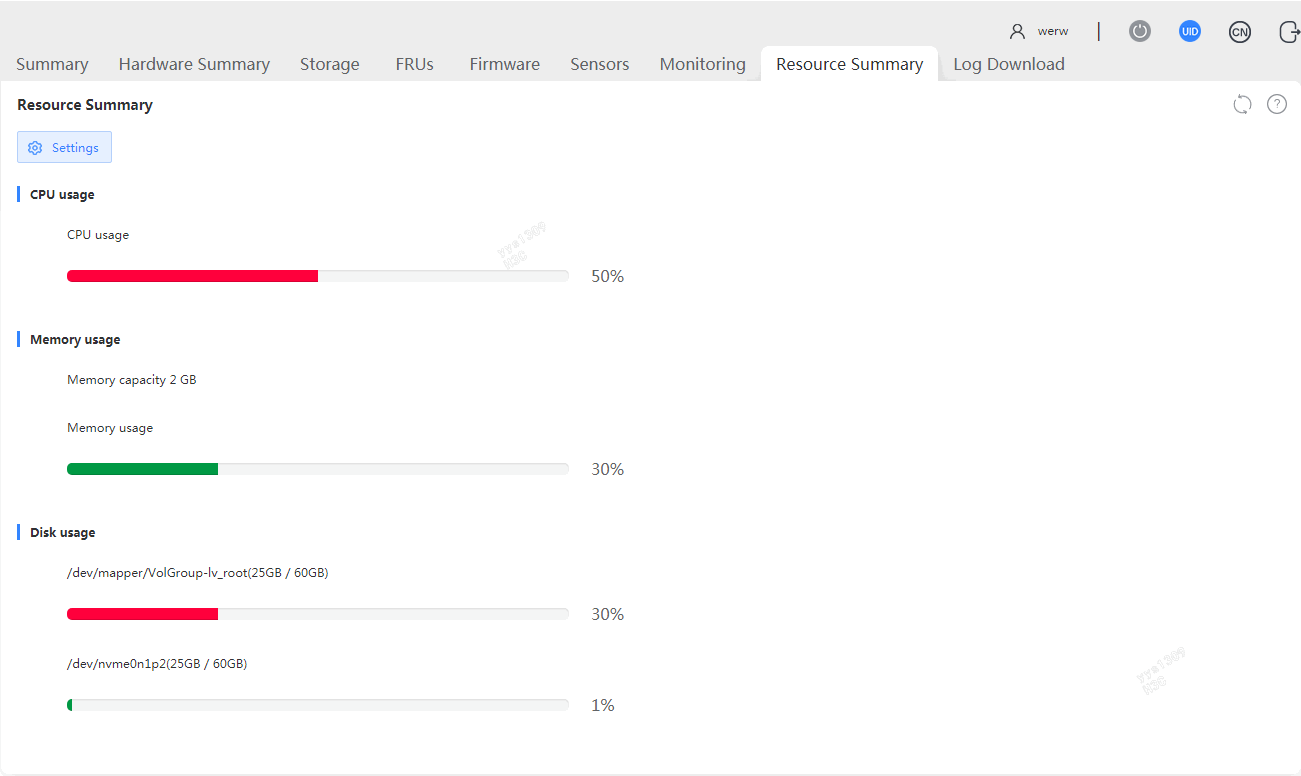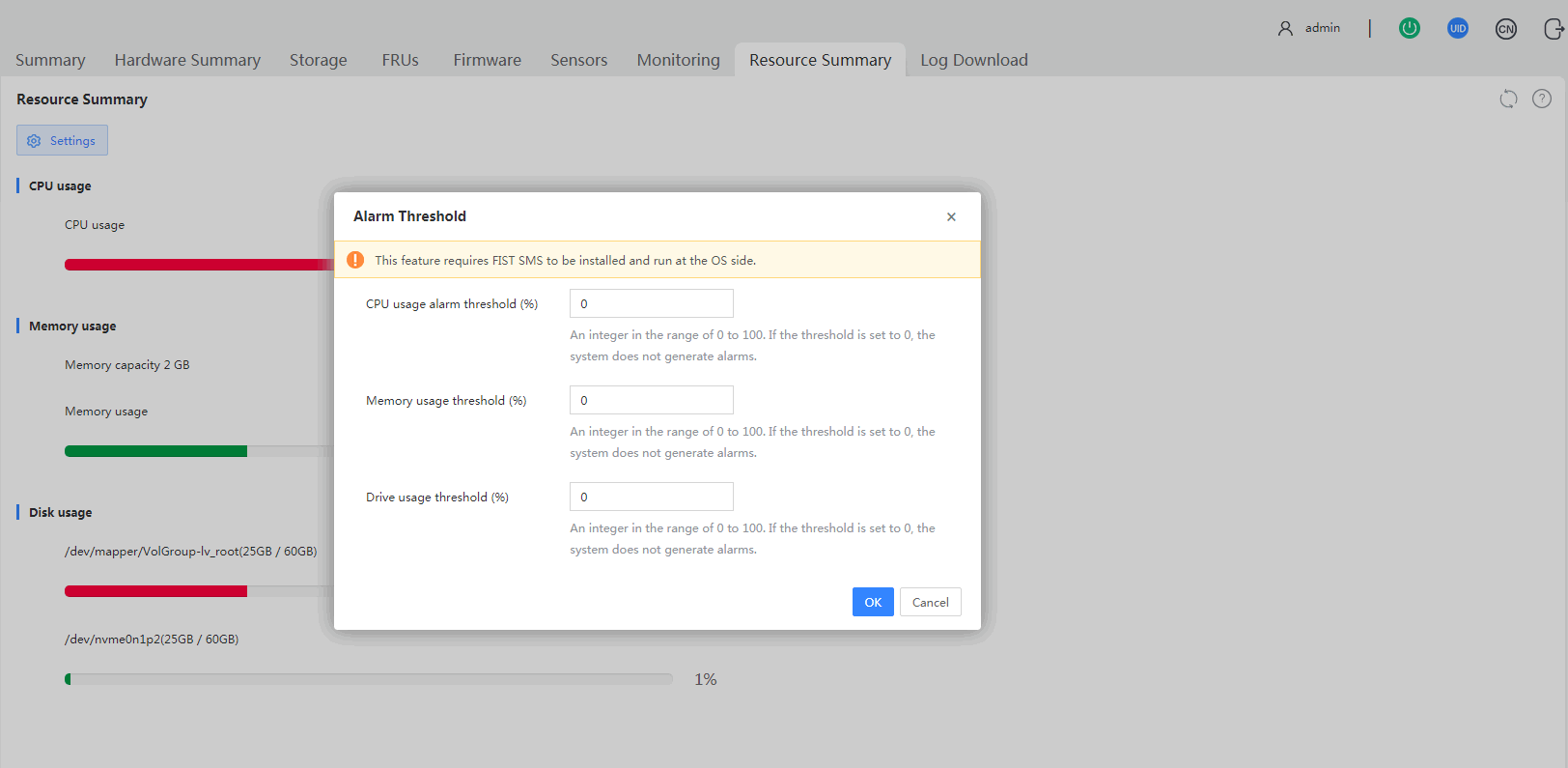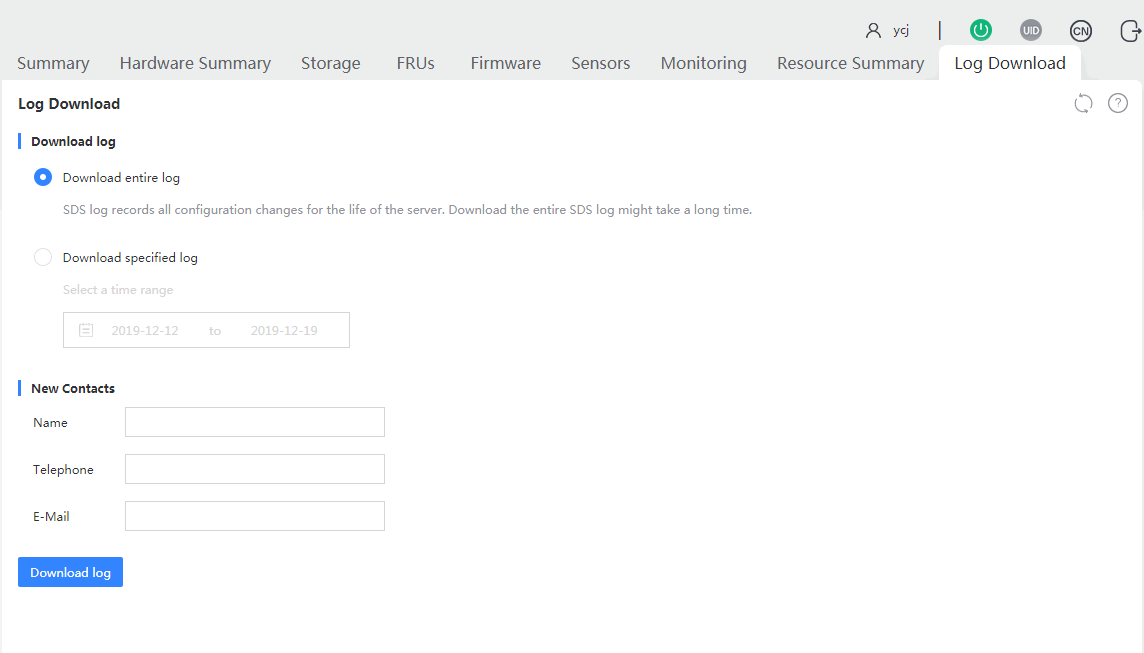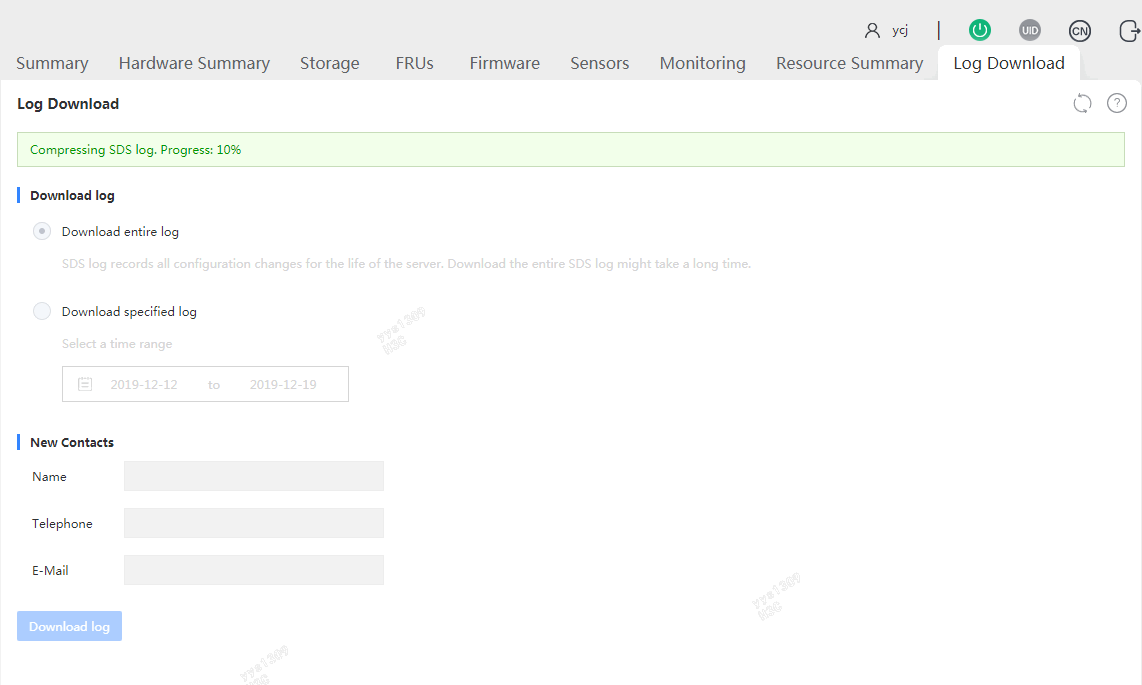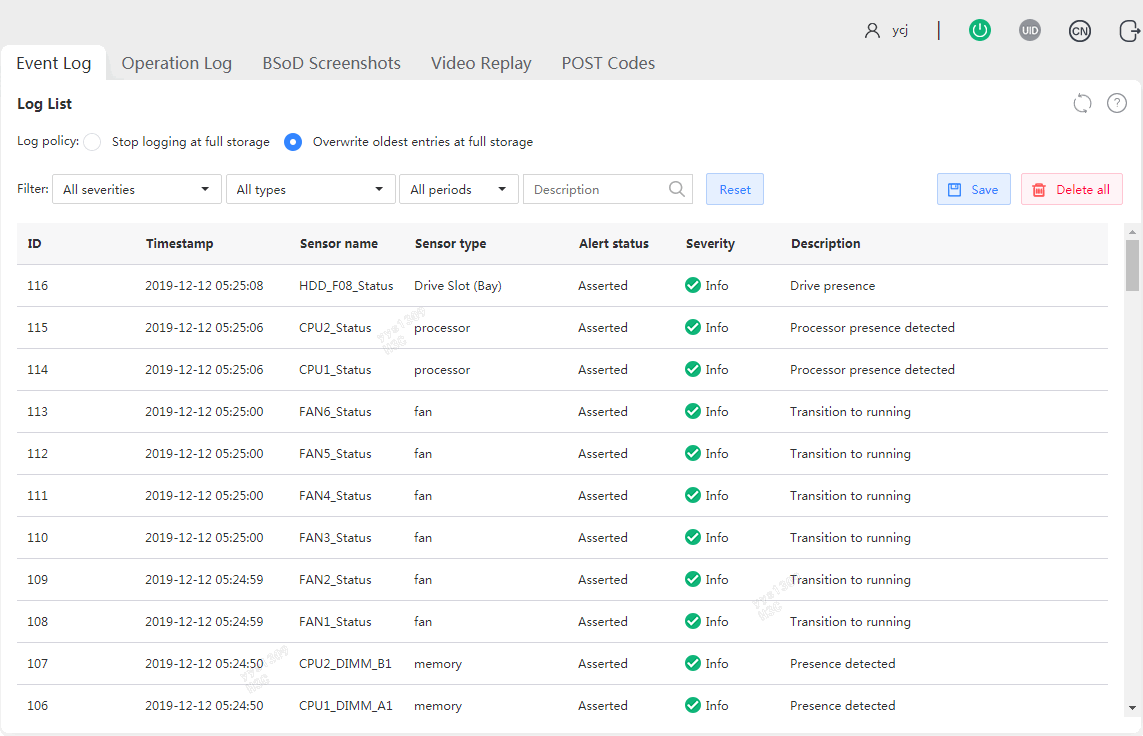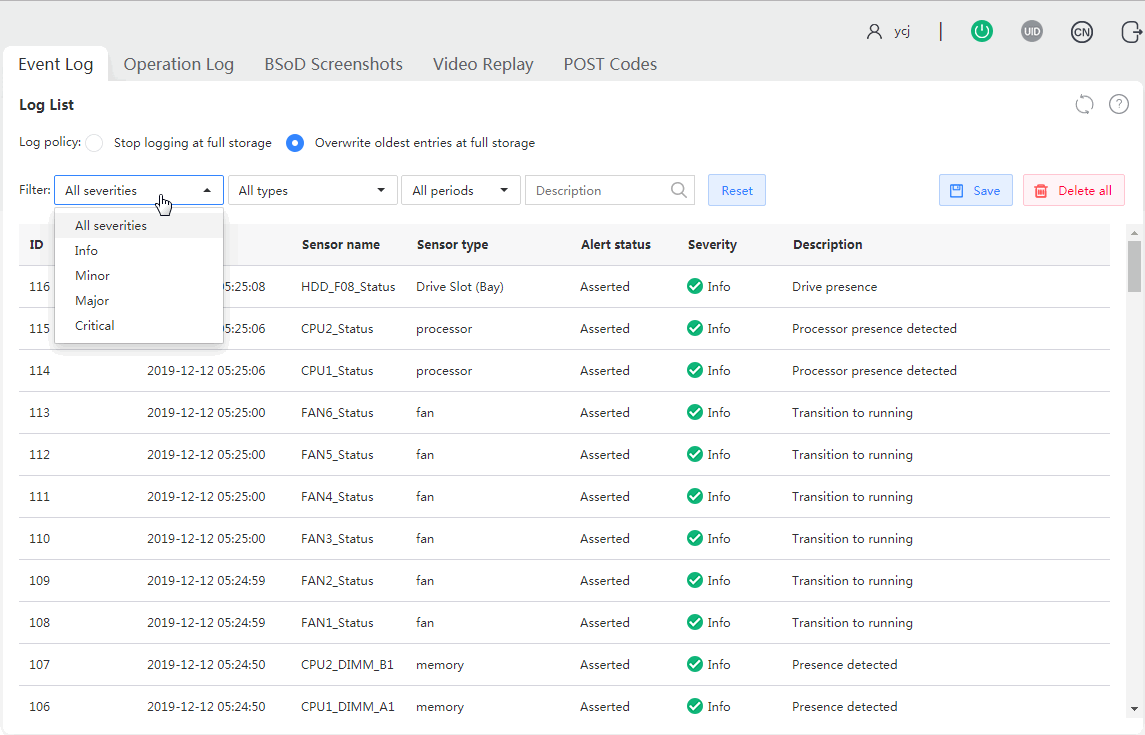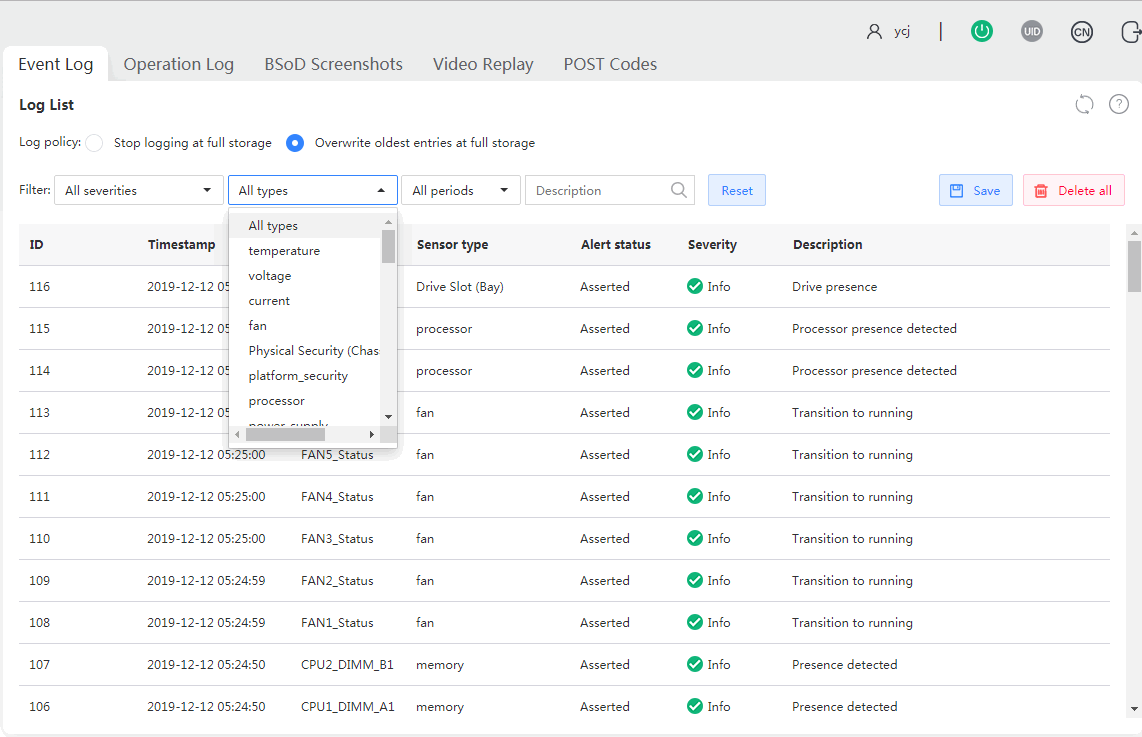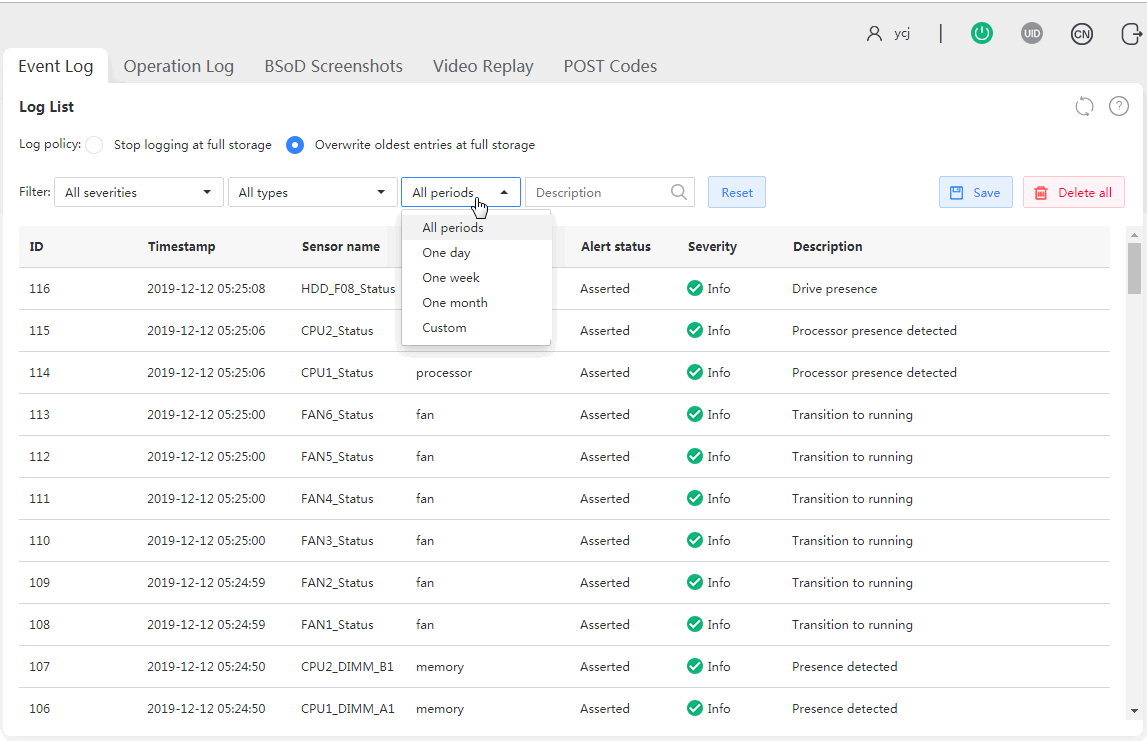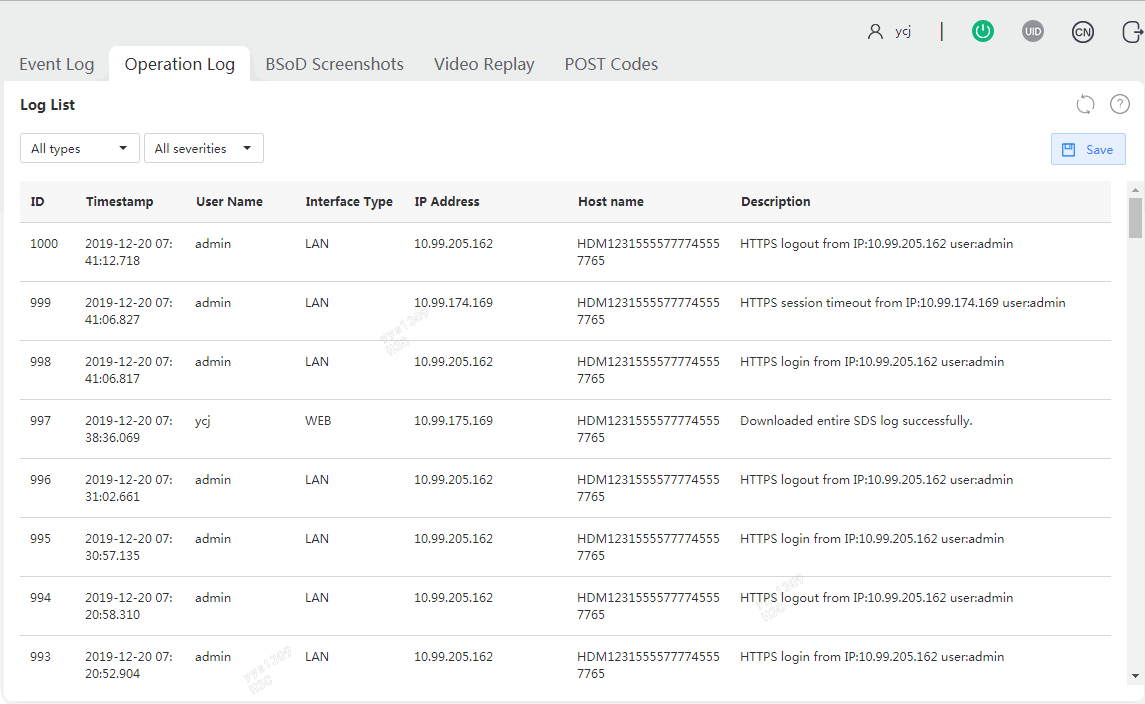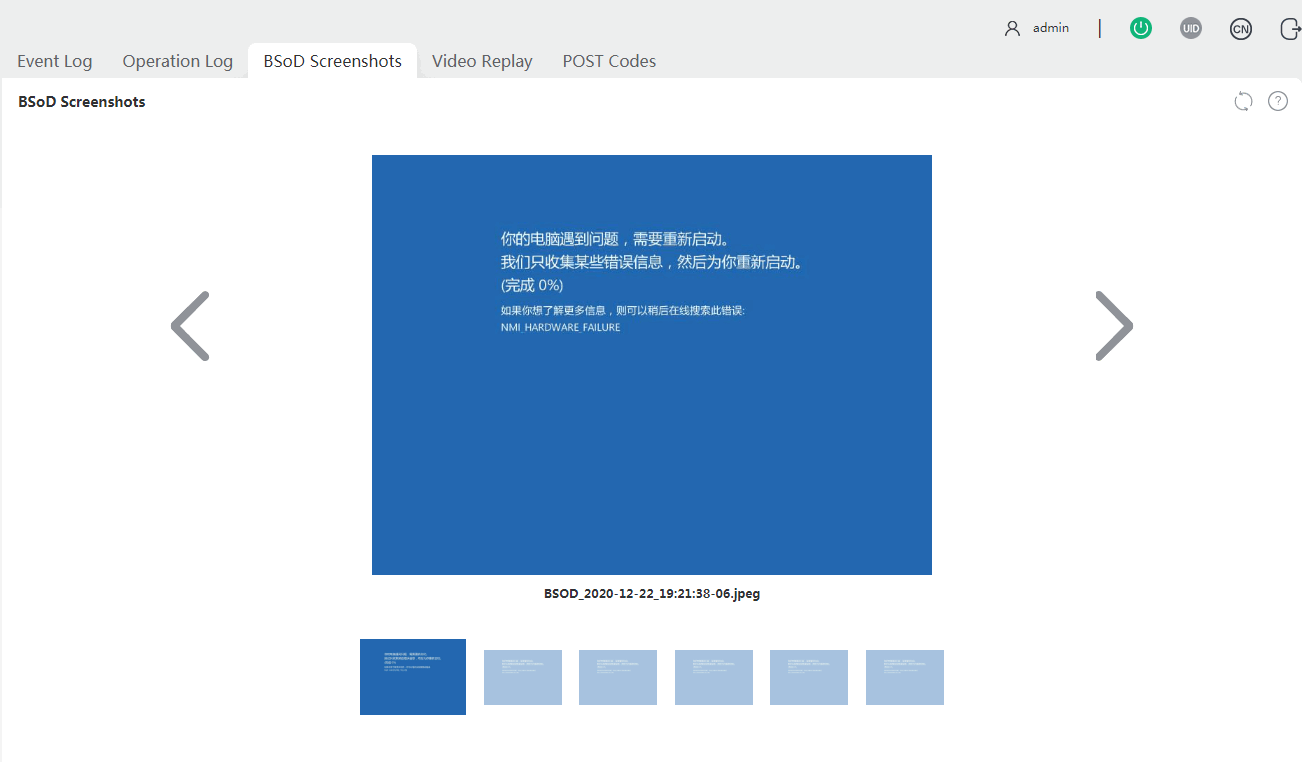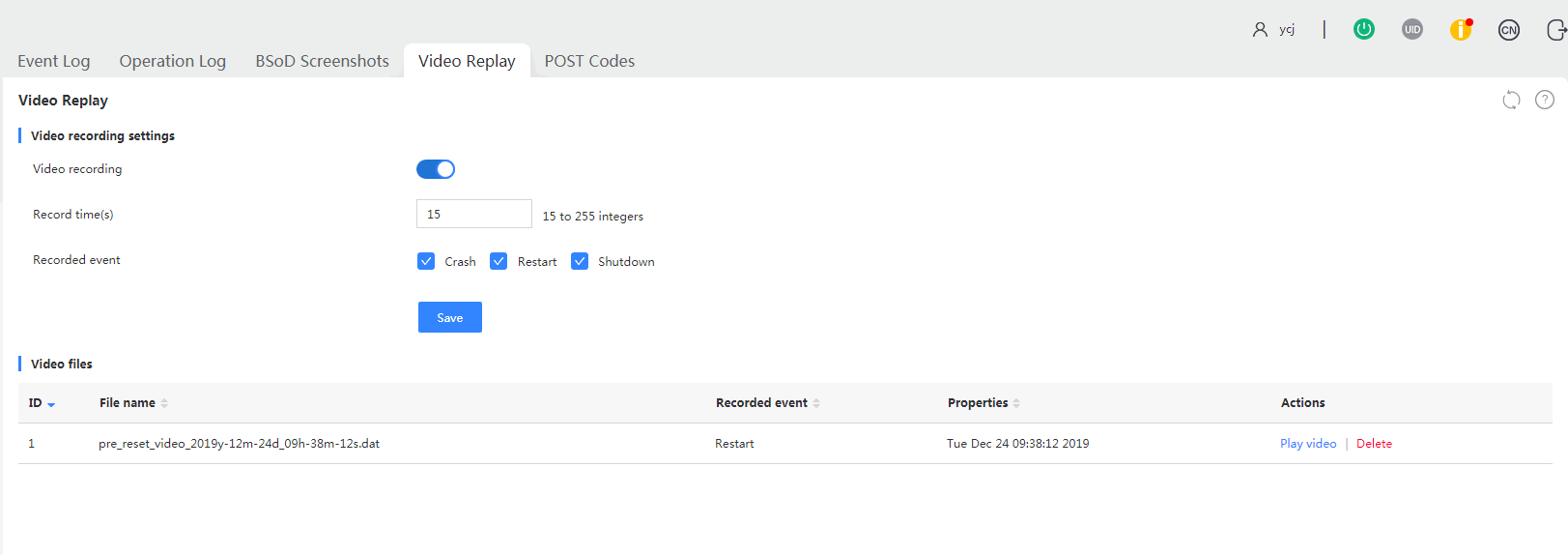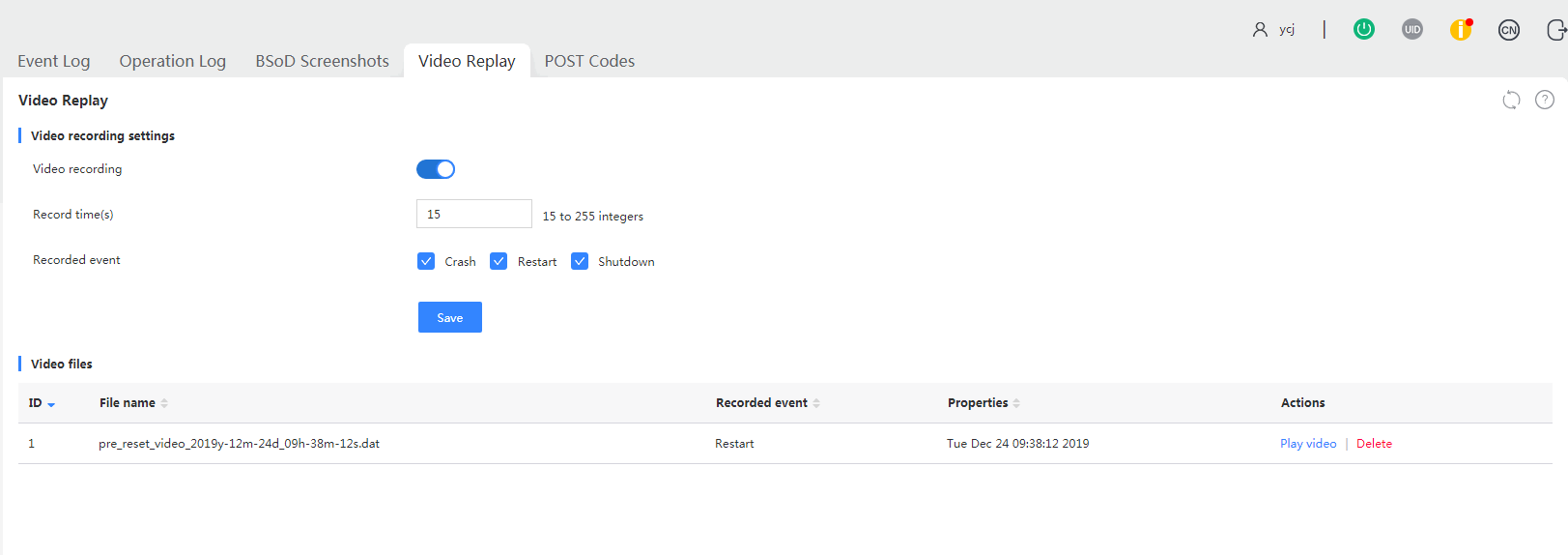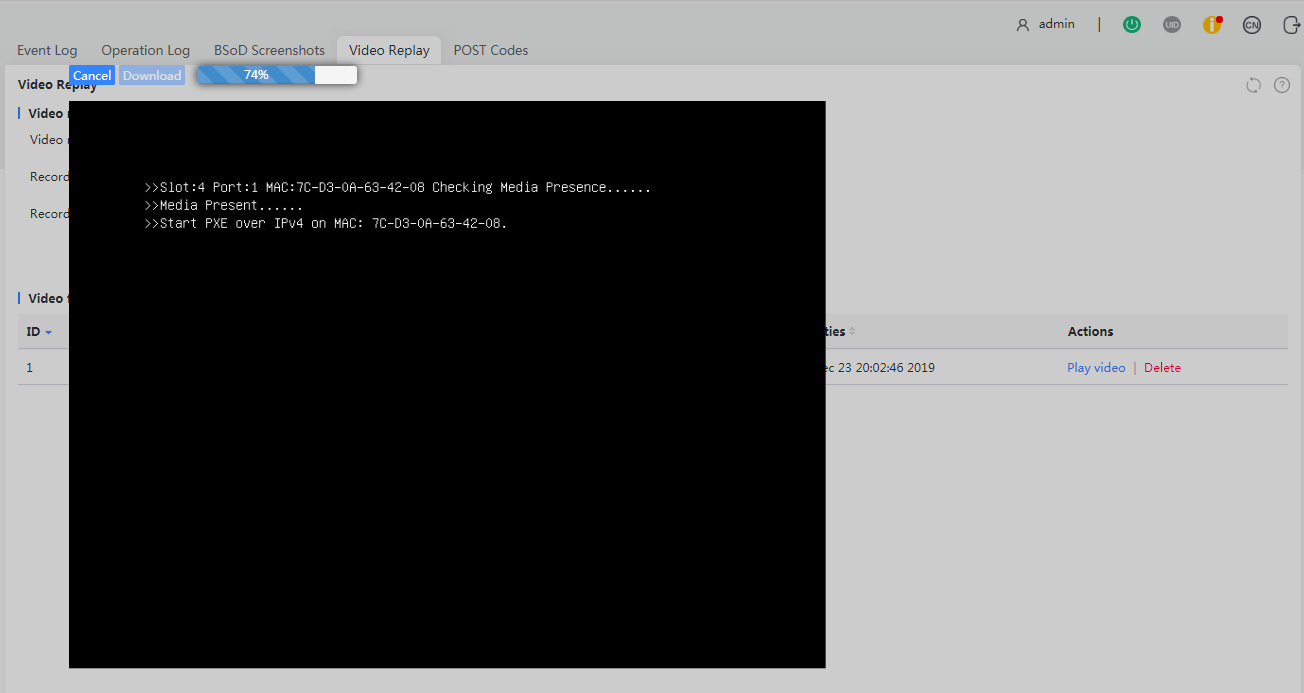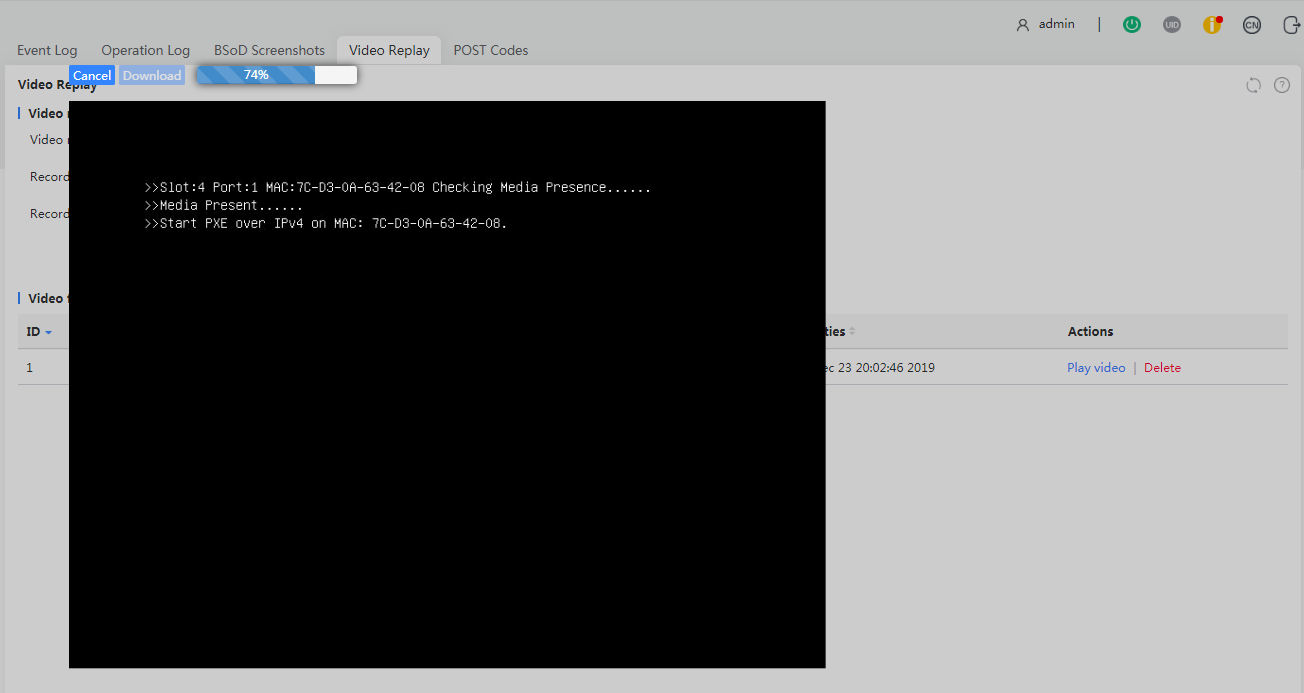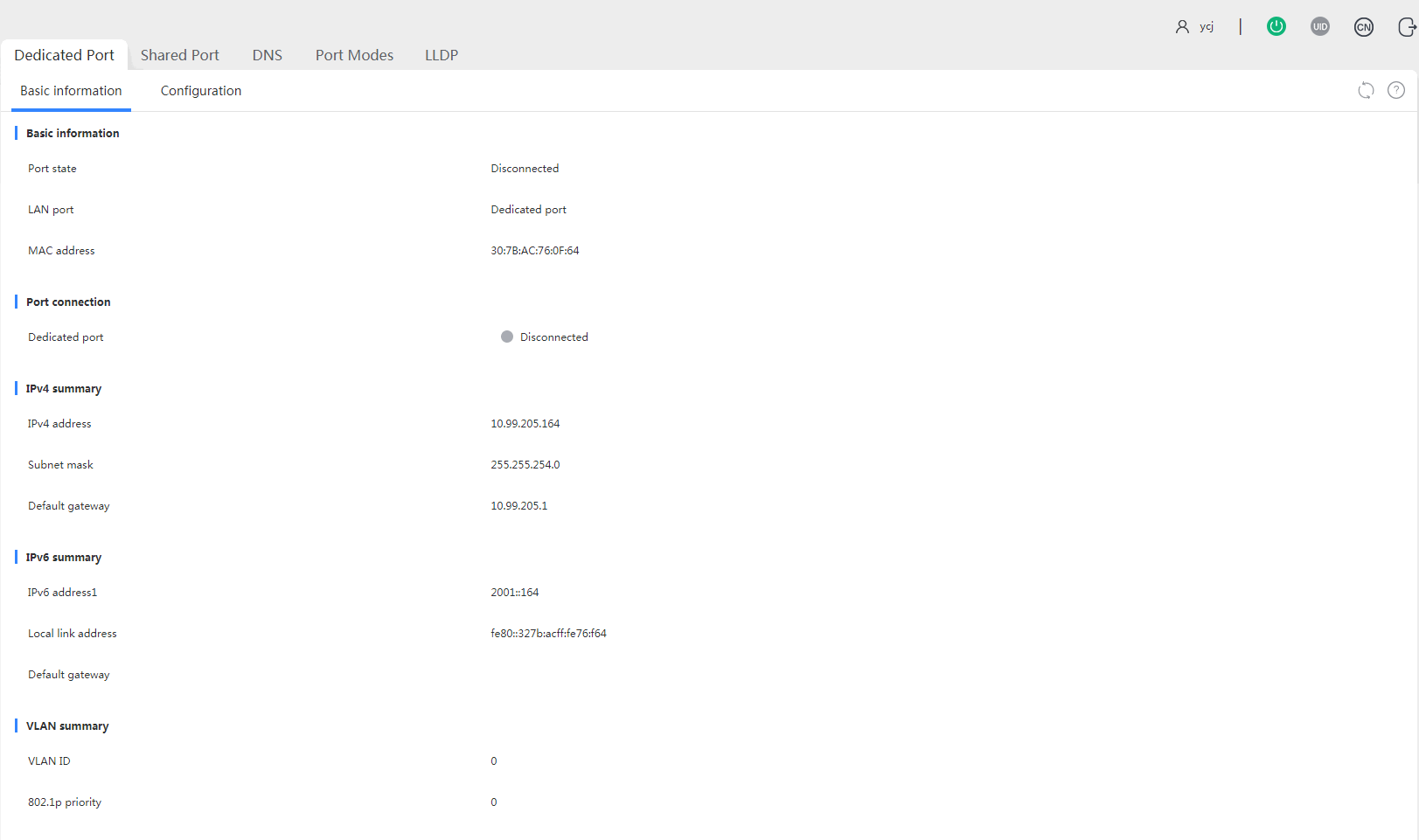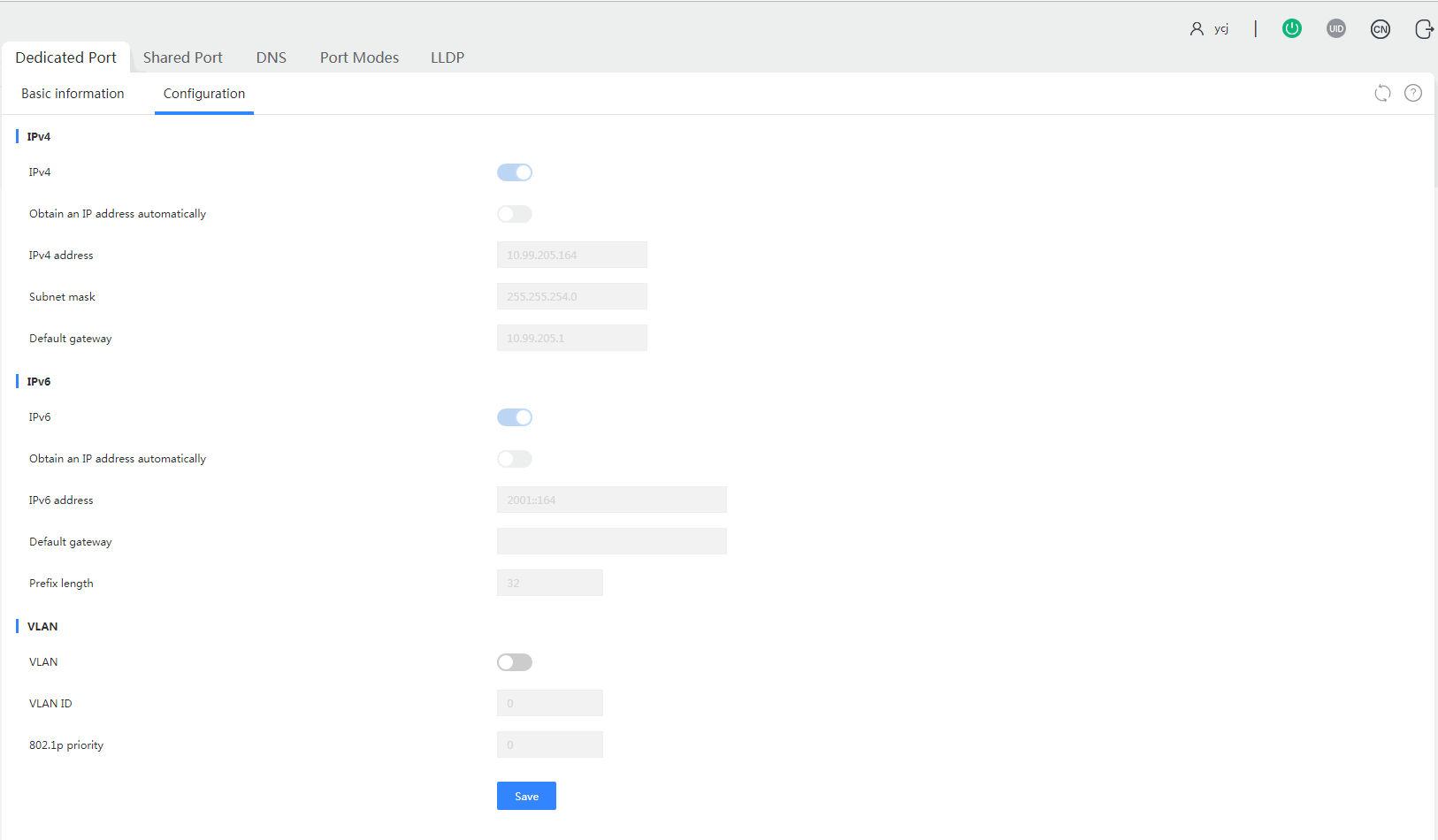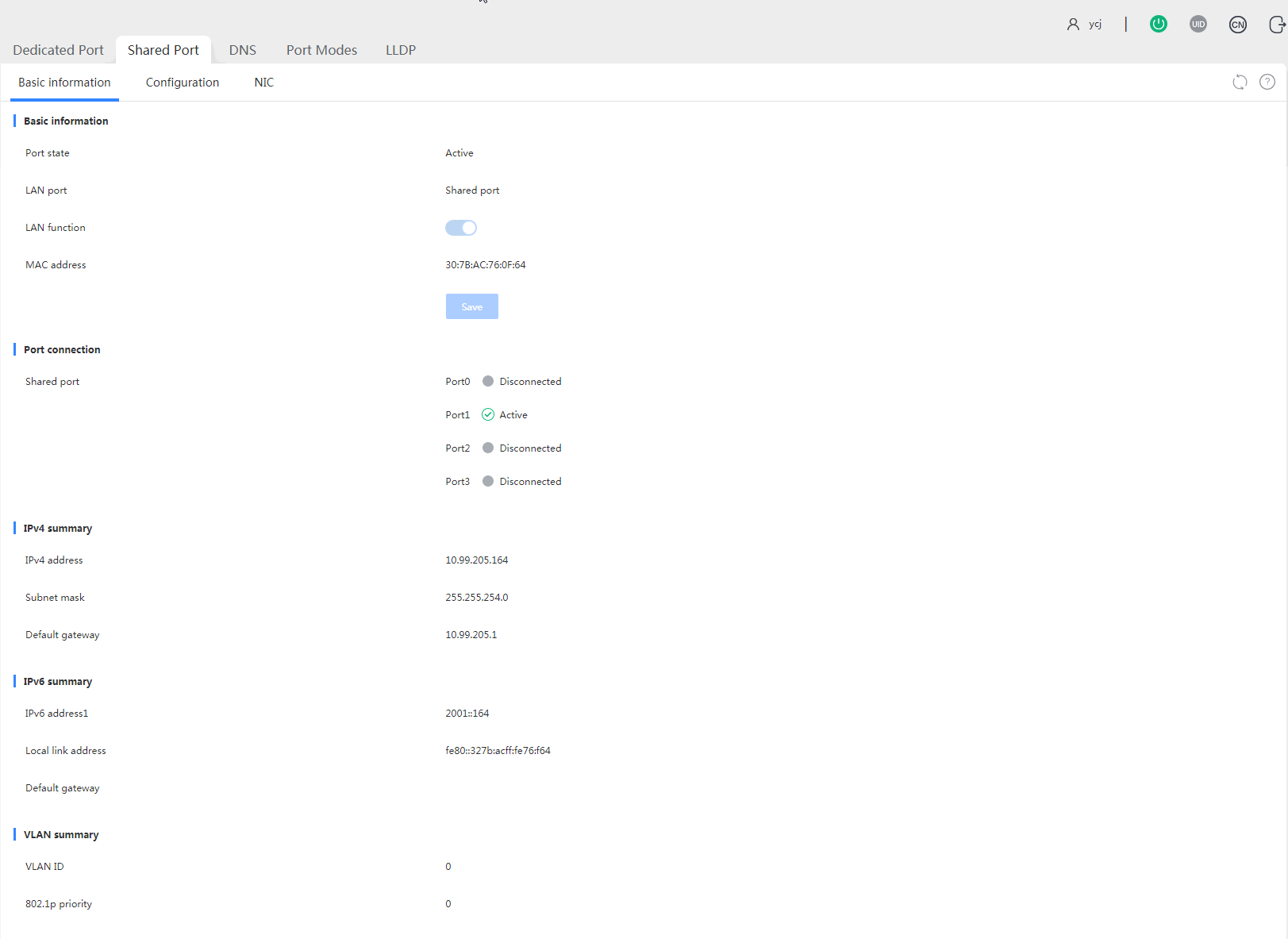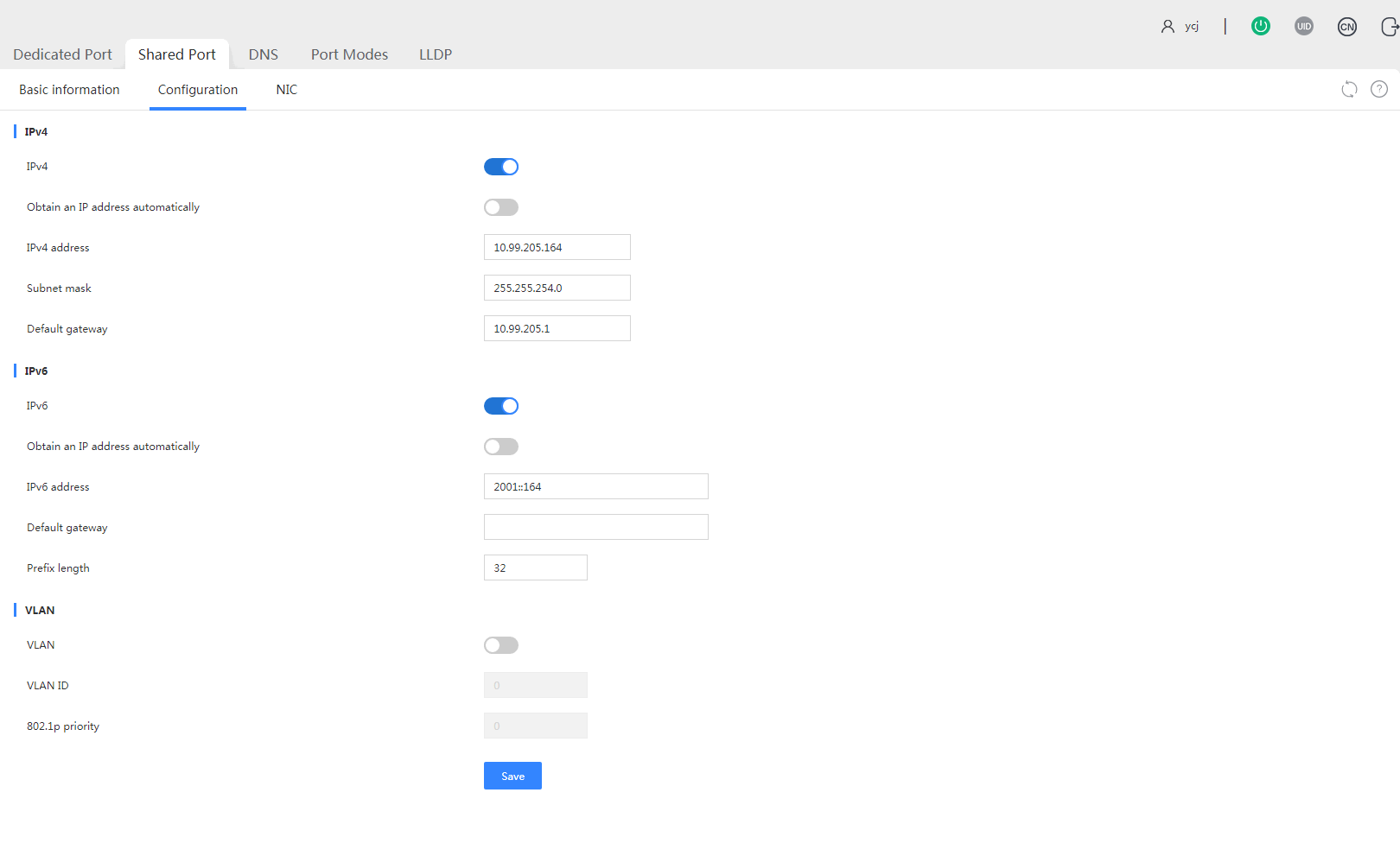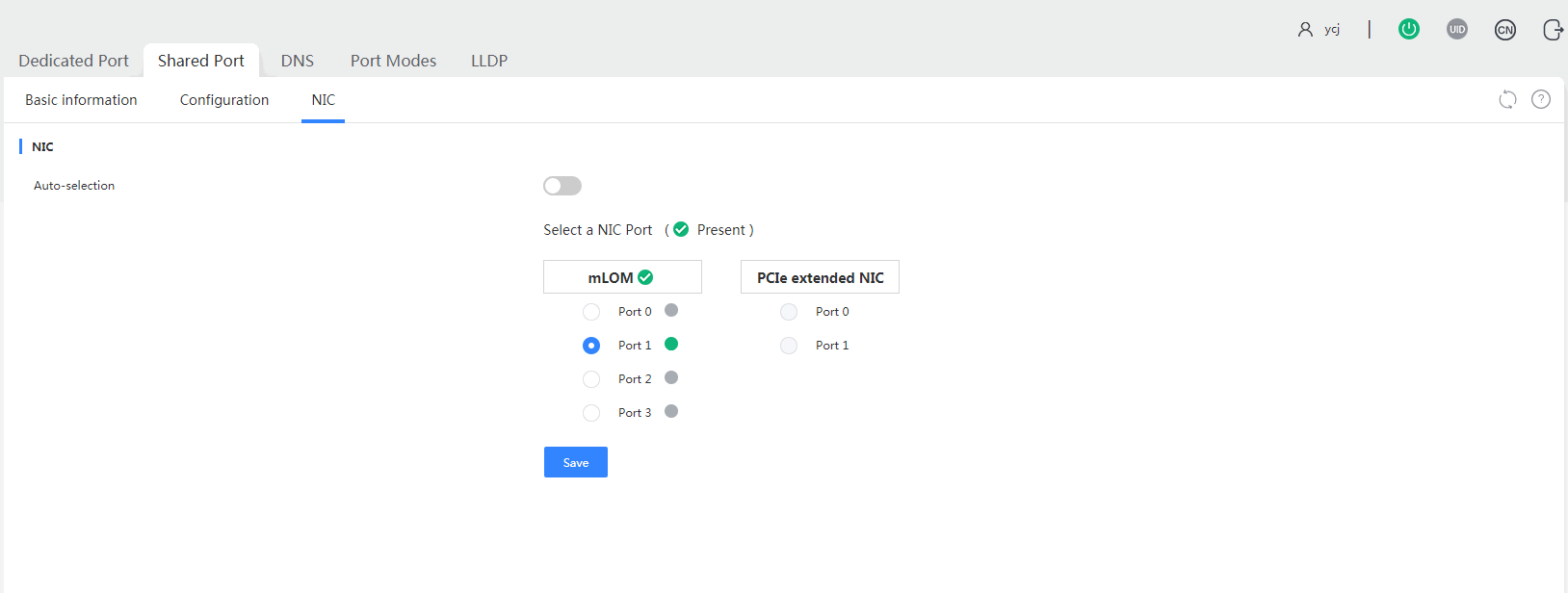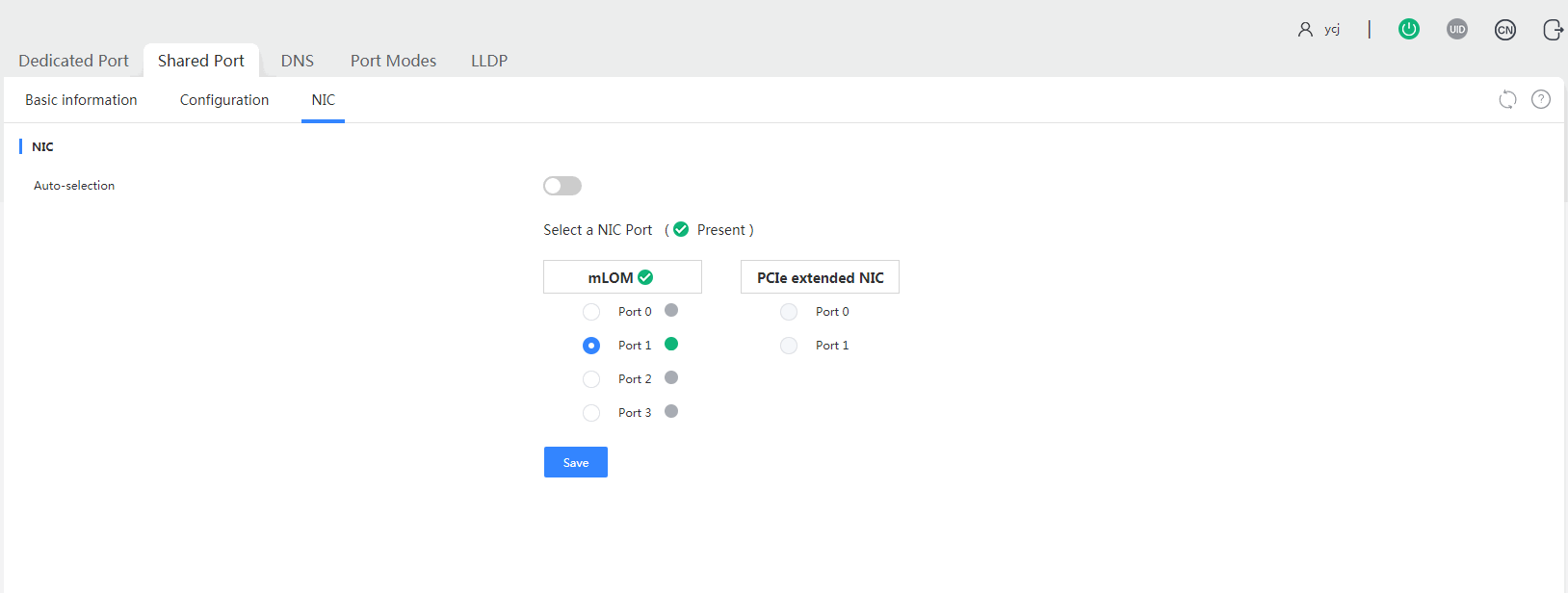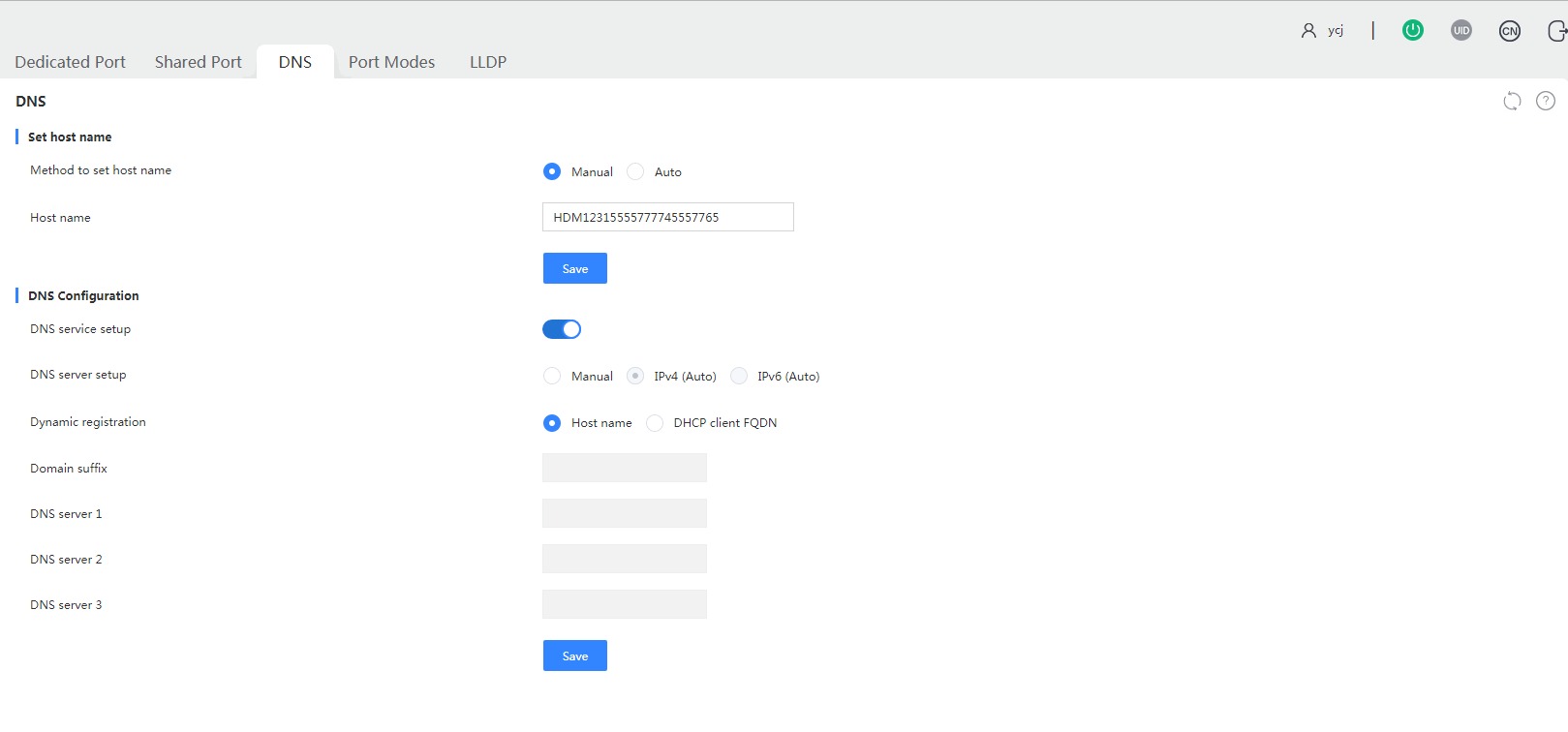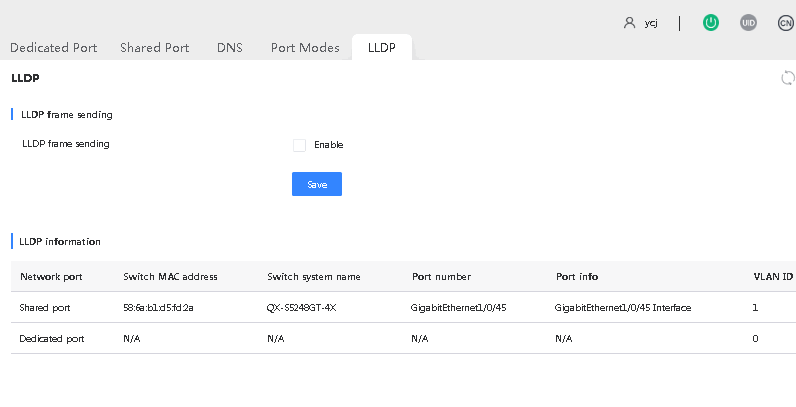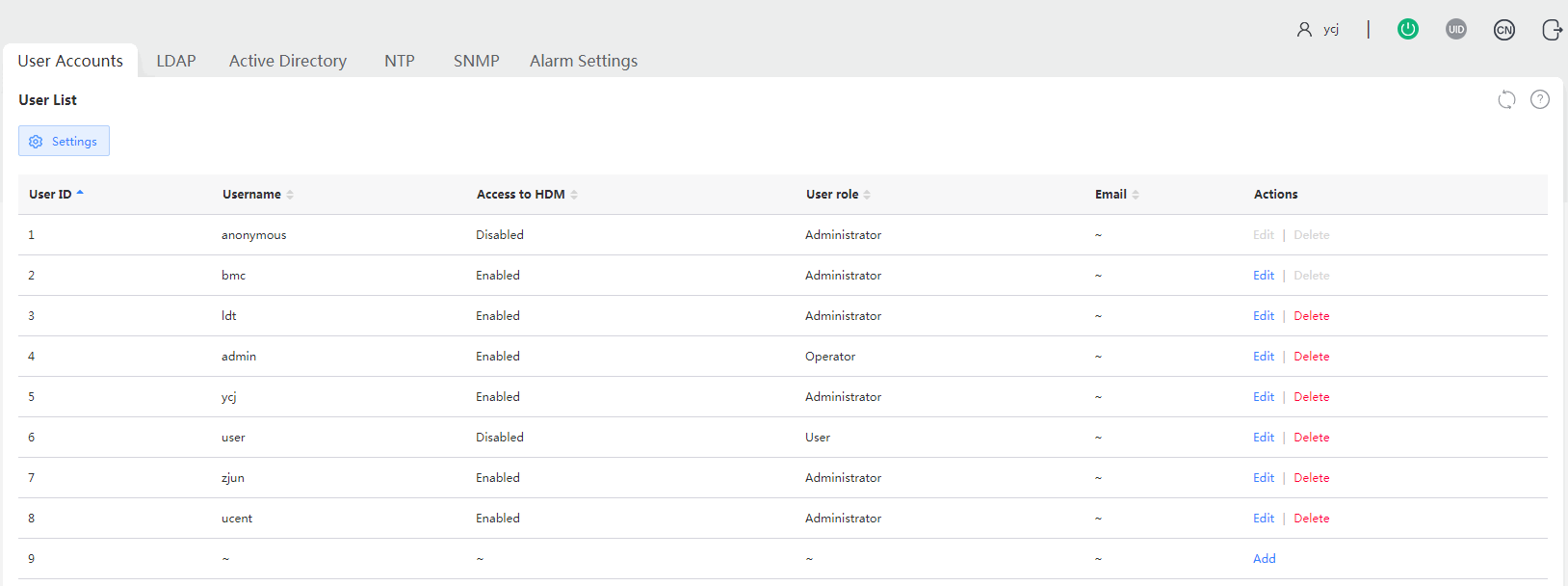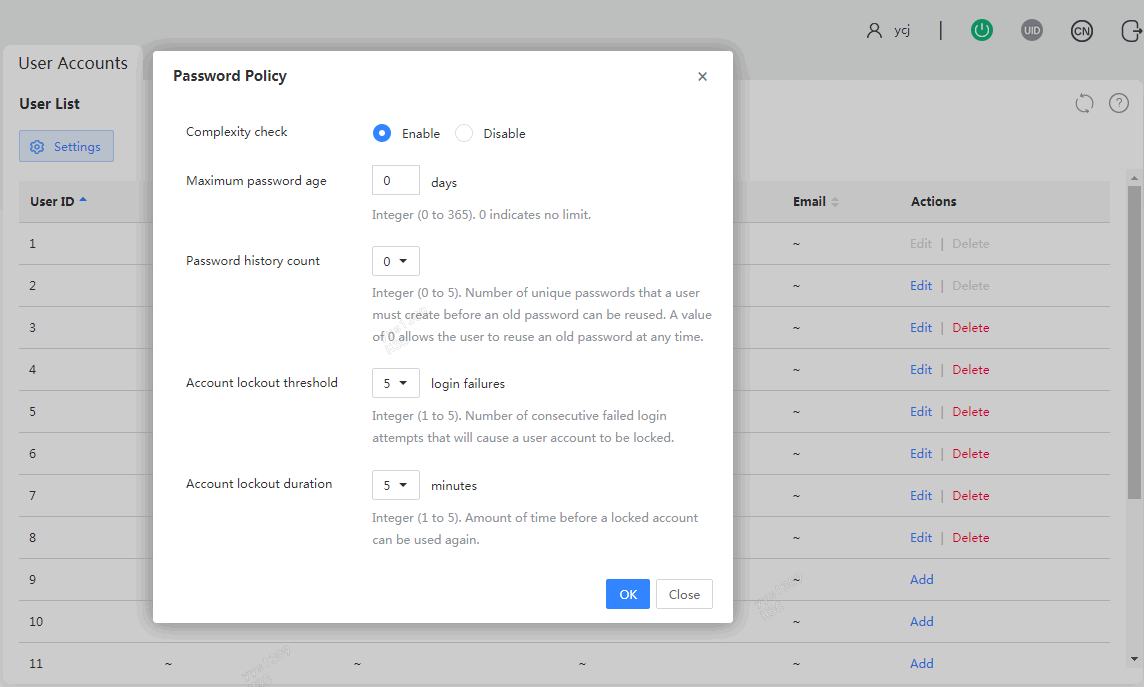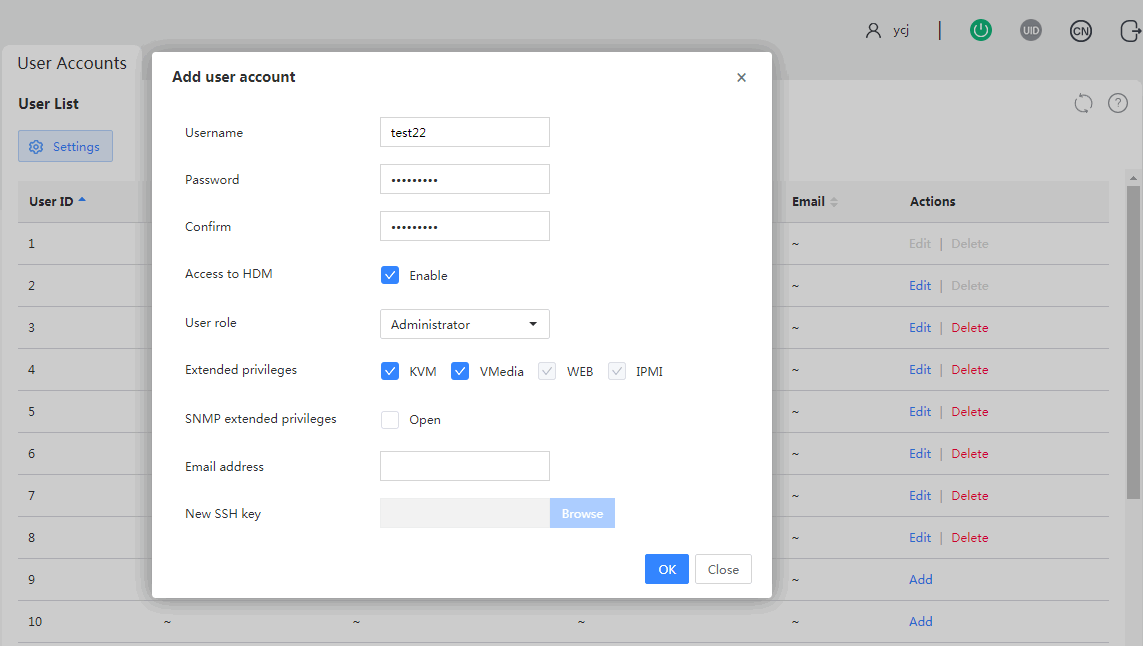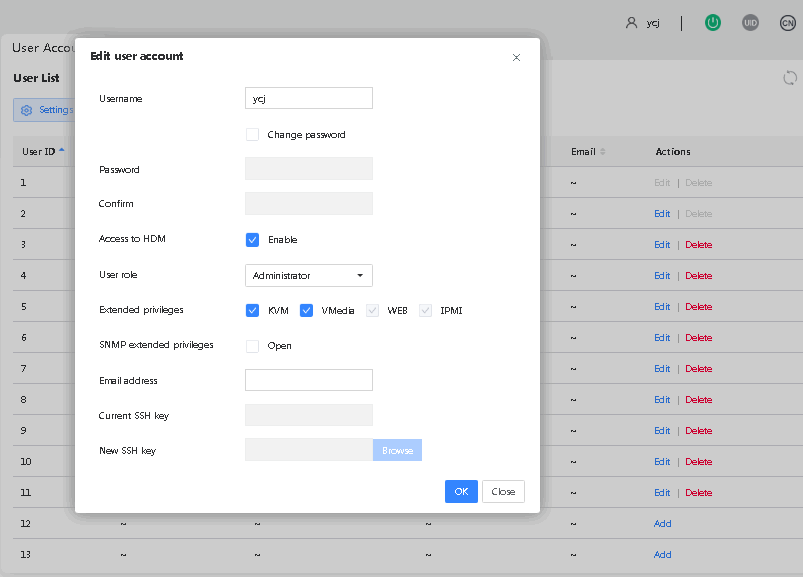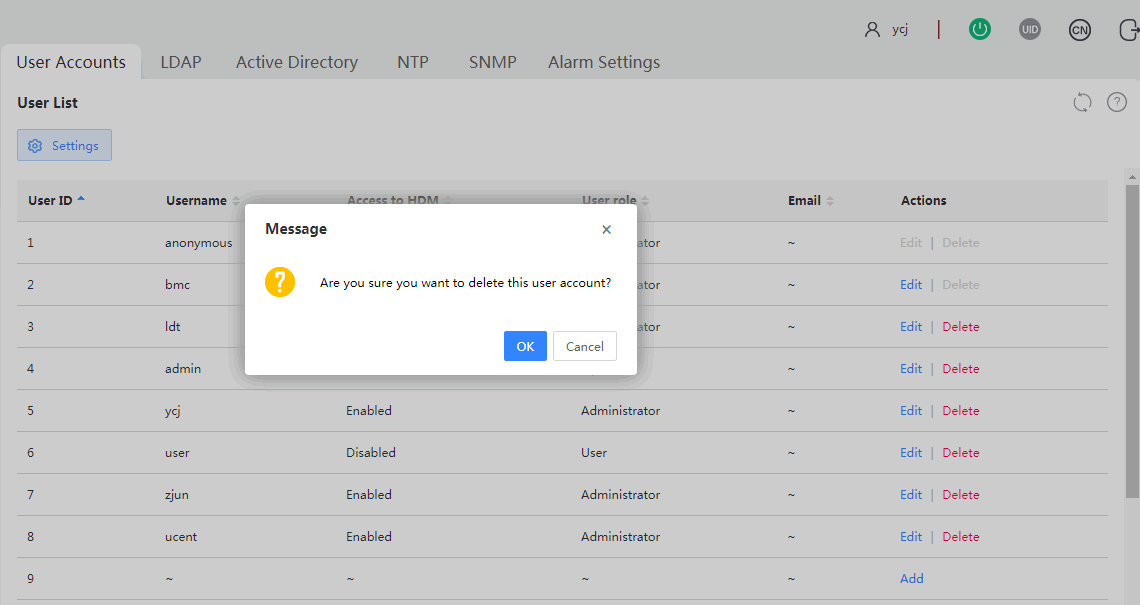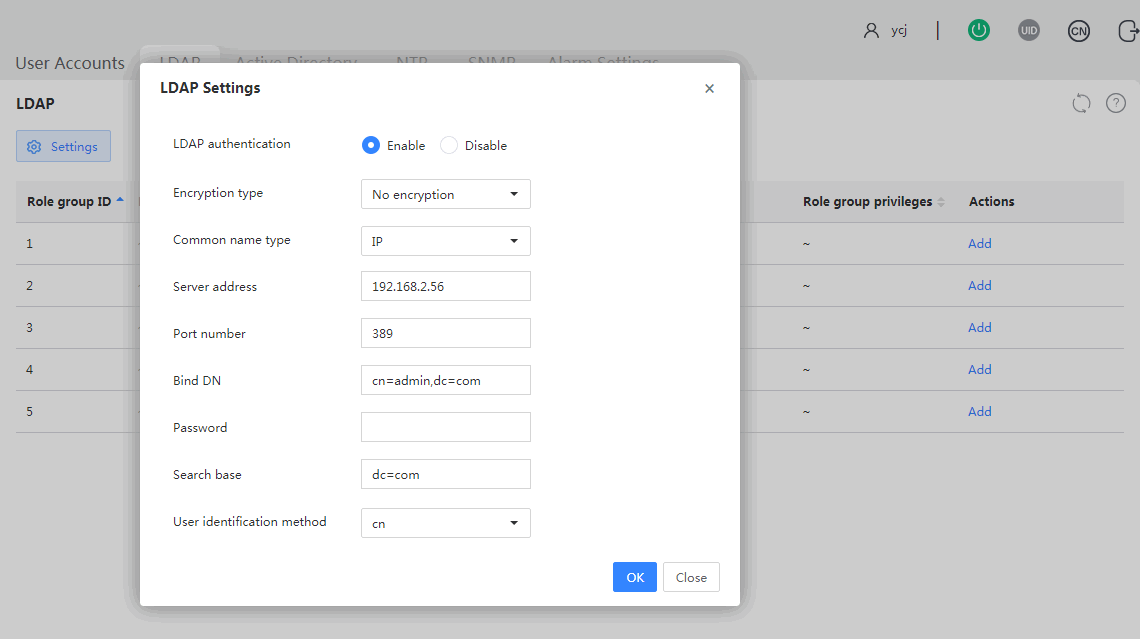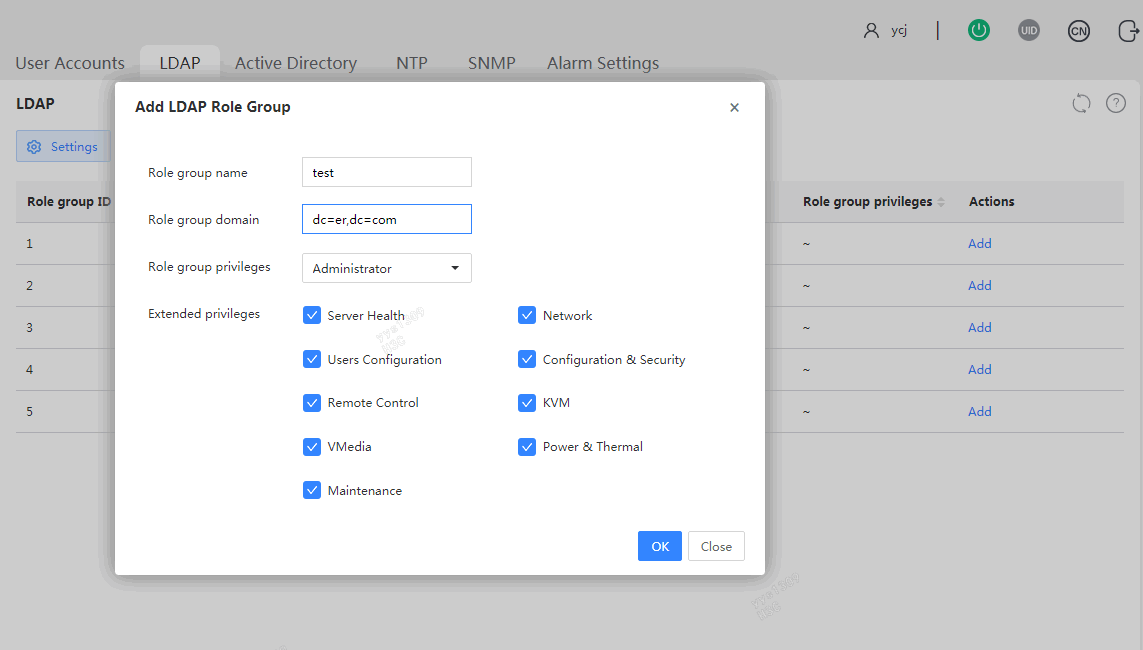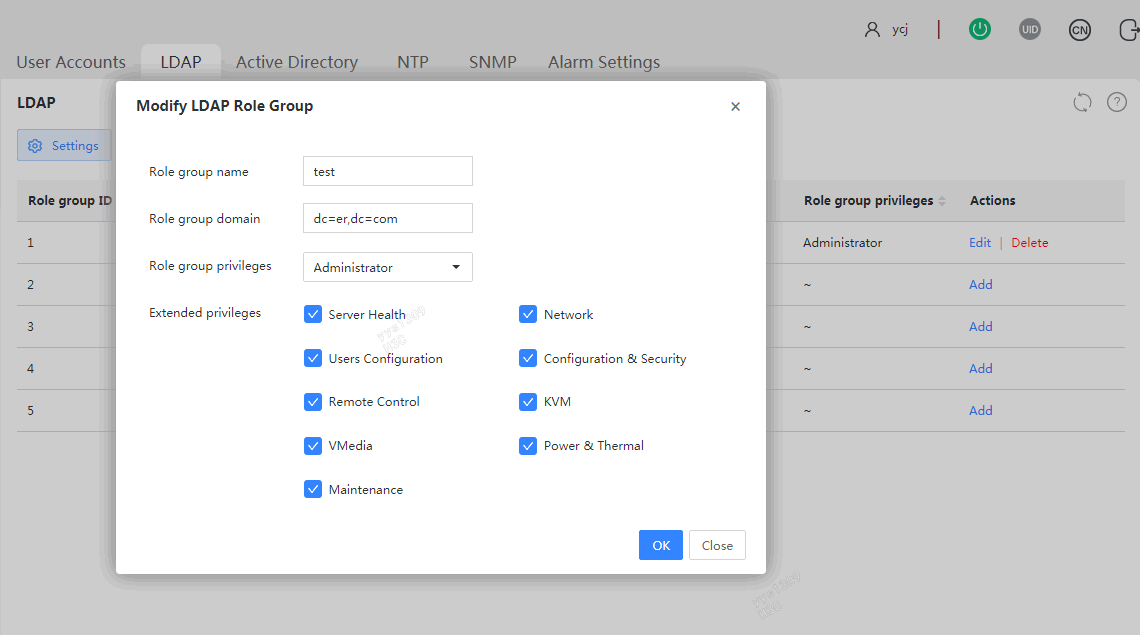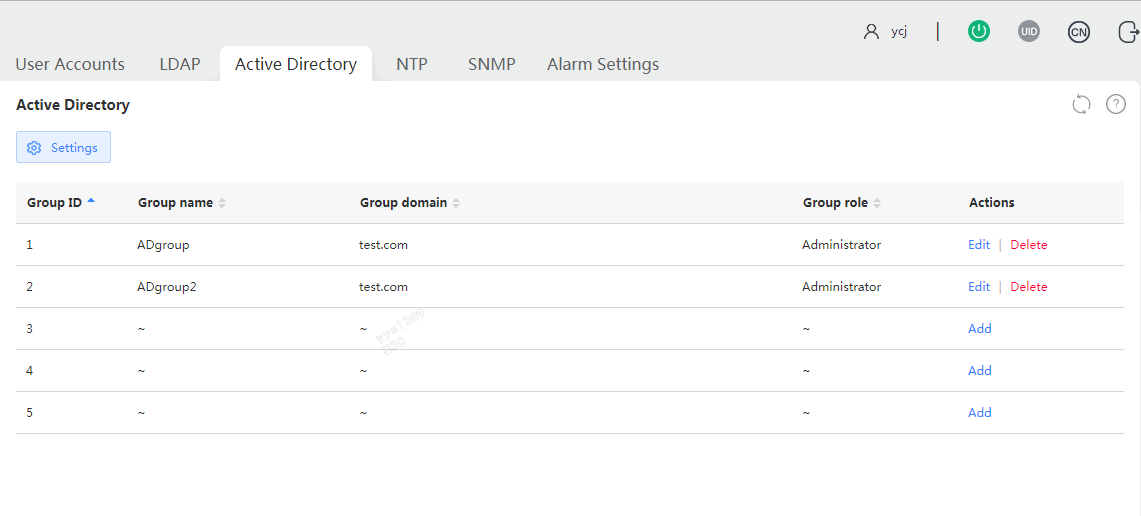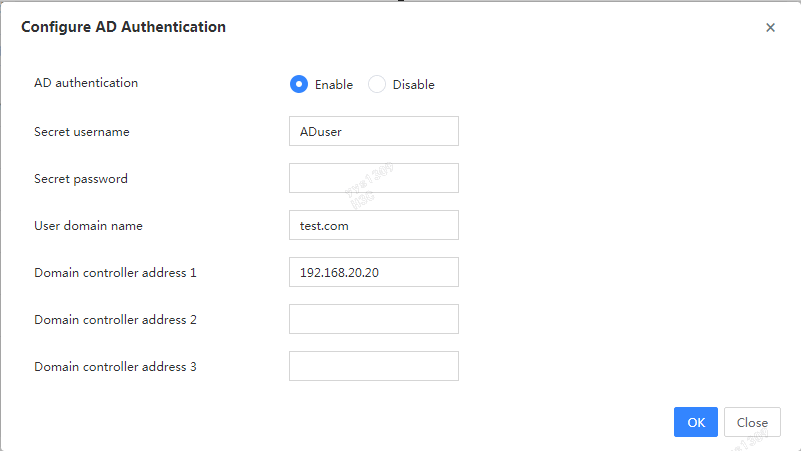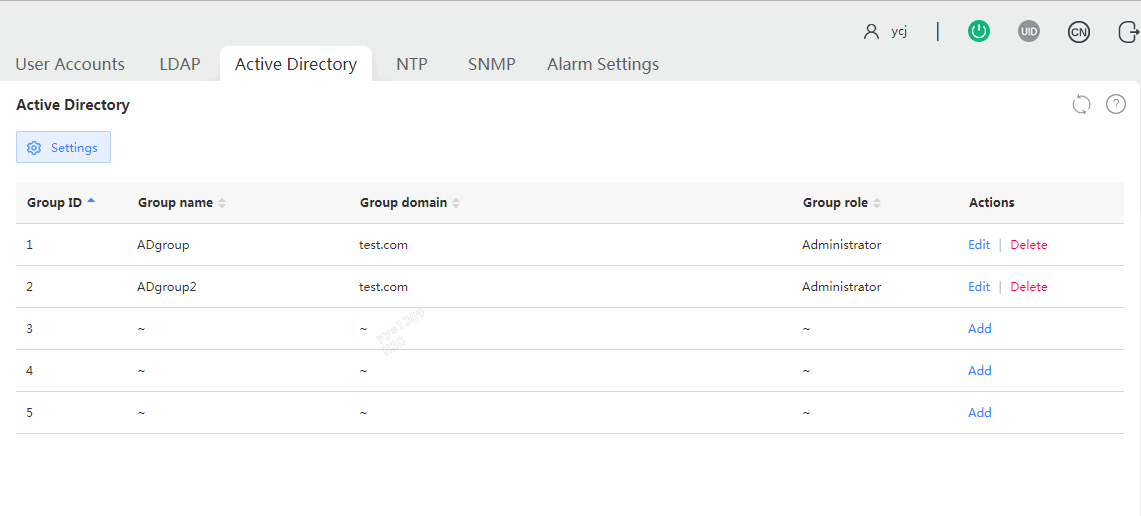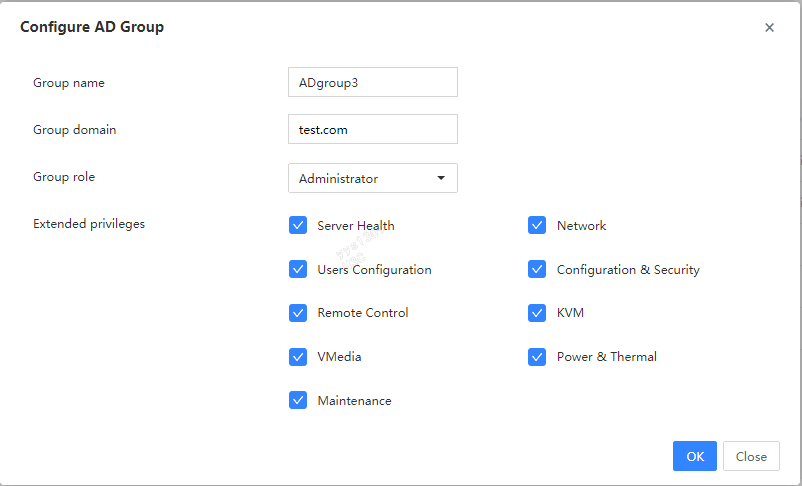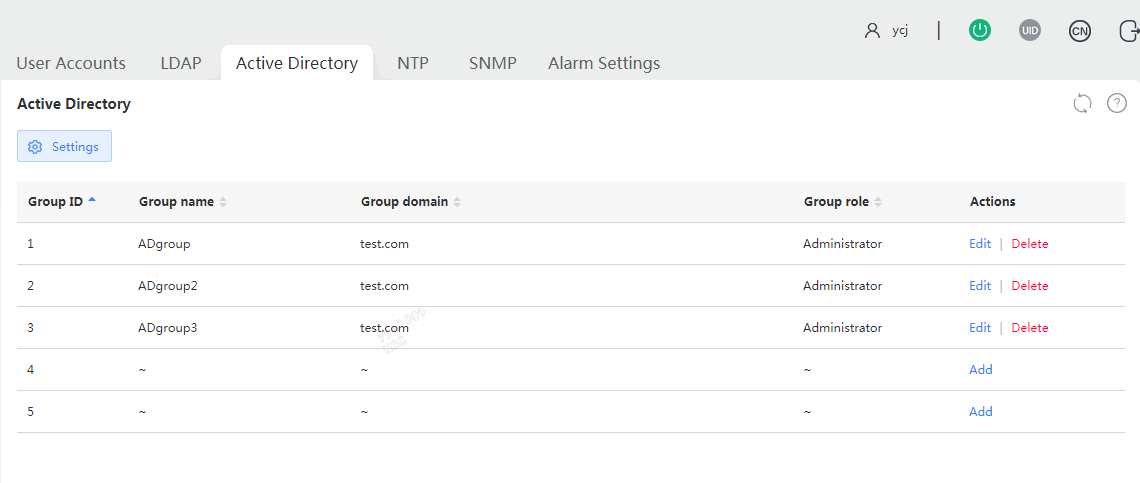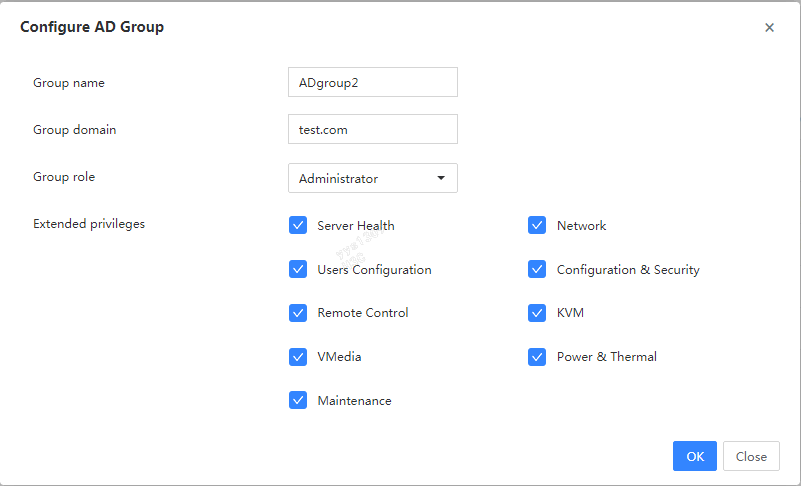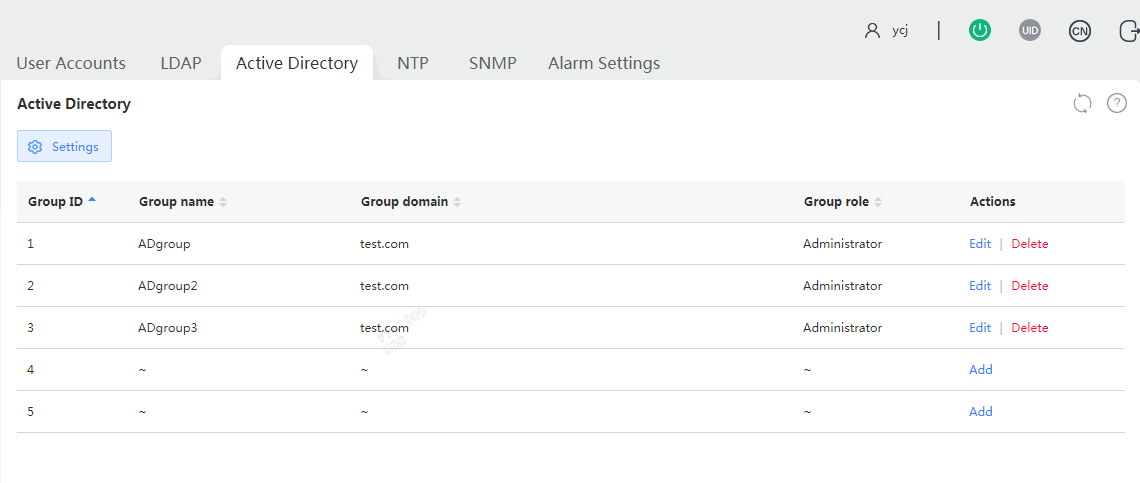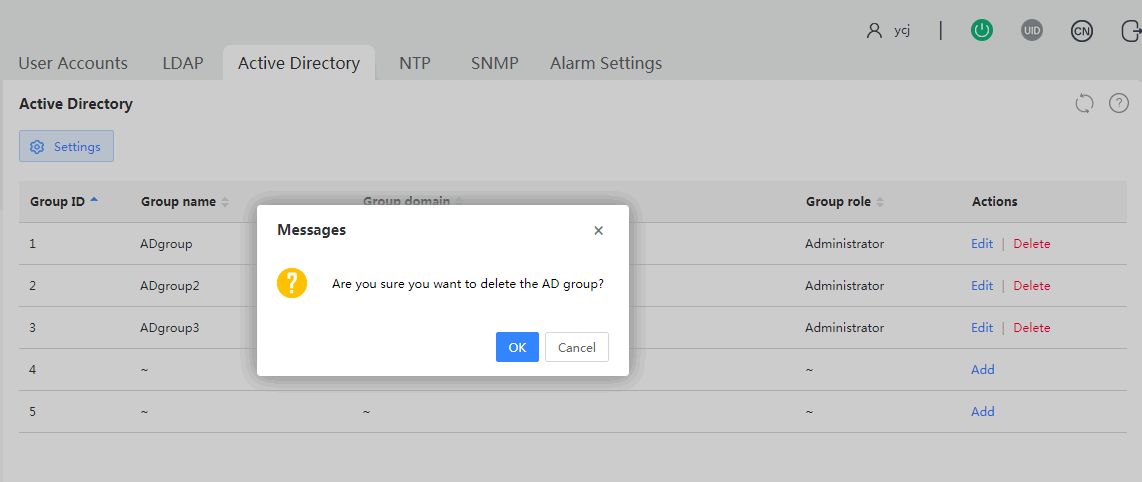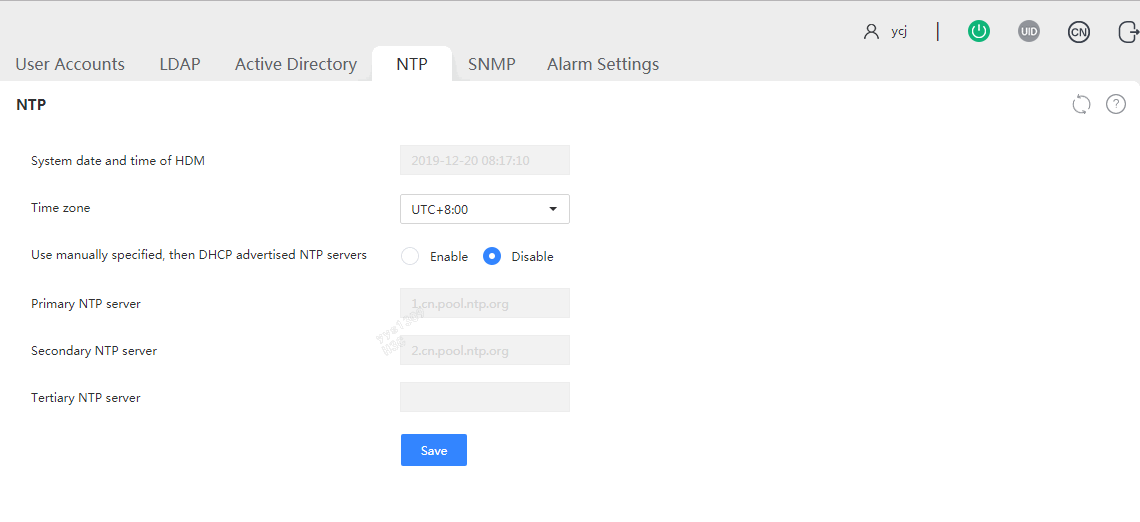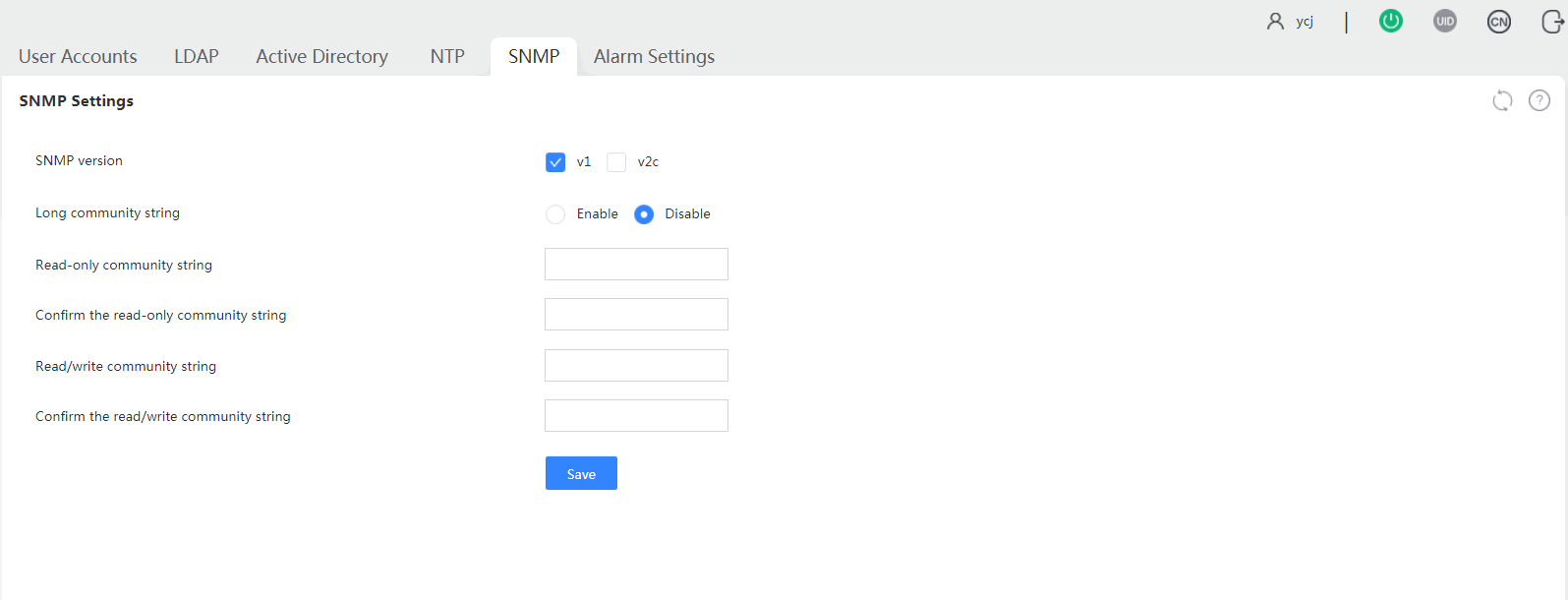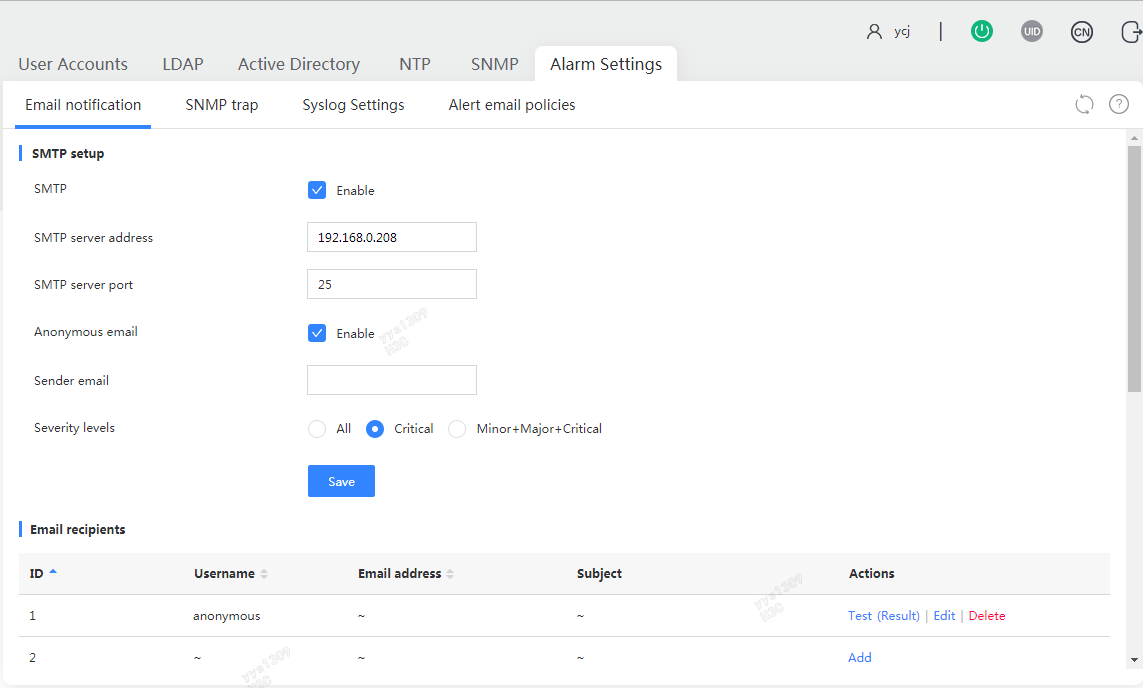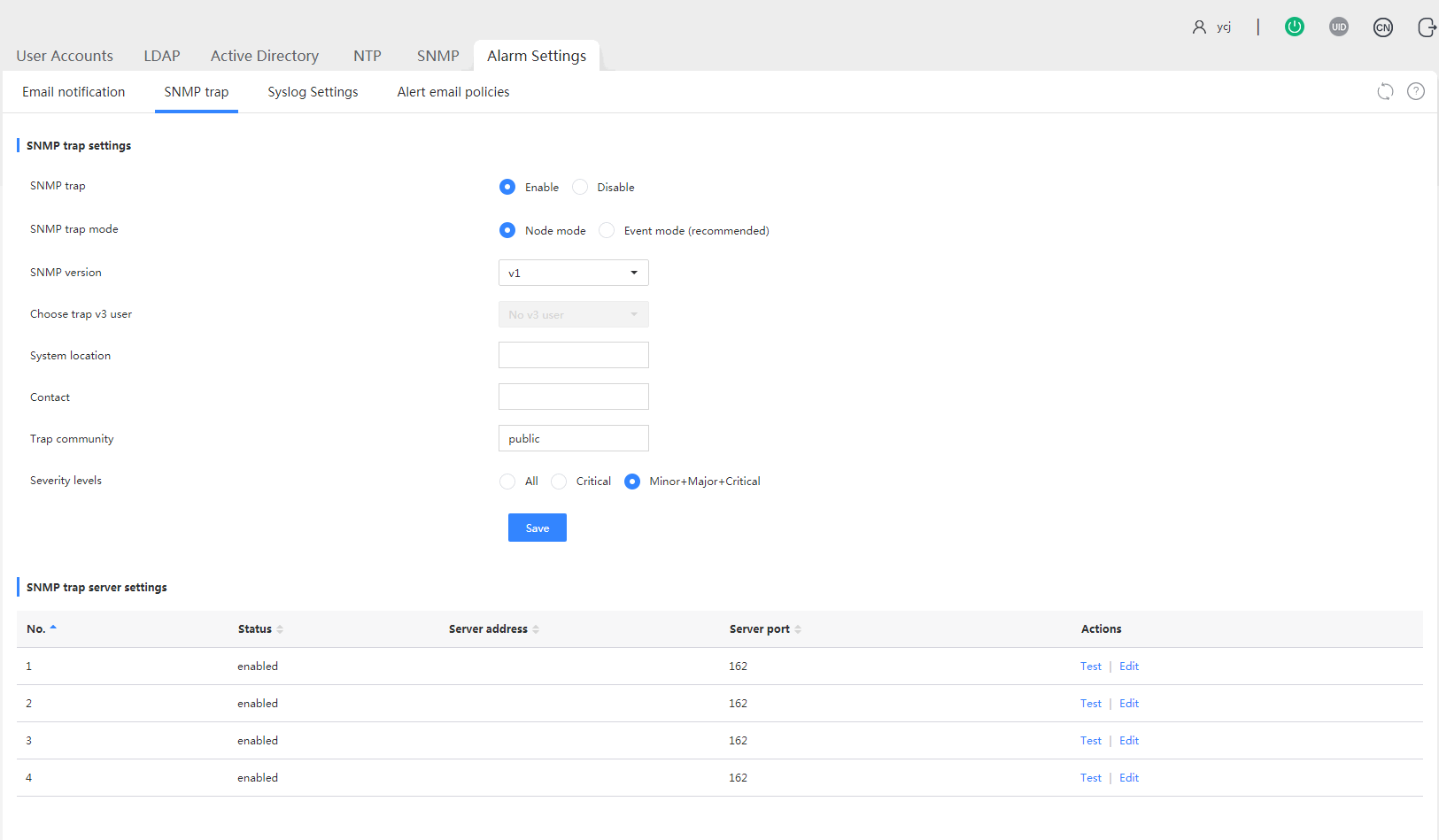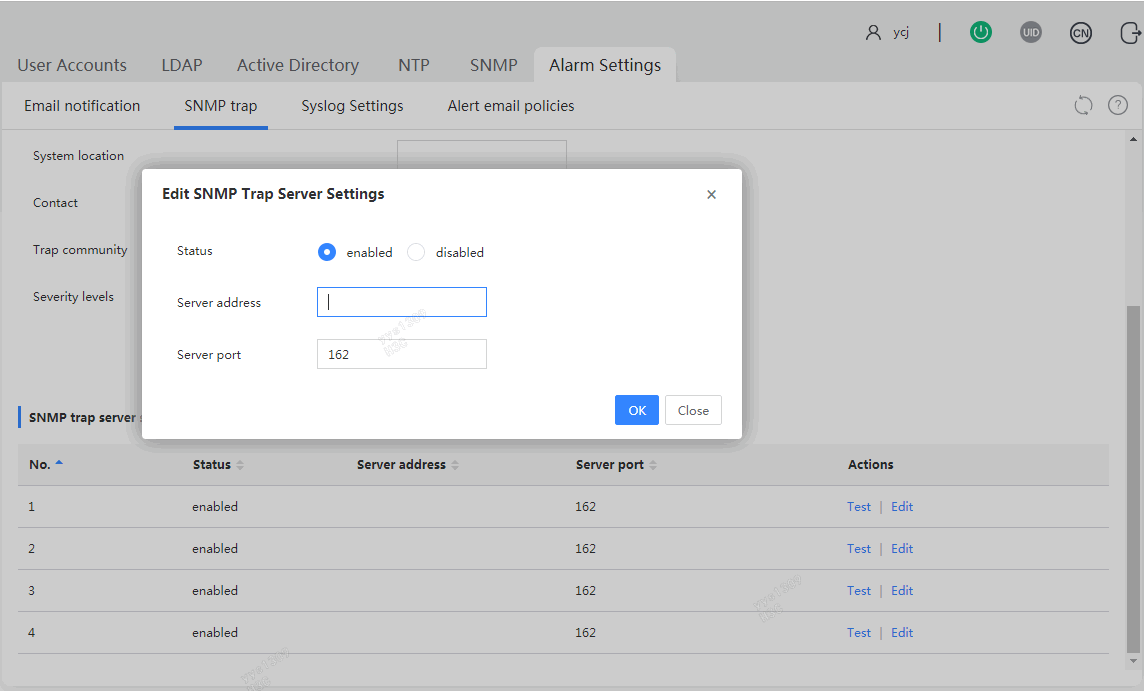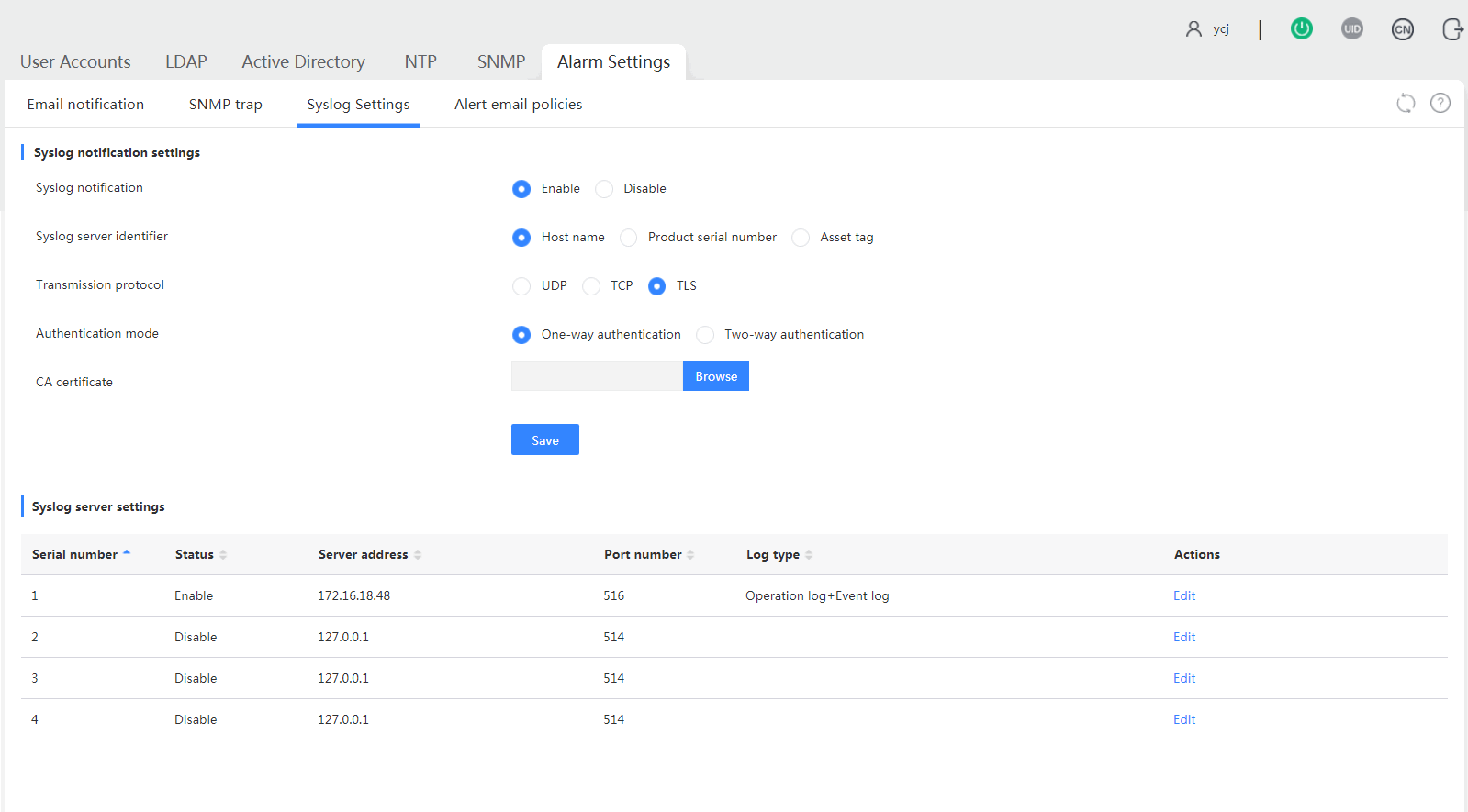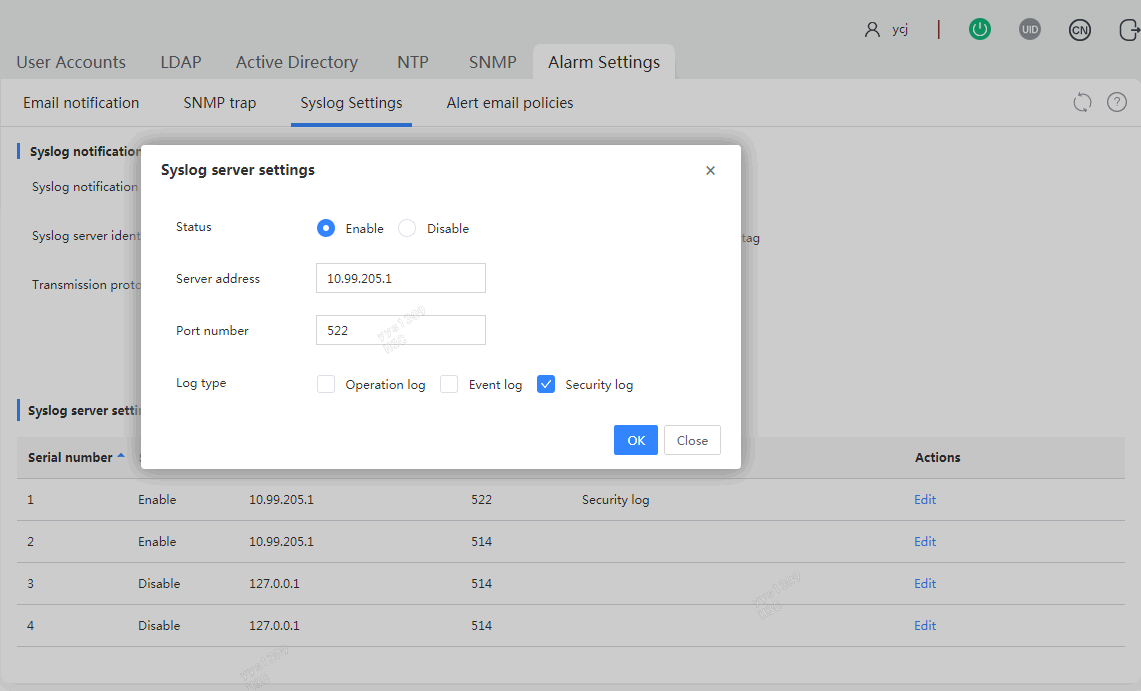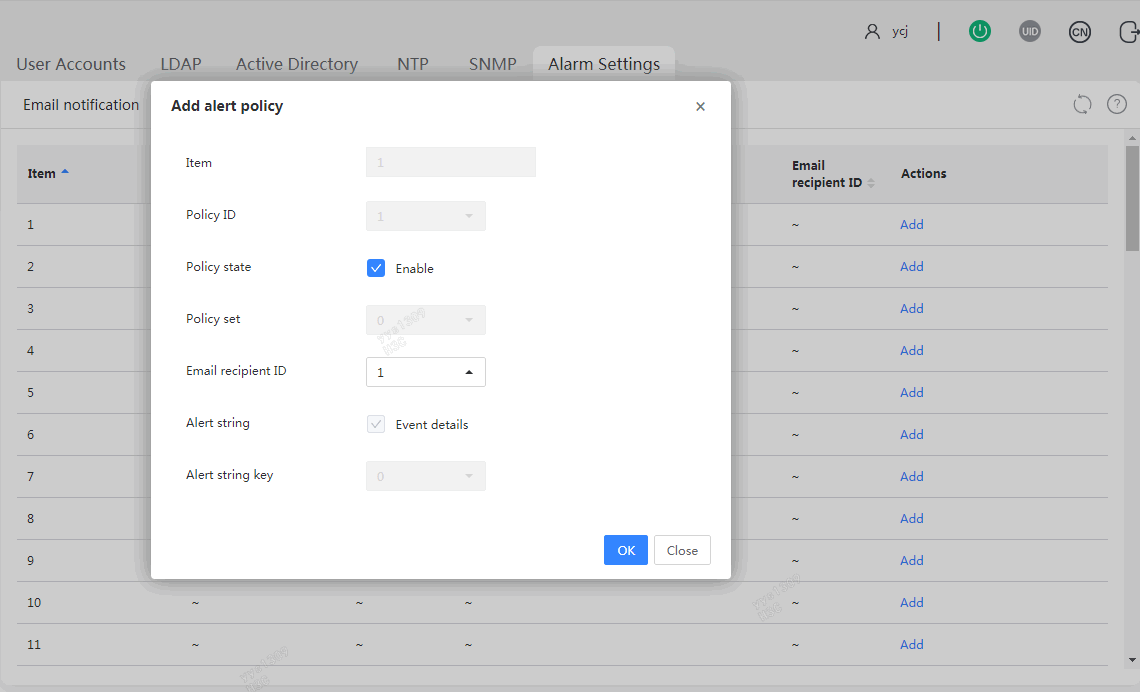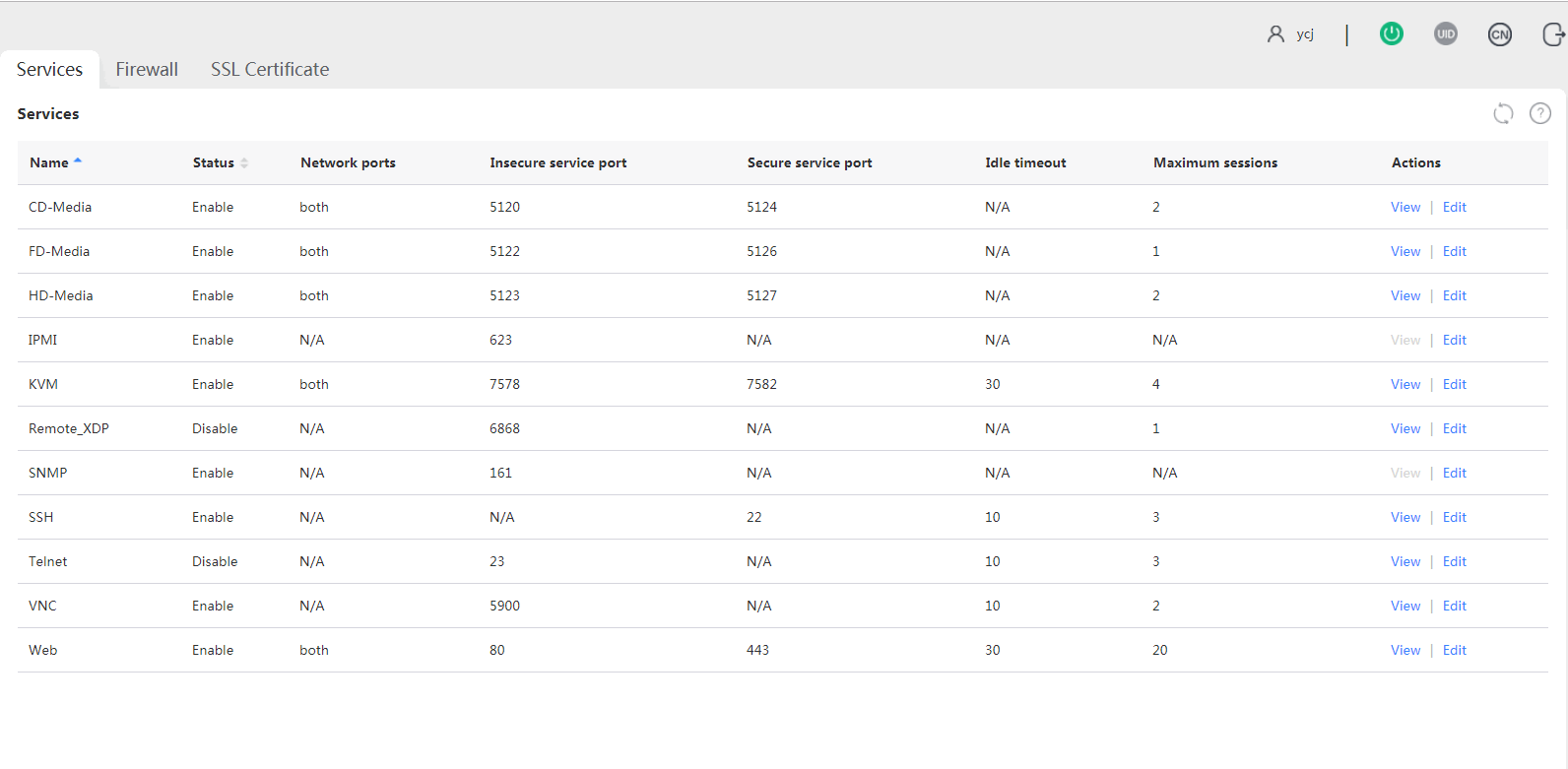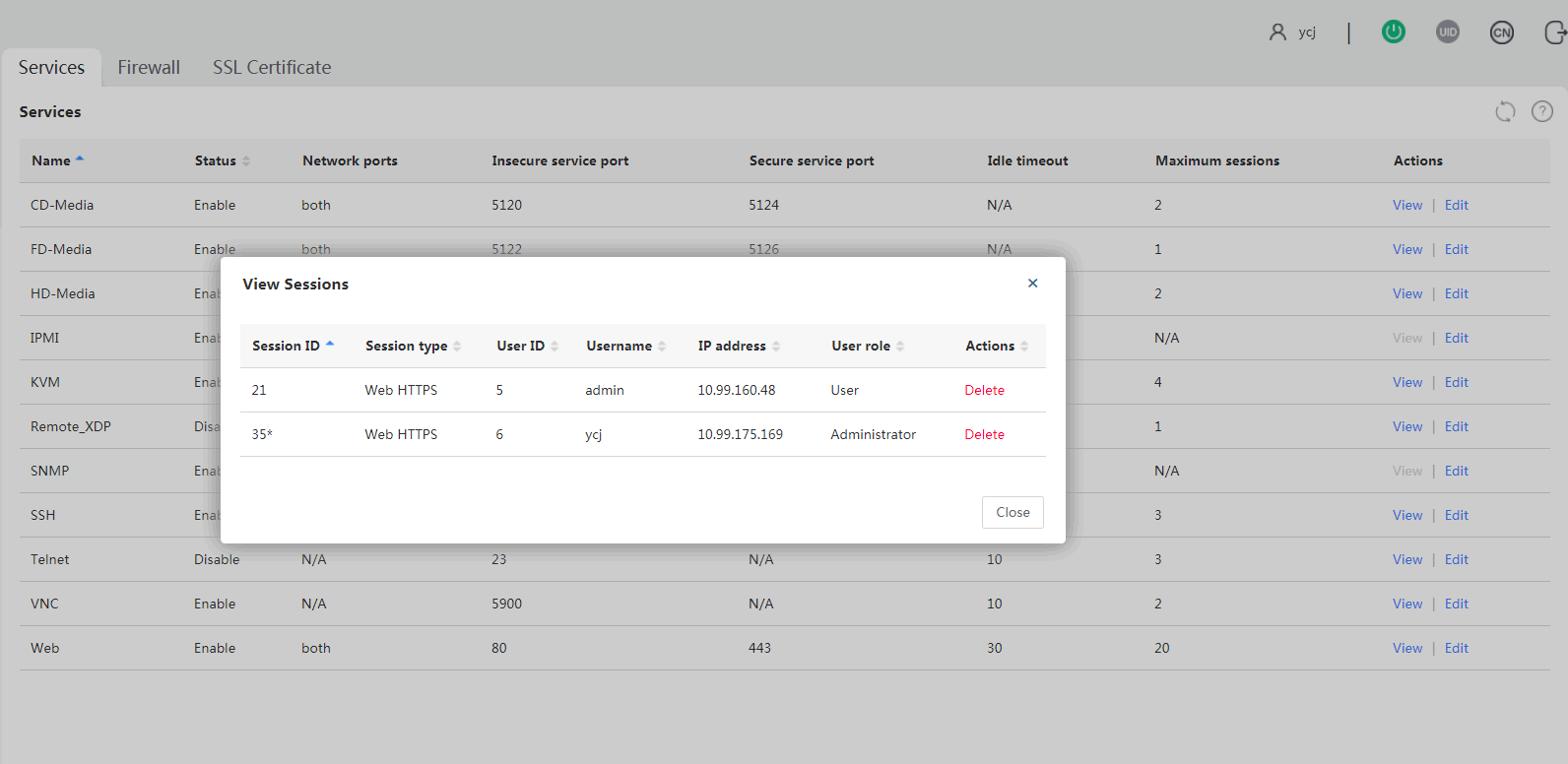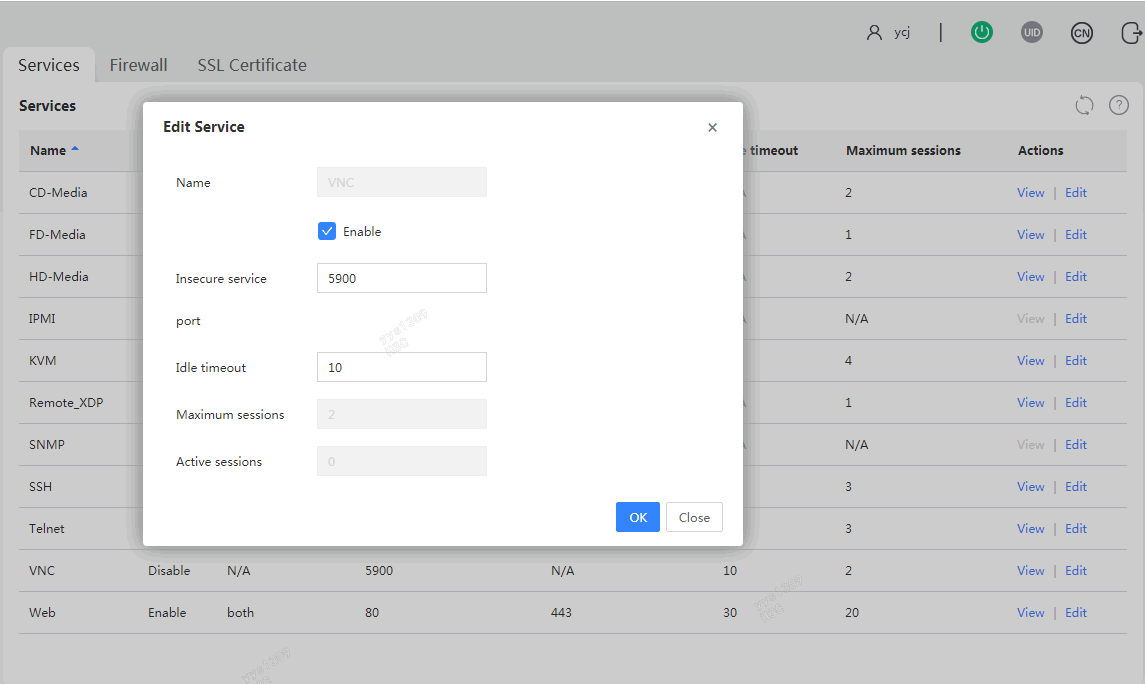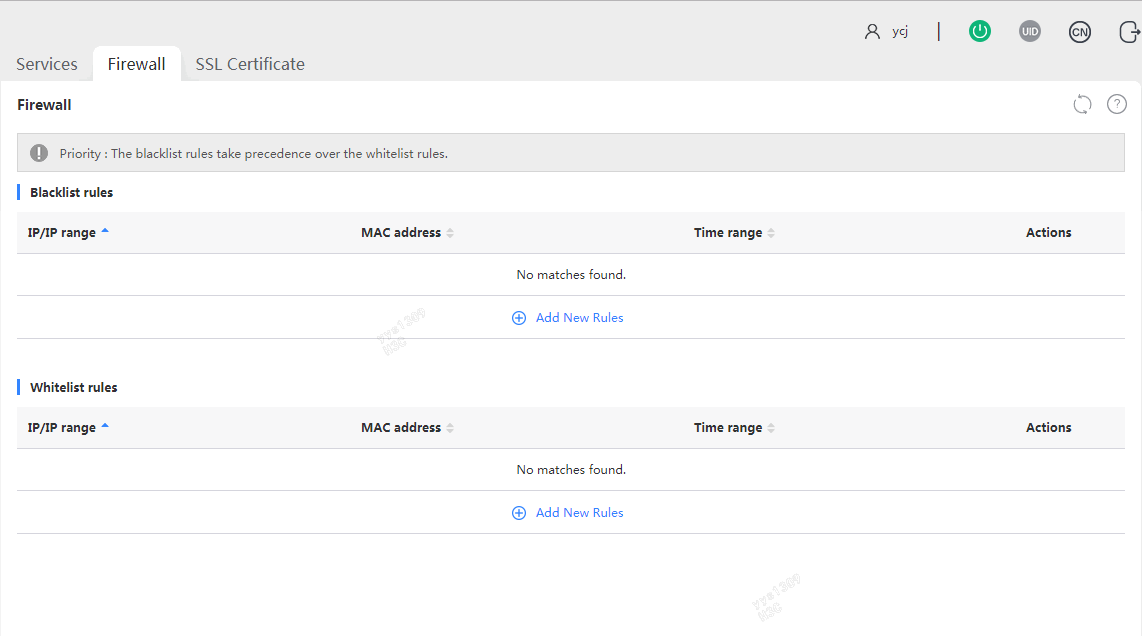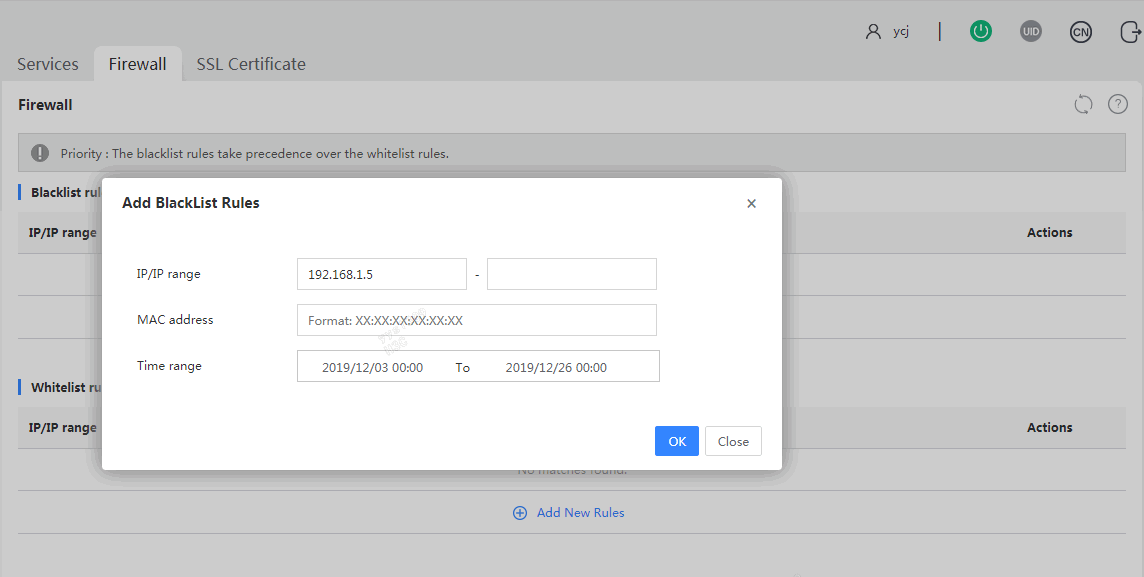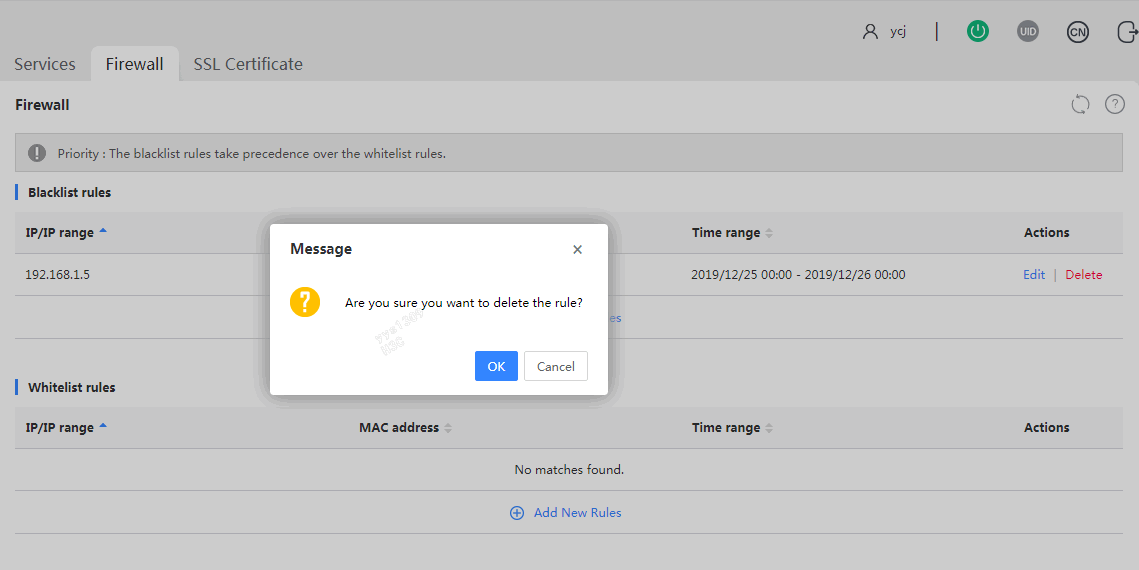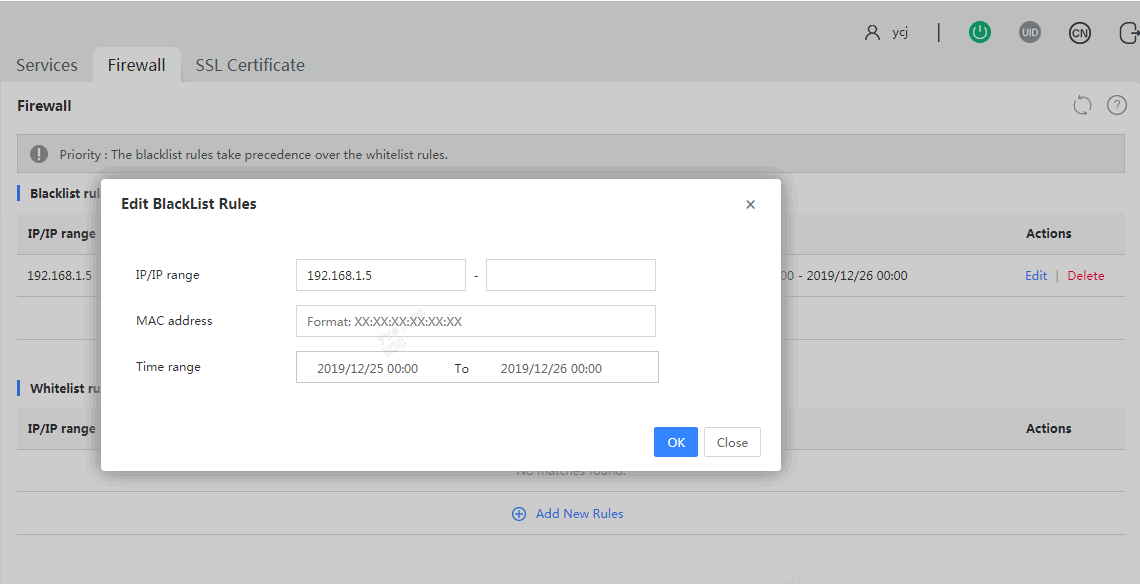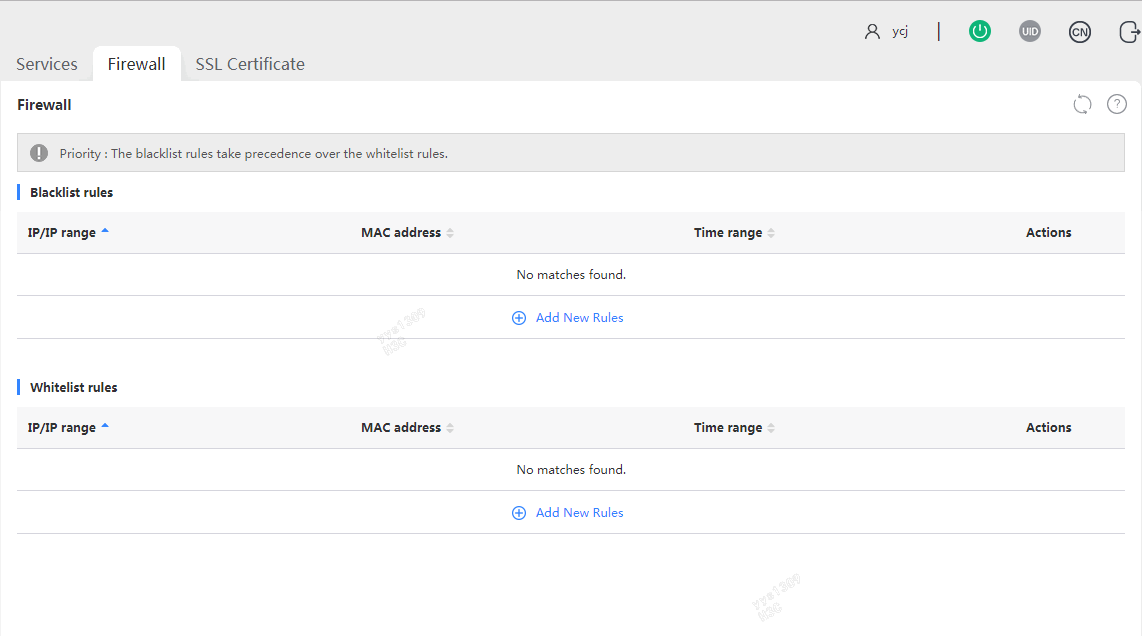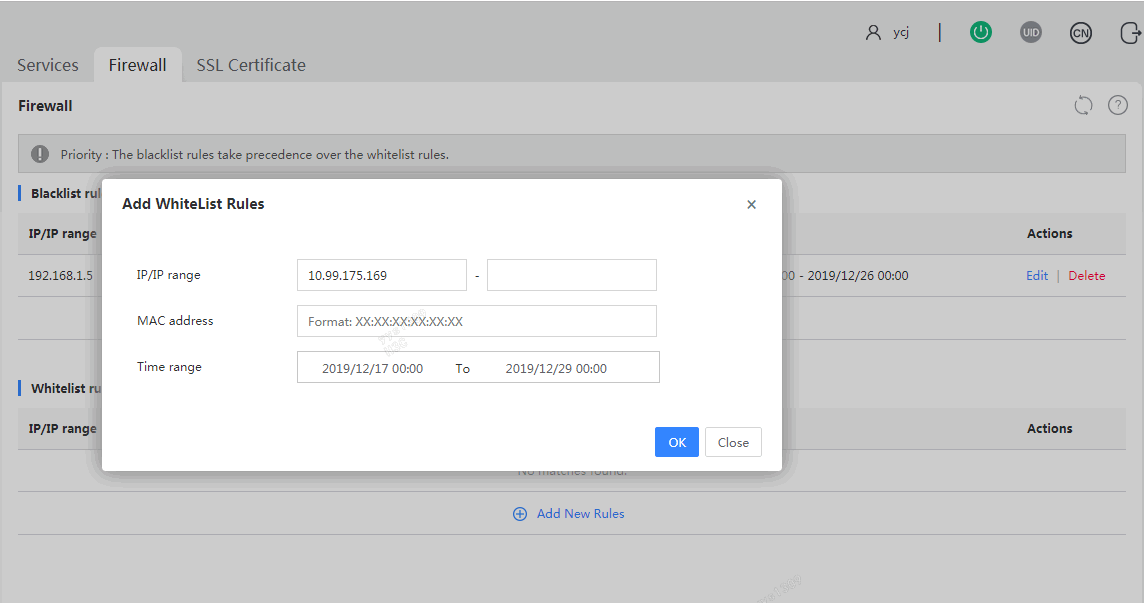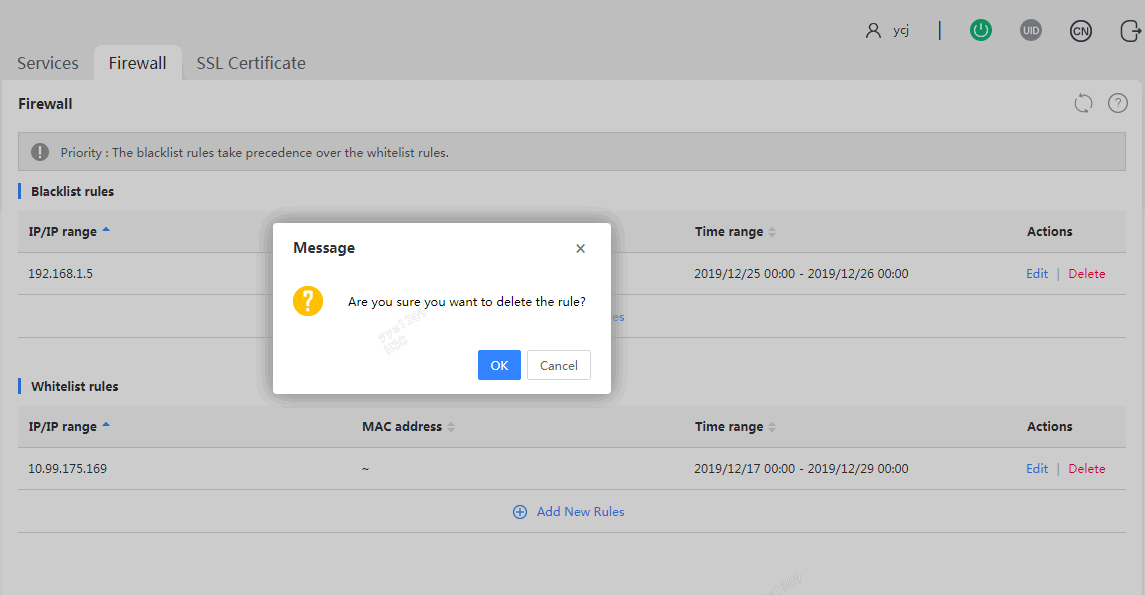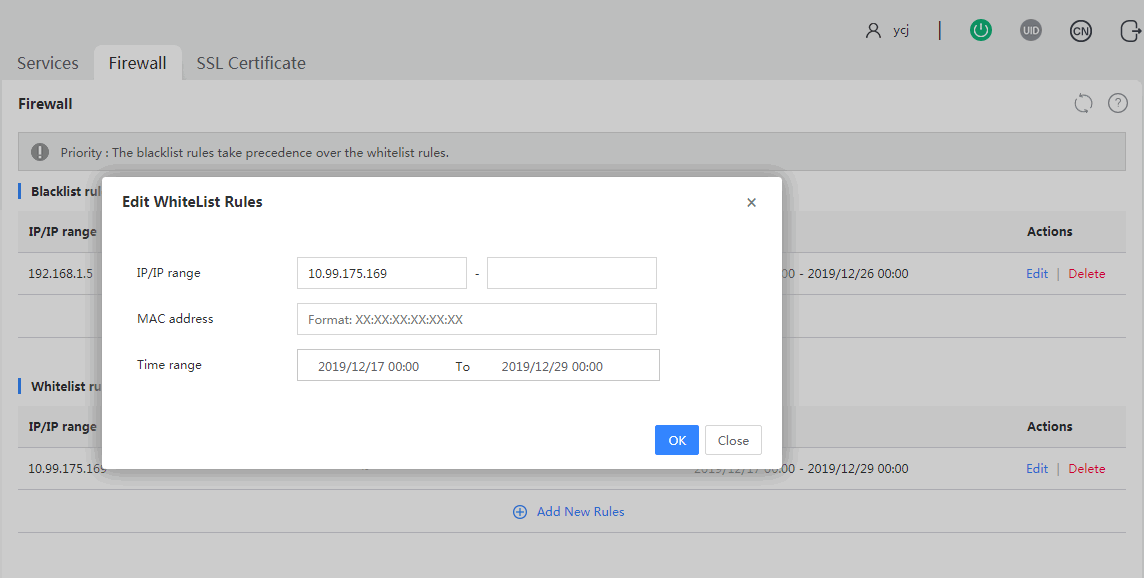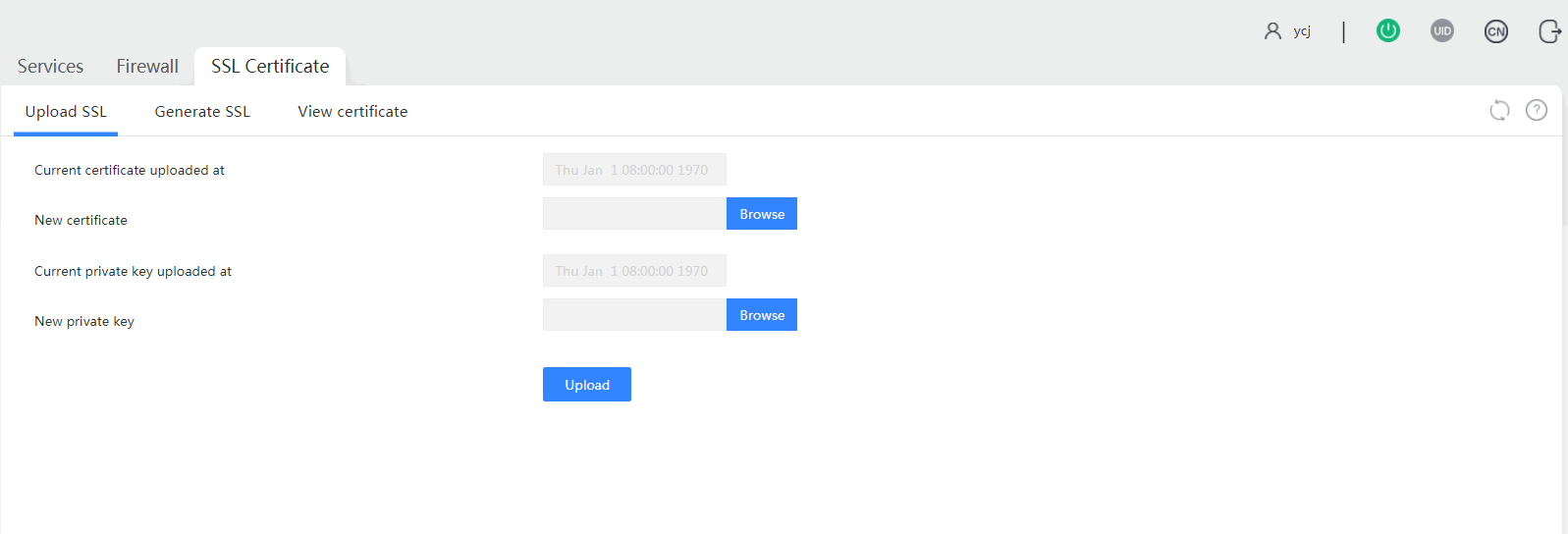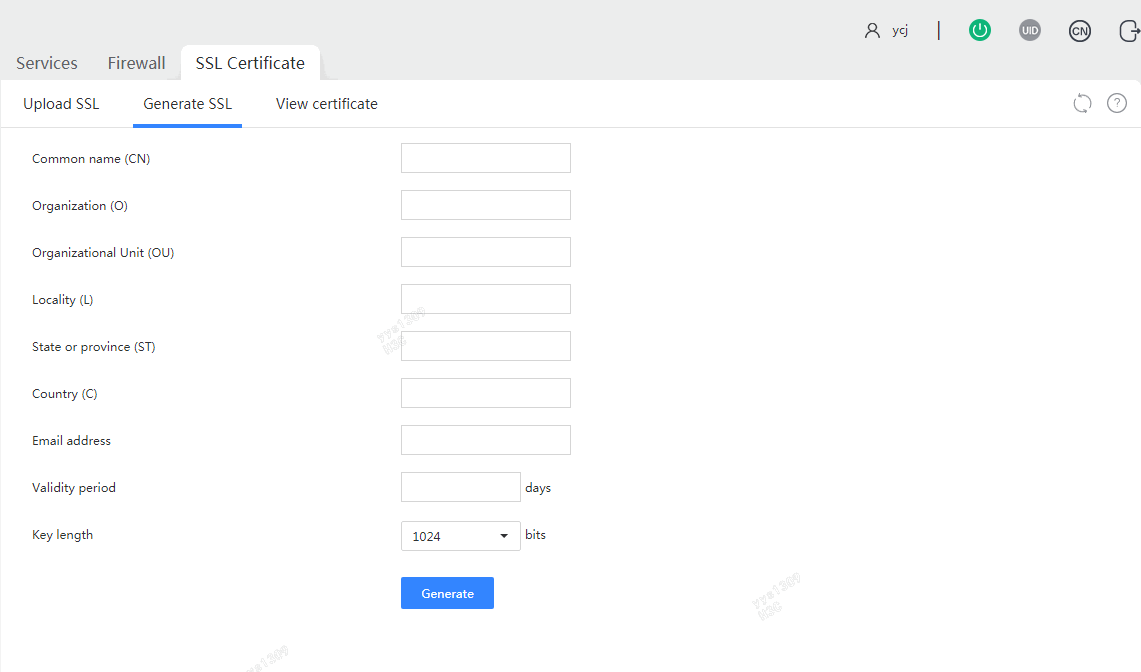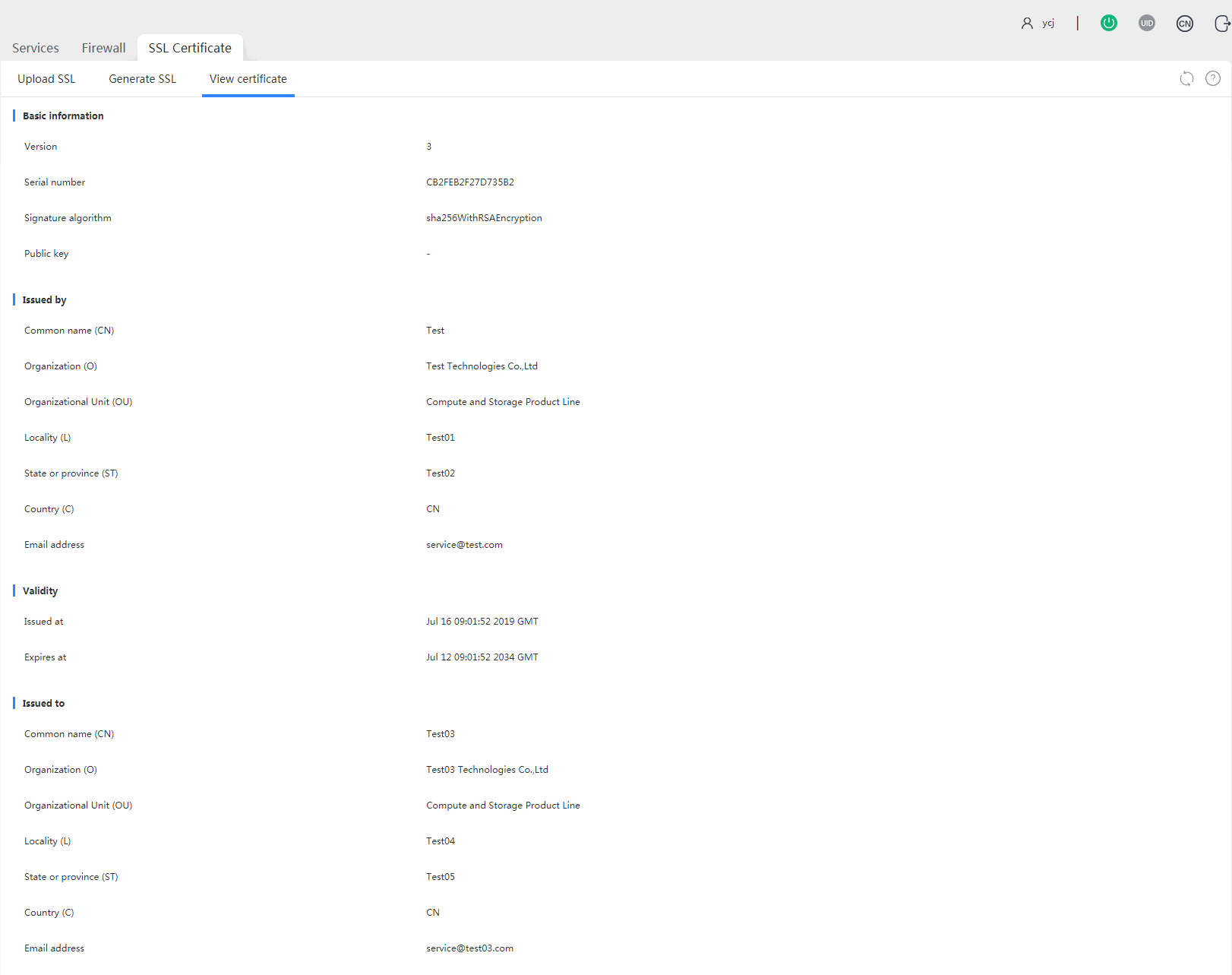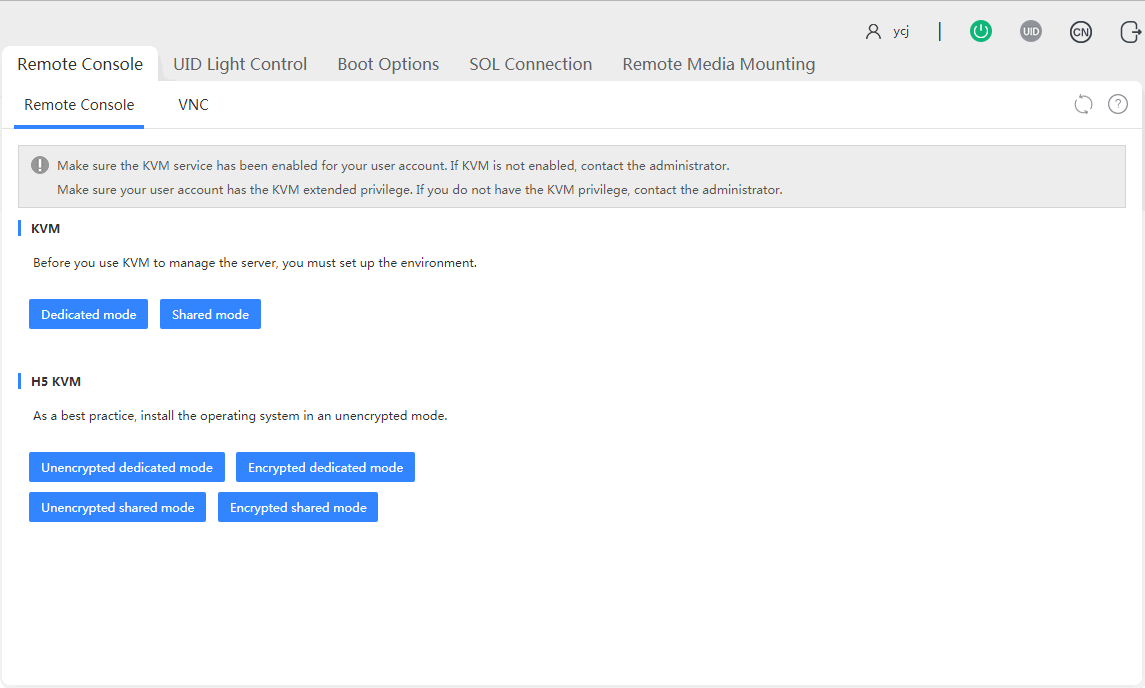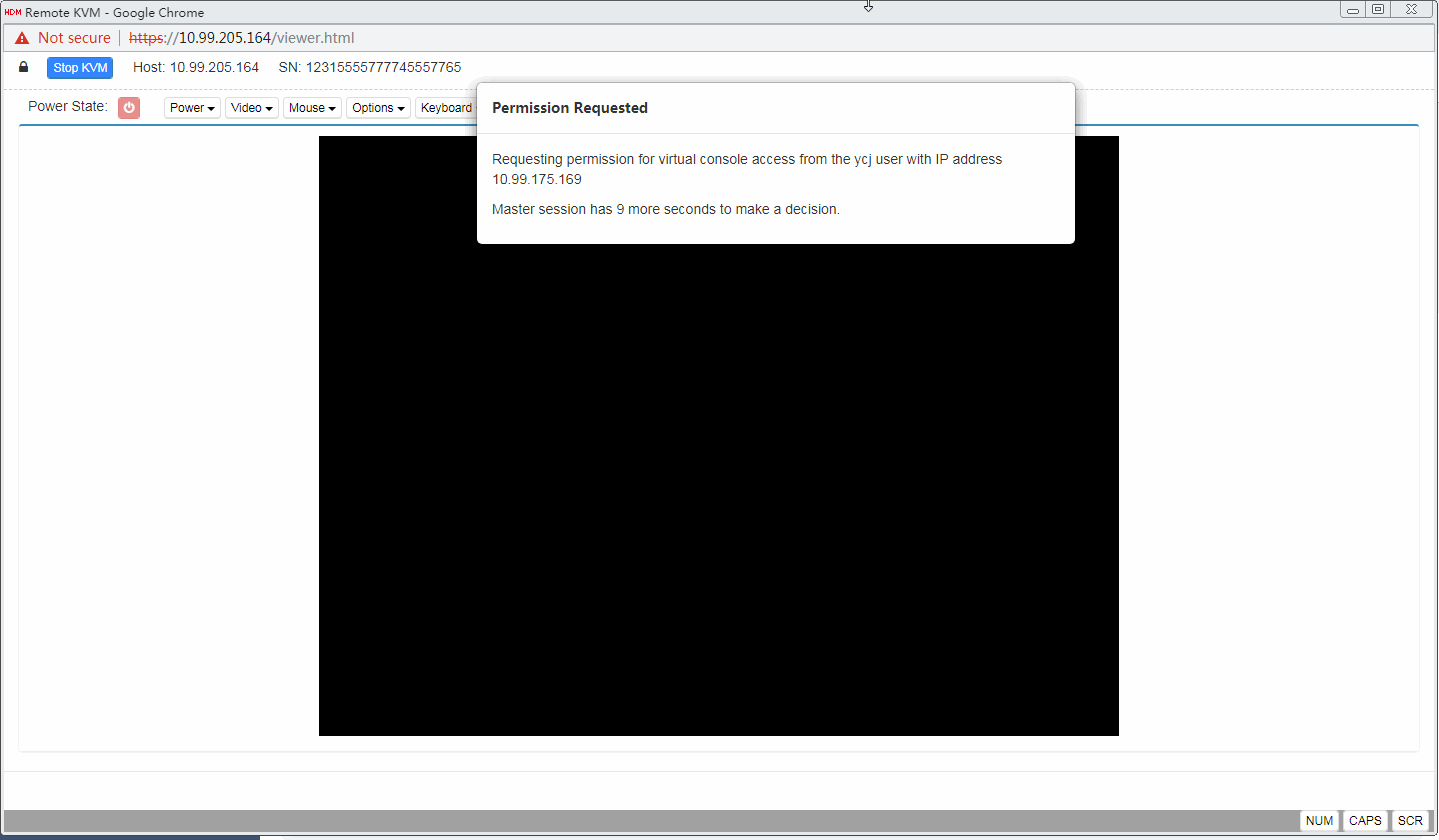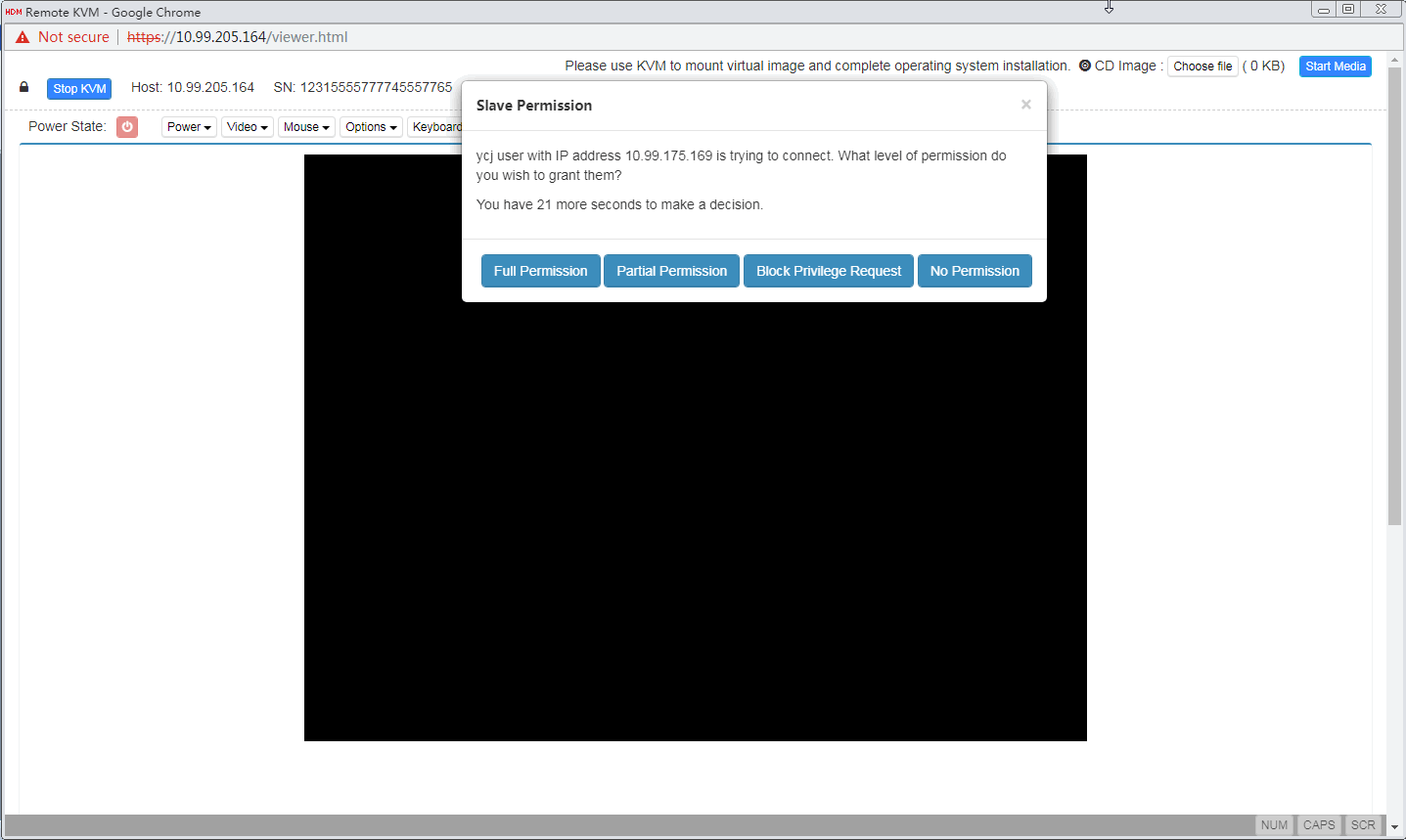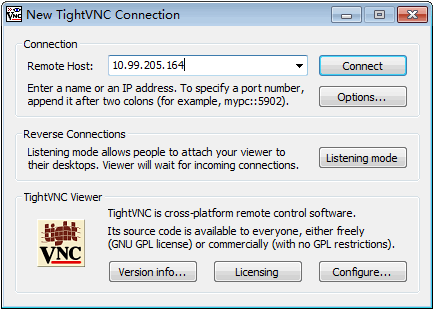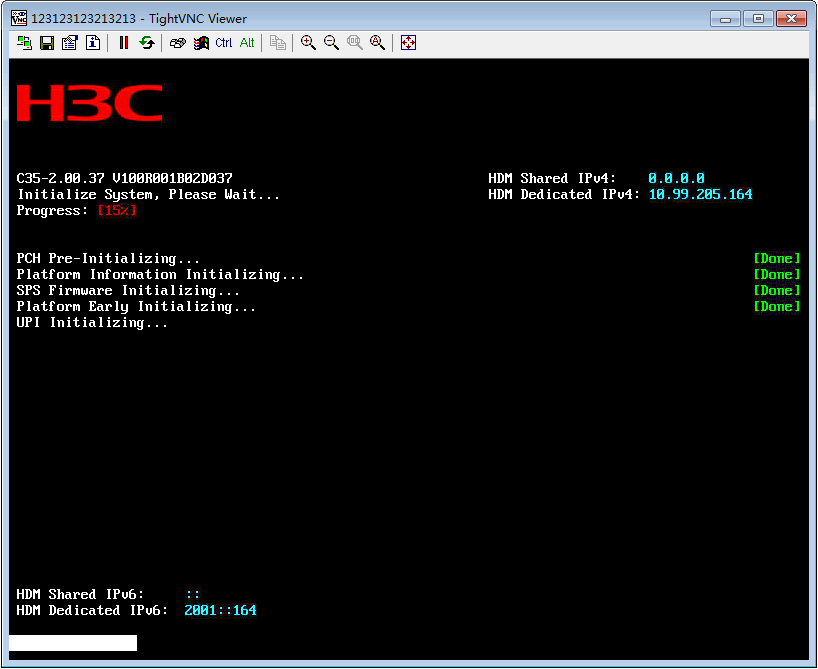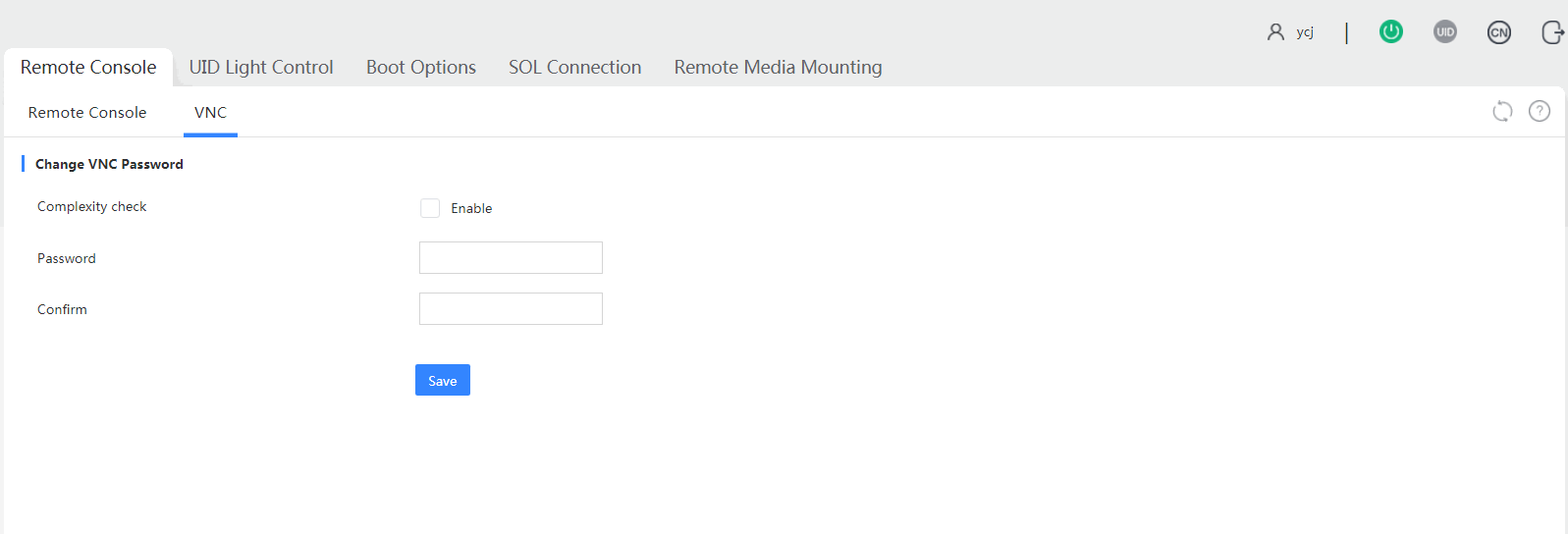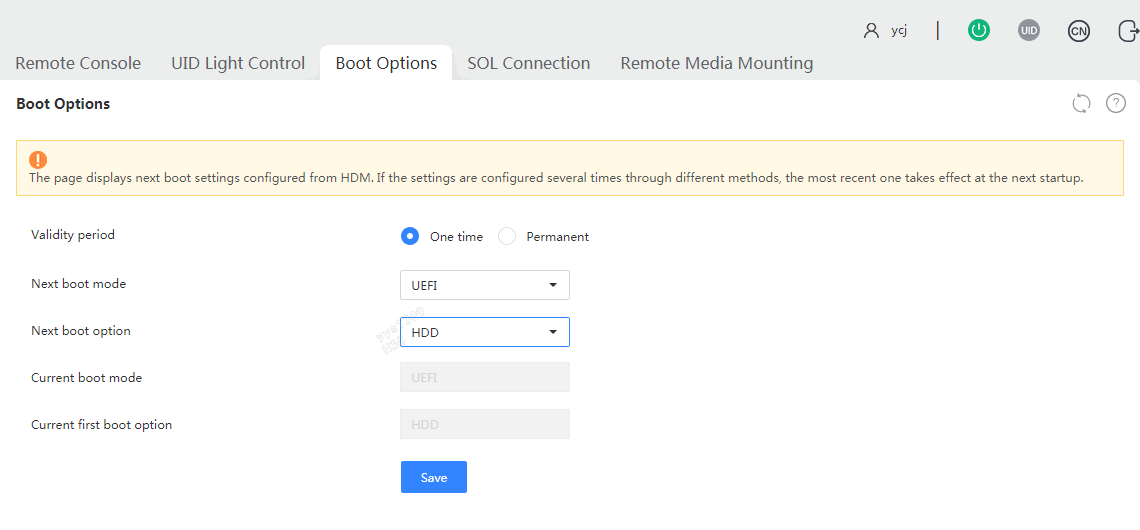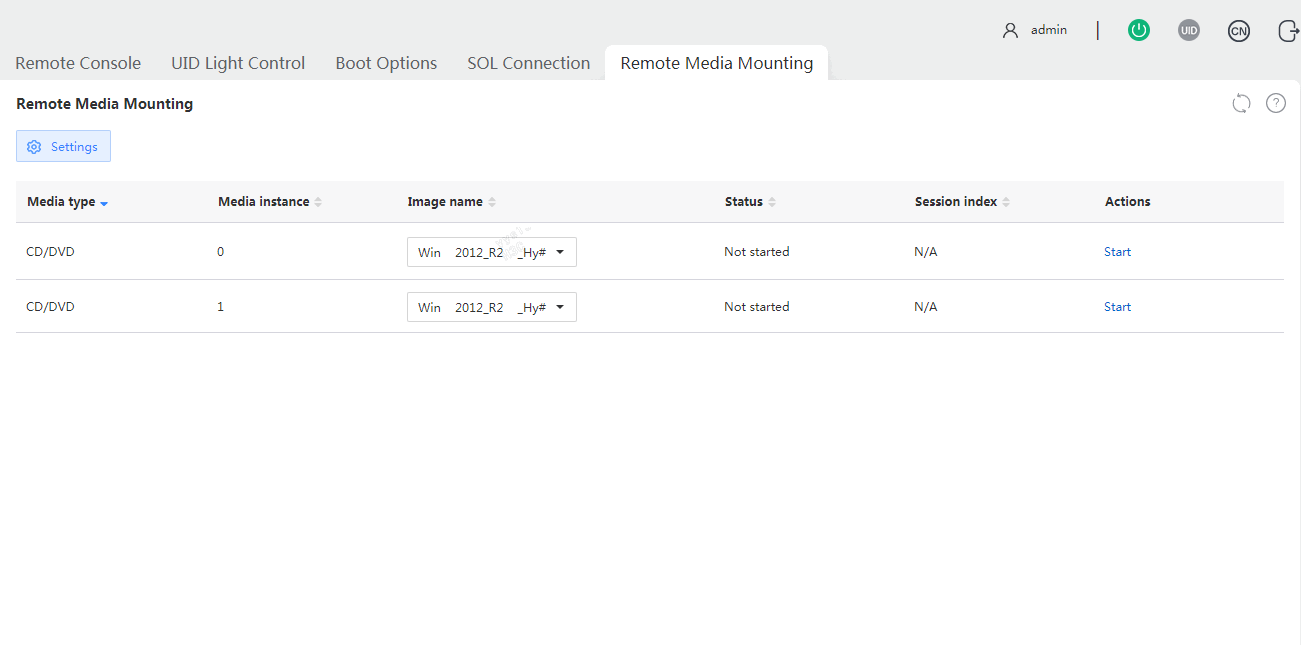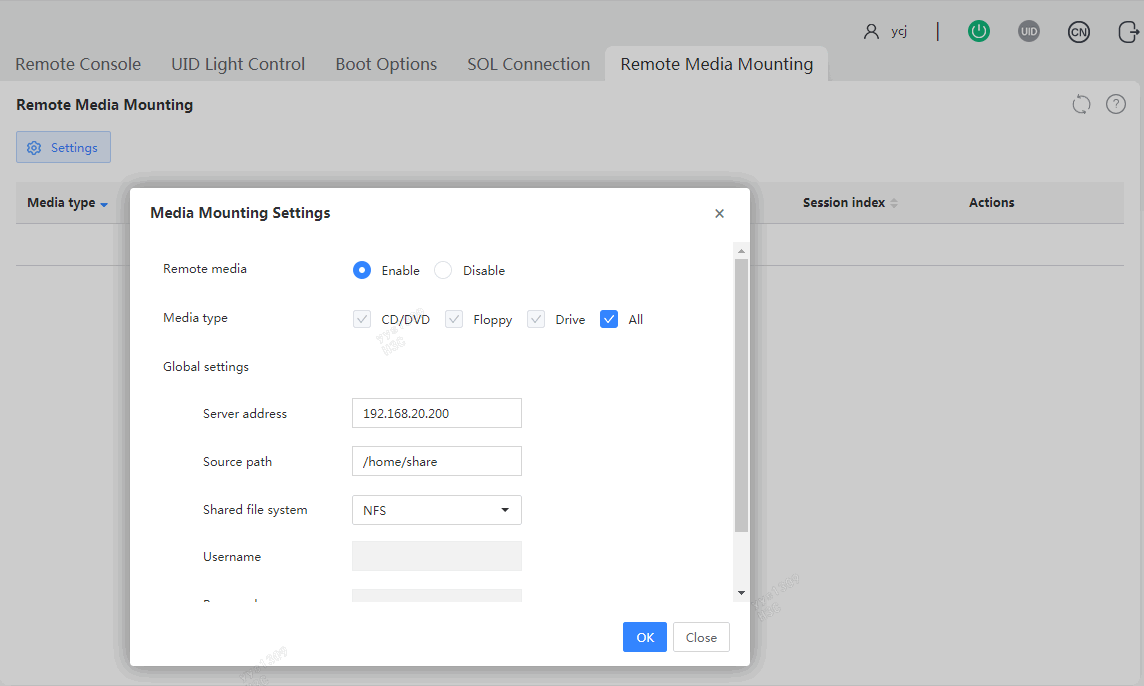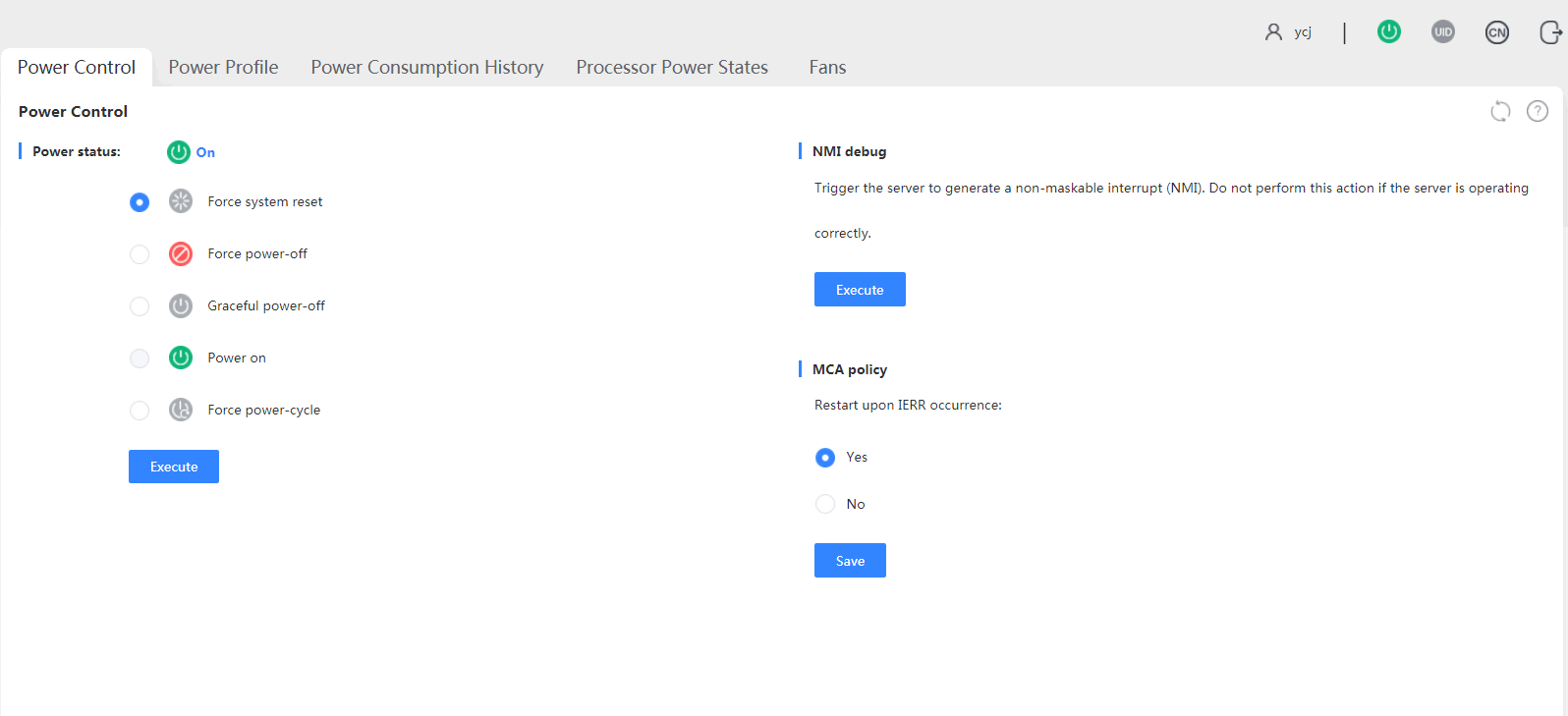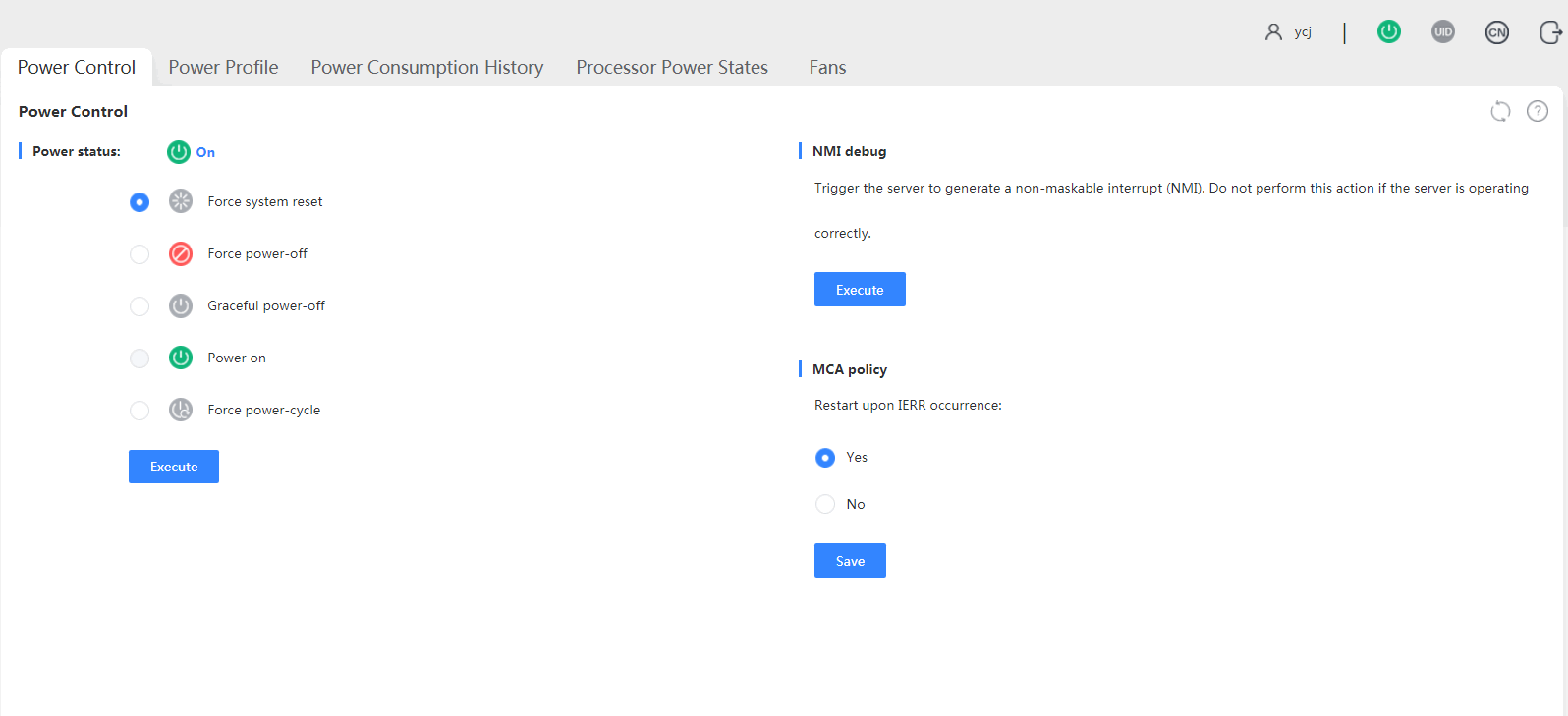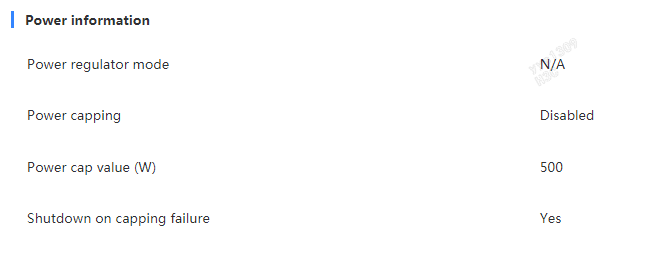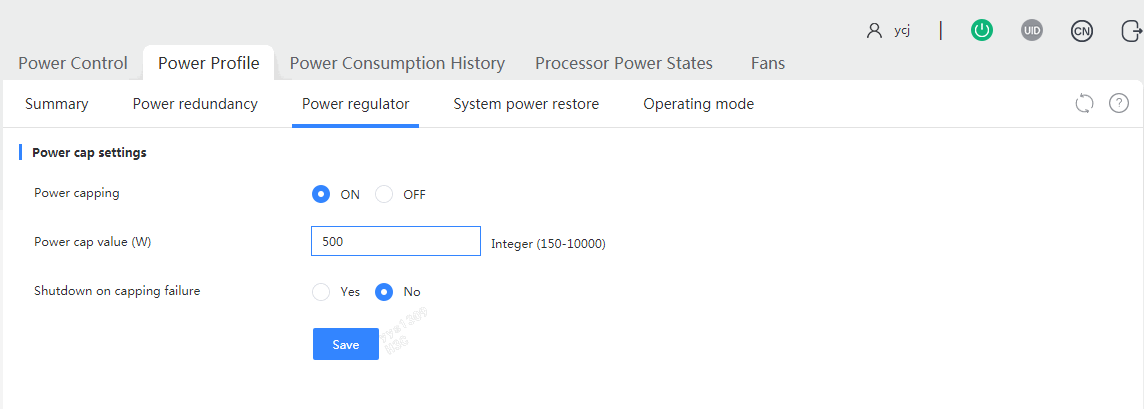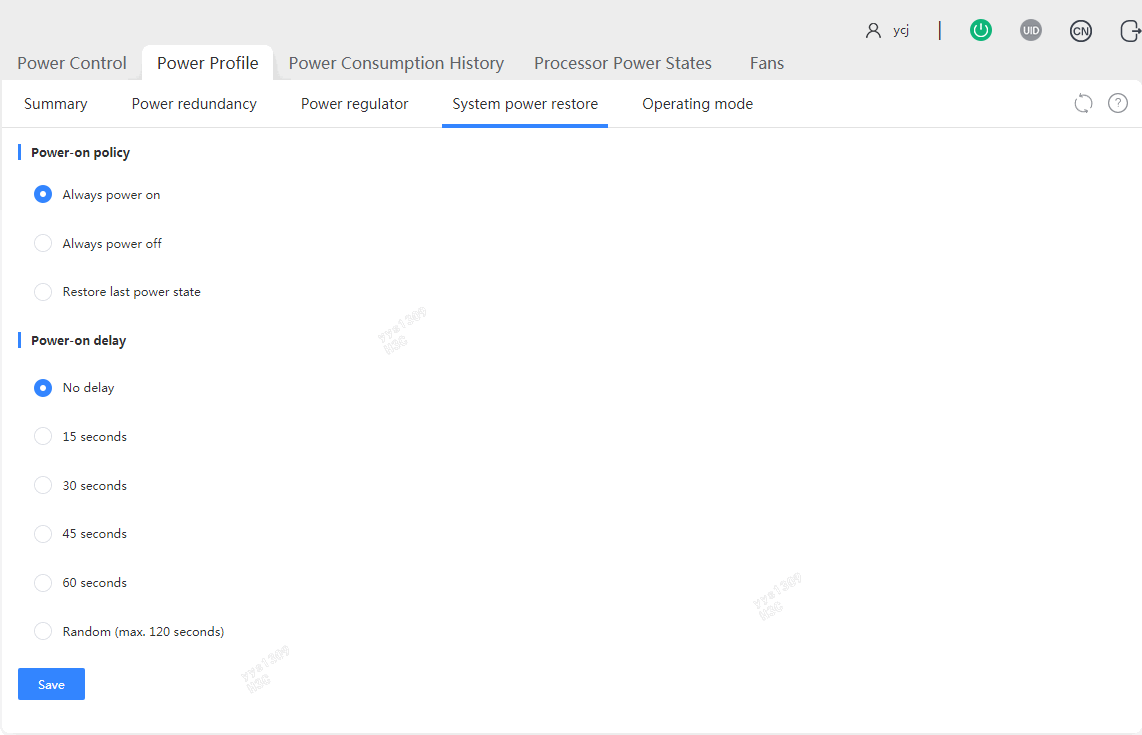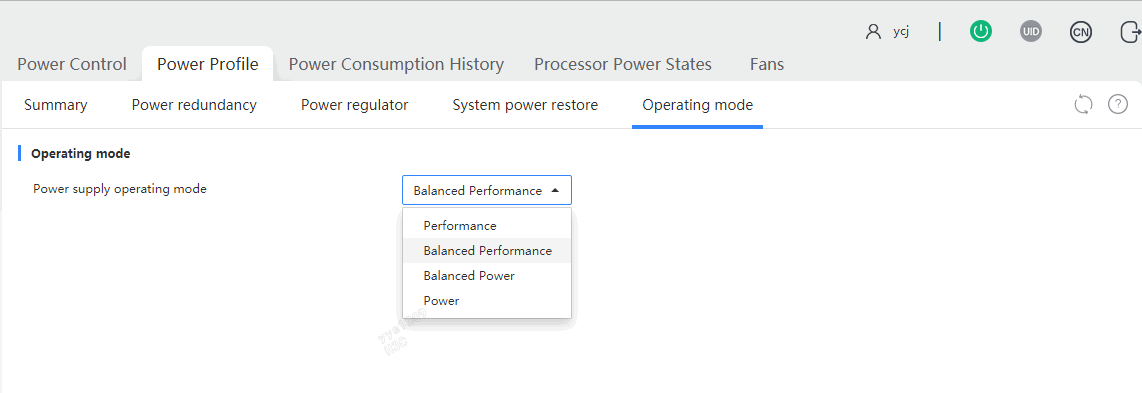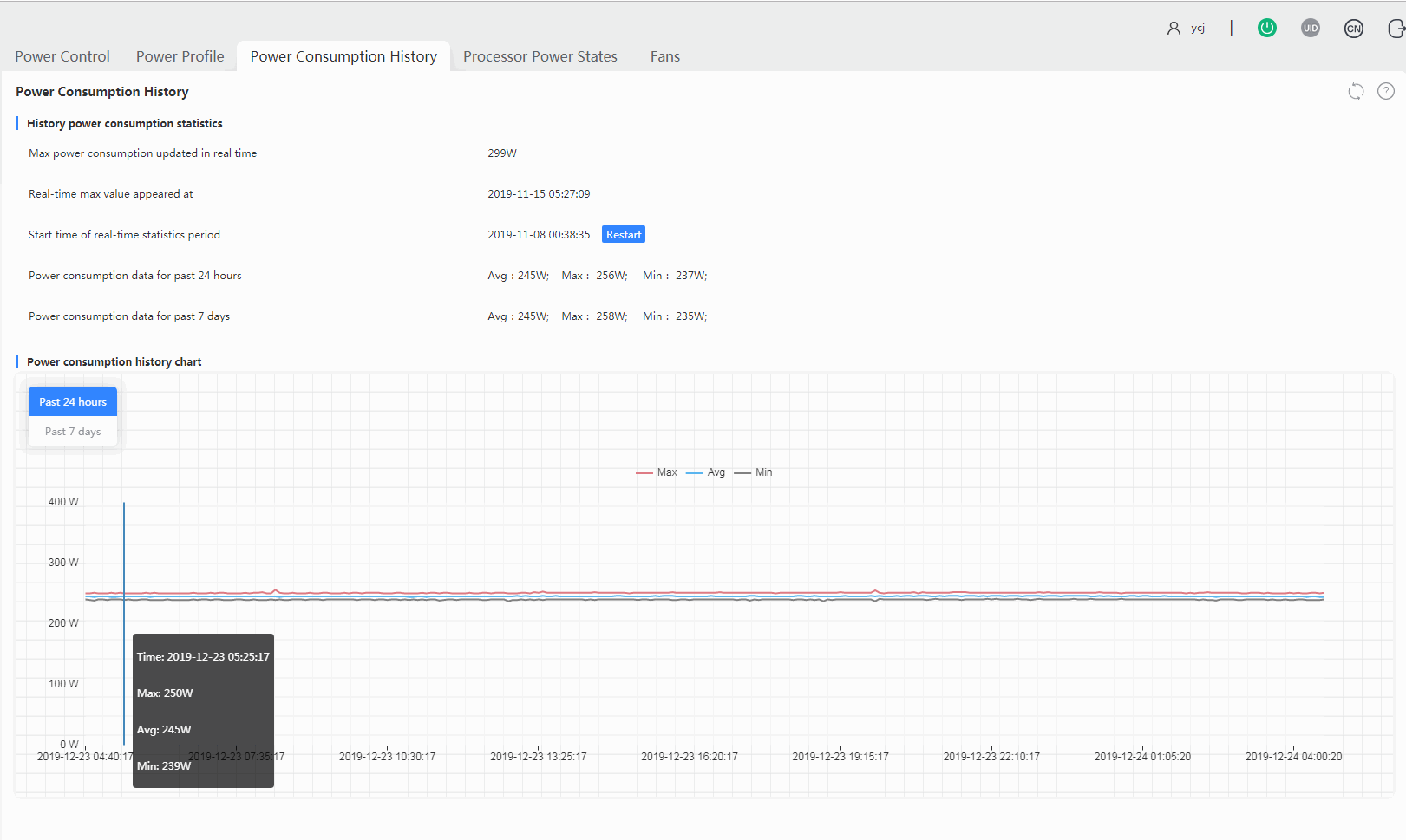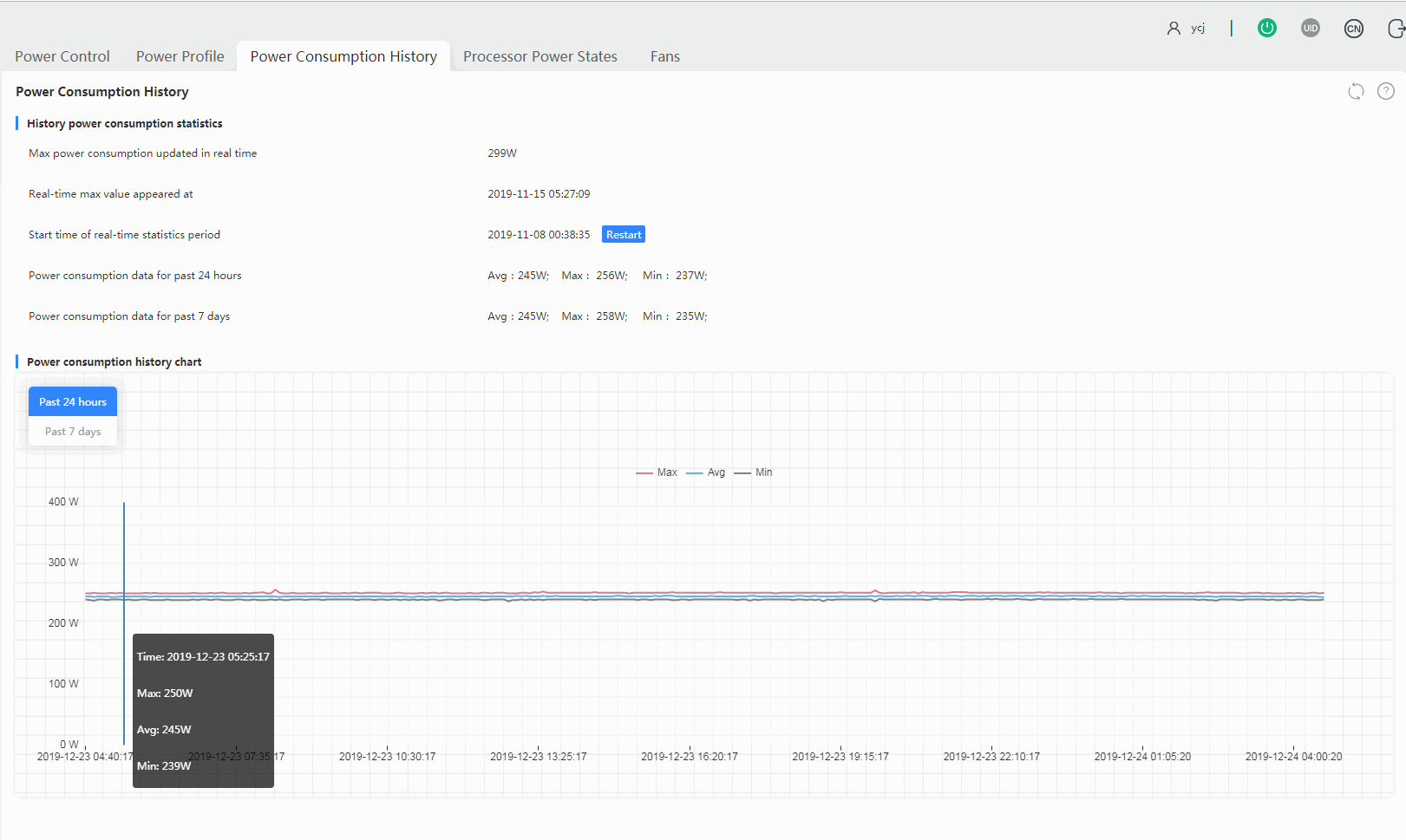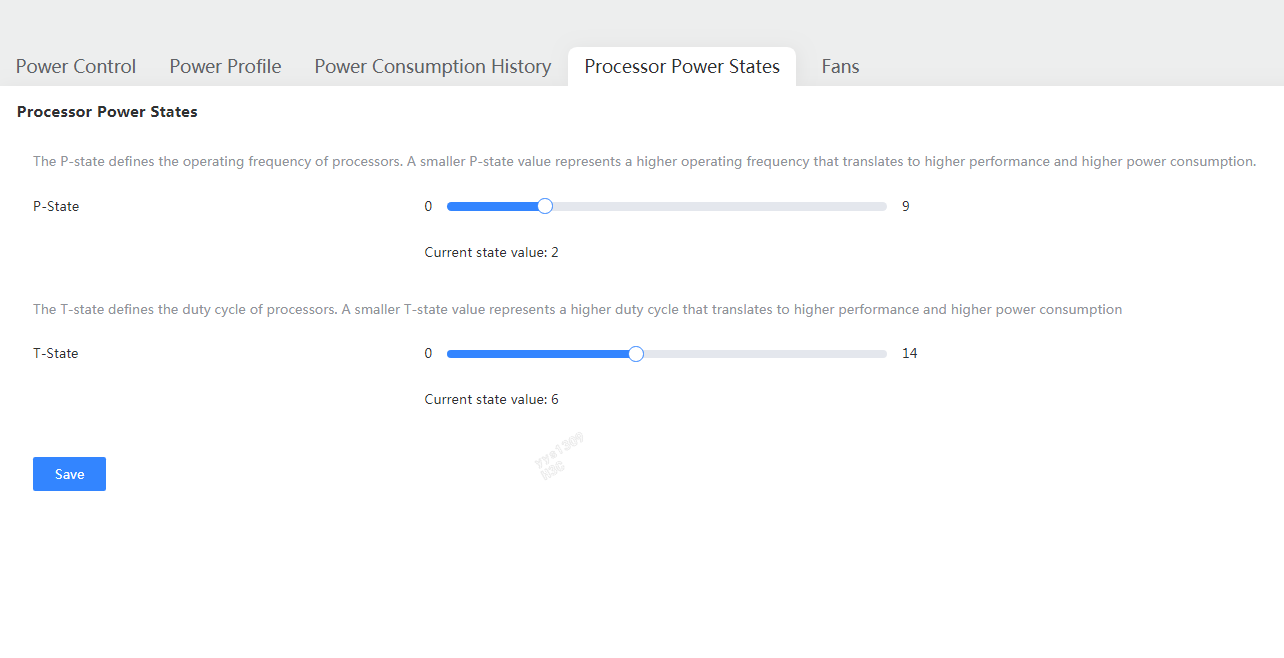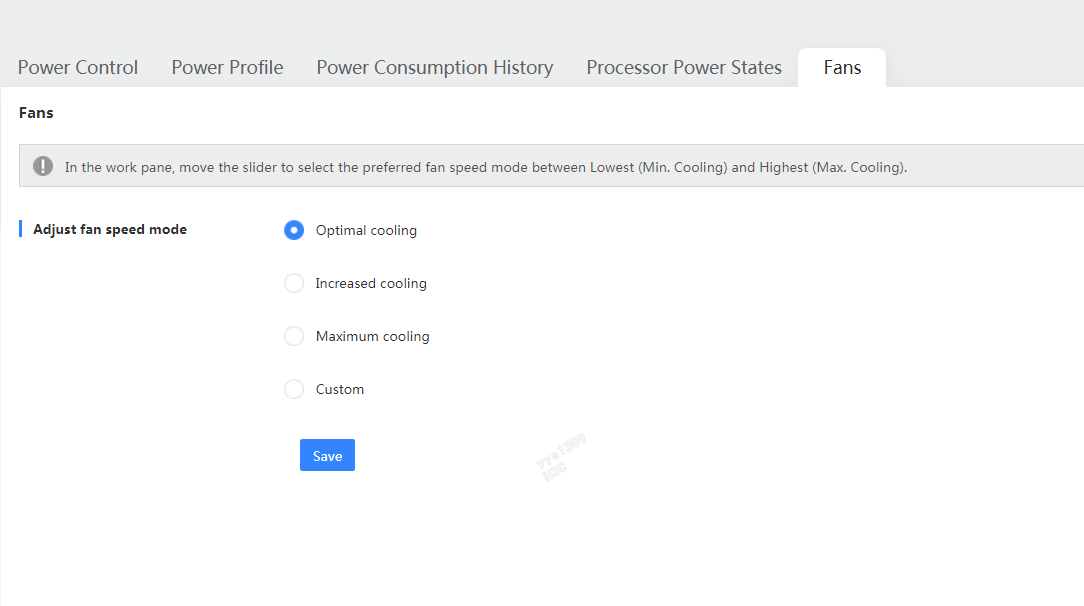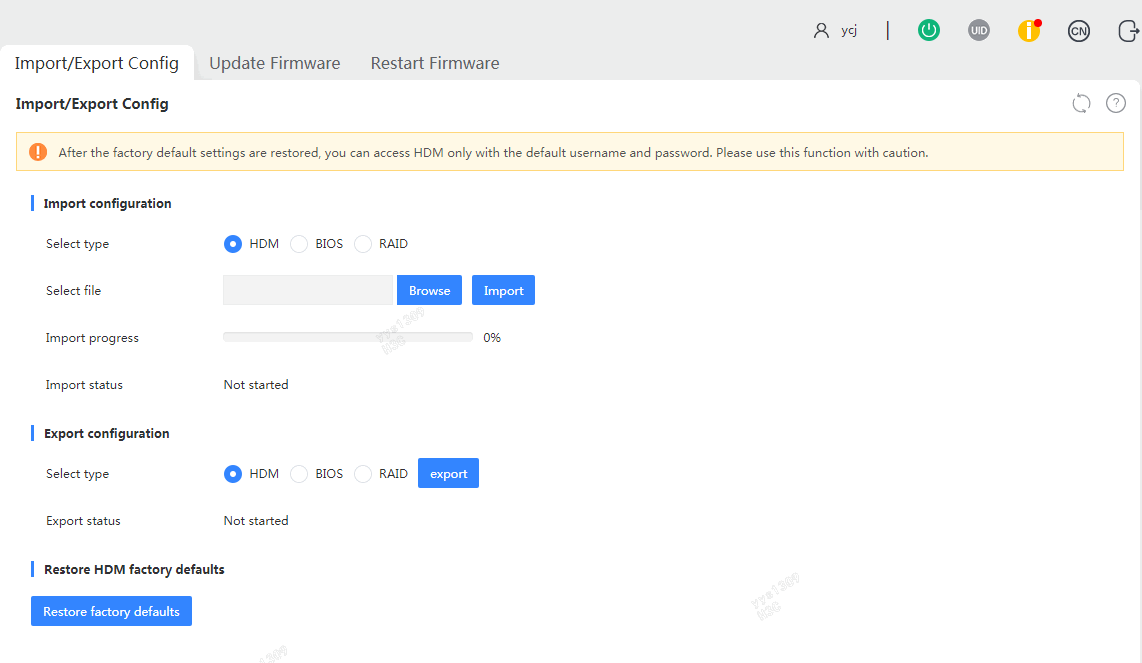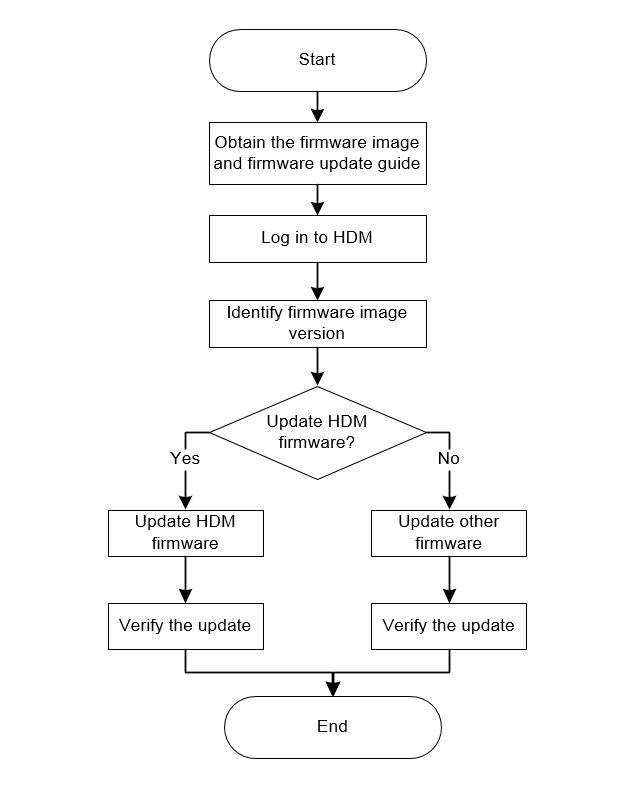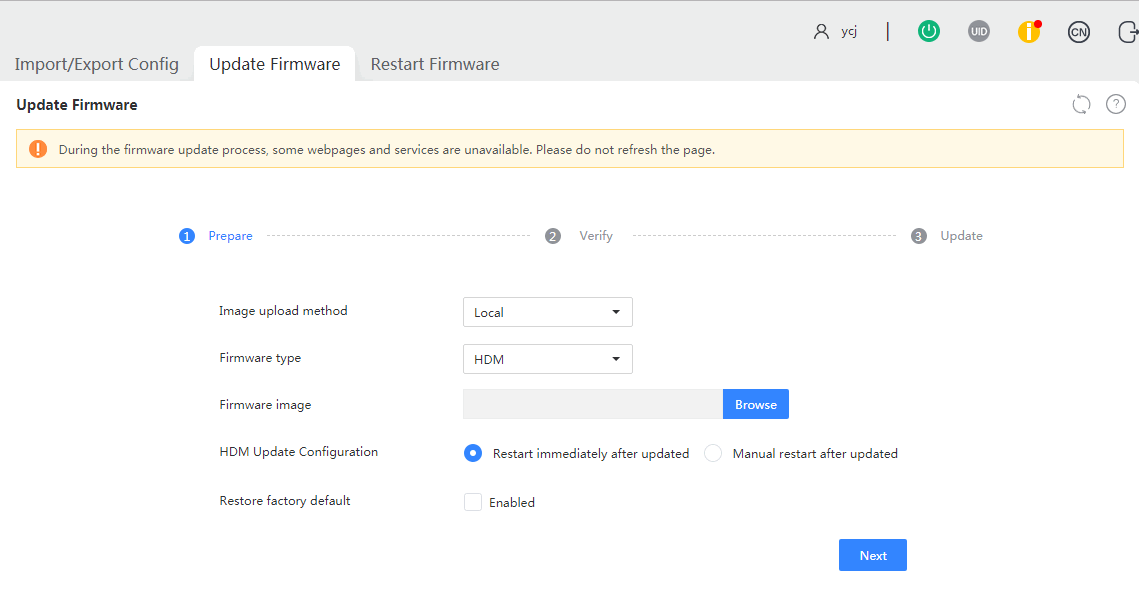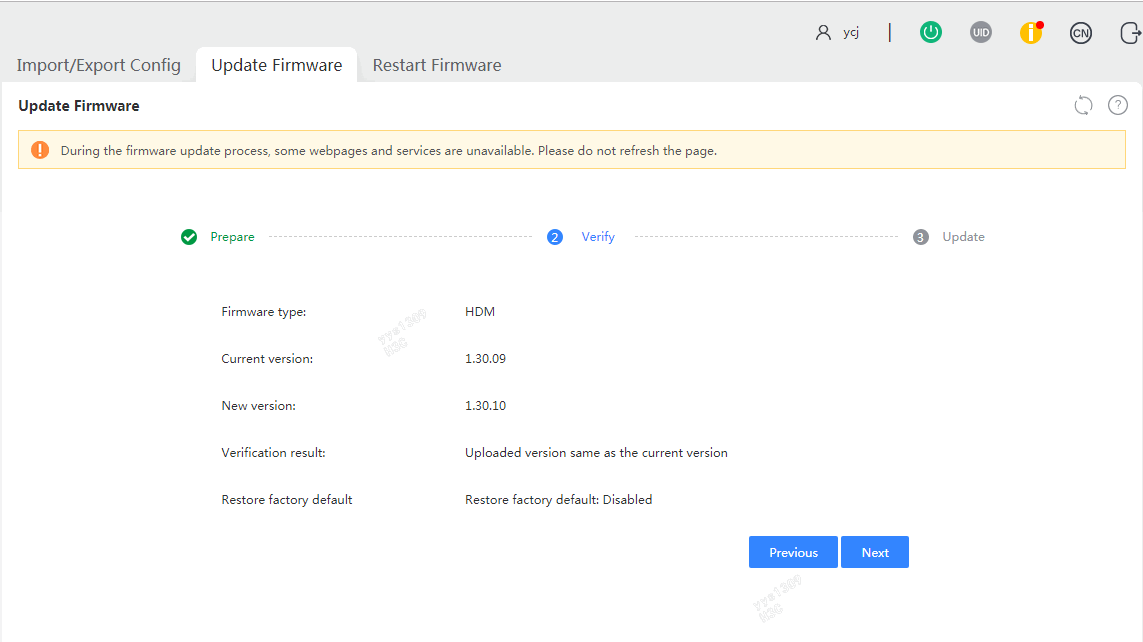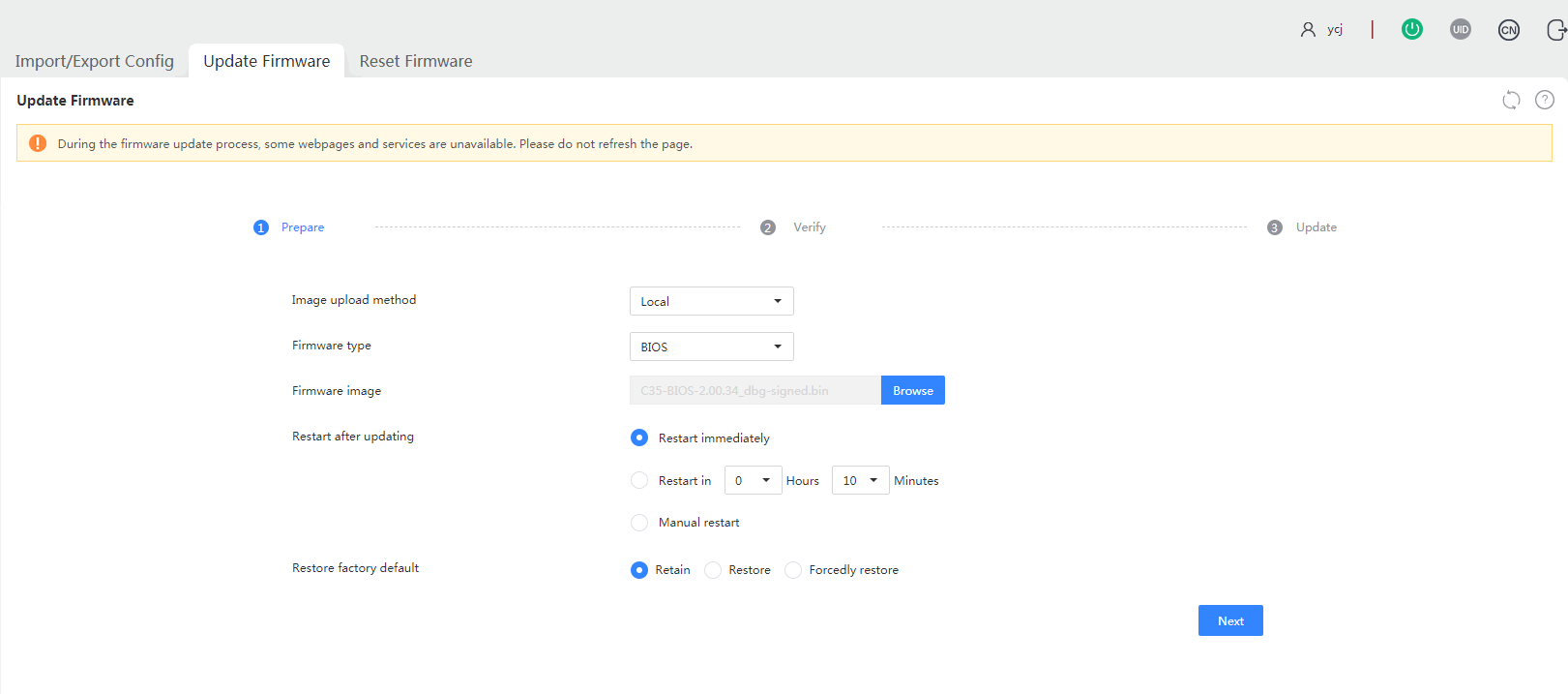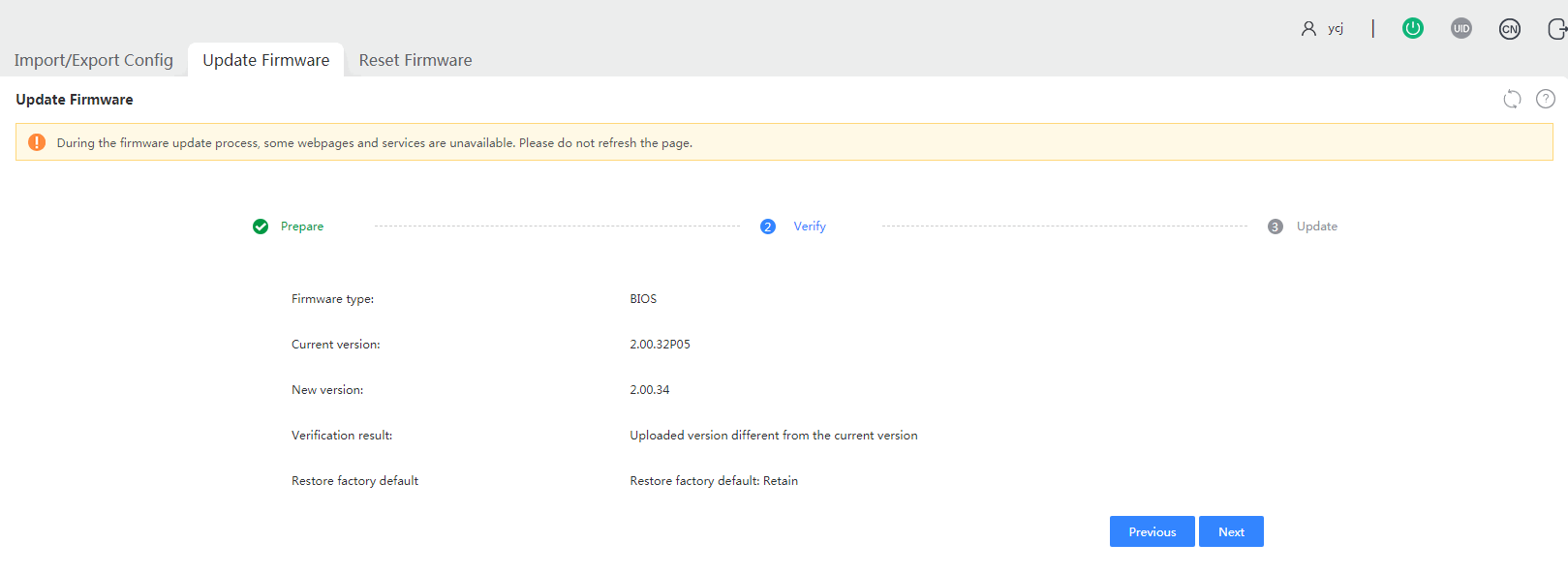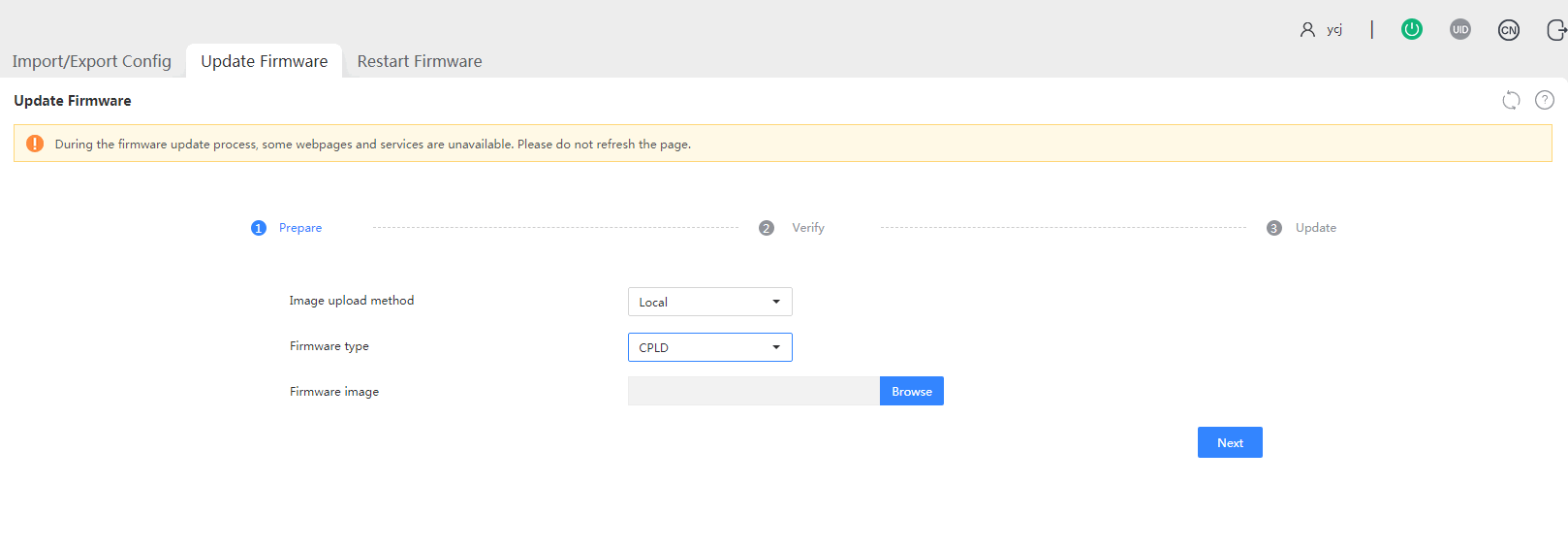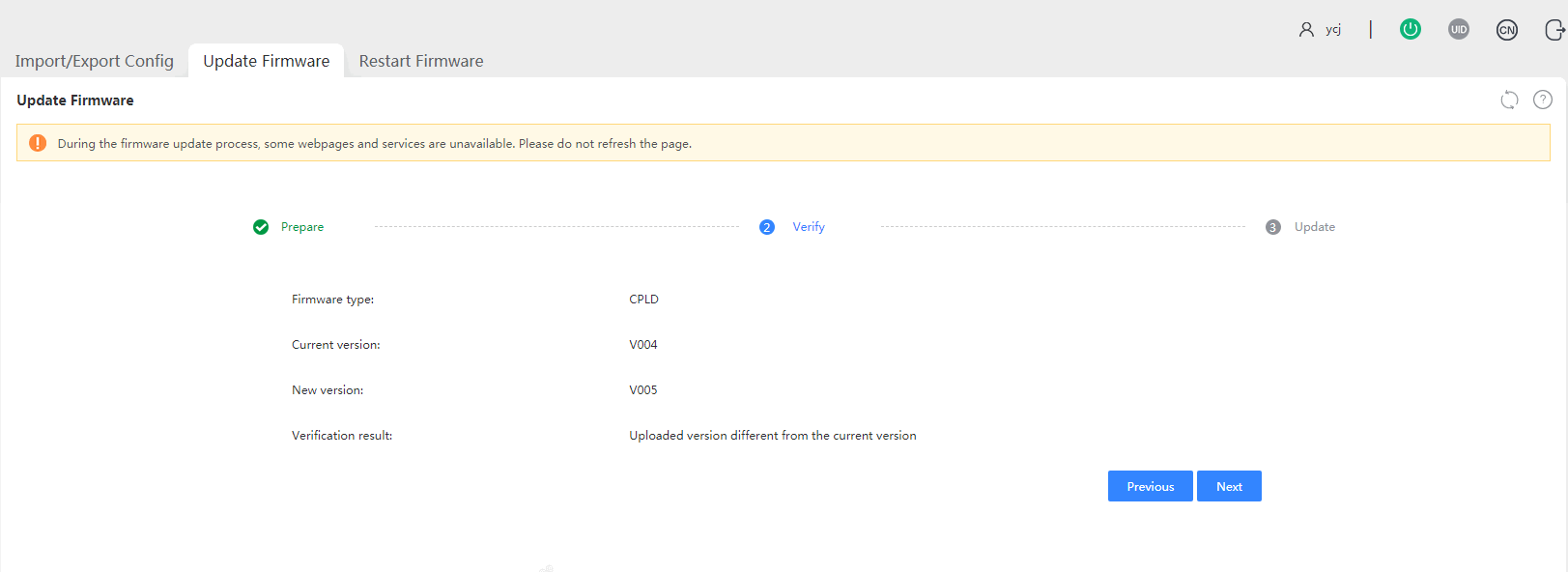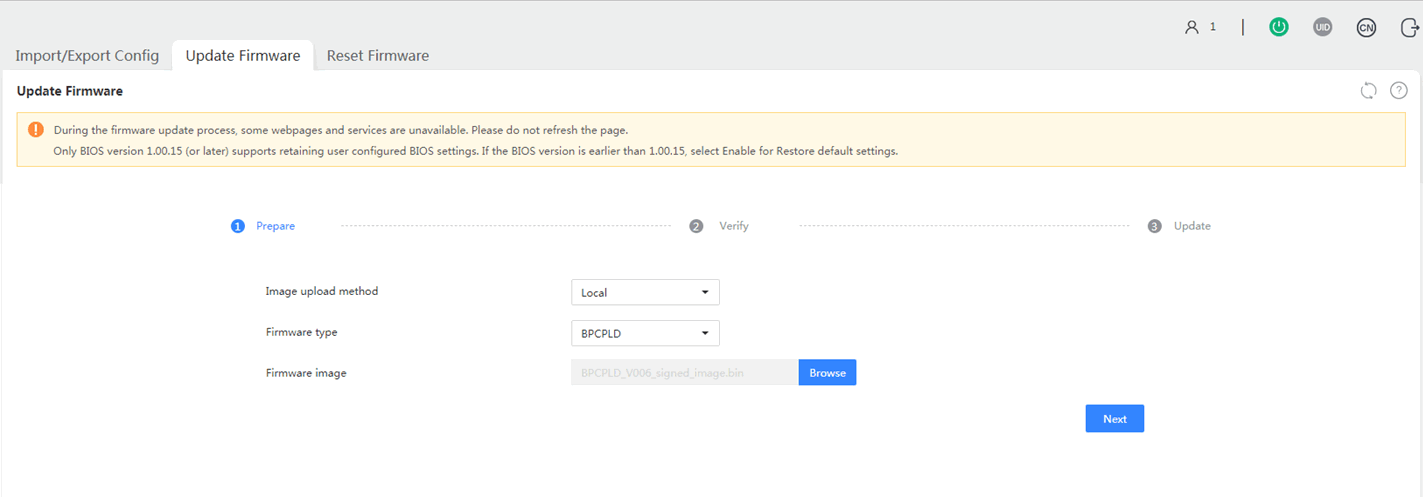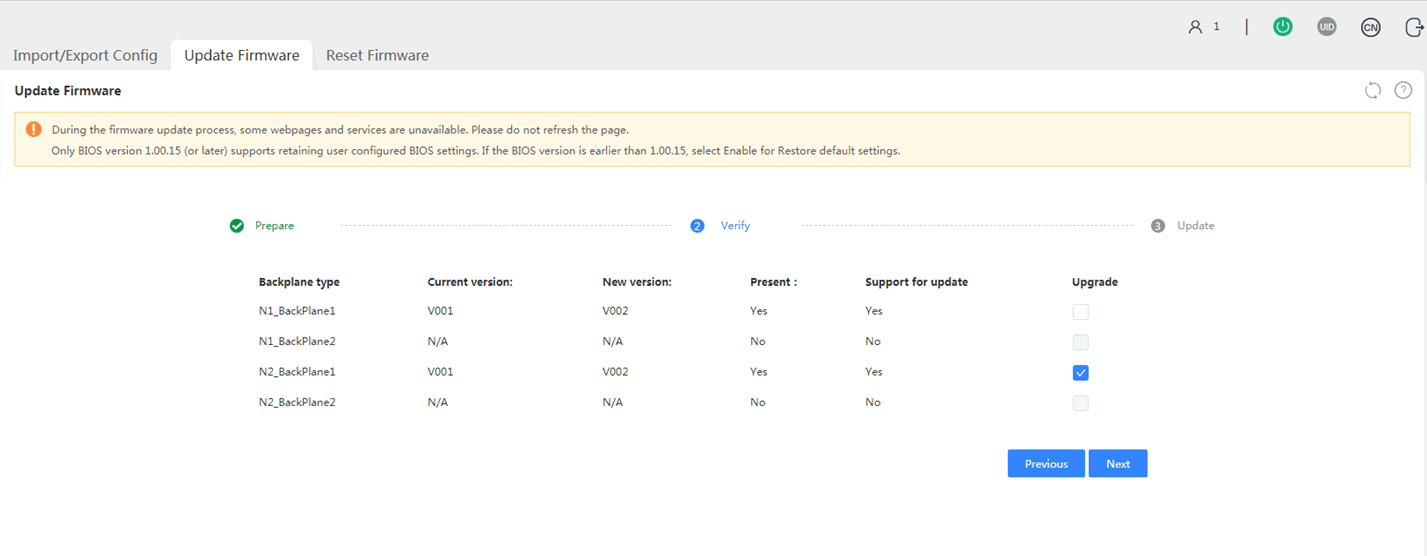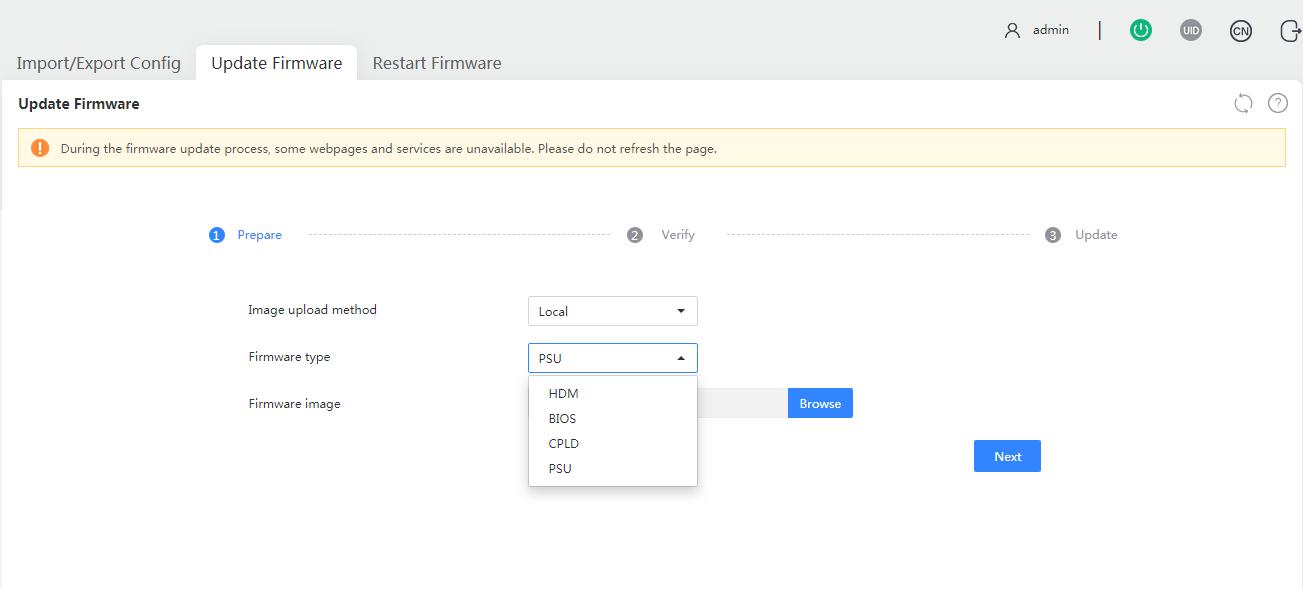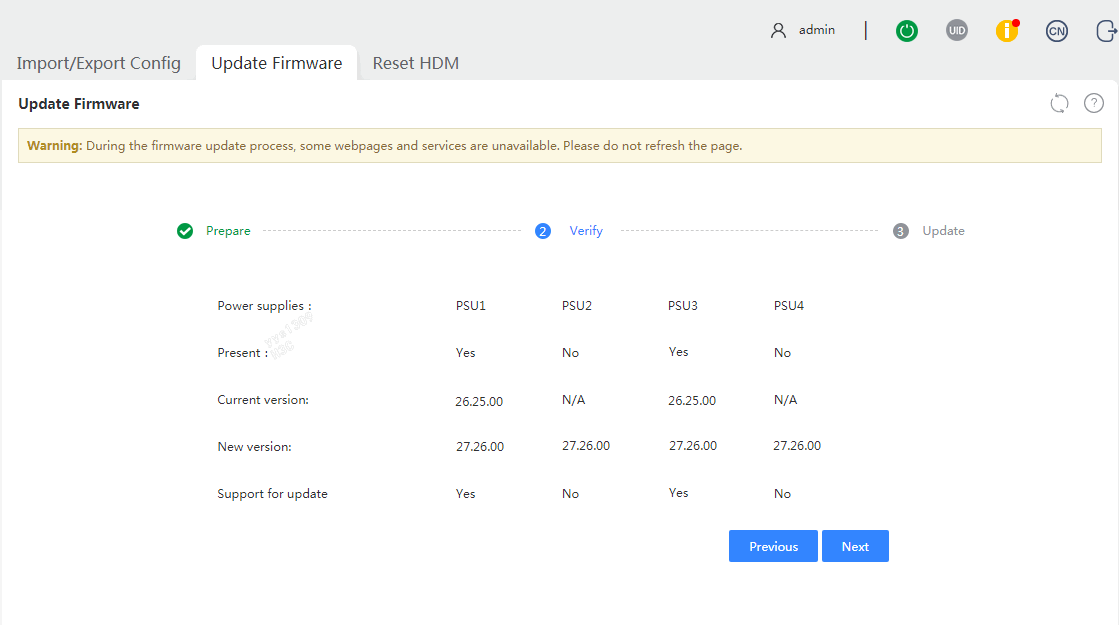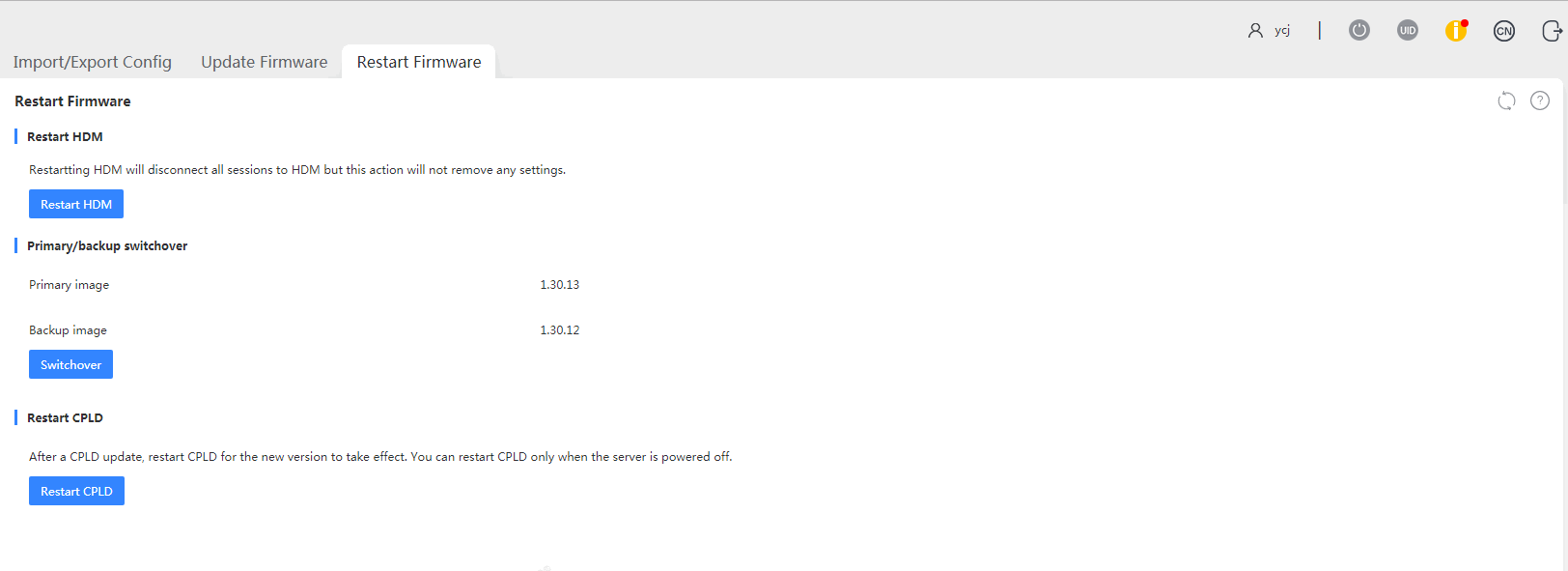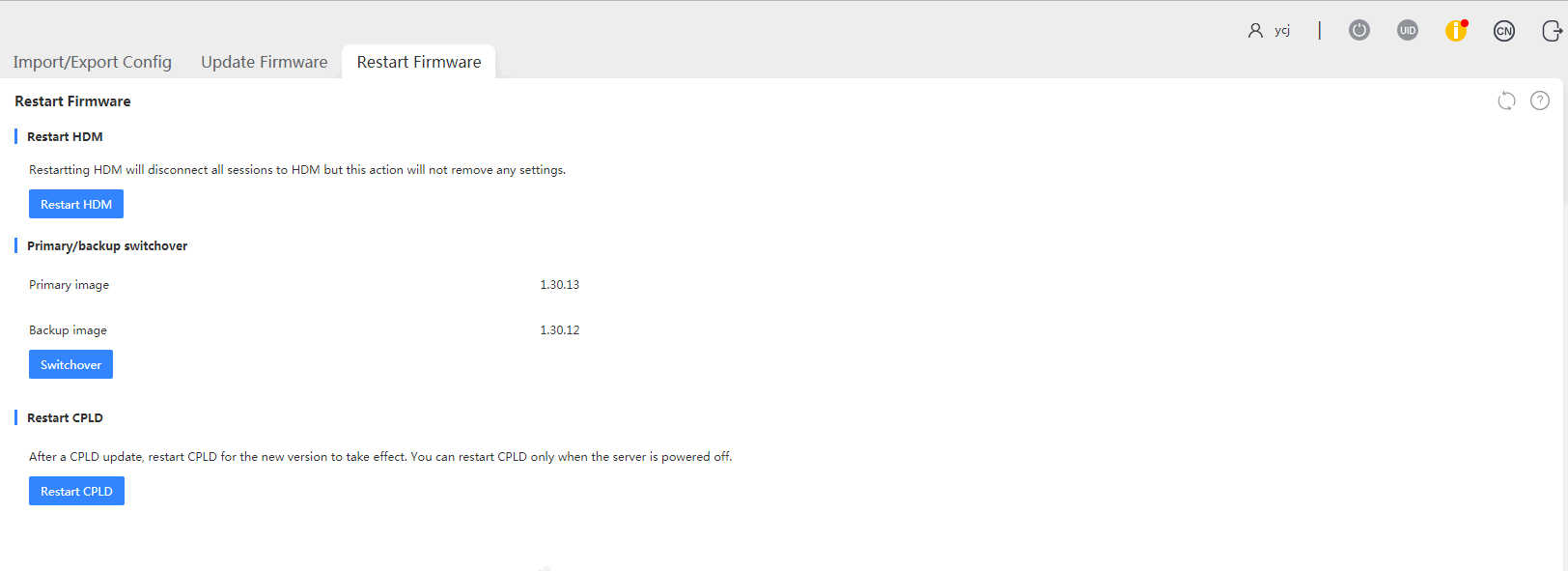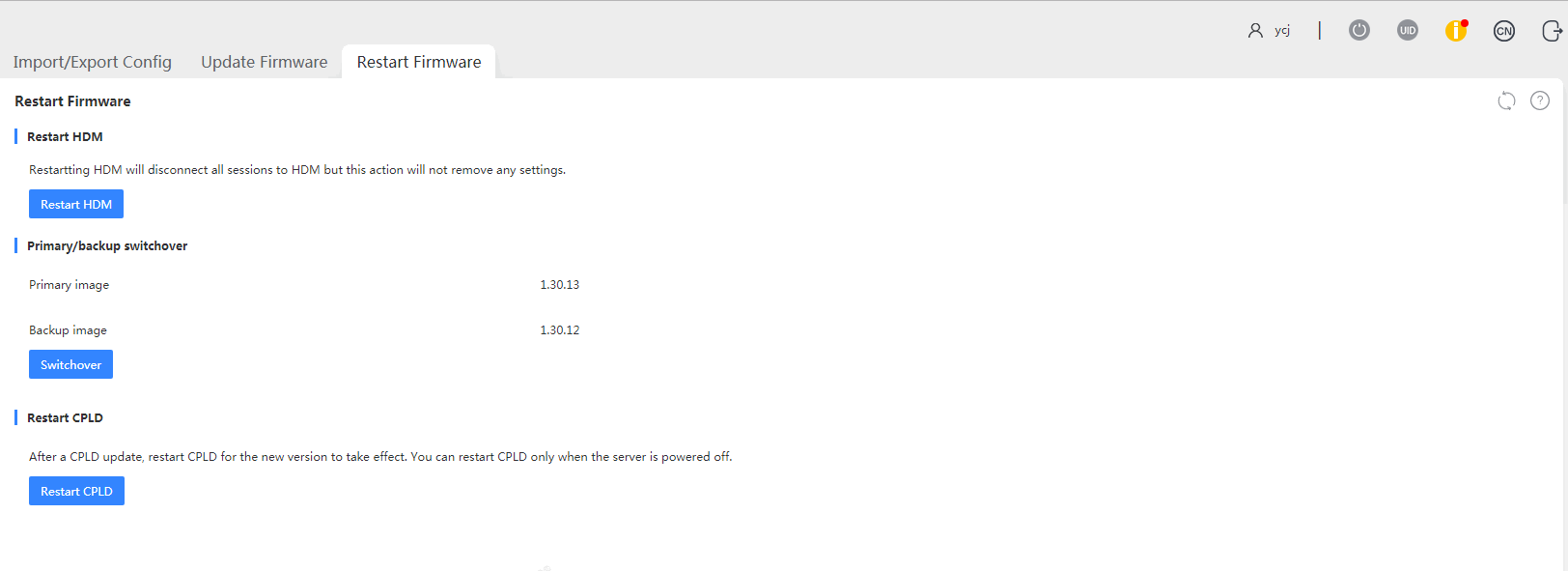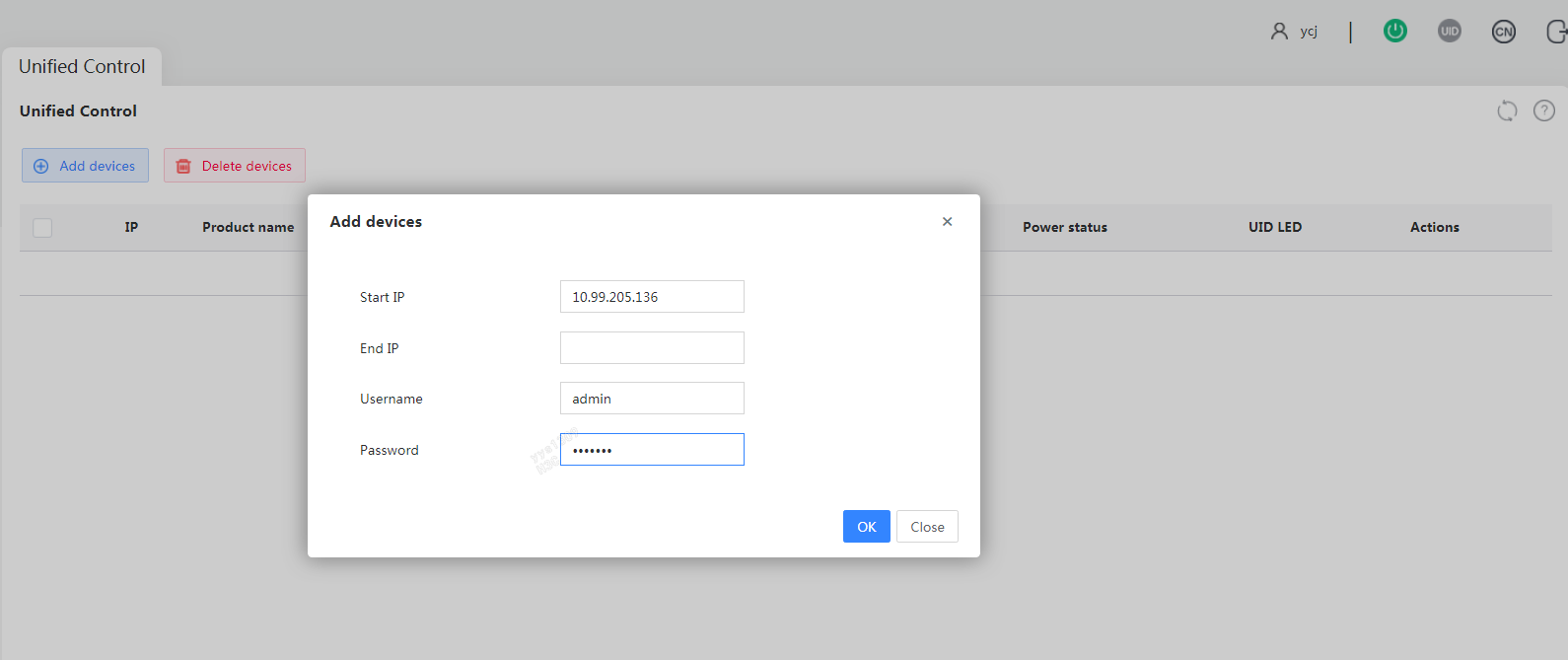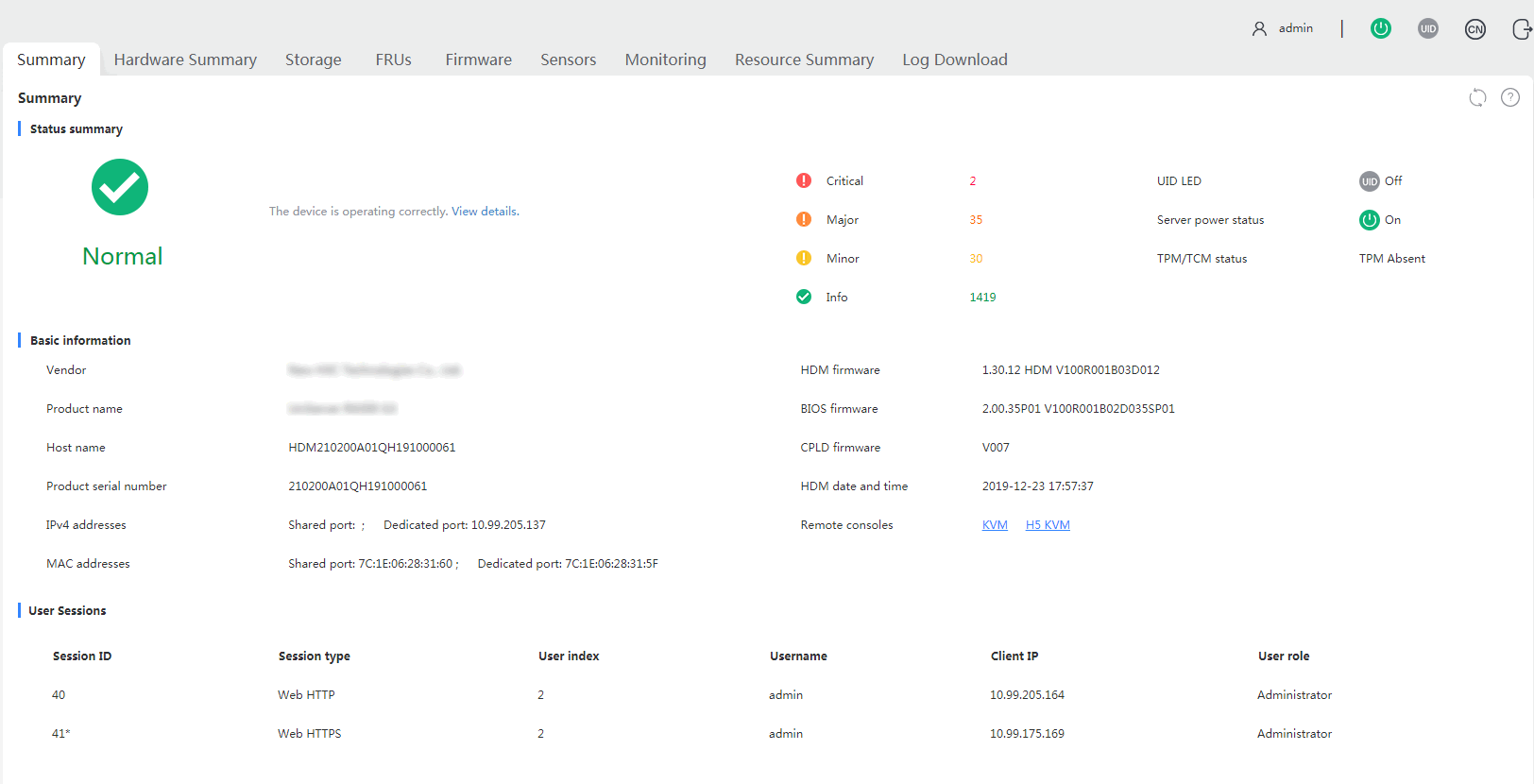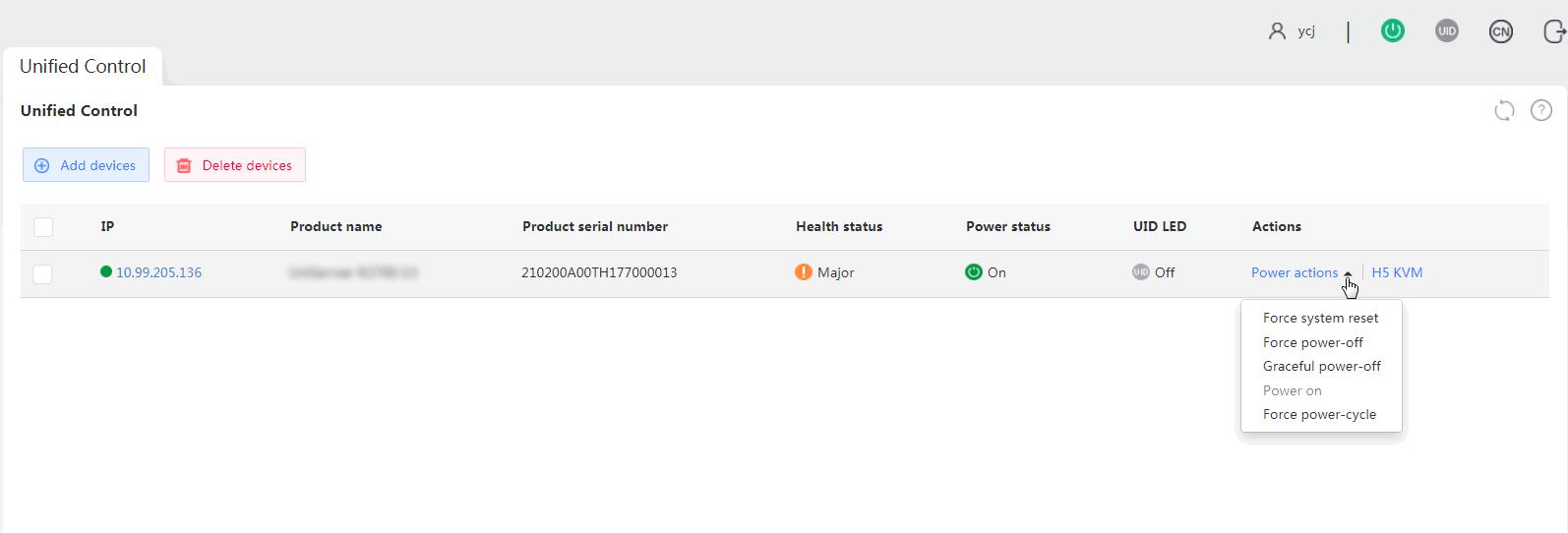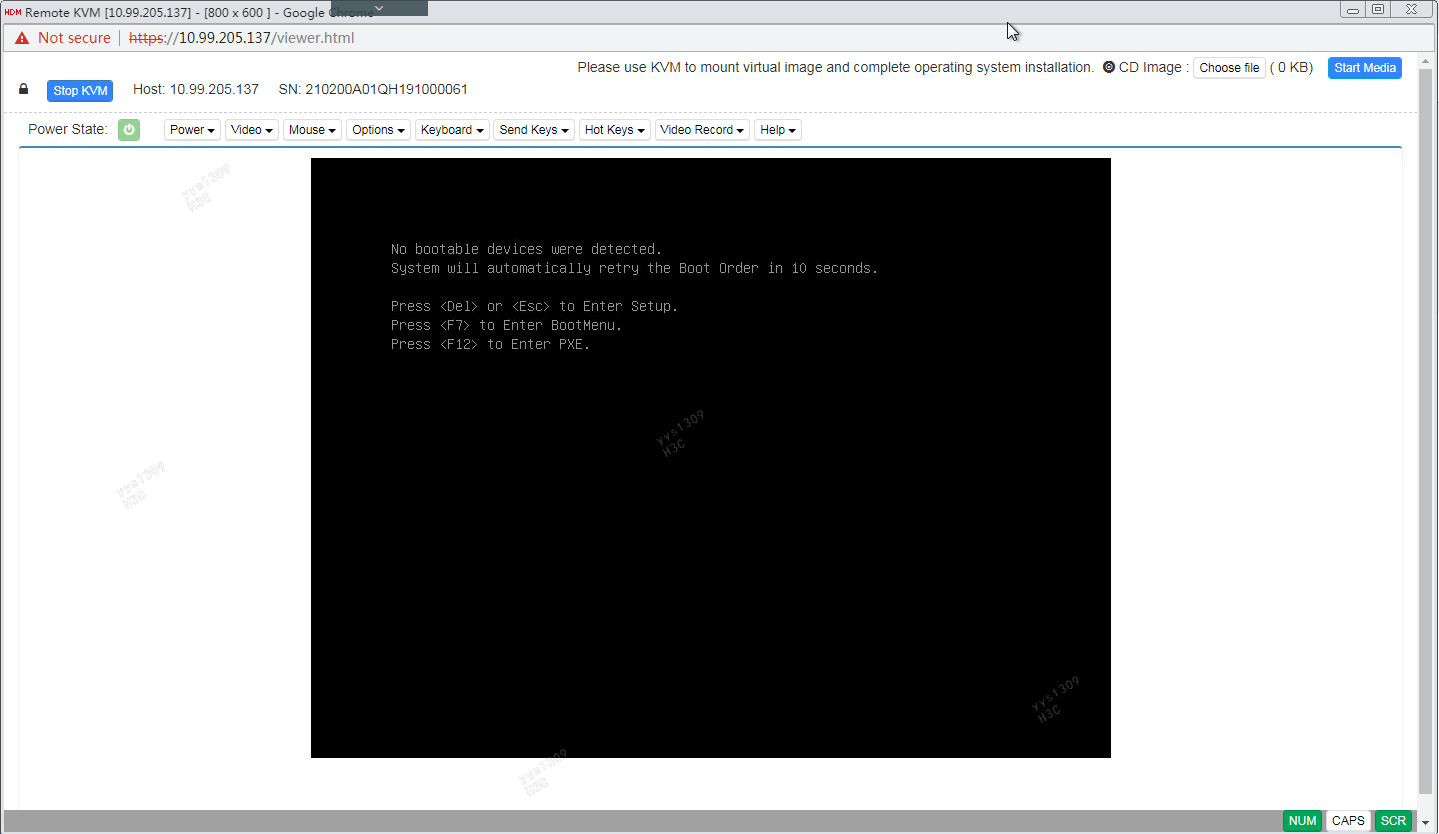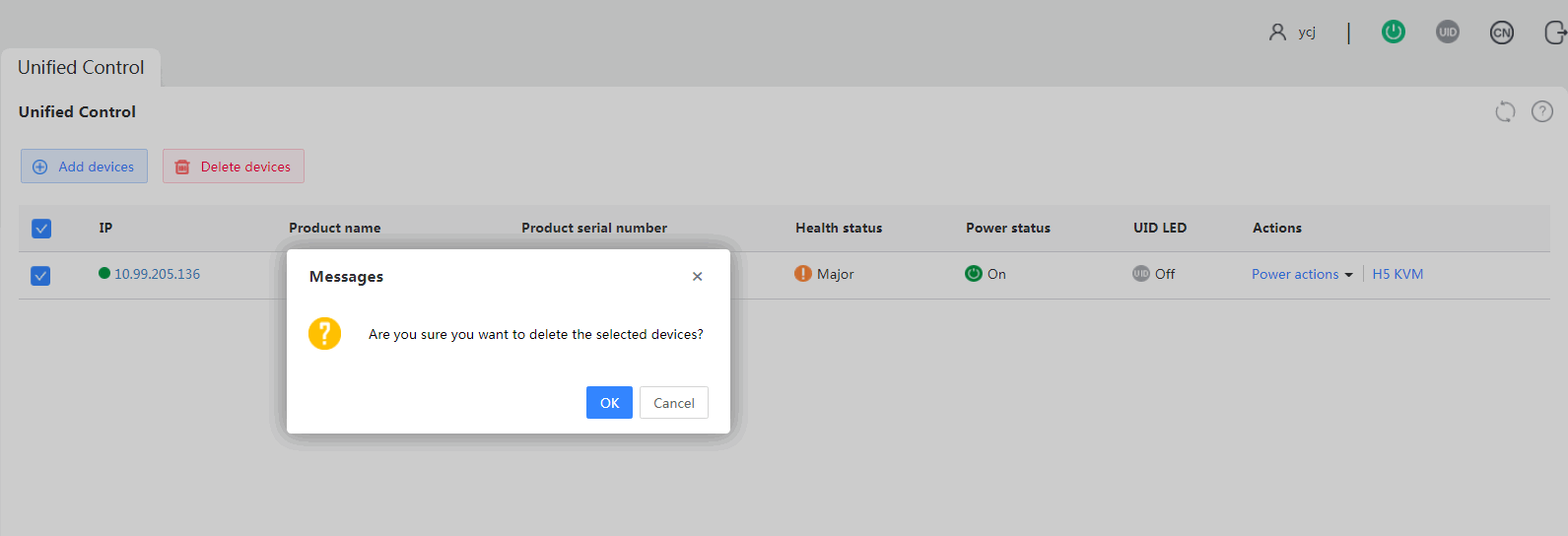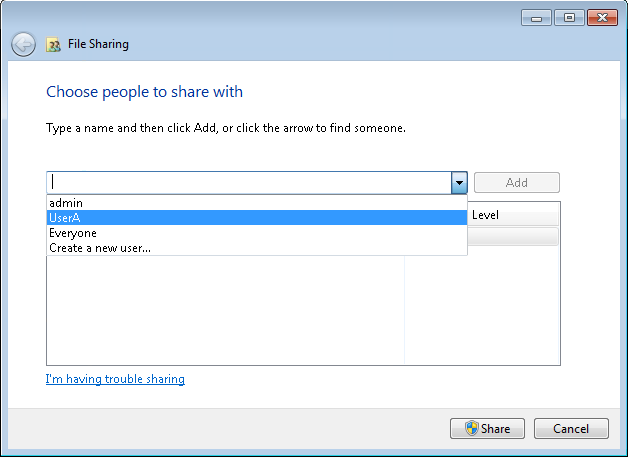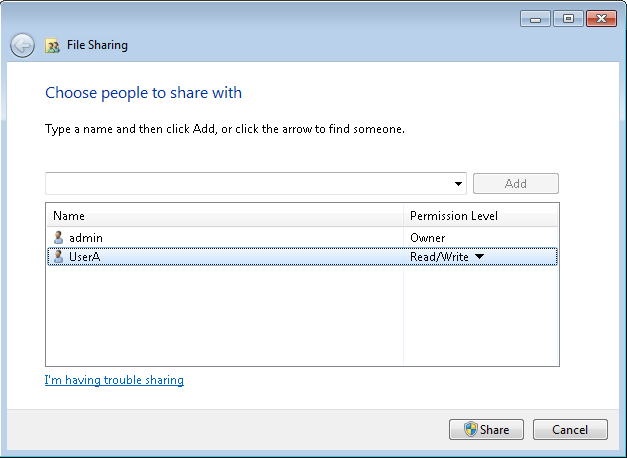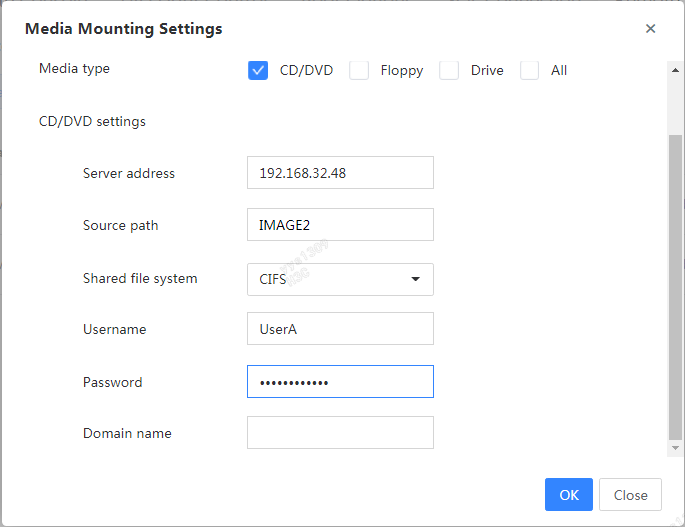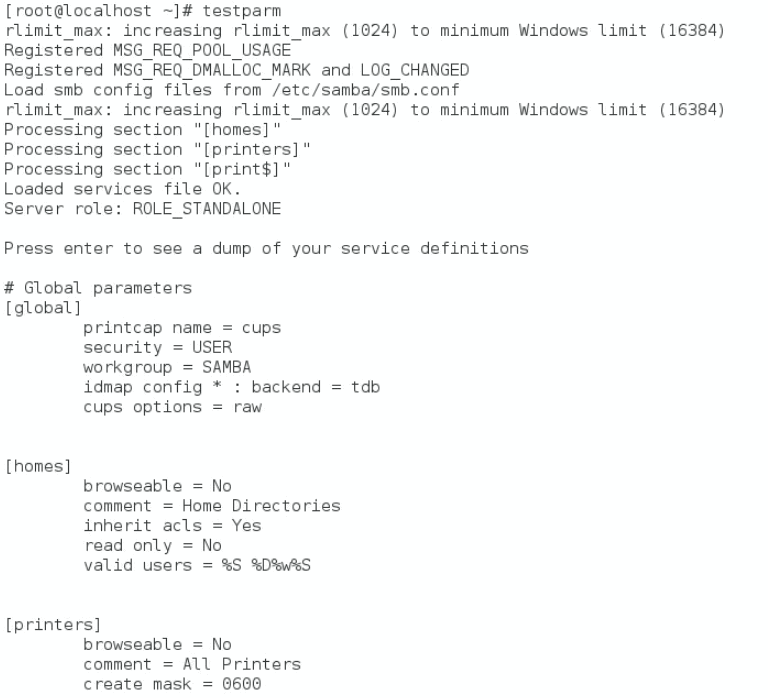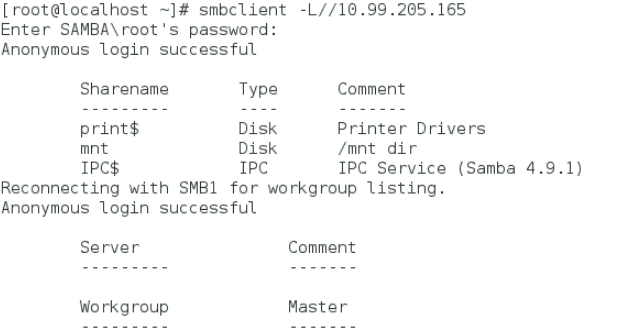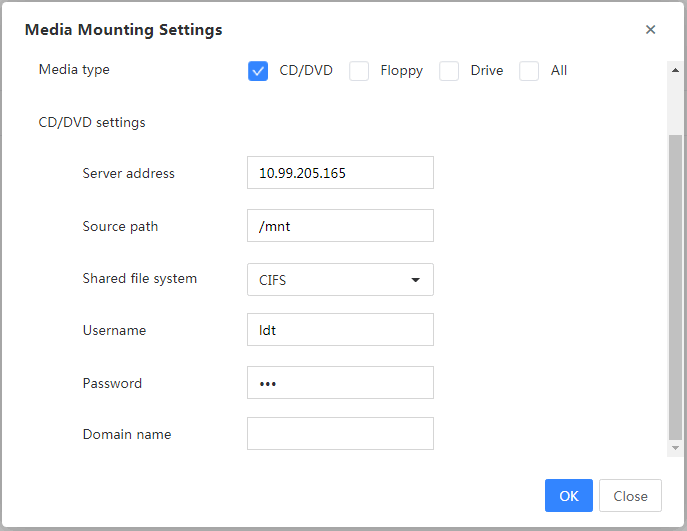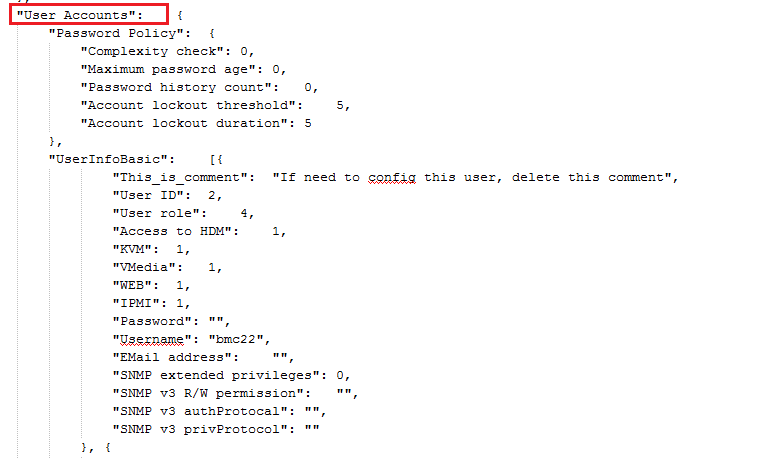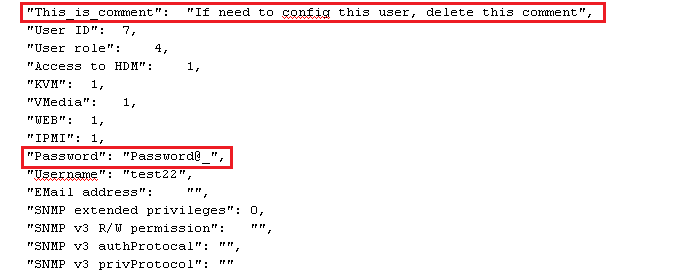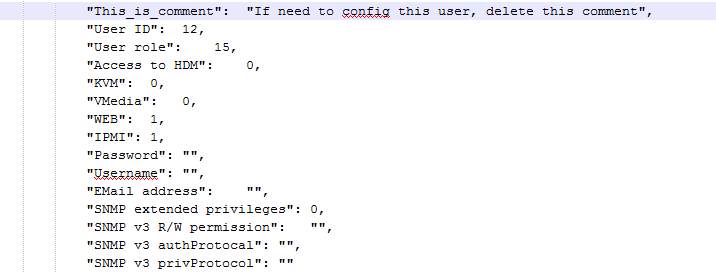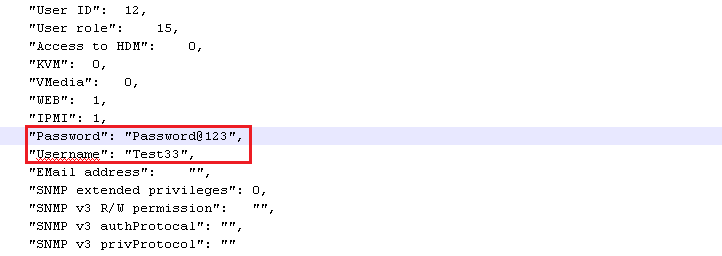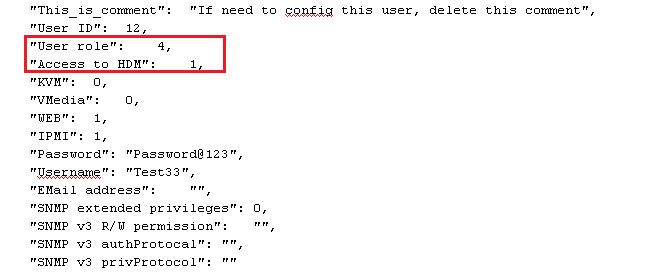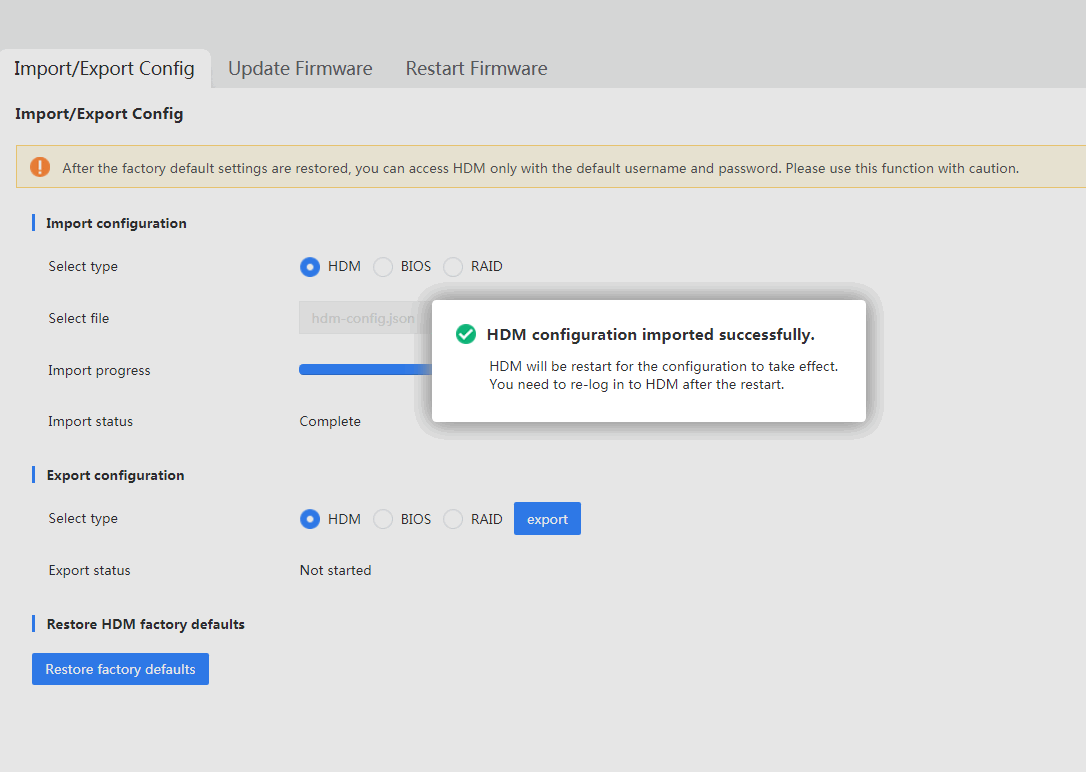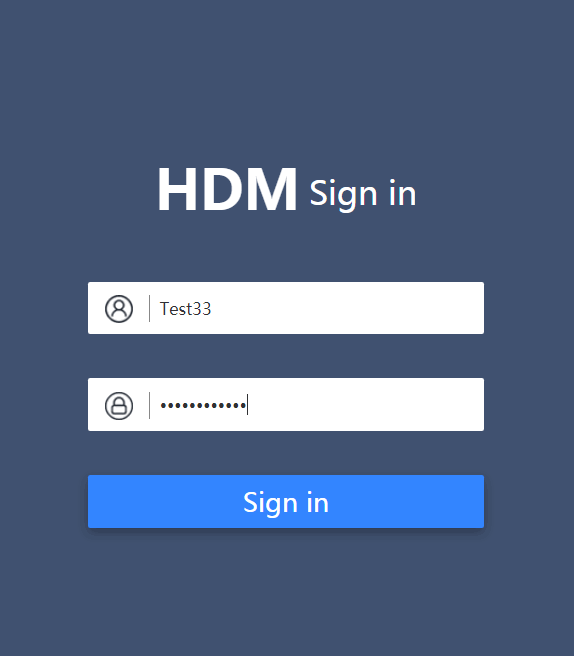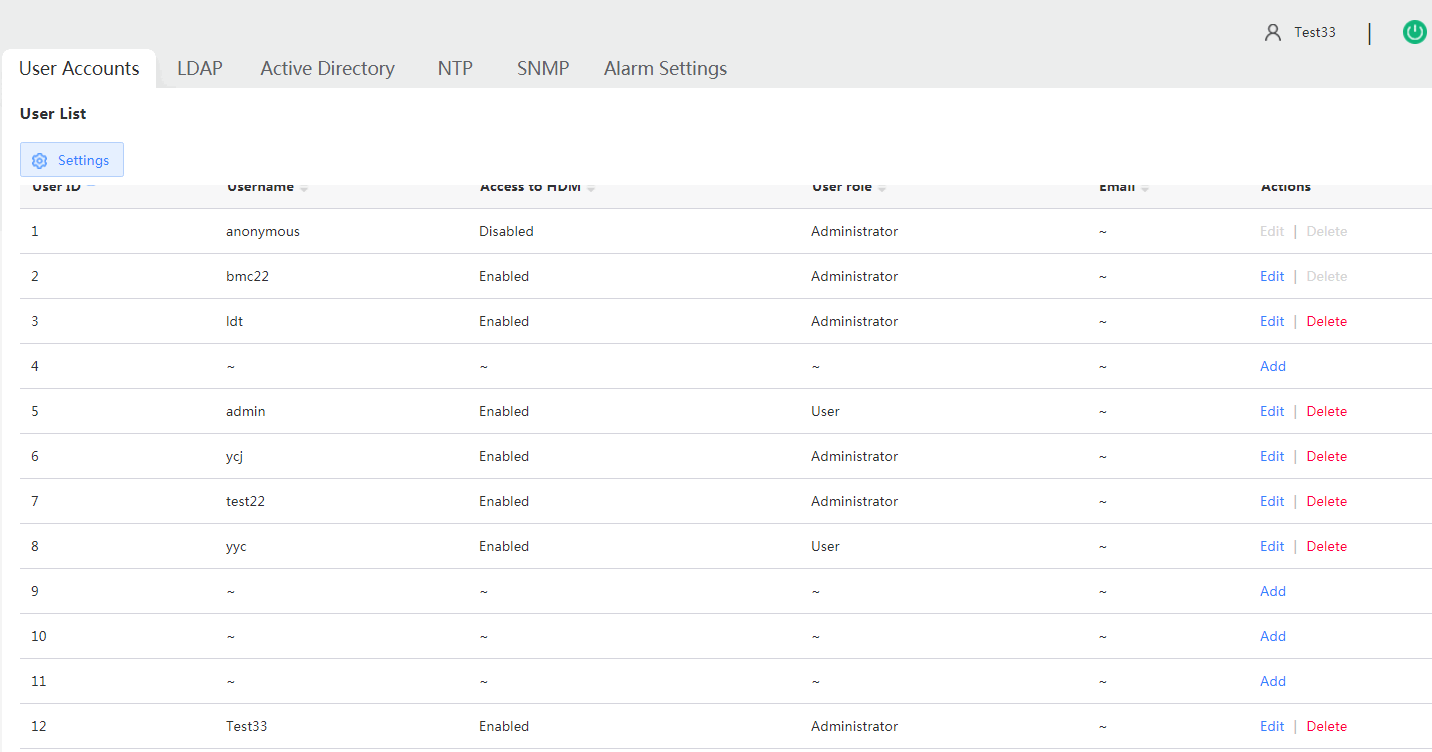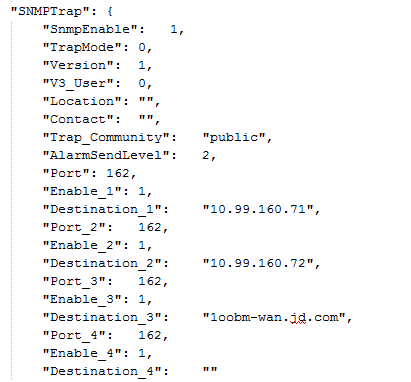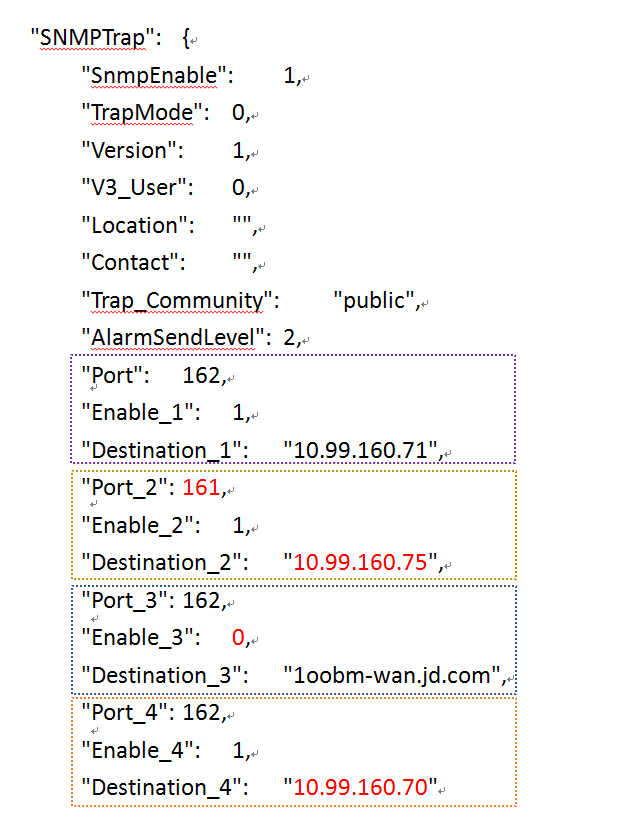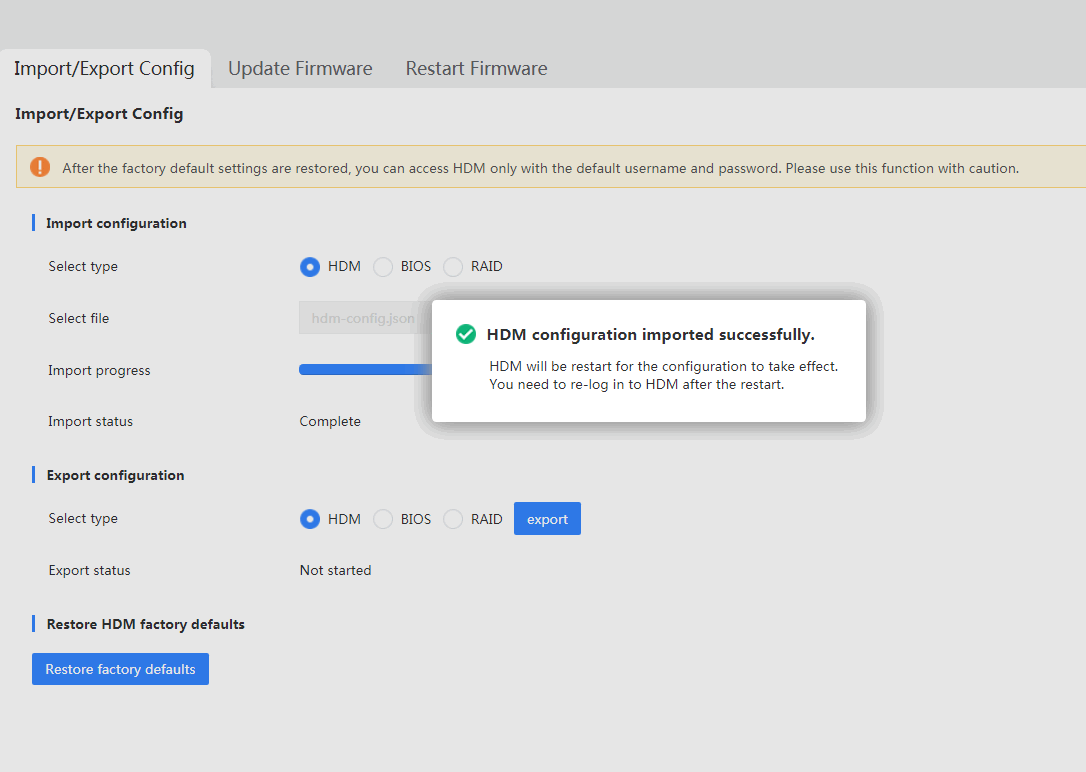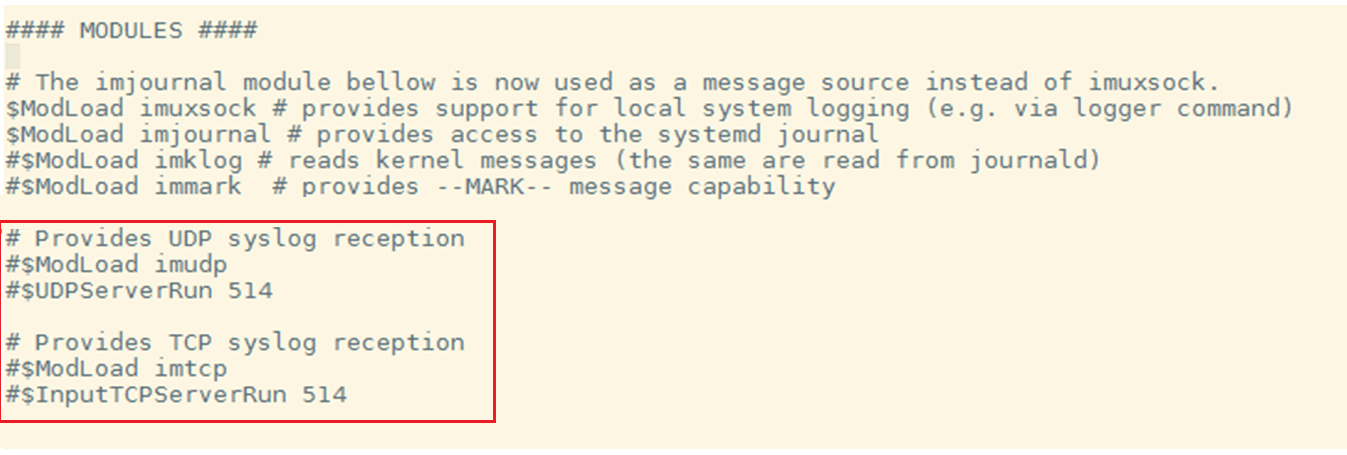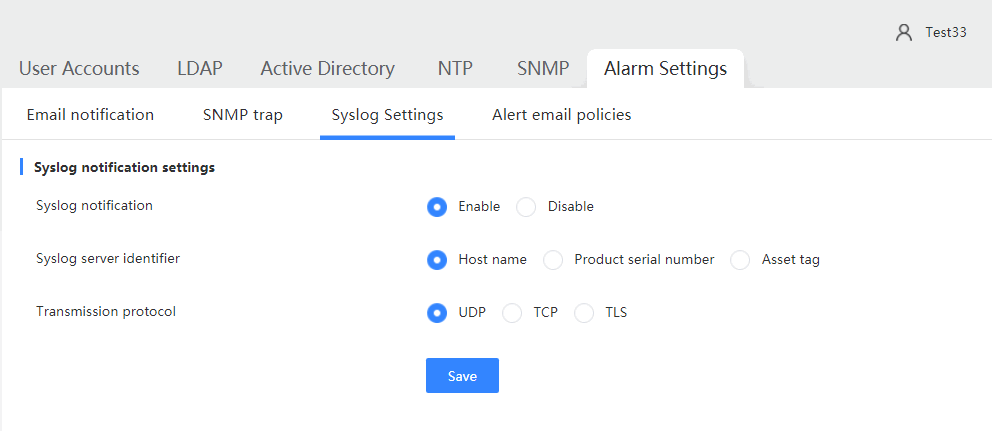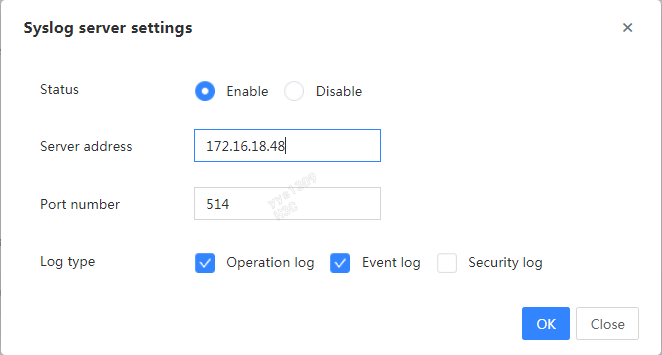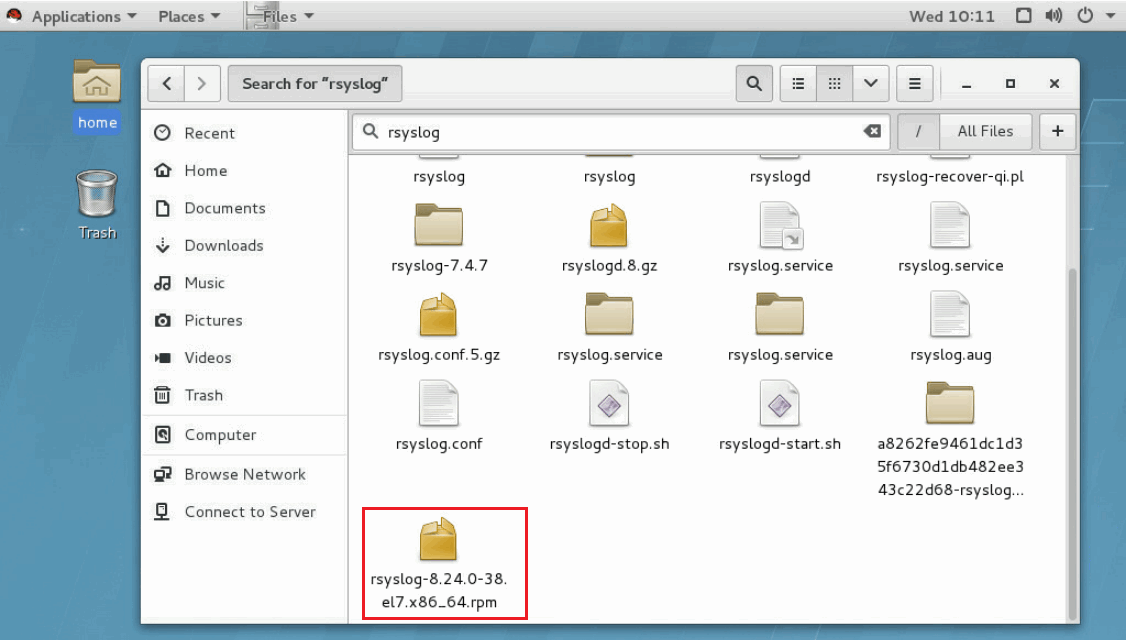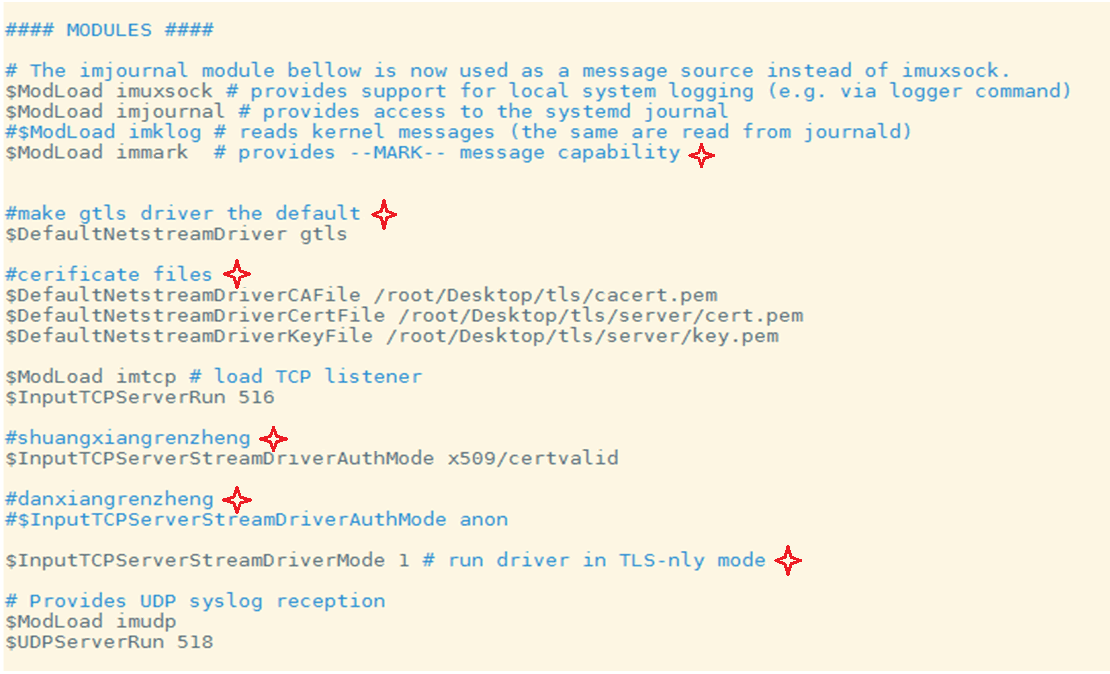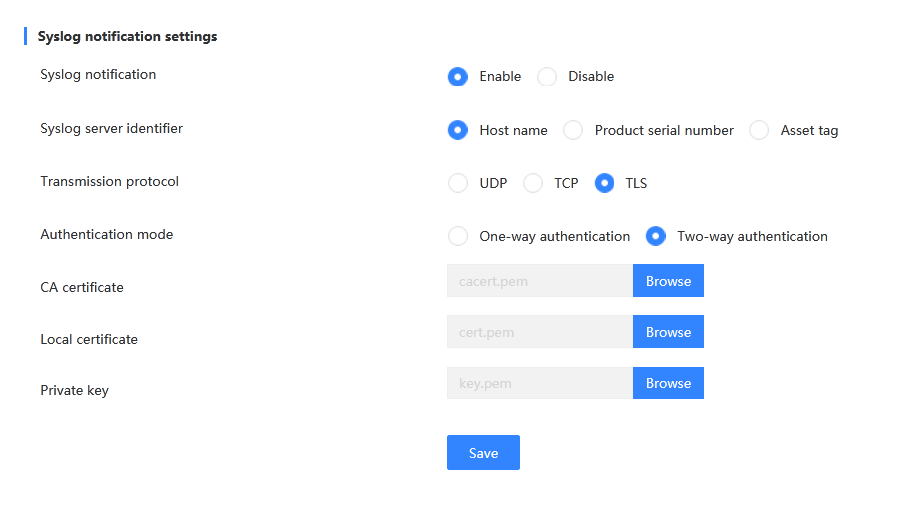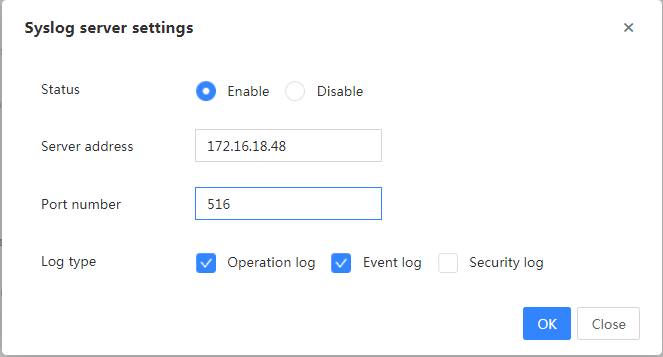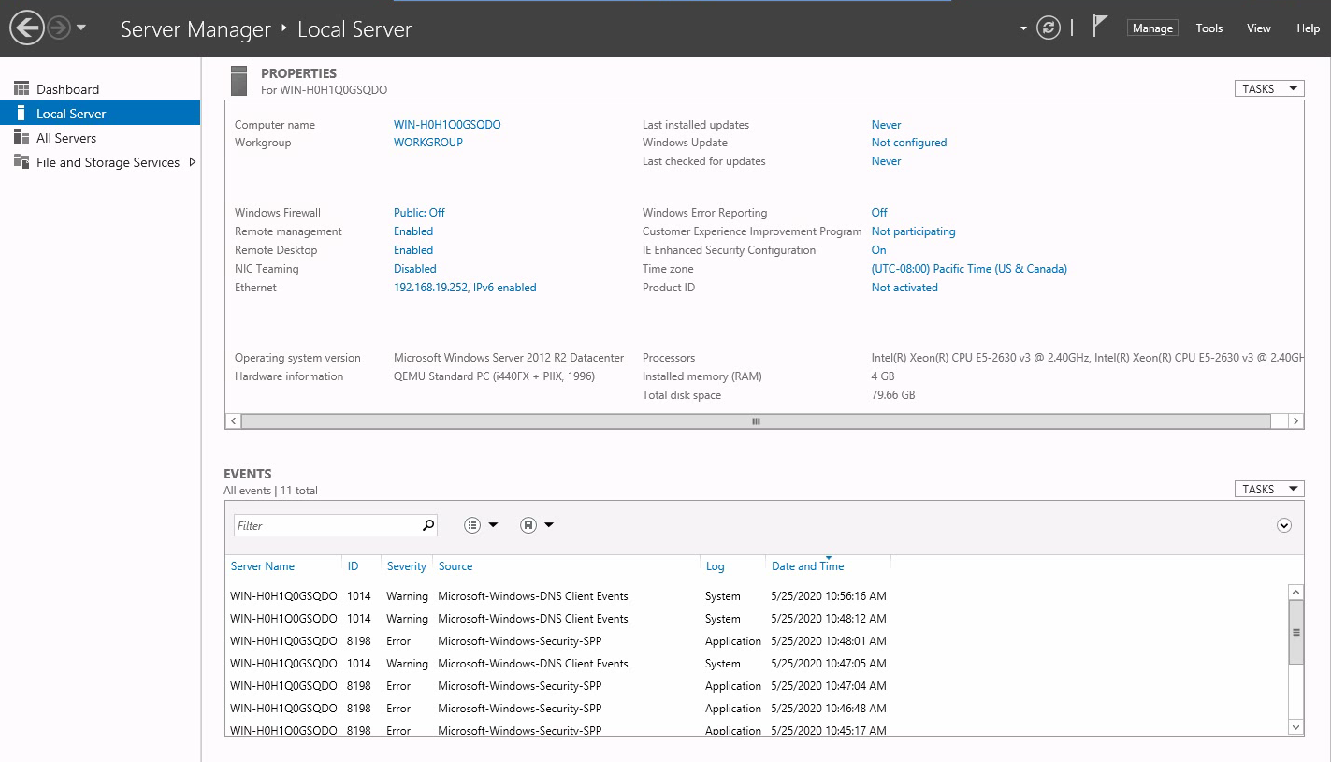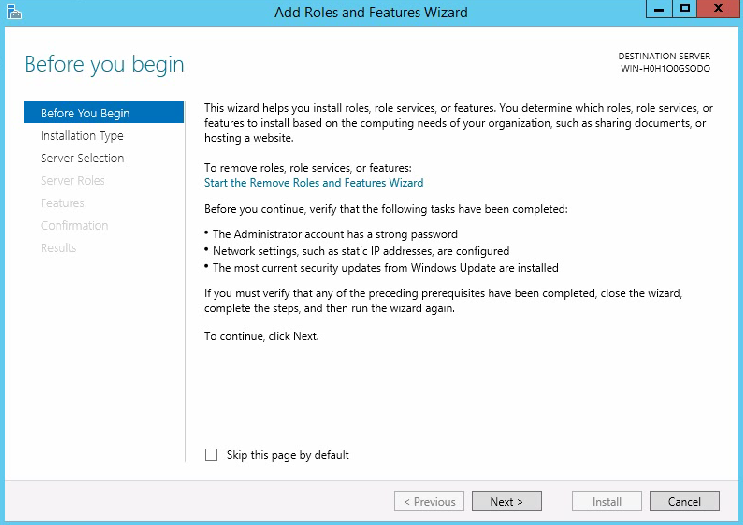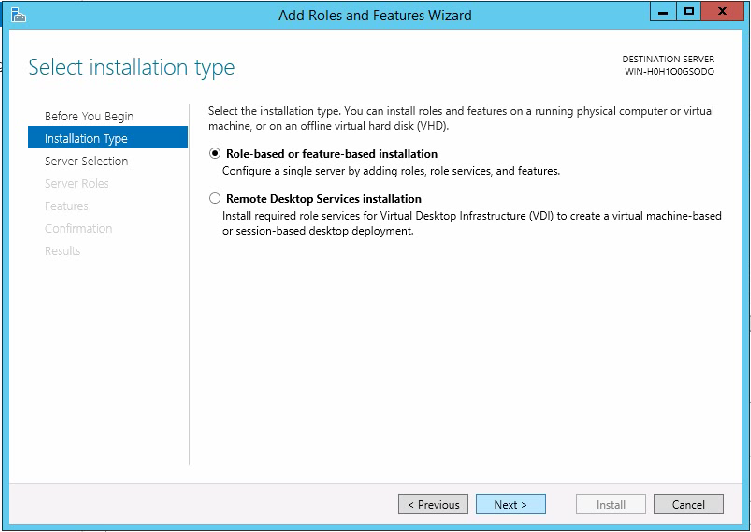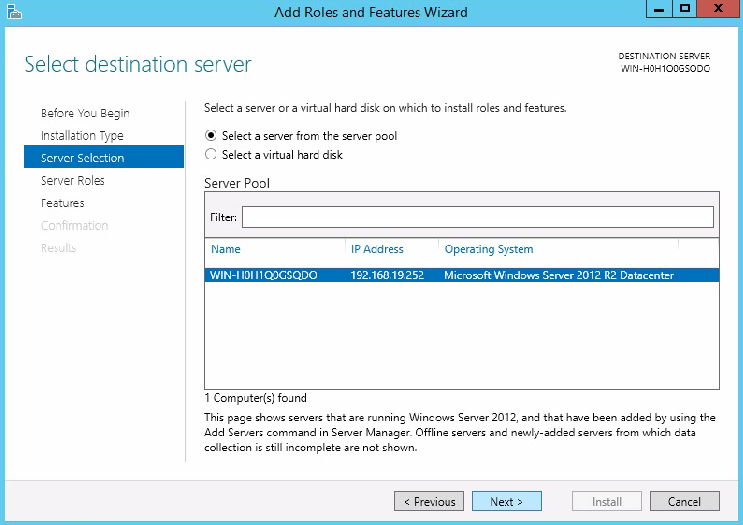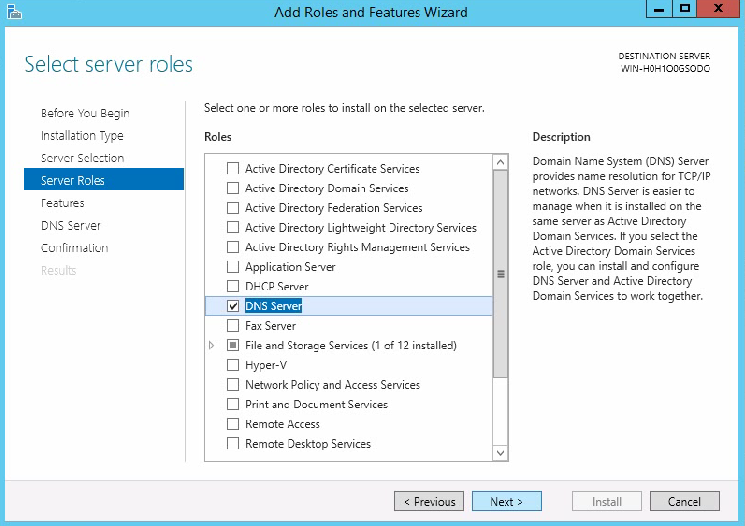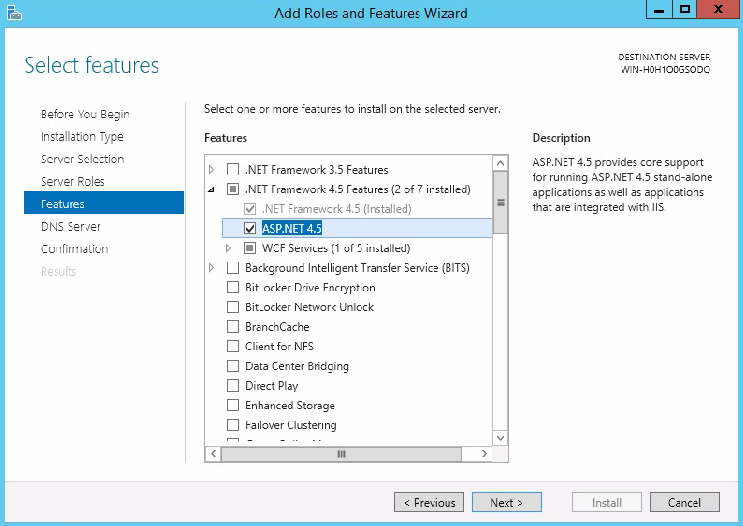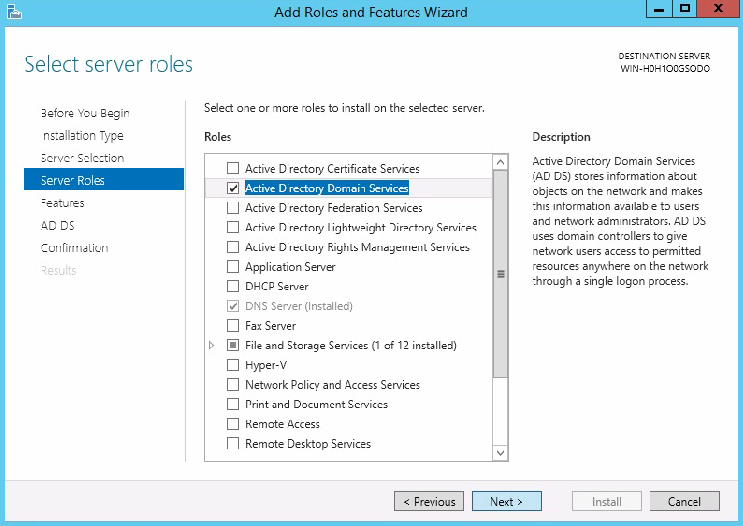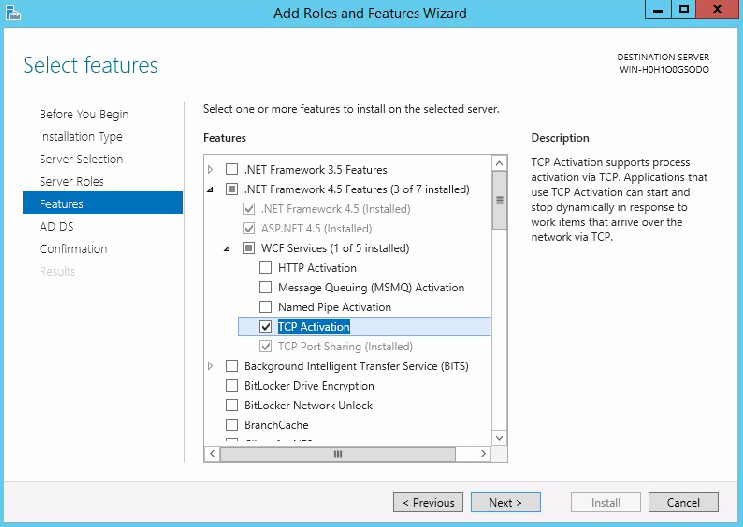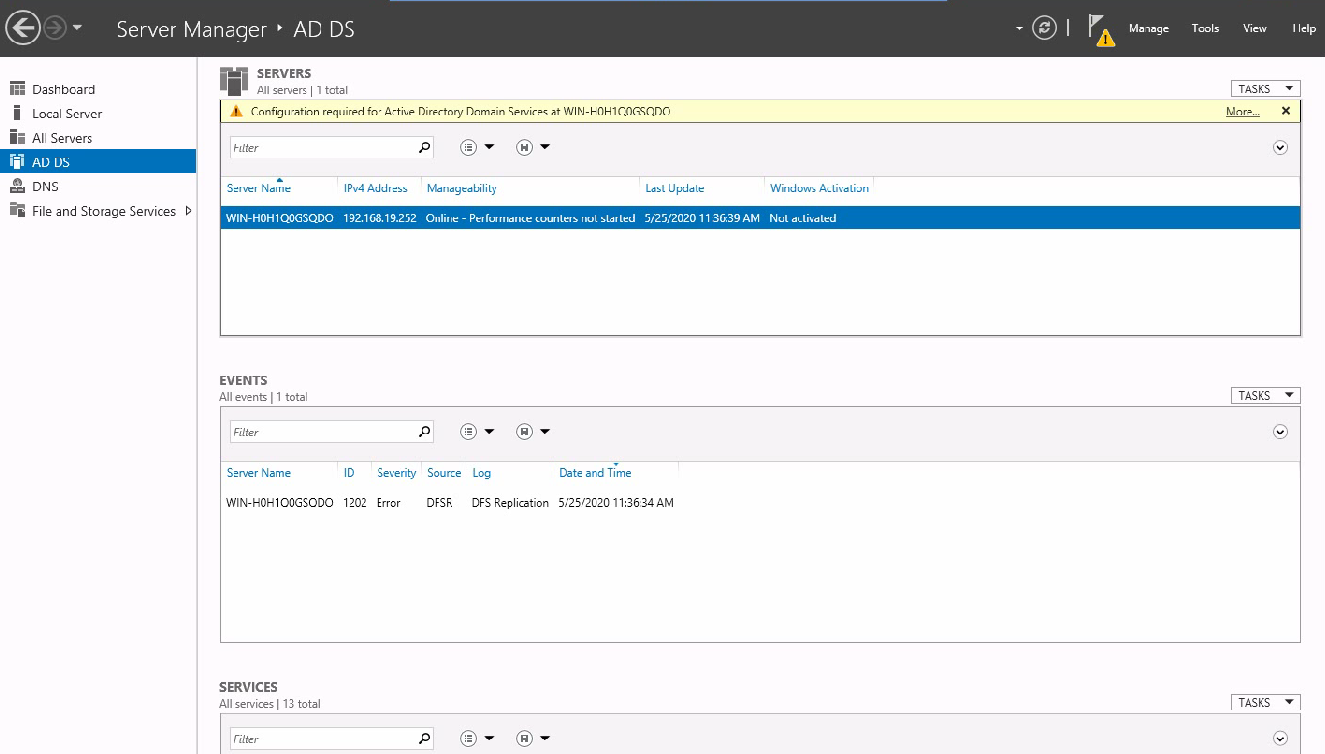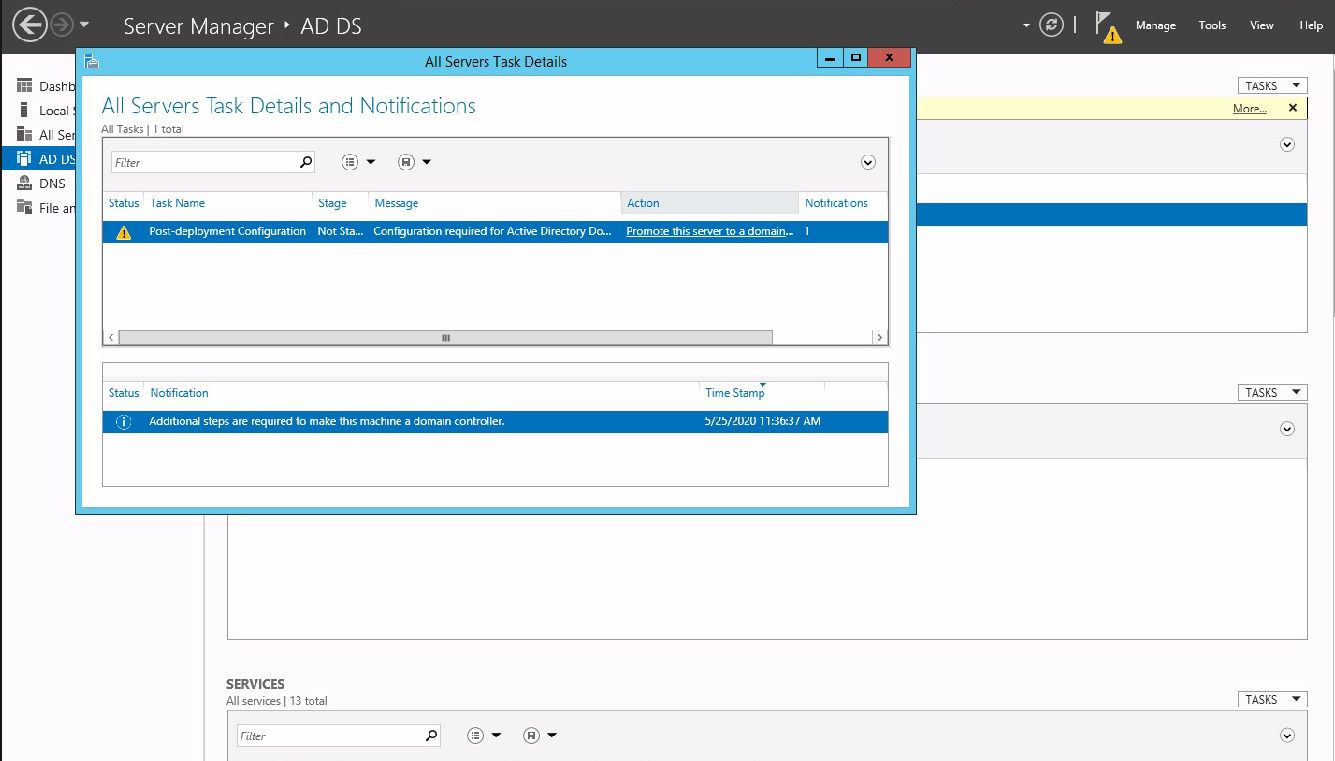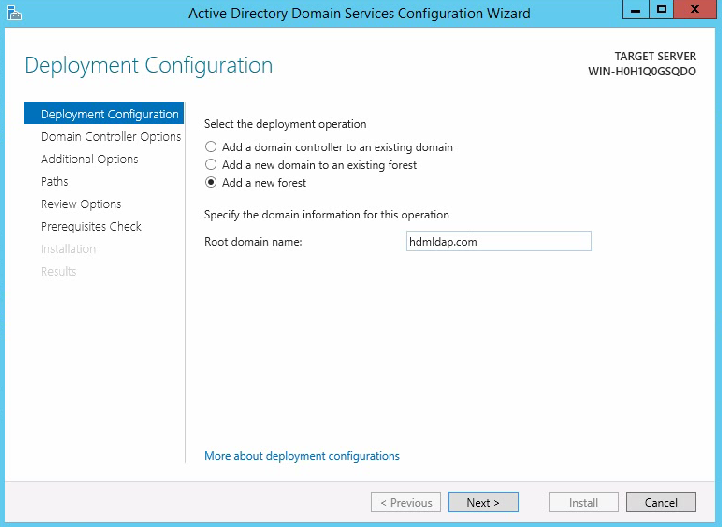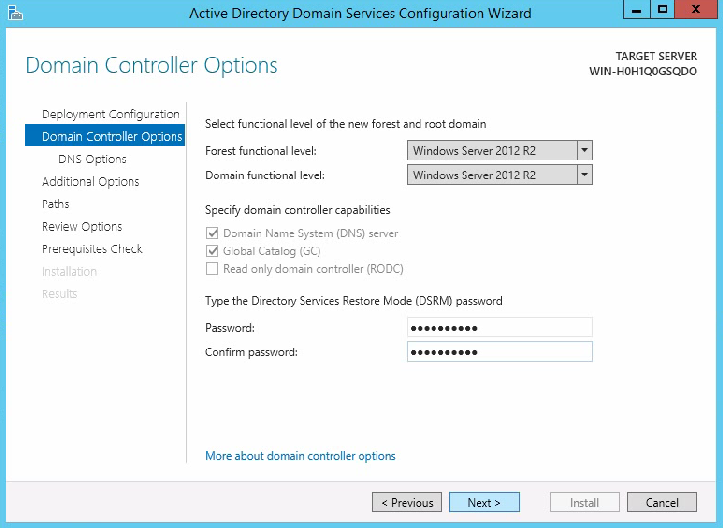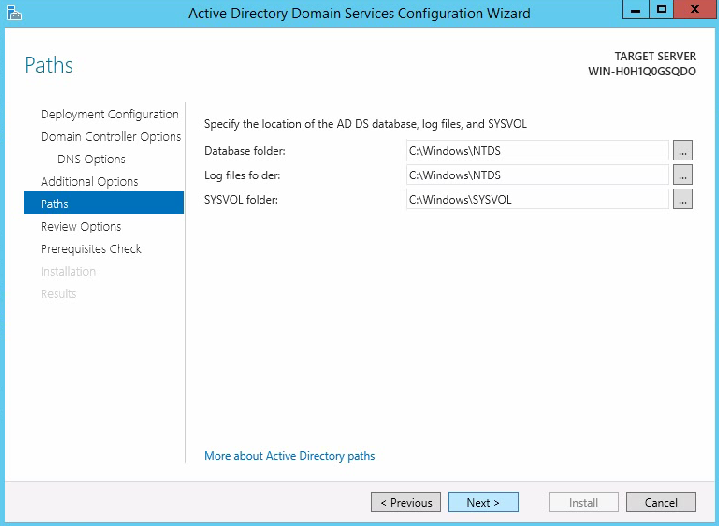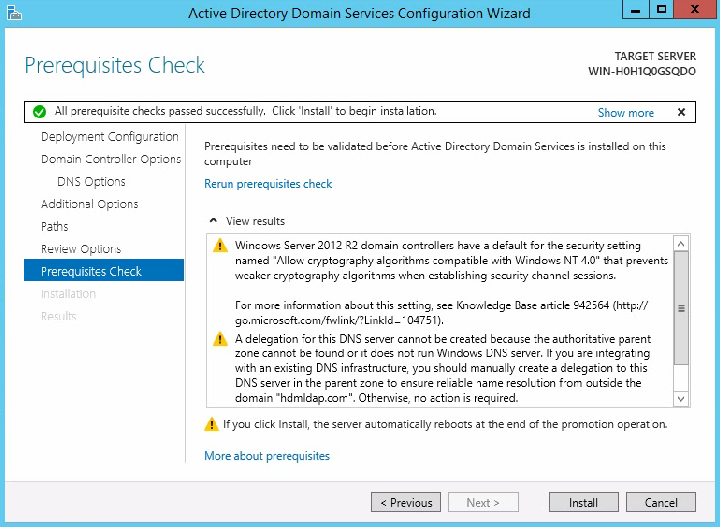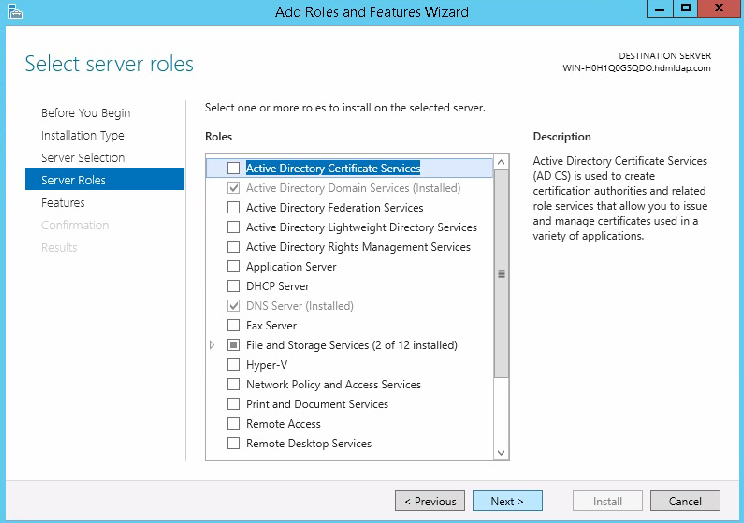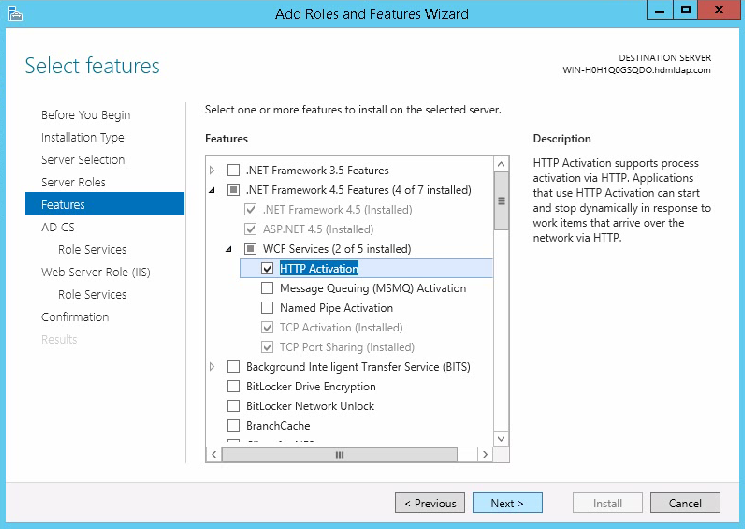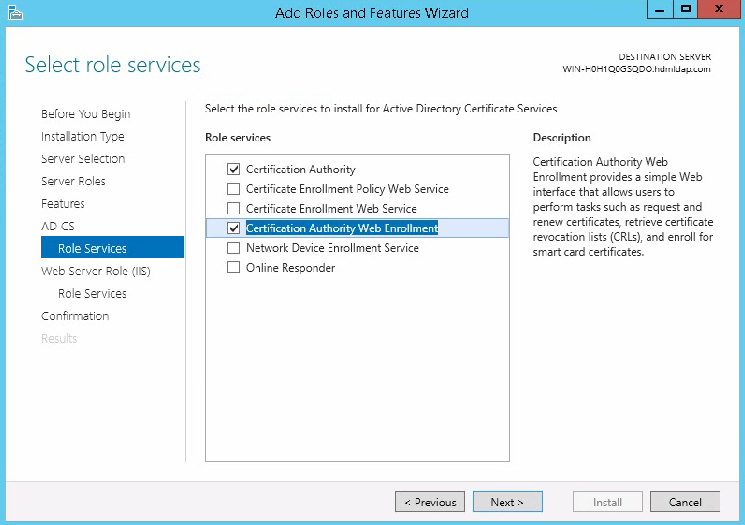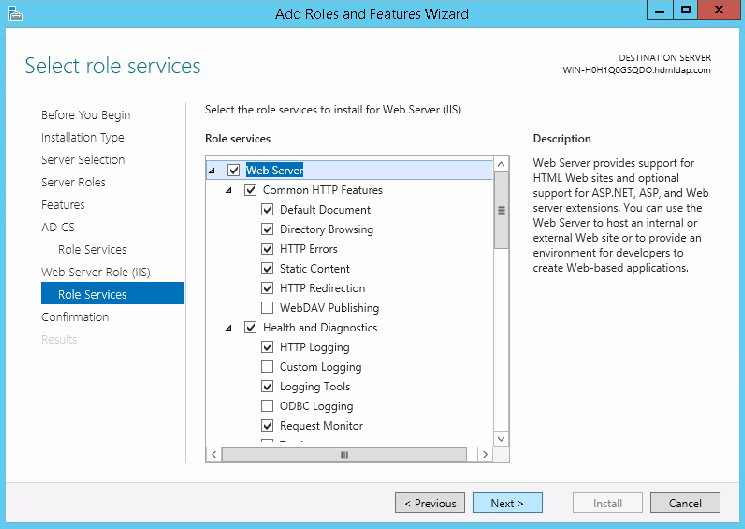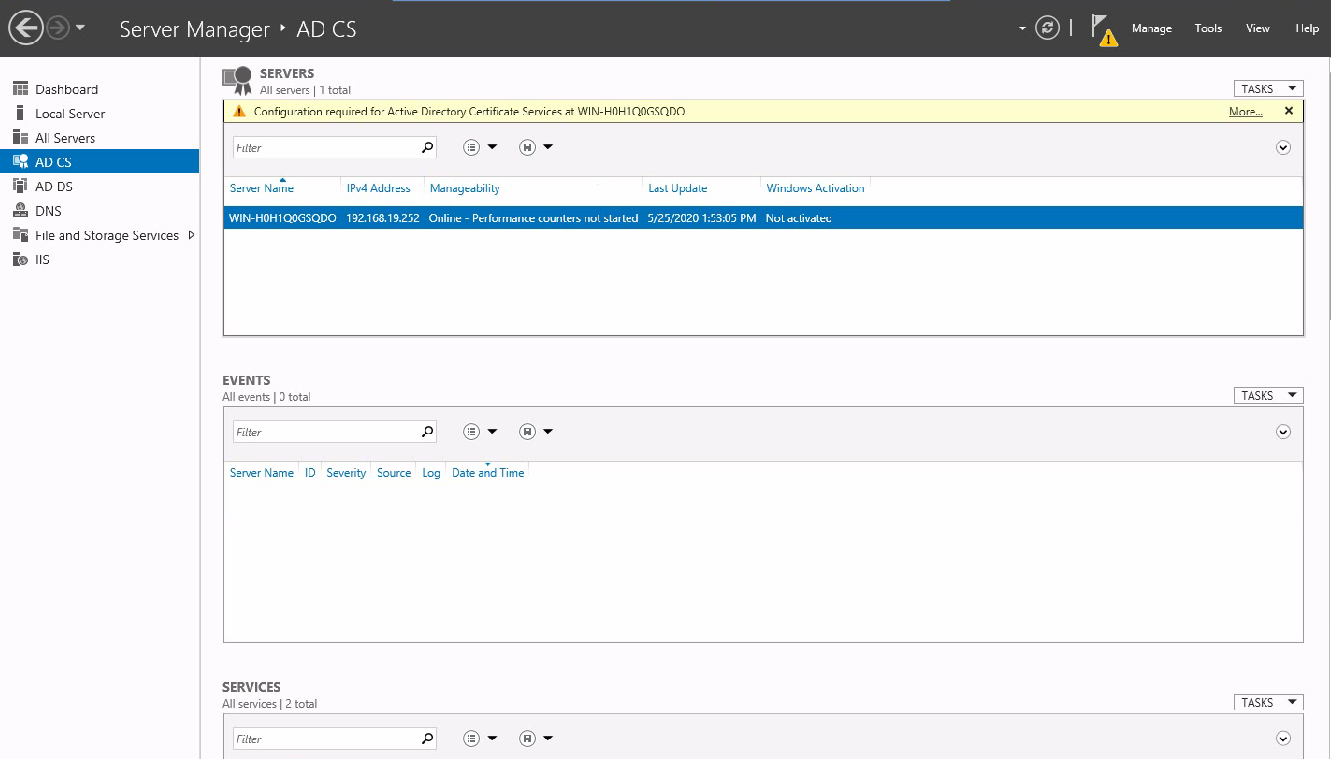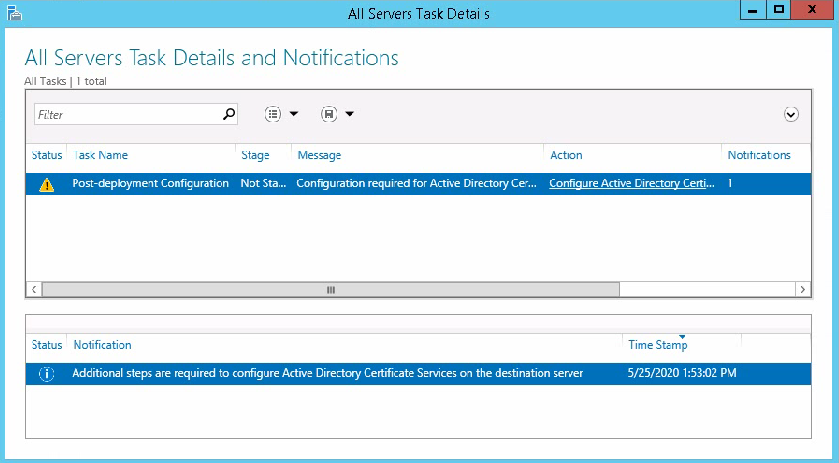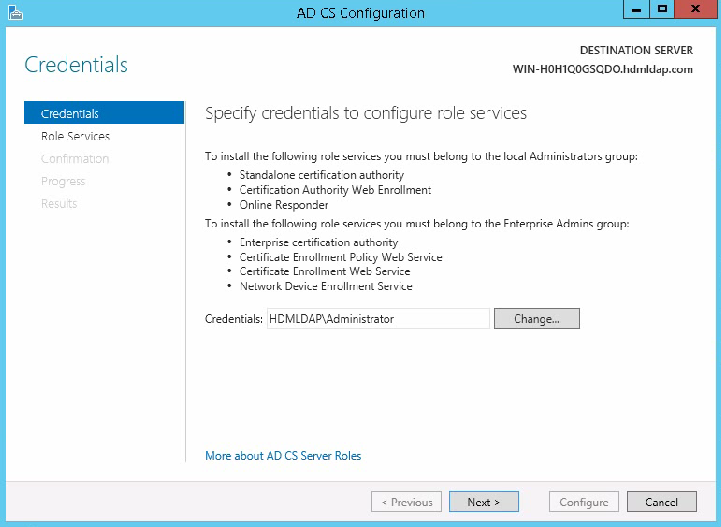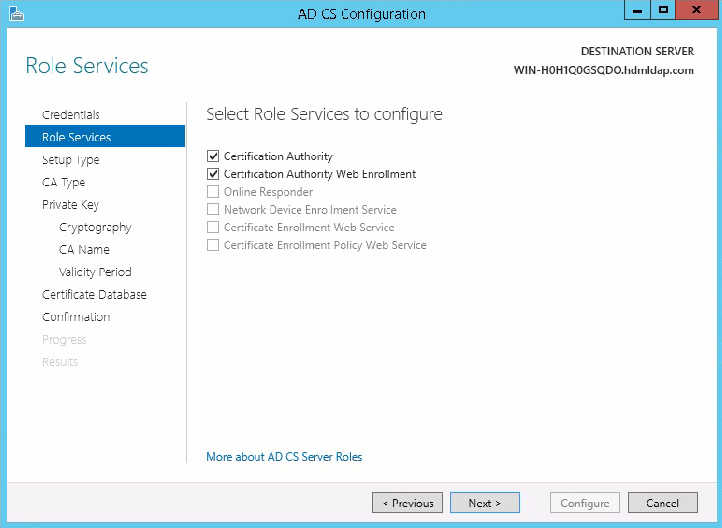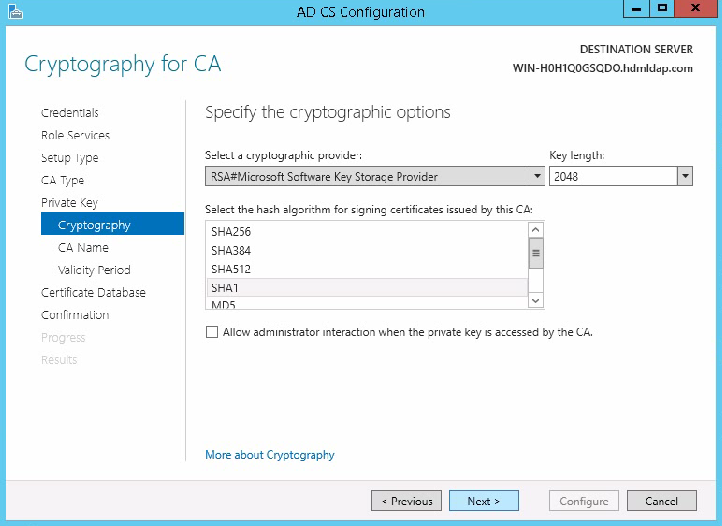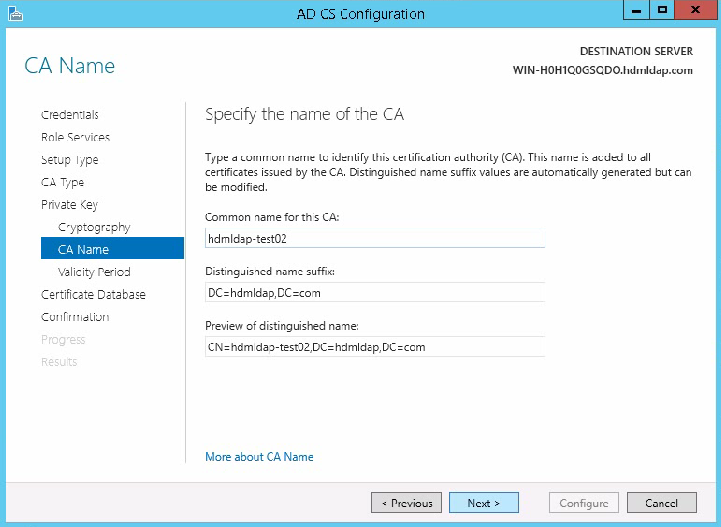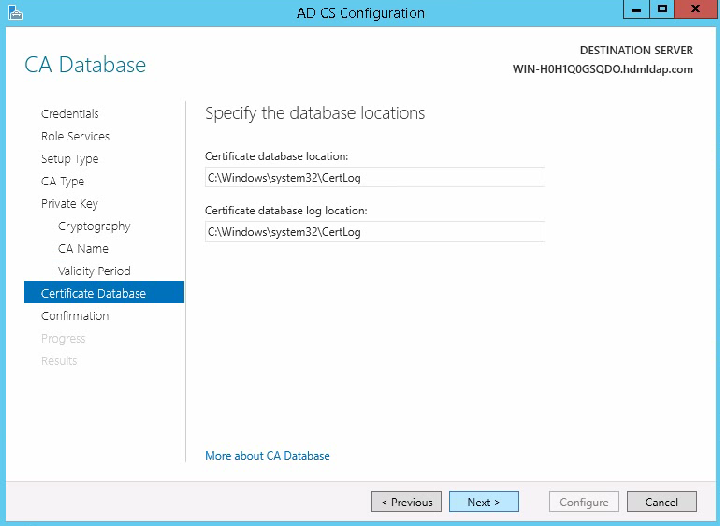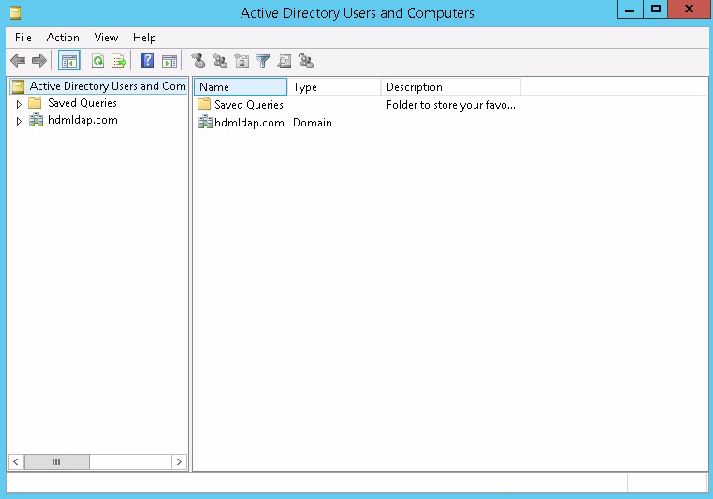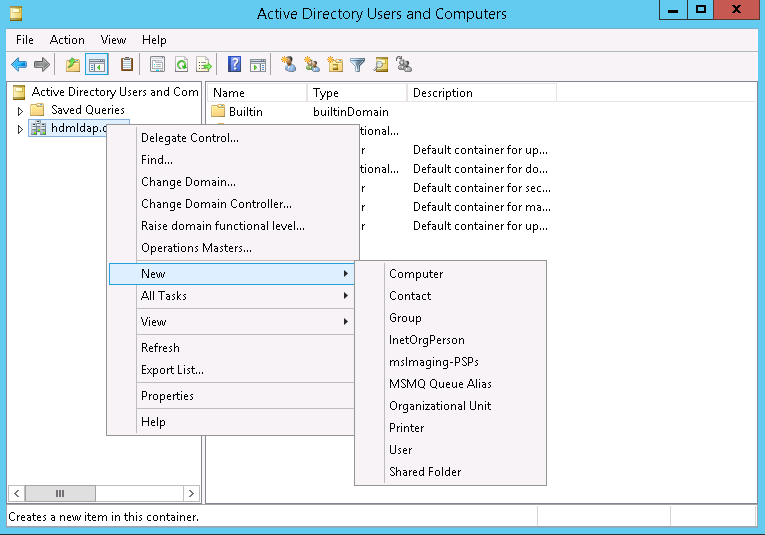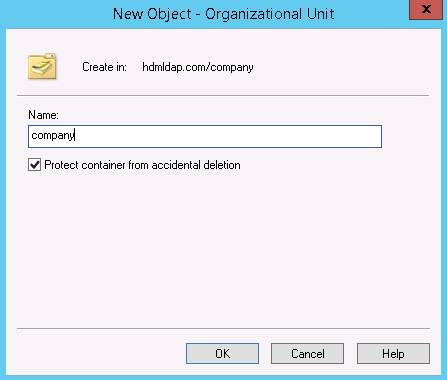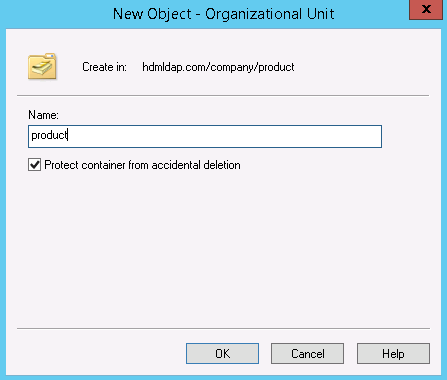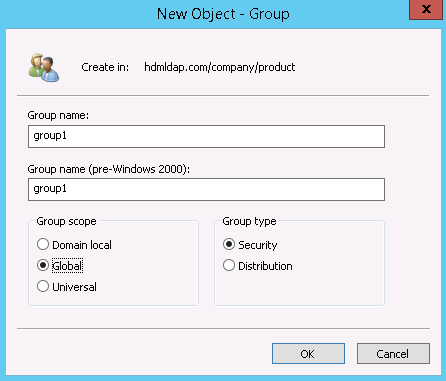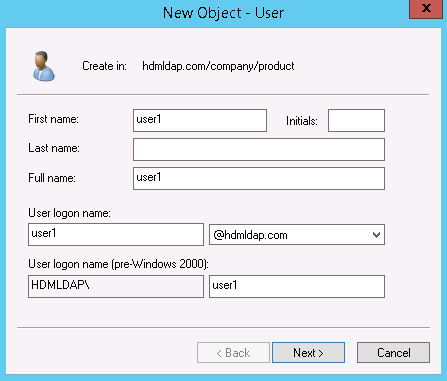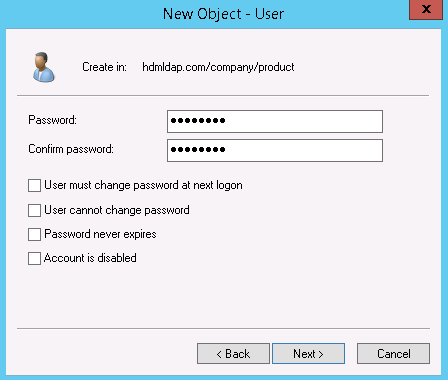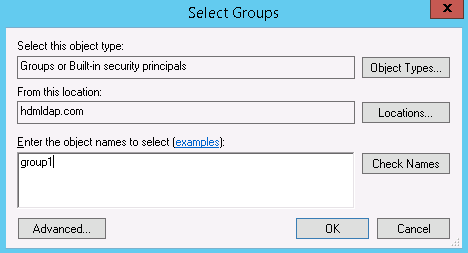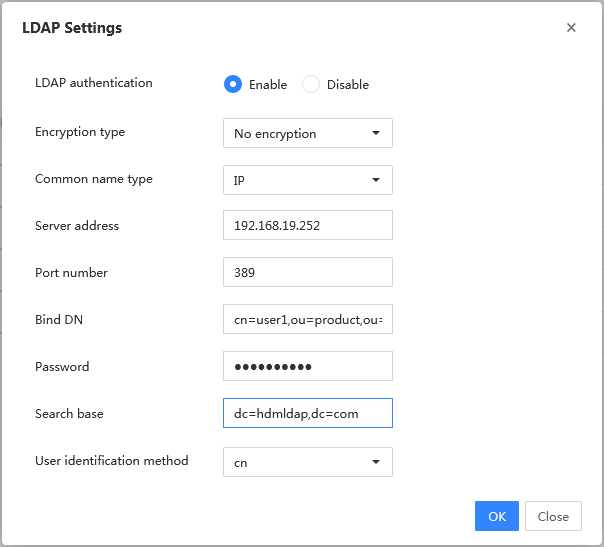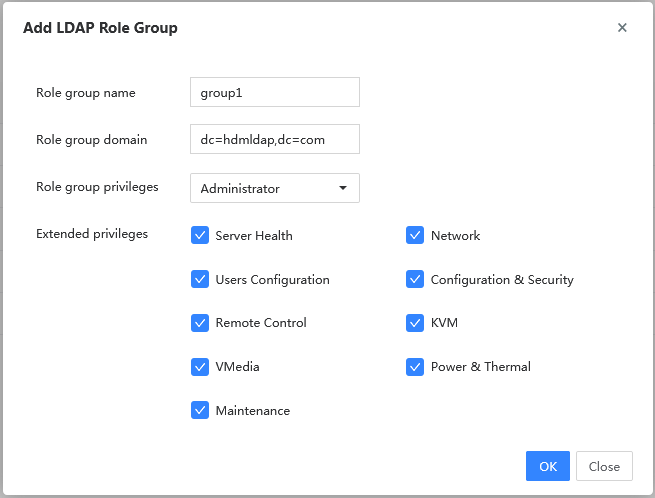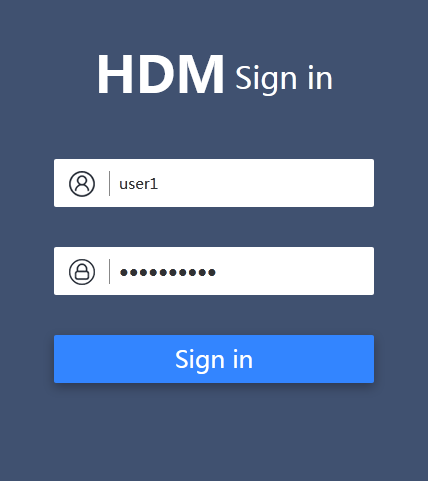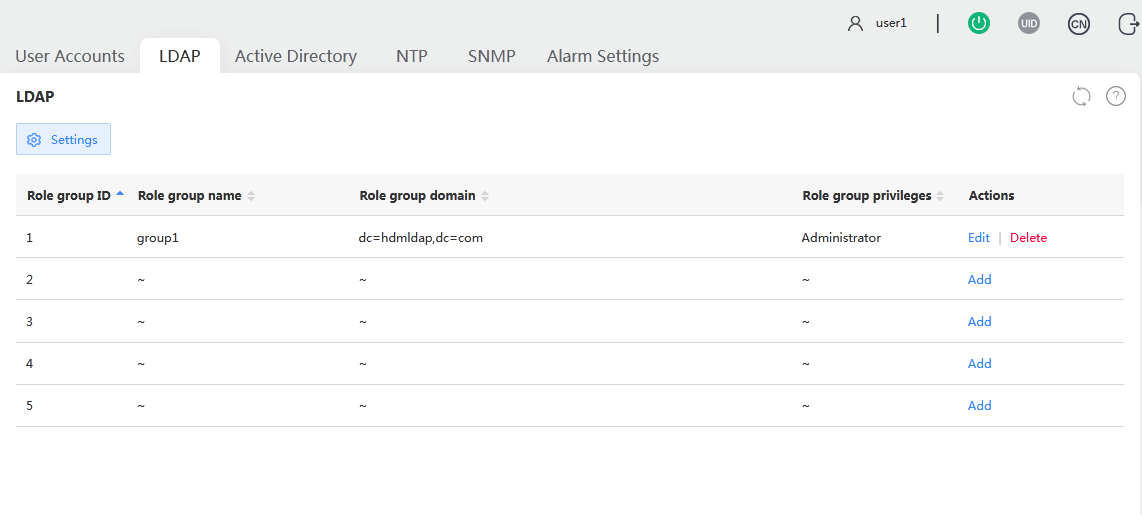- Table of Contents
- Related Documents
-
| Title | Size | Download |
|---|---|---|
| 01-Text | 9.39 MB |
Contents
Sign in to HDM for rack servers
Sign in to HDM for blade servers and AE modules
View Ethernet adapter information
View storage controller information
View logical drive information
View physical drive information
View information about a logical drive (a RAID array) or delete a logical drive
View factory information about FRUs
Configure the event log policy
General restrictions and guidelines for network configuration
View summary information about the dedicated network port
Configure the dedicated network port
View summary information about the shared network port
Configure the shared network port
Change the shared network port
User roles and privileges matrix
View or close HDM user sessions
Types of firewall rules and their priority order
Upload an SSL certificate and key to HDM
Launch a KVM or H5 KVM remote console
Operate the server from H5 KVM
Turn on or turn off the UID LED of the server
Configure boot options for the next reboot
Manage power and power consumption
View the power status of the server
Change the power status of the server
View summary of the power supplies
View the total power of the server
Configure global power settings
View power capping information
Manage redundant power supplies
Set the operating mode of power supplies
View the power consumption history statistics
View the power consumption history chart
Import and export configuration
Export HDM, BIOS, or RAID configuration
Restore factory default HDM settings
Firmware update restrictions and guidelines
Prerequisites for firmware update
Update drive backplane firmware
Switch over between primary and backup HDM firmware images
Launch an H5 KVM remote console
Mount images through a Windows CIFS server
Mount images through a Linux CIFS server
Set up a Linux syslog server based on UDP or TCP
Set up a Linux syslog server based on TLS
About HDM
Introduction
Hardware Device Management (HDM) is a remote server management system that provides abundant features as described in Table 1.
|
Description |
|
|
Web-based management |
Provides a user-friendly Web-based management interface for easy management. |
|
Various management interfaces |
Provides abundant management interfaces, such as IPMI, HTTPS, SNMP, RESTful, and Redfish, to meet various system integration requirements. |
|
IPMI v1.5 and IPMI v2.0 compliance |
Provides a standard management interface for standard management system integration. |
|
Remote control |
Provides remote access to the server through KVM and virtual media, enabling server monitoring and management anywhere anytime. |
|
Critical OS event screenshot and video recording |
Takes a screenshot or records a video upon a critical OS event (for example, a crash) for future troubleshooting. |
|
Video recording |
Records operations on the server. |
|
Sideband and VLAN |
Supports VLANs and the sideband technology that allows for flexible network management. |
|
LDAP |
Simplifies user management and enhances management security by managing users on the LDAP server. |
|
All-round server monitoring, alarming, and event logging |
Monitors server operation, for example, temperature, voltage, and fan speed, and generates alarms and logs if any event occurs, such as drive failure or power supply failure. |
|
Smart Hardware Diagnosis (SHD) |
Supports SHD for component fault diagnosis, bringing ease to fault location and faulty component replacement. |
|
Out-of-band RAID management |
Supports out-of-band RAID monitoring and configuration to improve RAID configuration efficiency and management capability. |
|
Primary/backup image switchover |
Enables startup by using the backup image if the system crashes, which enhances system availability. |
Applicable products
This document is applicable to the following products:
· AE100.
· H3C UniServer B5700 G3.
· H3C UniServer B5800 G3.
· H3C UniServer B7800 G3.
· H3C UniServer E3200 G3.
· H3C UniServer R2700 G3.
· H3C UniServer R2900 G3.
· H3C UniServer R4100 G3.
· H3C UniServer R4300 G3.
· H3C UniServer R4400 G3.
· H3C UniServer R4700 G3.
· H3C UniServer R4900 G3.
· H3C UniServer R4950 G3.
· H3C UniServer R5300 G3.
· H3C UniServer R6700 G3.
· H3C UniServer R6900 G3.
· H3C UniServer R8900 G3.
· H3C UniStor X10000 G3.
Using this document
The figures of hardware options used in this document are for illustration only and might differ from your product.
The screenshots in this document are subject to change over time.
Some data in this document is used as an example and might differ from your product.
Sign in to HDM
The following information describes the prerequisites for a successful sign-in to HDM, the default sign-in parameters, the sign-in procedure, and global operations for all pages.
Sign in to HDM for rack servers
Prepare for an HDM sign-in
Before you sign in to the HDM Web interface, make sure all preparation requirements are met.
Set up the HDM client
HDM does not require installation of client software. You can use a Web browser to access HDM.
Make sure the browser and resolution setting of the configuration terminal meet the requirements in Table 2.
Table 2 Browser and resolution requirements
|
Browsers |
Resolution |
|
Google Chrome 48.0 (or higher) Internet Explorer 11 (or higher) Mozilla Firefox 50.0 (or higher) |
Minimum: 1366*768 Recommended: 1600*900 (or higher) |
Connect the server to the network
Connect either of the following network port on the server to the network:
· HDM shared network port—Transmits HDM management traffic and server data traffic simultaneously. This port is available on all servers.
· HDM dedicated network port—Transmits only HDM management traffic. This port is not available on blade servers and AE modules.
For network port configuration on rack or storage servers, see "Manage network configuration." For network port configuration on blade servers and AE modules, see "Shared port."
Figure 1 Connecting the server to the network (HDM dedicated network port on the R4900)
Obtain the HDM sign-in settings
To sign in to HDM, you must obtain its management IP address and user account information.
On first sign-in, use the default settings in Table 3. To change the management IP address after login, see "Manage network configuration."
Table 3 Default HDM sign-in settings
|
Item |
Default setting |
|
IP address |
HDM shared network port: DHCP HDM dedicated network port: 192.168.1.2/24 |
|
Username |
admin |
|
Password (case-sensitive) |
You can obtain the HDM management IP address from the POST screen of the BIOS. As shown in Figure 2, the POST screen displays the IPv4 addresses of the shared and dedicated network ports at the upper right corner, and the IPv6 addresses at the lower left corner.
Figure 2 Obtaining the HDM management IP address (BIOS version 2.00.27)
Sign in to HDM
Restrictions and guidelines
By default, the session timeout is 30 minutes. If no operation is performed within 30 minutes, the system logs you out.
After five consecutive password check failures, your account will be locked for five minutes.
For security purposes, change the default username and password at the first login, and update your password periodically.
Procedure
2. On the security certificate page that opens, click Continue to this website (not recommended).
Figure 3 Security certificate confirmation page
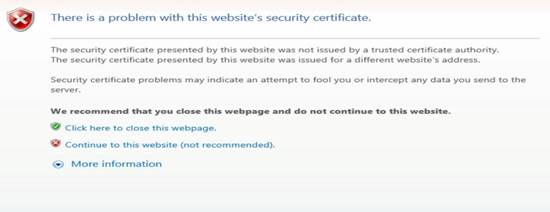
3. On the sign-in page, enter the username and password, and then click Sign in.
If this is the first sign-in, enter the default username (admin) and password (Password@_). The password is case-sensitive.
Figure 4 HDM sign-in page
4. If this is the first sign-in, change the username and password for security purposes as described in "User accounts."
Sign in to HDM for blade servers and AE modules
For blade servers and AE modules, HDM is accessible only from OM. You can access HDM from the Remote Consoles page without being authenticated or by clicking the HDM network IP address from the blade server information page.
Only OM administrator users and operator users that have the HDM access privilege can access HDM from OM.
The HDM sign-in procedure is the same for blade servers and AE modules. This section uses the procedure for blade servers as an example.
HDM sign-in flowchart
Prepare for an HDM sign-in
Setting up the configuration environment
As shown in Figure 5, use a local PC as the HDM client and connect the PC to the management (MGMT) ports on the active and standby OM modules. For more information about port locations, see the labels on the front panel of the OM modules.
Figure 5 Setting up the configuration environment
Obtain OM sign-in settings
To sign in to OM Web interface, you must obtain its management IP address and user account information. On first sign-in, use the default settings in Table 4.
Table 4 Default OM sign-in settings
|
Item |
Default setting |
|
IP address |
192.168.100.100/24 |
|
Username |
admin |
|
Password (case-sensitive) |
Password@_ |
Set up the HDM client
HDM does not require installation of client software. You can use a Web browser to access HDM. To ensure login success, follow these restrictions:
· Make sure the IP address of the HDM client is in the same network segment with the management IP addresses of OM modules and HDM. You can obtain the HDM management IP address from the OM Web interface. For more information, see OM online help.
· Make sure the browser and resolution setting of the configuration terminal meet the requirements in Table 5.
Table 5 Browser and resolution requirements
|
Browsers |
Resolution |
|
Google Chrome 58.0 (or higher) |
Recommended: 1600*900 (or higher) |
Sign in to OM
1. Open the browser, and enter the OM management IP address in the format of https://OM_ip_address.
2. On the sign-in page, enter the username and password, and then click Login.
If this is the first sign-in, enter the default username (admin) and password (Password@_). The password is case-sensitive.
Figure 6 Signing in to OM
Sign in to HDM
Free authentication access
1. In the navigation pane of the OM Web interface, click Blade Servers, select the target server, and then click Remote Consoles.
2. On the Remote Consoles tab, click the Access HDM button to sign in to HDM, as shown in Figure 7.
If this is the first sign-in, click the Proceed to link as shown in Figure 8 to trust the webpage that opens.
Figure 7 Free authentication access
Figure 8 Confirming the connection
The HDM Web interface opens.
HDM network IP access
1. In the navigation pane of the OM Web interface, click Blade Servers, select the target server.
2. In the HDM Network Info section, click the IP address link from the IPv4 Address field, as shown in Figure 10.
If this is the first sign-in, click the Proceed to link as shown in Figure 8 to trust the webpage that opens.
Figure 10 HDM network IP access
The HDM Web interface opens.
Figure 11 HDM Web interface
Global operations
You can perform the following operations on any HDM page:
· To change the language, click ![]() for English and
for English and ![]() for
Chinese.
for
Chinese.
Display device information
Summary
The Summary menu presents an overview of the server, including its status summary, basic information, system alarm status, server power status, UID LED status, TCP/TCM status, and HDM user sessions. In addition, this page provides shortcuts for you to quickly access the desirable function or feature menus.
Procedure
In the navigation pane, select Dashboard > Summary, as shown in Figure 12.
Figure 12 Viewing summary information about the server
The work pane provides the following sections:
· Section 1—Displays the overall health state of the system and subsystems with issues. Table 6 displays the summary of subsystem health states.
¡ If this section displays ![]() Normal, all server subsystems are
operating correctly. No administrative action is required.
Normal, all server subsystems are
operating correctly. No administrative action is required.
¡ If
this section displays ![]() Critical or
Critical or ![]() Major, a minimum of one subsystem is experiencing issues. In this situation, view the specific sensor statistics or event
logs to identify the issues, as shown in Figure 13 and
Figure 14.
Major, a minimum of one subsystem is experiencing issues. In this situation, view the specific sensor statistics or event
logs to identify the issues, as shown in Figure 13 and
Figure 14.
Figure 13 Viewing sensor statistics
· Section 2—Displays the number of alarms for each alarm severity level. An alarm represents an event that requires administrative attention or action. To view detailed information about alarms of a severity level, click the severity or number link. For more information, see "Event log."
Severity options include:
¡ Info—The event does not affect the system and no action is required. Examples include normal state changes and alarm removed events.
¡ Minor—The event has minor impact on the system, but it requires prompt action to avoid an escalation in severity.
¡ Major—The event has serious impact on some subsystems and might result in service interruption. Immediate action is required.
¡ Critical—The event might result in system crash or shutdown. Immediate action is required.
· Section 3—Displays UID LED status, server power status, and TCP/TCM status. For information about setting the power state, see "Power control."
¡ UID LED status options include:
- On—The UID LED of the server is steady blue.
- Flashing—The UID LED of the server is flashing blue. The UID LED flashes if a firmware update is being performed on the server or if the remote console is open after the UID button was turned on.
- Off—The UID LED of the server is off.
¡ Server power status options include:
- On—The server is powered on.
- Off—The server is powered off.
¡ TPM/TCM status options indicate the enablement status of TPM/TCM.
Trusted Platform Module (TPM) is a microchip embedded in the system board. It stores encryption information (such as encryption keys) for authenticating server hardware and software. Trusted Cryptography Module (TCM) is a trusted computing platform-based hardware module with protected storage space, which enables the platform to implement password calculation. For information about the TPM/TCM module installation, see the user guide for the server.
· Section 4—Displays basic information about the server, including:
¡ Host name of the server. For information about changing the host name, see "Manage network configuration."
¡ Product serial number of the server.
¡ IPv4 addresses of the network ports for accessing the HDM. This field displays the HDM dedicated and shared network ports if the network port mode is normal or active/standby. If the network port mode is bonding, this field displays the bond port Bond0.
¡ MAC address of the network port being used for accessing HDM. For more information, see "Manage network configuration."
¡ Current firmware versions of the HDM, BIOS, and CPLD. For information about firmware update, see "Update firmware."
¡ Date and time on the HDM. For more information, see "NTP."
¡ Server name, a string of 1 to 63 characters that cannot start or end with spaces. The server name can contain only letters, digits, spaces, and the following special characters: ` ~ ! @ # $ % ^ & * ( ) _ + - = [ ] { } | ; ' : \ " , . / < > ?
¡ Remote consoles supported: KVM and H5 KVM. For more information, see "Remote control."
· Section 5—Displays all HDM user sessions that are accessing HDM, including Telnet, SSH, Web, and Serial sessions. The session with an asterisk (*) attached to the session ID represents the current session. For more information about HDM user sessions, see "Access services."
Parameters
Table 6 Subsystem health states
|
Subsystem |
State |
Description |
|
Fans |
|
The fans are operating correctly in redundancy. None of the fans at critical locations have failed. |
|
Fan redundancy issue is present because fans at two or more critical locations have failed. |
||
|
Temperature |
|
All component temperatures are within the normal range. No action is required. |
|
A component temperature has crossed a major threshold, but it has not reached a critical threshold. Immediate action is required. |
||
|
A component temperature has crossed a critical threshold. Immediate action is required. |
||
|
Power supplies |
|
The power supply is operating correctly. |
|
A severe power supply error has occurred. |
||
|
Current |
|
No overcurrent is present. |
|
Overcurrent is present on some components on the system board. |
||
|
Voltage |
|
All components are in a normal voltage condition. No action is required. |
|
A voltage value has crossed a major threshold, but it has not reached a critical threshold. Immediate action is required. |
||
|
A voltage error is present or a voltage value has crossed a critical threshold. Immediate action is required. |
||
|
Memory |
|
The memory is operating correctly. |
|
One of the following conditions exists: · A memory exception error has occurred. · All memory modules are absent or isolated. · An unrecoverable memory error has occurred. · BIOS halt has occurred during POST because of incorrect DIMM installation or DIMM incompatibility. |
||
|
Processors |
|
The processors are operating correctly. |
|
An overtemperature condition has occurred. |
||
|
The primary processor is absent, the temperature of the processor has exceeded the critical threshold, or an unrecoverable processor error has occurred. |
||
|
Drives |
|
All drives are operating correctly. |
|
A severe drive error has occurred. |
||
|
Storage |
|
All logical drives are operating correctly. |
|
A logical drive error has occurred. |
||
|
PCIe modules |
|
All PCIe modules are operating correctly. |
|
A bus uncorrectable error, bus fatal error, or PCIe err error has occurred. |
||
|
Server boards |
|
All server boards are operating correctly. |
|
An error has occurred on a power supply or a power supply slot. |
||
|
An error has occurred on a server board. |
Hardware summary
The Hardware Summary menu displays information about hardware, including processors, memory, and storage.
The available server configuration varies by server model.
View CUPS information
The CUPS feature provides real-time monitoring of processor (CPU), memory, and I/O usage in the system. It uses the proportions of dynamic load factors for CPU, memory, and I/O usage to indicate the type of main services running on the system.
A higher CPU, memory, or I/O CUPS dynamic load factor indicates that main services running on the system are compute-intensive, memory-intensive, or I/O-intensive.
Restrictions and guidelines
This feature is not available for the R4950.
The CPU, memory, and I/O CUPS load factors are all 0% when the server is powered off or no service runs on the server.
CUPS monitoring is an out-of-band function and does not consume processor resources.
The CPU and MEM CUPS load factors are uncorrelated with the CPU and MEM usage calculated in the OS.
Procedure
1. In the navigation pane, select Dashboard > Hardware Summary.
2. Click the CUPS tab to view CUPS information, as shown in Figure 15.
Figure 15 Viewing CUPS information
View processor information
Restrictions and guidelines
HDM updates processor and memory information at the POST phase. When the server is powered off, HDM displays the processor information obtained at the most recent POST.
HDM might display incorrect processor and memory information at the POST phase. Refresh the page after the server completes POST to obtain the correct information.
Procedure
1. In the navigation pane, select Dashboard >Hardware Summary.
2. Click the Processors tab to view processor information, as shown in Figure 16.
Figure 16 Viewing processor information
Parameters
· Presence status: Presence status of the processor. Options include Present and Absent.
· Model: Model of the processor.
· Status: Operating status of the processor. Options include Normal and Abnormal.
· Serial number: Unique product code assigned by the manufacturer. This field displays N/A if HDM fails to obtain the serial number.
· Frequency: Base frequency of the processor.
· Max frequency: Maximum frequency of the processor.
· Cores: Cores of the processor.
· Threads: Number of the threads supported by the processor.
· 64 bits: Indicates whether the processor supports 64-bit computing.
· L1 cache: L1 cache of the processor.
· L2 cache: L2 cache of the processor.
· L3 cache: L3 cache of the processor.
View memory information
Restrictions and guidelines
HDM updates processor and memory information at the POST phase. When the server is powered off, HDM displays the processor information obtained at the most recent POST.
HDM might display incorrect processor and memory information at the POST phase. Refresh the page after the server completes POST to obtain the correct information.
If the Status field for a memory module displays that it is absent, all remaining fields display a tilde (~) except the Processor, Channel, and Slot fields.
The memory module slots are colored to indicate the state of the installed memory modules. Color options include:
· Blue—The memory module is present and is operating correctly.
· Grey—The memory module is absent or has not been initialized.
· Red—The memory module is present but is operating incorrectly.
Procedure
1. In the navigation pane, select Dashboard > Hardware Summary.
2. Click the Memory tab.
3. Select the target processor to view its memory information, as shown in Figure 17.
Figure 17 Viewing memory information
Parameters
· Processor: ID of the processor to which the memory module is attached.
· Memory slots: Number of memory slots supported by the processor.
· Total memory size: Total memory capacity for the processor.
· Frequency: Frequency at which the memory operates.
· Channel: Channel ID of the memory module.
· Slot: Slot number of the memory module.
· Status: Memory module status. Options include:
¡ Normal—The memory module is operating correctly.
¡ Absent—The memory module is not securely installed or no memory module is installed.
¡ Disabled—The memory module is present in a channel that is disabled because a memory training error has occurred on any other memory module in the same channel.
¡ Abnormal—Either of the following conditions exists:
- The memory module is faulty.
- The memory module is present in a channel that is disabled because a memory training error has occurred on any other memory module in the same channel.
· Max frequency: Main frequency of the memory module.
· Type: DIMM type. Options include RDIMM and NVDIMM.
· Serial number: Unique product code assigned by the manufacturer. This field displays N/A if HDM fails to obtain the serial number.
· Authenticity: Whether the memory is vendor certified.
¡ If it is certified, this field displays Vendor certified.
¡ If it is not certified, this field displays Normal.
· ECC: Support for error-correcting code (ECC).
View fan information
Restrictions and guidelines
This feature is not available for the AE100, B5700, B5800, or B7800.
Procedure
1. In the navigation pane, select Dashboard >Hardware Summary.
2. Click the Fans tab to view fan information, as shown in Figure 18.
Figure 18 Viewing fan information
Parameters
· Product code—Product code that identifies the fan.
· Rotation speed (RPM)—Current actual rotational speed.
· Rotation speed (%)—Current RPM as a percentage of the rated RPM.
· Status—Presence status of the fan.
· Redundancy—Redundancy status. This field displays Abnormal if the fan at a required location is absent or has failed. This field displays Normal if the fan at a required location is operating correctly. For a non-required location, this field displays Normal regardless of whether a fan is absent or present.
View power supply information
Restrictions and guidelines
This feature is not available for the AE100, B5700, B5800, or B7800.
Procedure
1. In the navigation pane, select Dashboard > Hardware Summary.
2. Click the Power supplies tab to view information about power supplies, including their manufacturers (vendors), serial numbers, firmware versions, operating status, and maximum input power, as shown in Figure 19.
Figure 19 Viewing power supply information
Parameters
· Power ID—ID of the power supply.
· Presence status—Presence status of the power supply. Options include Present and Absent.
· Model—Model of the power supply.
· Vendor—Manufacturer of the power supply.
· Serial number—Serial number of the power supply.
· Firmware version—Firmware version of the power supply.
· Operating status—Operating status of the power supply.
· Max power (W)—Maximum output power of the power supply.
View Ethernet adapter information
Restrictions and guidelines
For Ethernet adapters that support the Management Component Transport Protocol (MCTP), perform the following tasks before enabling MCTP:
1. Update the Ethernet adapter to the firmware version that supports MCTP.
2. Enter the BIOS setup utility, select Advanced > Platform Configuration > Server ME Configuration, and then set Enable MCTP Proxy to Enabled.
3. Restart the server.
Procedure
1. In the navigation pane, select Dashboard >Hardware Summary.
2. Click the Ethernet adapters tab to view Ethernet adapter information, including their product codes, location, and link speed, as shown in Figure 20.
Figure 20 Viewing Ethernet adapter information
Parameters
· Product name—Model of the Ethernet adapter.
· Product code—Type of the Ethernet adapter.
· Network port—Network port on the Ethernet adapter.
· Location—Physical location of the Ethernet adapter.
· MAC address—MAC address of the network port.
· Mezzanine slot: Slot number of the mezzanine Ethernet adapter.
· Firmware version—Firmware version of the Ethernet adapter.
View PCIe module information
1. In the navigation pane, select Dashboard >Hardware Summary.
2. Click the PCIe modules tab to view PCIe module information, as shown in Figure 21.
Figure 21 Viewing PCIe module information
Parameters
· Location—Physical location of the PCIe module.
· Slot—Slot number. For information about the slot location, see the user guide for the server.
· Status—PCIe module status, including Normal and Abnormal.
· Product name—Model of the PCIe module.
· Chip vendor—Chip manufacturer of the PCIe module.
· Module vendor—Manufacturer of the PCIe module.
· Serial number—Unique product code assigned by the manufacturer. This field displays N/A if HDM fails to obtain the serial number.
· Product ID—Product ID assigned by the manufacturer.
· Negotiated speed—Auto-negotiated PCIe link rate.
· Negotiated protocol—Auto-negotiated generation of the PCIe standard.
· Negotiated link width—Auto-negotiated link width of the PCIe module.
· Max speed—Maximum link rate.
· Max protocol—Supported latest generation of the PCIe standard.
· Mezzanine slot—Slot number of the mezzanine PCIe module.
· Part number—Part number of the PCIe module, which corresponds to the model of the PCIe module. This field displays N/A if HDM fails to obtain the part number.
· Max link width—Maximum link width supported by the PCIe slot.
View NVMe drive information
1. In the navigation pane, select Dashboard > Hardware Summary.
2. Click the NVMe tab to view NVMe drive information, as shown in Figure 22.
Figure 22 Viewing NVMe drive information
Parameters
· Physical location—NVMe drive slot number.
· Slot number—Slot number of the NVMe drive or PCIe slot number assigned to the drive by the system.
· Vendor—Manufacturer of the NVMe drive.
· Product name—Product name of the NVMe drive.
· Status—NVMe drive status:
¡ Normal—The NVMe drive is operating correctly.
¡ Abnormal—A bus uncorrectable error, bus fatal error, or PCIe err error has occurred on the NVMe drive.
¡ Spare space below threshold—The available space in the NVMe drive has fallen below the threshold.
¡ Temperature anomaly—The NVMe drive temperature is above the upper threshold or below the lower threshold.
¡ Subsystem degraded—The NVMe subsystem reliability has been degraded because of storage media or internal errors.
¡ Read-only mode—The NVMe drive has been placed in read only mode.
¡ Cache failed—The volatile memory backup device has failed.
· Percentage drive life used(%)—Estimate of the percentage of NVMe subsystem life used. The value can be greater than 100.
· Serial number—Serial number of the NVMe drive.
· Model—Model of the NVMe drive.
· Capacity—Capacity of the NVMe drive.
· Firmware version—Firmware version of the NVMe drive. This field displays N/A if HDM does not support displaying the firmware version of the NVMe drive.
· Interface type—Interface type of the NVMe drive.
View GPU information
This feature is available only for HDM-1.30.09 or later.
This feature is not available for the AE100, B5700, B5800, B7800, or R4100.
To view GPU information:
1. In the navigation pane, select Dashboard > Hardware Summary.
2. Click the GPU tab to view GPU information, as shown in Figure 23.
Figure 23 Viewing GPU information
Parameters
· Slot: Slot number. For information about the slot location, see the user guide for the server.
· Product name: Model of the GPU.
· Vendor name: Manufacturer of the GPU.
· Serial number: Unique product code assigned by the vendor. This field displays N/A if HDM fails to obtain the serial number.
· Part number: Part number of the GPU, which corresponds to the model of the GPU module. This field displays N/A if HDM fails to obtain the part number.
· Firmware version: Firmware version of the GPU.
· Power: Current power consumption of the GPU. If this field displays N/A, verify that the server is installed with the correct GPU driver.
View FC HBA information
Restrictions and guidelines
This feature is available only for HDM-1.30.13 or later.
For FC HBA cards that support MCTP, perform the following tasks before enabling MCTP:
1. Update the FC HBA card to the firmware version that supports MCTP.
2. Enter the BIOS setup utility, select Advanced > Platform Configuration > Server ME Configuration, and set Enable MCTP Proxy to Enabled.
3. Restart the server.
If the server is powered off, the Speed and Port connection fields display N/A.
Procedure
1. In the navigation pane, select Dashboard > Hardware Summary.
2. As shown in Figure 24, click the FC HBA tab to view FC HBA card information, including:
¡ Product name: Product name of the FC HBA card.
¡ Product code: Type of the FC HBA card.
¡ Network port: Network port on the FC HBA card.
¡ Location: Physical location of the FC HBA card.
¡ WWPN: Worldwide port number (WWPN) for the network port.
¡ WWNN: World wide node name (WWNN) for the network port.
¡ Speed: Link speed of the network port.
¡ Firmware version: Firmware version of the FC HBA card. This field displays N/A if HDM fails to obtain the firmware version.
¡ Port connection: Displays whether a cable is connected to the network port. Options include Connected and Disconnected.
Figure 24 Viewing FC HBA information
Storage
The Storage menu allows you to perform the following tasks:
· View information about storage controllers (RAID controllers or RAID-incapable storage controllers), logical drives, and physical drives.
· Manage physical and logical drives controlled by a specific storage controller.
Only the following storage controllers support out-of-band management of RAID:
· HBA-H5408-Mf-8i.
· HBA-LSI-9440-8i.
· RAID-L460-M4.
· RAID-LSI-9361-8i(1G)-A1-X.
· RAID-LSI-9361-8i(2G)-1-X.
· RAID-LSI-9460-8i(2G).
· RAID-LSI-9460-8i(4G).
· RAID-LSI-9460-16i(4G).
· RAID-P5408-Mf-8i-4GB.
· RAID-P5408-Ma-8i-4GB.
The supported storage controllers vary by server model. For more information, visit the OS compatibility query tool at https://nhct-chl.h3c.com/nhctchl/OSIndex.
View storage controller information
Restrictions and guidelines
Storage and sensor information is not available for LSI HBAs that do not support OOB.
To obtain the most recent information, refresh the page after the server's OS starts up.
Procedure
1. In the navigation pane, select Dashboard > Storage.
2. Click the RAID Summary tab.
3. Select a storage controller to view its information, as shown in Figure 25.
Figure 25 Viewing storage controller information
Parameters
· Model: Model of the storage controller.
· Firmware version: Firmware version of the storage controller.
· Connector type: Connector type supported by the storage controller.
· Data rate: Data rate supported by the connectors of the storage controller.
· Serial number: Serial number of the storage controller. If the storage controller is PMC type, you can use the OEM command to modify its serial number.
· WWN: SAS address of the storage controller. WWN is displayed only if an LSI HBA is installed.
· Built-in cache: Capacity of the read/write cache embedded in the storage controller.
· RAID levels: RAID levels supported by the storage controller.
· Flash: Status of the flash card of the power fail safeguard module.
¡ For an LSI storage controller, status options include:
- Normal—The flash card is operating correctly.
- Abnormal—The flash card is operating incorrectly.
- Absent—The flash card is not connected to the supercapacitor, not installed securely, or not installed at all.
¡ For a PMC storage controller, status options include:
- Normal—The flash card is operating correctly.
- Absent—The flash card of the power fail module is not securely installed or is not installed at all.
- Abnormal_status code—The flash card is operating incorrectly. You can check the status code to identify the exceptions that cause the flash card to enter the abnormal state.
- Warning_status code—A warning is present on the flash card. You can check the status code to identify the exceptions that cause the flash card to enter the warning state.
A status code is a hexadecimal number. To identify the exceptions, convert the hexadecimal status code into a 16-digit binary number (bit 0 to bit 15 from the right to the left). A set bit means that the exception indicated by the bit is present. For information about a set bit and its corresponding exception, see Table 7.
For example, if the status code is 0x500 (binary format 0000 0101 0000 0000), exceptions indicated by bit 8 and bit 10 are present on the flash card.
Table 7 Flash card exceptions and their set bits
|
Bit# |
Bit state |
Description |
|
0 |
1 |
GB subsystem is currently initializing. |
|
1 |
1 |
GB subsystem is in ready state. |
|
2 |
1 |
GB subsystem is executing a learning cycle. Learning cycles do not disrupt normal operation or the ability to protect data. |
|
3 |
1 |
GB subsystem has failed. |
|
4 |
1 |
The supercapacitor pack has exceeded the maximum temperature threshold. |
|
5 |
1 |
The supercapacitor pack has exceeded the major temperature threshold. |
|
6 |
1 |
The supercapacitor pack is over voltage. |
|
7 |
1 |
The supercapacitor pack has exceeded the maximum charging current. |
|
8 |
1 |
GB subsystem learning cycle has passed. |
|
9 |
1 |
GB subsystem learning cycle has failed. |
|
10 |
1 |
The supercapacitor pack has failed. |
|
11 |
1 |
The supercapacitor pack is nearing the end of its life. Replacement is recommended. |
|
12 |
1 |
The supercapacitor pack has reached the end of its life Replacement is required. |
|
13 |
1 |
One of the capacitors in the supercapacitor pack seems to be missing. |
|
14 |
N/A |
Reserved. |
|
15 |
N/A |
Reserved. |
|
|
NOTE: The Green backup (GB) system reports several types of operation status progress and health information. |
· Charging status: The remaining amount of power available with the supercapacitor.
· Package version: Software package version of the storage controller. This field is available only for some LSI storage controllers.
|
|
NOTE: The Flash and Charging status fields are available only if a power fail safeguard module is installed. A power fail safeguard module contains a flash card and a supercapacitor. When a system power failure occurs, this supercapacitor can provide power for a minimum of 20 seconds. During this interval, the storage controller transfers data from memory to the flash card, where the data remains indefinitely or until the controller retrieves the data. |
View logical drive information
Restrictions and guidelines
This feature is unavailable for RAID-incapable storage controllers.
The default maximum capacity of a logical drive might be slightly different from the maximum capacity you can set. If you do not specify a drive capacity when creating a logical drive, the drive capacity is the default maximum capacity calculated by the system.
Procedure
1. In the navigation pane, select Dashboard > Storage.
2. Click the RAID Summary tab.
3. Select storage controller > logical drive to view drive information, as shown in Figure 26.
Figure 26 Viewing logical drive information
Parameters
· Name: Name of the logical drive.
· Status: Status of the logical drive. Options include:
¡ Optimal—The logical drive is operating correctly.
¡ Degraded—Some RAID member drives have failed and require prompt replacement.
¡ Rebuilding—The RAID array is being rebuilt to reconstruct data and recover from the degraded state.
¡ Offline—The logical drive is corrupt and inaccessible.
¡ Zeroing—The logical drive is being formatted. All data will be deleted upon this action.
¡ Scrubbing—The member drives are being scanned to maintain data continuity in the logical drive. This field is available for logical drives with parity bits, such as RAID 5 and RAID 6 logical drives.
¡ Suboptimal—One member drive in the RAID 6 or RAID 60 logical drive has failed. If more than one member drive has failed, the logical drive is placed in Degraded state. This field is available for RAID 6 and RAID 60 logical drives.
¡ Morphing—Data is being migrated between drives or the RAID array is changing to a new RAID level.
¡ Copying—Data is being copied from the hot spare disk back to the replacement drive of a failed drive. When this operation is complete, the hot spare returns to the hot standby state.
· BootEnable: Indicates whether the logical drive is a boot drive. Support for this field depends on the storage controller model. Options include:
¡ True—The logical drive is a boot drive.
¡ False—The logical drive is not a boot drive.
· Stripe size: Stripe size of each physical drive. Support for this field depends on the storage controller model.
· Read policy: Read policy for the logical drive. Support for this field depends on the storage controller model. Options are:
¡ No read ahead—Disables read ahead capability.
¡ Read ahead—Enables read ahead capability. When this capability is enabled, the controller reads sequentially ahead of requested data and stores the additional data in cache memory.
· Write policy: Write policy for the logical drive. Support for this field depends on the storage controller model. Options are:
¡ Write through—Enables the controller to send a data transfer completion signal to the host when the drive subsystem has received all data in a transaction.
¡ Write back—Enables the controller to send a data transfer completion signal to the host when the controller cache receives all data in a transaction. If the storage controller is not installed with a supercapacitor or if the supercapacitor is faulty, the Write through policy is used.
¡ Always write back—Enables the controller to send a data transfer completion signal to the host when the controller cache receives all data in a transaction.
· I/O policy: I/O policy for the logical drive. Support for this field depends on the storage controller model. Options include:
¡ Direct—Disables the cache module from processing any read or write operations on the storage controller.
¡ Cached—Enables the cache module to process all read and write operations of the storage controller.
· Drive cache: Indicates whether drive cache is enabled for the logical drive. Support for this field depends on the storage controller model. Options include:
¡ Unchanged—The default drive cache policy is used.
¡ Enable—Drive cache is enabled.
¡ Disable—Drive cache is disabled.
· Access policy: Access policy for the logical drive. Support for this field depends on the storage controller model. Options include:
¡ Read/Write.
¡ Read only.
¡ Blocked.
· Acceleration method: Status of read/write cache. Support for this field depends on the storage controller model. Options include:
¡ Controller Cache—Enables read/write cache.
¡ None—Disables read/write cache.
¡ IO Bypass—Enables the storage controller to use I/O bypass paths to enhance read/write performance. This feature is available only on SSDs.
View physical drive information
Restrictions and guidelines
· If the storage controller and the backplane are not installed as required, the following fields might be displayed incorrectly:
¡ Slot.
¡ Drive number in the BIOS.
¡ Drive number in OS.
· If the drive status is Failed, the drive information (including the drive size, speed, and interface type) might be inaccurate.
Procedure
1. In the navigation pane, select Dashboard > Storage.
2. Click the RAID Summary tab.
3. Select storage controller > physical drive to view drive information, as shown in Figure 27.
Figure 27 Viewing physical drive information
Parameters
· Slot: Slot number of the physical drive.
· Drive number in BIOS: Drive number displayed in the BIOS.
· Drive number in OS: Drive number displayed in the operating system.
· Status: Status of the physical drive. Options include:
¡ Ready/Unconfigured Good—The physical drive has been initialized or has not been configured, and it is available for RAID configuration and hot spare setting. The status name depends on the storage controller model.
¡ Unconfigured Bad—The physical drive has residual RAID information, which requires manual deletion.
¡ Optimal/Online—The physical drive is already used to create a RAID. The status name depends on the storage controller model.
¡ Offline—The physical drive is disabled.
¡ Rebuilding—The physical drive is being used in RAID rebuilding.
¡ Hot spare—The physical drive is already used as a hot spare.
¡ JBOD—The physical drive is already used to create a JBOD.
¡ Failed—The physical drive failed.
¡ Predict Fail/PFA—The physical drive is analyzing possible failures. The status name depends on the storage controller model.
¡ Raw—A new physical drive or a physical drive in Unconfigured good state is uninitialized.
¡ Normal—The physical drive is used as a common hard disk for storage. It is not used for other purposes.
· Rebuilding progress: Rebuilding progress of the physical drive in RAID rebuilding. This field is available only when the physical drive is in Rebuilding state.
· Type: Speed, interface type, and drive type of the physical drive.
· Remaining SSD life—Remaining SSD life in percent. Support for this field varies by drive model.
Manage physical drives
Perform this task to view physical drive information and change the state of a physical drive.
Restrictions and guidelines
You cannot change the state of the following physical drives:
· Physical drives attached to a PMC storage controller.
· Faulty physical drives in Unconfigured Bad state.
· Physical drives in Unconfigured Good (Foreign) or Unconfigured Bad (Foreign) state.
Procedure
1. In the navigation pane, select Dashboard > Storage.
2. In the work pane, click the RAID Management tab.
3. Click the name of a storage controller, and then click the Physical drives tab.
The page that opens displays information about physical drives attached to the controller. For an LSI storage controller, the gray-colored item in the Actions column represents the state of physical drives.
4. To change the state of a physical drive attached to an LSI storage controller, click the Unconfigured Good or Unconfigured Bad link from the Actions column, as shown in Figure 28.
Figure 28 Managing physical drives (for an LSI storage controller)
Parameters
· Unconfigured Good: The physical drive can be used to create a logical drive or used as a hot spare drive.
· Unconfigured Bad: The physical drive is not initialized or contains an unrecoverable error.
View information about a logical drive (a RAID array) or delete a logical drive
Restrictions and guidelines
After you delete a logical drive, wait a few minutes for the system to complete the operation. Then, you can refresh the page to verify the operation result.
Procedure
1. In the navigation pane, select Dashboard > Storage.
2. In the work pane, click the RAID Management tab.
3. Click the name of a storage controller, and then click the Logical drives tab.
4. In a logical drive entry, click View or Delete to view its information or delete it, as shown in Figure 29.
Figure 29 Viewing or deleting a logical drive
Create a logical drive
Restrictions and guidelines
A physical drive can be used to create only one logical drive.
After you create a logical drive, wait a few minutes for the system to complete the operation. Then, you can refresh the page to verify the operation result.
Procedure
1. In the navigation pane, select Dashboard > Storage.
2. In the work pane, click the RAID Management tab.
3. Click the name of a storage controller, and then click the Logical drives tab, as shown in Figure 30.
Figure 30 Managing logical drives
4. Click Create a logical drive.
5. Configure logical drive parameters, select physical drives, and then click Save, as shown in Figure 31.
Figure 31 Creating a logical drive
Parameters
· Name: Enter the drive name, a string of 0 to 15 characters. As a best practice, do not use special characters. For a PMC storage controller, this field is required.
· Spans/Parity groups: Enter the number of spans or parity groups for mixed-mode RAID (RAID 00, RAID 10, RAID 50, or RAID 60).
· Initialization type: Select an initialization type. Options include:
¡ No—Does not initialize the logical drive.
¡ Fast—Initializes the first and last 8 MB of the logical drive for data write upon drive creation, and then initializes the remaining space in background.
¡ Full—Initializes all space in the logical drive.
· Capacity: Enter the drive capacity. The minimum capacity of a logical drive is 100 MB. If you do not specify a capacity, the maximum capacity is used.
For more information about the other parameters of a logical drive, see "View storage controller information," "View logical drive information," and "View physical drive information."
FRUs
The FRUs menu displays the factory information coded in hardware about the field replaceable units.
View factory information about FRUs
Restrictions and guidelines
The tab for an FRU type is available only if a minimum of one FRU of that type is installed.
HDM does not support displaying information about third-party FRUs.
Procedure
1. In the navigation pane, select Dashboard > FRUs.
2. In the work pane, navigate to the FRUs tab to view factory information about the server and the FRU, including the manufacture date, manufacturer (vendor), model, and asset tag, as shown in Figure 32.
Figure 32 Viewing FRU information
Parameters
· Product name: Model of the component.
· Asset tag: Asset tag of the server. The asset tag is a string of 2 to 32 characters and can contain only letters, digits, spaces, and the following special characters:
` ~ ! @ # $ % ^ & * ( ) _ + - = [ ] { } | ; ' : \ " , . / < > ?
· Server type: Chassis type of the server.
· Number of MAC addresses: Number of MAC addresses of the server..
· Chassis number: Number of the server chassis.
Firmware
Information displayed on the Firmware menu varies by server model. Use Table 8 to determine the components whose firmware information can be displayed.
Table 8 Supported components for firmware information display
|
Server models |
Components |
|
· R2700 G3 · R2900 G3 · R4300 G3 · R4700 G3 · R4900 G3 · R4950 G3 |
· System board. · Diagnostic panel. · Drive backplanes. · Drive expander modules. |
|
R4100 G3 |
· System board. · Diagnostic panel. |
|
R4300 G3 R4400 G3 |
· System board. · Drive backplanes. · Drive expander modules. |
|
R5300 G3 |
· System board. · Drive backplanes. · Diagnostic panel. |
|
R6700 G3 |
· System board. · Diagnostic panel. · Drive backplanes. · Processor mezzanine board. |
|
R6900 G3 |
· Management module. · Diagnostic panel. · Drive backplanes. · Drive expander modules. · PDB. · CMOD main boards. · CMOD riser cards. · Rear riser cards. |
|
R8900 G3 |
· Management module. · Diagnostic panel. · PDB. · CMOD main boards. · Drive backplanes. · Rear riser cards. · CMOD riser cards. · sLOM Ethernet adapters. |
|
· AE100 · B5700 G3 · B5800 G3 · B7800 G3 · E3200 G3 |
· System board. · Drive backplanes. |
Identify firmware information
Restrictions and guidelines
The tab for the system board or diagnostic panel is available only if the board or panel is installed.
Procedure
In the navigation pane, select Dashboard > Firmware, as shown in Figure 33.
Figure 33 Viewing firmware information (for the R4700)
Sensors
The Sensors menu displays data collected by each sensor in the system. You can use the sensor data to monitor the health state of the server and identify the cause when the system health deteriorates.
This section takes voltage sensors as an example. For more information about sensor information, see HDM online help.
Procedure
1. In the navigation pane, select Dashboard > Sensors.
2. Click the Voltage tab to view voltage status and readings, as shown in Figure 34.
Figure 34 Viewing voltage status
Parameters
· Sensor: Name of the voltage sensor for a component.
· Status: Presence of voltage fault. Options include:
¡ Normal—No voltage fault is present.
¡ N/A—The component is absent or the voltage value cannot be obtained
¡ Minor—A minor alarm is detected.
¡ Major—A major alarm is detected.
¡ Critical—A critical alarm is detected.
· Reading: Reading of the voltage sensor. The reading indicates whether a voltage fault is present or displays the voltage detected by the sensor.
· Thresholds: Voltage thresholds:
¡ Critical—Lower and upper critical thresholds.
¡ Major—Lower and upper major thresholds.
¡ Minor—Lower and upper minor thresholds.
If a threshold is not specified, N/A is displayed.
Monitoring
The Monitoring menu displays CPU usage, MEM usage, and readings of the voltage, electrical current, and temperature sensors collected every 5 minutes in the past 24 hours or 7 days.
Restrictions and guidelines
This feature is available only for HDM-1.12.05 or later.
This feature is not available for the R4950 server.
Only linear sensors support this feature.
HDM cannot obtain the server monitoring statistics during restart.
Restoring the HDM factory defaults clears the monitoring statistics.
The CPU and MEM usage displayed in the chart are uncorrelated with the CPU and MEM usage calculated in the OS.
Procedure
1. In the navigation pane, select Dashboard > Monitoring.
2. In the work pane, click the CPU Usage, MEM Usage, or Sensors tab to view the corresponding information, as shown in Figure 35.
3. To view sensor readings on the Sensors tab, select a sensor type and a sensor name. You can perform the following tasks in the work pane:
¡ To clear the highest history reading and start a new statistics period, click Restart. By default, HDM displays the highest sensor reading in the time span from server startup to the present.
¡ To view sensor readings for the past 24 hours or past 7 days in the line chart, select Past 24 hours or Past 7 days. You can hover over the lines in the chart to view sensor statistics for a monitoring period.
¡ To view only the maximum, average, or minimum sensor readings, click the Max, Avg, or Min icon.
Figure 35 Viewing monitoring statistics
Resource summary
You can view the processor, memory, disk, and bandwidth usage information of the server and set alarm thresholds for the processor, memory, and disk usage.
You cannot set the alarm threshold for the bandwidth usage from HDM. To set this alarm threshold, use IPMI commands. For more information, see H3C HDM IPMI Basics Command Reference.
View resource summary
In the navigation pane, select Dashboard > Resource Summary, as shown in Figure 36.
Figure 36 Viewing resource summary
Set alarm thresholds
Restrictions and guidelines
To use this feature, you must install and run FIST SMS in the operating system of the server. For more information about installing FIST SMS, see H3C Servers FIST SMS User Guide.
The system generates a log entry if an alarm occurs or is cleared. You can view the alarms on the Event Log page.
Procedure
1. In the navigation pane, select Dashboard > Resource Summary.
2. Click Advanced at the upper right of the page.
3. In the dialog box that opens, set the alarm thresholds for processor usage, memory usage, and disk usage, as shown in Figure 37.
Figure 37 Setting alarm thresholds for processor, memory, and disk usage
4. Click Save.
Download log
This feature enables users to download records about events, storage, configuration, and HDM throughout the lifecycle of the server. You can use a log analysis tool (for example, FIST) to analyze the downloaded log. For more information about using FIST, see the FIST user guide for the server.
Restrictions and guidelines
Simultaneous log downloading by multiple users is not supported.
If a time range is selected, the timestamps in the event log entries are used as the time reference to identify the matching log entries.
An .sds file saves log entries in UTC, but HDM uses the date and time synchronized from an NTP server. If you download log entries for a specific period, HDM converts the specified start time and end time into UTC, which might introduce time differences.
The downloaded log entries are saved in an .sds file folder. For more information about files in the file folder, see "Appendix Downloaded log files."
Procedure
1. In the navigation pane, select Dashboard > Log Download.
2. Specify log entries to download, as shown in Figure 38.
¡ To download all log entries, select Download entire log.
¡ To download the log entries for a period, select Download specified log. Then, set a time range in days.
Figure 38 Specifying log entries to download
3. (Optional.) Add contact information.
4. Click Download log.
The page displays the downloading progress, as shown in Figure 39.
Figure 39 Displaying the downloading progress
5. Save the downloaded log files to the local server.
6. (Optional.) Import the log files to a log analysis tool.
Display server health
Use server health diagnostic features such as logs, BSoD screenshot, video replay, and POST codes to assess the system health state and troubleshoot server issues.
Event log
The event log records events reported by server sensors.
Configure the event log policy
Perform this task to specify the action to take on new events when the event log fills up.
The following are available actions:
· Stop logging at full storage.
· Overwrite oldest entries at full storage.
Procedure
1. In the navigation pane, select Server > Event Log.
2. Select an event log policy from the Log policy field.
Figure 40 Specifying the event log policy
Manage the event log
Filter and view the event log
1. In the navigation pane, select Server Health > Event Log.
2. In the work pane, filter events as follows:
¡ To display the events of a particular level, select that severity from the All severities list, as shown in Figure 41.
Figure 41 Filtering log entries by severity
¡ To display the events generated by sensors of a particular type, select that sensor type from the All types list, as shown in Figure 42.
Figure 42 Filtering log entries by sensor type
¡ To display the events generated during a period, select that period from the All periods list, or customize a period, as shown in Figure 43.
Figure 43 Filtering log entries by period
¡ To
filter events based on keywords, enter the keywords, and then click the query
icon ![]() .
.
3. To clear all specified filter criteria, click Reset.
Delete all event log entries
1. In the navigation pane, select Server Health > Event Log.
2. In the work pane, click Delete all.
The deleted event log entries cannot be restored. After all event log entries are deleted, the system automatically generates a log entry that records the deletion.
Save the event log
1. In the navigation pane, select Server Health > Event Log.
2. Click Save to save event log entries to a .csv file.
Parameters
· ID: Event number. Events are numbered in chronological order. By default, the events in the event list are sorted by event number in ascending order.
· Timestamp: Date and time when the event was logged.
· Alert status: Alarm status of the event. Cleared means that the event alarm has been cleared. Triggered means that the event is to be resolved.
· Severity: Severity level of the event.
¡ Info—The event does not adversely affect the system. No action is required. Examples of informational events include expected state change events and alarm removed events.
¡ Minor—The event has minor impacts on the system. Prompt action is required to avoid an escalation in severity.
¡ Major—The event might cause part of the system to fail and result in service interruption. Immediate action is required.
¡ Critical—The event might result in system outage or power failure. Immediate action is required.
Remarks
When the event log reaches the maximum size (3639), logging action on new events depends on the event log policy.
Operation log
The operation log includes audit log entries, firmware update log entries, hardware update log entries, and configuration log entries.
· Audit log entries record HDM administrative events, including access to HDM and remote console startup.
· Firmware update log entries record HDM firmware updates as well as their results.
· Hardware update log entries record hardware updates as well as their results. The hardware components include processors, DIMMs, drives, and power supplies.
· Configuration log entries record user configuration operations as well as their results.
Manage the operation log
View the operation log
1. In the navigation pane, select Server Health > Operation Log.
2. In the work pane, filter events as follows, as shown in Figure 44:
¡ To display the events generated by sensors of a particular type, select that sensor type from the All types list.
¡ To display the events of a particular level, select that severity from the All severities list.
Figure 44 Filtering log entries by severity
Save the operation log
1. In the navigation pane, select Server Health > Operation Log.
2. Click Save to save operation log entries to a .csv file, as shown in Figure 44.
Parameters
· ID: Event number. Events are numbered in chronological order. By default, the events in the event list are sorted by event number in ascending order. The system can display a maximum of 1000 event log entries.
· Timestamp: Date and time when the event was logged.
· Interface type: Type of the interface through which the operation was performed.
· IP address: User IP address.
· Host name: HDM host name.
· Description: Description of the log entry.
BSoD screenshots
View BSoD screenshots
Prerequisites
Make sure the KVM service has been enabled for your user account from the Security > Services page. If KVM is not enabled, contact the administrator.
Procedure
1. In the navigation pane, select Server Health > BSoD Screenshots.
2. View the BSoD screenshots listed on the page, as shown in Figure 45.
Figure 45 Viewing BSoD screenshots
Video replay
This feature records the server status upon occurrence of severe operating system events, including crash, restart, and shutdown.
Enable video recording
Restrictions and guidelines
If the remote console is open when an event triggers video recording, video recording will fail.
Prerequisites
Make sure the KVM service has been enabled for your user account from the Security > Services page. If KVM is not enabled, contact the administrator.
Procedure
1. In the navigation pane, select Server Health > Video Replay.
2. In the Video recording settings section, enable video recording.
3. Set the video length. The value range is 15 to 255 seconds.
4. Select types of events to be recorded: crash, restart, or shutdown.
Crash event recording is available only for Windows and Linux operating systems.
5. Click OK.
Figure 46 Configuring video replay settings
Play and manage videos
On the video replay page, you can play, download, and delete the recorded videos.
The system supports a maximum of three video files. If three video files already exist, a new video file overwrites the earliest one. The file creation time is recorded in the file properties.
Play a video
1. In the navigation pane, select Server Health > Video Replay.
2. In the Video files section, click the Play video link in the entry of the video to be played, as shown in Figure 47.
If the operating system was in sleep state when the event occurred, HDM displays a no signal message in place of the video.
3. To close the video while it is playing, click Cancel, as shown in Figure 48.
Download a video
1. In the navigation pane, select Server Health > Video Replay.
2. In the Video files section, click the Play video link in the entry of the video to be downloaded, as shown in Figure 47.
3. After the video is loaded, click Download in the entry of the video, as shown in Figure 49.
Delete a video
1. In the navigation pane, select Server Health > Video Replay.
2. In the Video files section, click Delete in the Actions column, as shown in Figure 47.
POST codes
The system generates power-on self-test (POST) codes to record its state in each phase of server startup.
View POST codes
Procedure
1. In the navigation pane, select Server Health > POST Codes.
2. In the work pane, view the system POST codes, as shown in Figure 50.
¡ POST code of current phase—POST code that describes the current startup state of the system.
¡ POST results—POST codes that describe all phases of the current or most recent startup of the system.
Figure 50 Viewing system POST codes
Parameter
Table 9 POST codes at the SEC phase
|
POST code |
Description |
|
00 |
Not used |
|
01 |
Power on |
|
02 |
MICROCODE Initialization |
|
03 |
Cache Initialization |
|
04 |
Cache Initialization Complete and enable |
|
05 |
SBSP\PBSP Branch Initialization |
|
06 |
SEC CPU Initialization CompleteCPU |
Table 10 POST codes at the PEI phase
|
POST code |
Description |
|
10 |
PEI Core Started |
|
11 |
Pre-memory CPU initialization is started |
|
12 through 14 |
Reserved for CPU |
|
15 |
Pre-memory NB Initialization |
|
16 through 18 |
Reserved for NB |
|
19 |
Pre-memory SB Initialization |
|
1a through 1c |
Reserved for SB |
|
1d through 2a |
Reserved for OEM use |
|
2b |
Memory Initialization - SPD Read |
|
2c |
Memory Initialization Start |
|
2d |
Gather Remaining SPD Data |
|
2e |
Train DDR |
|
2f |
Hardware Memory Test and Initialization |
|
30 |
Reserved for AML use |
|
31 |
Memory Initialization Complete |
|
32 |
CPU POST-Memory Initialization |
|
33 |
CPU Cache initialization |
|
34 |
Application Processor(s) (AP) initialization |
|
35 |
BSP Selection |
|
36 |
SMM Initialization |
|
37 |
POST-Memory NB Initialization |
|
38 through 3a |
Reserved for NB |
|
3b |
POST-Memory SB Initialization |
|
3c through 3e |
Reserved for SB |
|
3f through 4e |
Reserved for OEM use |
|
4f |
DXE IPL Start |
|
60 |
DXE Core Started |
|
Recovery |
|
|
f0 |
Recovery - By Firmware |
|
f1 |
Recovery - By User |
|
f2 |
Recovery Started |
|
f3 |
Recovery Capsule Found |
|
f4 |
Recovery Capsule Loaded |
|
S3 |
|
|
e0 |
S3 Resume Started |
|
e1 |
S3 Boot Script Execution |
|
e2 |
Video Repost |
|
e3 |
OS S3 wake vector call |
Table 11 POST codes at the DXE phase
|
POST code |
Description |
|
60 |
DXE Core Started |
|
61 |
NVRAM Initialization |
|
62 |
Install SB Runtime |
|
63 |
CPU DXE Initialization |
|
64 through 67 |
Reserved for CPU |
|
68 |
PCI HB Initialization |
|
69 |
NB DXE Initialization |
|
6a |
NB DXE SMM Initialization |
|
6b through 6f |
Reserved for NB |
|
70 |
SB DXE Initialization |
|
71 |
SB DXE SMM Initialization |
|
72 |
SB DEVICES Initialization |
|
73 through 77 |
Reserved for SB |
|
78 |
ACPI Module Initialization |
|
7a through 7f |
Reserved for AMI use |
|
80 through 8f |
Reserved for OEM use |
|
90 |
BDS Started |
|
91 |
Connecting Drivers |
|
92 |
PCI Bus Initialization |
|
93 |
PCI Bus Hot Plug Controller Initialization |
|
94 |
PCI Bus Enumeration |
|
95 |
PCI Bus Request Resources |
|
96 |
PCI Bus Assign Resources |
|
97 |
Console Output devices connect |
|
98 |
Console input devices connect |
|
99 |
SIO Initialization |
|
9a |
USB Initialization |
|
9b |
USB Reset |
|
9c |
USB Detect |
|
9d |
USB Enable |
|
9e through 9f |
Reserved for AMI use |
|
a0 |
IDE initialization is started |
|
a1 |
IDE Reset |
|
a2 |
IDE Detect |
|
a3 |
IDE Enable |
|
a4 |
SCSI Initialization |
|
a5 |
SCSI Reset |
|
a6 |
SCSI Detect |
|
a7 |
SCSI Enable |
|
a8 |
Setup Verifying Password |
|
a9 |
Start of Setup |
|
aa |
Reserved for AML use |
|
ab |
Setup Key Press Wait |
|
ac |
Reserved for AML use |
|
ad |
Ready to Boot |
|
ae |
Legacy Boot event |
|
af |
Exiting Boot Services |
|
b0 |
Virtual Address Begin |
|
b1 |
Virtual Address End |
|
b2 |
Legacy Option ROM Initialization |
|
b3 |
System Reset Initiated |
|
b4 |
USB Hot Plug |
|
b5 |
PCI Bus Hot Plug |
|
b6 |
NVRAM Clean Up |
|
b7 |
Configuration Reset |
|
b8 through bf |
Reserved for AMI use |
|
c0 through cf |
Reserved for OEM use |
|
d0 |
DXE CPU initialization error |
|
d1 |
DXE NB initialization error |
|
d2 |
DXE SB initialization error |
|
d3 |
Some Architectural Protocols are not available |
|
d4 |
Insufficient PCI Resources error", "Cause: Insufficient PCI MMIO Resource", "Solution: Need to remove PCI card |
|
d5 |
Not enough space for legacy OpROM |
|
d6 |
No ConOut // Reported by BDS |
|
d7 |
No ConIn // Reported by BDS |
|
d8 |
Invalid password |
|
d9 |
Boot option loading failed |
|
da |
Boot option failed |
|
db |
Flash update failed |
|
dc |
Reset protocol is not available |
|
de through df |
Reserved for AMI use |
Table 12 PEI Error codes
|
POST code |
Description |
|
50 |
SPD Reading Failed |
|
53 |
"Memory Not Detected / Not Use Full.", "Possible Cause: No Memory Found", "Solution: Insert dimms or replace the existing ones" |
|
54 |
"Hardware Memory test Failure (SIMULATED)", "Cause: Memory Test Failure", "Solution: Replace DIMM in the slot 6 under CPU 0." |
|
55 |
Memory Not Installed |
|
56 |
Invalid CPU Type / Speed |
|
57 |
CPU Mismatch (SIMULATED)", "Possible Cause: Cbo Count/List mismatch.", "Solution: Populate CPUs with same Cbo Count |
|
58 |
CPU Self Test Failed / Cache Error |
|
59 |
No MicroCode / MicroCode Update Failed |
|
5a |
CPU Internal Error |
|
5b |
Reset PPI not Available |
|
f8 |
Recover PPI Not Found |
|
f9 |
Recovery Capsule Not Found |
|
fa |
Invalid Recovery Capsule |
|
e8 |
S3 Resume Failed |
|
e9 |
S3 Resume PPI Not Found |
|
ea |
S3 Resume Boot Script Error |
|
eb |
OS S3 Wake Up Error |
Manage network configuration
General restrictions and guidelines for network configuration
To ensure the network connectivity of HDM, follow these restrictions and guidelines when you configure network settings:
· If the HDM dedicated port and the shared network port are in normal mode, make sure their IP addresses are in different subnets. Network failure might occur if the two ports use IP addresses in the same subnet.
· Do not disable the HDM dedicated network port and the shared network port at the same time. HDM Web interface will be inaccessible if both network ports are disabled.
· Any change to network settings can cause HDM user sessions to disconnect and take a few minutes to take effect. After you change network settings, reconnect to the HDM Web interface at prompt.
· If you cannot access HDM at its IPv6 address, disable proxy server in the browser and then try again.
The system supports only the 64-bit subnet prefixes if you configure the network ports to obtain IPv6 addresses through DHCPv6 or stateless autoconfiguration.
Dedicated port
The HDM dedicated network port transmits only HDM management traffic. Its default IP address is 192.168.1.2/24.
HDM dedicated network port is not available for the AE100, B5700, B5800, or B7800.
View summary information about the dedicated network port
1. In the navigation pane, select Network > Dedicated Port, as shown in Figure 51.
2. On the Basic information tab in the work pane, view summary information about the dedicated network port, including its interface name, MAC address, IP address, and VLAN settings.
Figure 51 Viewing summary information about the dedicated network port
Parameters
· Port state: This field is available only when the network port mode is active/standby. Options include:
¡ Active—The port is connected and in active state.
¡ Disconnected—The port is disconnected.
· Port connection: Displays whether a cable is connected to the port. Options include:
¡ Disconnected—The port is disconnected.
¡ Active—The port is connected and is in active state.
Configure the dedicated network port
Restrictions and guidelines
See "General restrictions and guidelines for network configuration."
With the active/standby network port mode enabled, you can configure IP settings for the port only when it is in active state. The IP settings will be synchronized to shared network ports.
Prerequisites
Verify that the HDM dedicated network port is physically connected to the network.
Configure IPv4 settings
1. In the navigation pane, select Network > Dedicated Port.
2. In the work pane, click the Configuration tab, as shown in Figure 52.
3. Enable IPv4 network service.
4. Configure IPv4 address settings for the port:
¡ To use the IP address automatically assigned by a DHCP server, select Automatic IP address obtaining.
¡ To manually configure static IP address settings, clear Automatic IP address obtaining, and then enter an IPv4 address, subnet mask, and default gateway address.
The default IP address of the HDM dedicated network port is 192.168.1.2/24. If the default gateway address is set to 0.0.0.0, no default gateway is specified.
Figure 52 Configuring IPv4 settings
5. Click Save.
Configure IPv6 settings
1. In the navigation pane, select Network > Dedicated Port.
2. In the work pane, click the Configuration tab, as shown in Figure 52.
3. Enable IPv6 network service.
4. Configure IPv6 address settings for the port:
¡ To use the IP address automatically assigned by a DHCP server, select Automatic IP address obtaining.
¡ To manually configure static IP address settings, clear Automatic IP address obtaining, and then enter an IPv6 address, the prefix length (in the range of 1 to 127), and default gateway address fe80::9628:2eff:fe9c:ffda.
5. Click Save.
Configure VLAN settings
1. In the navigation pane, select Network > Dedicated Port.
2. In the work pane, click the Configuration tab, as shown in Figure 52.
3. Enable VLAN service.
4. Enter a VLAN ID in the range of 2 to 4094.
5. Enter an 802.1p priority in the range of 0 to 7.
The 802.1p priority determines the transmission priority of the traffic from the VLAN when congestion occurs. The higher the value, the higher the priority.
6. Click Save.
Shared port
The HDM shared network port transmits HDM management traffic and server data traffic simultaneously. By default, the shared network port automatically obtains its IP address through DHCP.
The shared port can be manually specified or automatically selected. Automatic shared port selection provides higher HDM connection availability than manual configuration.
For more information about manually specifying the shared port, see "Configure the shared network port."
For more information about automatic shared port selection, see "Change the shared network port."
View summary information about the shared network port
Perform this task to enable or disable the shared network port, or view summary information about the port, including its interface name, MAC address, IP address, and VLAN settings.
Restrictions and guidelines
Before you can configure the shared network port with network settings, you must enable the shared network port.
Make sure the dedicated network port is reachable before you disable the LAN function of the shared network port.
Procedure
1. In the navigation pane, select Network > Shared Port.
2. On the Basic information tab in the work pane, view summary information about the shared network port.
3. To enable the shared network port, enable LAN function and then click Save.
Figure 53 Enabling the shared network port (for the R4900)
Parameters
· Port state: This field is available only when the network port mode is active/standby. Options include:
¡ Active—The port is connected and in active state.
¡ Disconnected—The port is disconnected.
¡ Standby—The port is connected and in standby state.
· LAN function: Indicates whether LAN function of the shared network port is enabled.
· Port connection: Displays whether a cable is connected to the port. This field is not available when no Ethernet adapter is installed or the installed Ethernet adapters do not support NCSI. Options include:
¡ Disconnected—The port is disconnected.
¡ Connected—The port is connected but is not in active state.
¡ Active—The port is connected and is in active state.
Configure the shared network port
Restrictions and guidelines
See "General restrictions and guidelines for network configuration."
With the active/standby network port mode enabled, you can configure IP settings for a port only when it is in active state. The IP settings will be synchronized to the other shared network ports and the dedicated network port.
Prerequisites
Verify that the shared network port is physically connected to the network.
Enable the LAN function of the shared network port.
Verify that the shared network port is in active state if the network port mode is active/standby.
Configure IPv4 settings
1. In the navigation pane, select Network > Shared Port.
2. In the work pane, click the Configuration tab, as shown in Figure 54.
3. Enable IPv4 network service.
4. Configure IPv4 address settings for the port:
¡ To use the IP address automatically assigned by a DHCP server, select Obtain an IP address automatically. This is the default setting.
¡ To manually configure static IP address settings, clear Obtain an IP address automatically, and then enter an IPv4 address, subnet mask, and default gateway address.
If the default gateway address is set to 0.0.0.0, no default gateway is specified.
Figure 54 Configuring IPv4 settings (for the R4900)
5. Click Save.
Configure IPv6 settings
1. In the navigation pane, select Network > Shared Port.
2. In the work pane, click the Configuration tab, as shown in Figure 54.
3. Enable IPv6 network service.
4. Configure IPv6 address settings for the port:
¡ To use the IP address automatically assigned by a DHCP server, select Obtain an IP address automatically.
¡ To manually configure static IP address settings, clear Obtain an IP address automatically, and then enter an IPv6 address, the prefix length (in the range of 1 to 127), and default gateway address fe80::9628:2eff:fe9c:ffda.
5. Click Save.
Configure VLAN settings
This feature is not available for the AE100, B5700, B5800, or B7800.
To configure VLAN settings:
1. In the navigation pane, select Network > Shared Port.
2. In the work pane, click the Configuration tab, as shown in Figure 54.
3. Enable VLAN service.
4. Enter a VLAN ID in the range of 2 to 4094.
5. Enter an 802.1p priority in the range of 0 to 7.
The 802.1p priority determines the transmission priority of the traffic from the VLAN when congestion occurs. The higher the value, the higher the priority.
6. Click Save.
Change the shared network port
This feature is not available for the AE100, B5700, B5800, or B7800.
You can specify a port as the shared network port or enable automatic shared port selection for the system to select a port automatically.
The change of the shared network port does not require reconfiguring port network settings. All the network settings except for the IP address obtained through DHCP continue to take effect after the change. If the IP address of the HDM shared port is obtained through DHCP, the DHCP server re-assigns an IP address to the shared network port after you change it.
Restrictions and guidelines
The system restarts 10 seconds after you change the shared port selection setting for the change to take effect.
If you disable automatic shared port selection and do not specify an interface as the shared port, the system uses the shared port specified before you enabled the feature. Make sure the port is in up state. If the port is in down state, HDM will be inaccessible.
To avoid network errors, do not enable both automatic shared port selection and the active/standby mode.
All sLOM, mLOM, FLOM, and OCP Ethernet adapters, and NCSI-capable PCIe Ethernet adapters support automatic shared port selection.
Prerequisites
Verify that the network interface to be
used as the shared network port is in up state (indicated by icon ![]() ) before manually changing the shared
network port.
) before manually changing the shared
network port.
Enable automatic shared port selection
1. In the navigation pane, select Network > Shared Port.
2. In the work pane, click the NIC tab.
3. Enable Auto-selection, as shown in Figure 55.
4. Click Save.
Figure 55 Enabling automatic shared port selection
Perform manual shared port selection
1. In the navigation pane, select Network > Shared Port.
2. In the work pane, click the NIC tab.
3. If Auto-selection is enabled, select Disable to disable this feature.
4. Select an interface, as shown in Figure 56.
5. Click Save.
Figure 56 Performing manual shared port selection
DNS
To enable access to HDM by using a domain name instead of the management IP address of HDM, configure DNS.
Configure DNS for HDM
1. Set a host name for HDM.
2. Configure DNS service.
Set a host name for HDM
1. In the navigation pane, select Network > DNS.
2. In the Set host name area, use either of the following methods to configure the host name of HDM, as shown in Figure 57:
¡ To manually configure the host name, select Manual and enter a host name in the Host name field.
The host name is a string of 1 to 63 characters. Hyphens (-) are allowed. However, the string cannot start or end with a hyphen (-).
¡ To enable the HDM to automatically set the host name, select Auto.
The Host name field will be automatically populated with a host name, which is the combination of HDM and the serial number of the server.
3. Click Save.
Figure 57 Setting a host name for HDM
Configure DNS service
Perform this task to specify a domain suffix and specify the IP addresses of DNS servers. Use the domain suffix to specify the top-level and second-level domains. This domain suffix will be automatically combined with the HDM host name to form a fully qualified domain name for HDM access.
Restrictions and guidelines
If all network ports use static IP addresses, specify the IP addresses of DNS servers manually.
If you are manually specifying IPv6 addresses of DNS servers, specify global IPv6 addresses.
Procedure
1. In the navigation pane, select Network > DNS.
2. In the Configure DNS service area, enable DNS service, as shown in Figure 57.
3. Select Manual, IPv4 (Auto), or IPv6 (Auto) from the DNS server setup field.
¡ If you select Manual, enter a domain suffix in the Domain suffix field, and enter the IP addresses of DNS servers. The Domain suffix field is optional.
You can specify a maximum of three DNS servers. The priorities of DNS servers 1, 2, and 3 are in descending order.
¡ If you select IPv4 (Auto) or IPv6 (Auto), select Host name or DHCP client FQDN from the Dynamic registration field and select the network port for registration info obtaining. The Domain suffix field will be automatically populated, and HDM will search for DNS servers automatically.
The Obtain registration info via field is available only when both the dedicated and shared network ports use an IP address assigned by the DHCP server.
4. Click Save.
Network port modes
This section is not available for the AE100, B5700, B5800, or B7800.
HDM supports the following network port modes:
· Normal mode—The HDM dedicated and shared network ports have separate IP addresses and operate in active/active mode. HDM is accessible at both ports. This is the default mode.
· Bonding mode—The HDM dedicated and shared network ports are aggregated into a logical bond port, which uses the IP address and MAC address of the dedicated port. HDM users can access HDM through the bond port as long as the dedicated or shared network port is up.
· Active/standby mode—The HDM dedicated and shared network ports have separate IP addresses and operate in active/standby mode. In this mode, the dedicated port is the primary port and the shared network is the secondary port. HDM is accessible at the dedicated port as long as the shared port is up and has network connectivity. After the dedicated port fails, HDM is accessible at the shared port. In standby mode, the shared port cannot forward management traffic, but it can still forward data traffic.
In bonding mode, VLAN setting is configurable only on the bond port. The dedicated and shared network ports have the same VLAN settings.
In normal and active/standby mode, you can assign the two ports to different VLANs.
Selecting a network port mode
Restrictions and guidelines
To avoid network errors, do not enable both automatic shared port selection and the active/standby mode.
If you enable the bonding mode, the bond port uses the IP address and MAC address of the HDM dedicated network port as its own IP and MAC addresses. If the dedicated port obtained its IP address through DHCP, it goes down after you enable the bonding mode and then comes up to obtain a new IP. The bond port uses the new IP address.
Prerequisites
Before you enable bonding mode, make sure the following conditions are met:
· Make sure an IP address has been assigned to the dedicated network port. If the dedicated network port has no IP address, HDM might be inaccessible after you enable bonding mode.
· If the ports operate in normal mode, verify that no VLAN settings are configured on the HDM dedicated or shared network ports.
Procedure
1. In the navigation pane, select Network > Port Modes.
2. In the work pane, select a network port mode.
3. Click Save.
Figure 58 Enabling or disabling the bonding mode
LLDP
This feature is available only for HDM-1.30.09 or later.
The Link Layer Discovery Protocol (LLDP) is a standard link layer protocol that allows network devices from different vendors to discover neighbors and exchange system and configuration information.
Perform this task to enable the server to send LLDP frames. You can also view information about the received LLDP frames on the page.
Enable LLDP frame sending
1. In the navigation pane, select Network > LLDP.
2. Select Enable, as shown in Figure 59.
3. Click Save.
Figure 59 Enabling LLDP frame sending
View LLDP information
1. In the navigation pane, select Network > LLDP.
2. In the LLDP information section, view information about the received LLDP frames, as shown in Figure 59.
The list displays information about all connected devices of the server. If a device is unreachable or does not support sending LLDP frames, the corresponding fields display N/A.
Parameters
· Network port: Network port of the server that receives LLDP frames.
· Switch MAC address: MAC address of the connected switch.
· Switch system name: System name of the connected switch.
· Port number: Number of the connected switch port.
· Port info: Information about the connected switch port, port name for example.
· VLAN ID: ID of the VLAN to which the server port belongs.
Manage HDM configuration
User accounts
Configure user accounts to control access to HDM and its server management functionalities. A user account defines the password that a user must provide to sign in HDM and the privileges the user has after signing in to HDM.
View user information
Procedure
1. In the navigation pane, select Configuration > User Accounts.
2. In the work pane, view information about HDM users in the user list, as shown in Figure 60.
Figure 60 Viewing HDM user information
Parameters
· User ID: ID of the user.
· Username: Name of the user.
· Access to HDM: Whether the user can access the HDM Web interface.
¡ Enabled—The user can access the HDM Web interface.
¡ Disabled—The user cannot access the HDM Web interface.
· User role: Role of the user, which determines the network access privileges of the user.
¡ Administrator—The user has read and write permissions to all features.
¡ Operator—The user has read permission to all features and has write permission to some features.
¡ User—The user has read-only permission.
¡ None—The user does not have network access permissions. This role is for special use. Do not assign the role to any users.
For information about privileges that a user role has, see "User accounts."
· Email: Email address at which the user is contacted.
Configure the password policy
Perform this task to enhance HDM access security by setting rules that the passwords of user accounts must follow.
Procedure
1. In the navigation pane, select Configuration > User Accounts.
2. In the work pane, click Settings.
3. In the dialog box that opens, configure the password policy, and then click OK, as shown in Figure 61.
Figure 61 Configuring the password policy
Parameters
· Complexity check: Disable or enable password complexity check.
¡ If this feature is disabled, passwords must meet the following basic complexity requirements:
- 2 to 20 characters in length.
- Case sensitive. Valid characters are letters, digits, spaces, and the following special characters: ` ~ ! @ # $ % ^ & * ( ) _ + - = [ ] \ { } | ; ' : " , . / < > ?
¡ If this feature is enabled, passwords must meet the following enhanced complexity requirements:
- 8 to 20 characters in length.
- Case sensitive. Valid characters are the same as those supported when complexity check is disabled.
- Must contain characters from at least two of the following categories: uppercase letters, lowercase letters, and digits.
- Must contain at least one space or special character.
- Must not be identical to the username or the reverse of the username.
- Must meet the old password reuse requirement.
· Maximum password age: Maximum number of days that a password can be used. When a password is about to expire, HDM prompts the user to change the password.
· Password history count: Number of unique passwords that a user must create before an old password can be reused.
· Account lockout threshold: Number of consecutive login failures that will cause a user account to be locked.
· Account lockout duration: Amount of time before a locked account can be used again.
Manage user accounts
Prerequisites
Make sure you signed in with the administrator role.
Add a user account
1. In the navigation pane, select Configuration > User Accounts.
2. Click Add in the Actions column of an empty account.
3. In the dialog box that opens, configure the user parameters, as shown in Figure 62.
4. Click OK.
Figure 62 Adding a user account
Edit a user account
1. In the navigation pane, select Configuration > User Accounts.
2. Click Edit in the user account entry.
3. In the dialog box that opens, configure the user parameters, as shown in Figure 63.
4. Click OK.
Figure 63 Editing a user account
Delete a user account
1. In the navigation pane, select Configuration > User Accounts.
2. Click Delete in the user account entry.
3. In the dialog box that opens, click OK, as shown in Figure 64.
Figure 64 Deleting a user account
Parameters
· Username: Specify a username for the user account. The username is a case-sensitive string of 1 to 16 characters. Valid characters are letters, digits, dots (.), hyphens (-), and underscores (_).
· Password: Specify a password for the user account, which must comply with the password policy described in "Configure the password policy."
· Confirm: Enter the password again for confirmation.
· Access to HDM: Enable the user to access the HDM Web interface. If you do not enable user access, the user cannot access the HDM Web interface.
· User role: Select a user role, which represents a set of network and service access privileges. Available user roles include:
¡ Administrator—The user has read and write permissions to all features.
¡ Operator—The user has read permission to all features and has write permission to some features.
¡ User—The user has read-only permission.
¡ None—The user does not have network access permissions. This role is for special use. Do not assign the role to any users.
For information about privileges that a user role has, see the user roles and privileges matrix in "User accounts."
· Extended privileges: Select the KVM (remote console), VMedia, Web, and IPMI access privileges for the user as needed.
Web and IPMI access are authorized to administrators and operators by default and cannot be revoked.
· SNMP extended privileges: Select whether to grant the user with SNMP extended privileges. To grant the privileges, you must enable user access to HDM and the user password must contain a minimum of eight characters. If you select SNMP extended privileges, select a privilege from the SNMP v3 R/W permission field. Options include:
¡ Read: The user has read-only permission. This enables the user to perform GET operations and receive traps.
¡ Read/Write: The user has read-and-write permission. This enables the user to perform GET and SET operations and receive traps.
· SNMP v3 authProtocol: Select the SNMP v3 authentication protocol. Options include SHA MD5. The default protocol is SHA.
· SNMP v3 privProtocol: Select the SNMP v3 privacy protocol. Options include DES and AES. The default protocol is DES.
· Email address: Enter the email address at which the user is contacted. The address cannot exceed 63 characters. You can use the address to retrieve the password for the user account. To send alert emails to a user, you must specify an email address in the user account for that user. Alert emails are configurable from the Alarm Settings menu.
· New SSH key: This field is reserved for future use.
User roles and privileges matrix
The supported features or feature menus vary by server model.
The following information describes the privileges that a user role has. A feature or feature menu is inaccessible if your user role does not have the privileges to use that feature or feature menu.
|
Menu/Feature |
Administrator |
Operator |
User |
|
Dashboard menu |
|||
|
View basic server information |
√ |
√ |
√ |
|
View basic server status information |
√ |
√ |
√ |
|
View HDM user sessions |
√ |
√ |
× |
|
View hardware information |
√ |
√ |
√ |
|
View FRU information |
√ |
√ |
√ |
|
Set asset tags |
√ |
× |
× |
|
View firmware information |
√ |
√ |
√ |
|
View sensor information |
√ |
√ |
√ |
|
Set the drive UID LED |
√ |
× |
× |
|
View monitoring statistics |
√ |
√ |
√ |
|
View resource summary |
√ |
√ |
√ |
|
Set alarm thresholds |
√ |
× |
× |
|
View log |
√ |
√ |
√ |
|
Download log |
√ |
× |
× |
|
Server Health menu |
|||
|
View event log |
√ |
√ |
√ |
|
Save event log in CSV format |
√ |
√ |
√ |
|
Delete event log entries |
√ |
√ |
× |
|
Configure event log settings |
√ |
√ |
× |
|
View operation log |
√ |
√ |
√ |
|
Save operation log in CSV format |
√ |
√ |
√ |
|
Configure operation log settings |
√ |
√ |
× |
|
View BSoD screenshots |
√ |
√ |
√ |
|
Play videos |
√ |
√ |
√ |
|
Configure advanced settings for video replay |
√ |
√ |
× |
|
Play, download, and delete videos |
√ |
√ |
× |
|
View POST codes |
√ |
√ |
√ |
|
Network menu |
|||
|
View information about the HDM dedicated network port |
√ |
√ |
√ |
|
Configure the HDM dedicated network port |
√ |
× |
× |
|
View information about the HDM shared network port |
√ |
√ |
√ |
|
Specify the HDM shared network port |
√ |
× |
× |
|
View DNS settings |
√ |
√ |
√ |
|
Configure DNS settings |
√ |
× |
× |
|
View network port mode |
√ |
√ |
× |
|
Select a network port mode |
√ |
× |
× |
|
View LLDP information |
√ |
√ |
√ |
|
Enable LLDP frame sending |
√ |
× |
× |
|
Configuration menu |
|||
|
View user accounts |
√ |
√ |
× |
|
Configure a user account |
√ |
× |
× |
|
Configure the password policy |
√ |
× |
× |
|
View NTP servers |
√ |
√ |
√ |
|
Configure NTP servers |
√ |
× |
× |
|
View LDAP user group configuration |
√ |
√ |
× |
|
Configure LDAP role groups |
√ |
× |
× |
|
View LDAP settings |
√ |
√ |
× |
|
Configure LDAP settings |
√ |
× |
× |
|
View AD group settings |
√ |
√ |
× |
|
Configure AD group settings |
√ |
× |
× |
|
View AD authentication settings |
√ |
√ |
× |
|
Configure AD authentication |
√ |
× |
× |
|
View SNMP settings |
√ |
√ |
× |
|
Configure SNMP settings |
√ |
× |
× |
|
View alarm settings |
√ |
√ |
× |
|
Add and edit alarm settings |
√ |
× |
× |
|
Security menu |
|||
|
View service information |
√ |
√ |
× |
|
Configure services |
√ |
× |
× |
|
View firewall settings |
√ |
√ |
× |
|
Configure the firewall |
√ |
× |
× |
|
View the SSL certificate |
√ |
√ |
× |
|
Configure SSL |
√ |
× |
× |
|
Remote Control menu |
|||
|
Use KVM remote console |
|||
|
Use H5 KVM remote console |
This feature is available if the user logs in with a user account that has the extended KVM privilege. |
||
|
Configure password settings for VNC client login |
√ |
× |
× |
|
View UID LED status |
√ |
√ |
√ |
|
Set the UID LED |
√ |
√ |
× |
|
Display system boot options |
√ |
√ |
√ |
|
Set one-time boot mode |
√ |
√ |
× |
|
View SOL connection mode |
√ |
√ |
√ |
|
Set SOL connection mode |
√ |
× |
× |
|
View remotely mounted media images |
This feature is available if the user logs in with a user account that has the extended VMedia privilege. |
||
|
Set remote media mounting |
This feature is available if the user logs in with a user account that has the extended VMedia privilege. |
||
|
Configure remote media mounting settings |
This feature is available if the user logs in with a user account that has the extended VMedia privilege. |
||
|
View RAID configuration |
√ |
√ |
√ |
|
Configure RAID settings |
√ |
× |
× |
|
Power & Thermal menu |
|
|
|
|
Display power status |
√ |
√ |
√ |
|
Power status control |
√ |
√ |
× |
|
NMI control |
√ |
× |
× |
|
View the MCA policy |
√ |
√ |
√ |
|
Configure the MCA policy |
√ |
× |
× |
|
Display power configuration |
√ |
√ |
√ |
|
Configure global power settings |
√ |
√ |
× |
|
Meter power (primary/secondary, power output, automatic power-on) |
√ |
√ |
× |
|
√ |
√ |
√ |
|
|
Start a new power consumption statistics period |
√ |
√ |
× |
|
View fan configuration |
√ |
√ |
√ |
|
Configure fan settings |
√ |
√ |
× |
|
View processor power states |
√ |
√ |
√ |
|
Configure processor power states |
√ |
√ |
× |
|
Maintenance menu |
|||
|
Update firmware |
√ |
× |
× |
|
Import and export configuration |
√ |
× |
× |
|
Restart HDM |
√ |
× |
× |
|
Change between the primary and backup HDM images |
√ |
× |
× |
|
Restart CPLD |
√ |
× |
× |
|
Unified Control menu |
|||
|
Manage unified control |
√ |
× |
× |
|
Miscellaneous |
|||
|
View power status of the server |
√ |
√ |
√ |
|
View UID LED status |
√ |
√ |
√ |
|
Toggle between languages |
√ |
√ |
√ |
|
Access online help |
√ |
√ |
√ |
|
Refresh a page |
√ |
√ |
√ |
|
View most recent event notifications |
√ |
√ |
√ |
|
Sign out HDM |
√ |
√ |
√ |
LDAP
Lightweight Directory Access Protocol (LDAP) is an Internet protocol for accessing cross-platform and standard-based directory services. Developed based on X.500, LDAP provides benefits of X.500 as well as optimized reading, browsing, and query performance.
LDAP is suitable for storing data that does not change often and is typically used for storing user information. For example, Windows operating systems use Active Directory Server (LDAP server software) to store user and user group information for authentication and authorization at user logins.
You can enable LDAP authentication and configure an LDAP access policy to allow access to HDM with the user accounts on the LDAP server.
Configure LDAP settings
Prerequisites
Before enabling LDAP authentication, make sure an accessible LDAP server exists. For more information about configuring an LDAP server, see "Configure LDAP settings."
Procedure
1. In the navigation pane, select Configuration > LDAP.
2. In the work pane, click Settings.
3. Enable LDAP authentication, and then configure the LDAP parameters, as shown in Figure 65.
4. Click OK.
Figure 65 Configuring the LDAP parameters
Parameters
· Encryption type: Select the encryption type.
¡ No encryption—Establishes an unencrypted connection with the LDAP server.
¡ SSL—Establishes an SSL encrypted connection with the LDAP server.
· Common name type: IP address or FQDN.
· Server address: IPv4 address, IPv6 address, or domain name of the LDAP server.
· Port number: LDAP service port number, in the range of 1 to 65535. For an SSL connection, the port number is 636 by default. For the remaining types of connections, the port number is 389 by default. Make sure the LDAP service port number does not conflict with the port number of other services.
· Bind DN: Distinguished name of the LDAP administrator that is permitted to search the LDAP directory used for HDM user authentication. The maximum length is 255 bytes.
· Password: Directory password of the LDAP administrator.
· Search base: Search base (directory) of the bind DN on the LDAP server. The maximum length is 255 bytes.
· User identification method: User identification method used by the LDAP server. Supported methods are cn and uid.
Add a role group
Procedure
1. In the navigation pane, select Configuration > LDAP.
2. In the work pane, click Add in an empty role group entry.
3. Configure the role group parameters, as shown in Figure 66.
4. Click OK.
Parameters
· Role group ID: ID of the role group.
· Role group name: Name of an existing role group on the LDAP server.
· Role group domain: Search base (directory) of the role group on the LDAP server. The maximum length is 255 bytes.
· Role group privileges: HDM user role for the role group.
· Extended privileges: Permissions of the HDM users in the role group.
Edit a role group
1. In the navigation pane, select Configuration > LDAP.
2. In the work pane, click the Edit link in the role group entry that you want to modify.
3. Modify the parameters, as shown in Figure 67.
4. Click OK.
Figure 67 Modifying a role group
Delete a role group
1. In the navigation pane, select Configuration > LDAP.
2. In the work pane, click Delete in the role group entry that you want to delete.
Active Directory
This feature is available only for HDM-1.30.12 or later.
Perform this task to enable users to access HDM by using the username and password of a valid Active Directory (AD) group configured on the AD server.
Configure AD authentication
Procedure
1. In the navigation pane, select Configuration > Active Directory, as shown in Figure 68.
Figure 68 Entering the active directory page
2. Click Authentication.
3. Select Enable or Disable for AD authentication. If you select Enable, configure AD authentication parameters as needed, as shown in Figure 69.
Figure 69 Configuring AD authentication parameters
4. Click OK.
Parameters
· Secret username: Enter the username used for logging in to the AD servers, a string of up to 64 characters. The username can contain only digits, letters, or both and must start with a letter. The username is optional.
· Secret password: Enter the password used for logging in to the AD servers, a string of 6 to 127 characters. The password is optional.
· User domain name: Enter the user domain name.
· Domain controller address: Enter the IP address or domain name of an AD server. Domain controller address 1 is required.
Add an AD group
Procedure
1. In the navigation pane, select Configuration > Active Directory, as shown in Figure 70.
Figure 70 Entering the active directory page
2. Click Add for an empty entry from the AD group list.
3. Configure AD group settings in the window that opens, as shown in Figure 71.
4. Click OK.
Parameters
· Group ID: ID of the AD group.
· Group name: Name of a group configured on the AD server, a string of 1 to 64 characters. Only digits, letters, underscores (_), and hyphens (-) are allowed.
· Group domain: Name of the group domain, a string of up to 255 characters. Only digits, letters, underscores (_), hyphens (-), and dots (.) are allowed.
· Group role: HDM user role for the group.
· Extended privileges: HDM user privileges for the group. For more information, see "User roles and privileges matrix."
Edit an AD group
1. In the navigation pane, select Configuration > Active Directory, as shown in Figure 72.
Figure 72 Entering the active directory page
2. Click Edit for the target AD group from the AD group list.
3. Edit AD group settings in the window that opens, as shown in Figure 73.
4. Click OK.
Delete an AD group
1. In the navigation pane, select Configuration > Active Directory, as shown in Figure 72.
Figure 74 Entering the active directory page
2. Click Delete for the target AD group from the AD group list, as shown in Figure 75.
Figure 75 Deleting an AD group
NTP
Network Time Protocol (NTP) is a protocol used to synchronize clock time of devices in a network.
Use this feature to obtain the correct system date and time from an NTP server.
You can manually specify one primary NTP server, one secondary NTP server, and one tertiary NTP server. When synchronizing time with NTP, HDM first uses the primary NTP server. If the primary NTP server is not available, HDM uses the secondary NTP server. If neither the primary nor secondary server is available, HDM uses the tertiary NTP server.
With HDM, you can also choose to obtain NTP server settings from the DHCP server when all manually specified NTP servers are unavailable. If the DHCP server is not available, HDM uses the system date and time obtained in the most recent successful NTP time synchronization or uses the local system date and time.
Configure NTP settings
Procedure
1. In the navigation pane, select Configuration > NTP, as shown in Figure 76.
Figure 76 Configuring NTP settings
2. In the work pane, select the time zone of the server.
3. Select Enable or Disable for Use manually specified, then DHCP advertised NTP servers.
¡ With this feature enabled, HDM synchronizes time settings with a manually specified NTP server. If the manually specified NTP servers fail, HDM synchronizes settings with the NTP server obtained from the DHCP server. This is the default setting.
¡ With this feature disabled, HDM synchronizes time settings with ME. After the BIOS reboots, HDM starts to synchronize time settings based on the time in the BIOS (UTC time) and the specified time zone. For example, if the specified time zone is UTC+8, HDM uses a time eight hours earlier than the time in the BIOS.
4. If you select Enable for Use manually specified, then DHCP advertised NTP servers, enter the addresses of the primary, secondary, and tertiary NTP servers.
The server addresses can be IPv4 addresses, IPv6 addresses, or domain names. The secondary and tertiary servers are optional. The HDM server uses the secondary NTP server only when the primary NTP server fails, and uses the tertiary NTP server only when both the primary and secondary NTP servers fail.
By default, the primary NTP server address is 1.cn.pool.ntp.org, the secondary NTP server address is 2.cn.pool.ntp.org, and the tertiary server address is not specified.
5. Click Save.
HDM attempts to synchronize time.
Remarks
If time synchronization with the NTP servers fails, the Web interface displays an error message about the failure. To re-trigger time synchronization with the NTP servers, click Save again.
SNMP
Simple Network Management Protocol (SNMP) is an Internet protocol used for remote management and operations. It allows users to manage devices of different vendors with different physical characteristics and interconnection technologies in the network through NMS. For example, monitor device status, collect statistics, and perform troubleshooting.
You can configure SNMP settings.
Restrictions and guidelines
The SNMP SET operation is not supported if the read/write community string is empty.
The read/write community string cannot be the same as the read-only community string.
Procedure
1. In the navigation pane, select Configuration > SNMP.
2. In the work pane, configure SNMP settings, as shown in Figure 77.
3. Click Save.
Figure 77 Configuring SNMP settings
Parameters
· SNMP version: Select an SNMP version available for SNMP GET and SET operations. Options include v1 and v2c. SNMP v3 is supported by default.
· Long community string: Select whether to enable the long community string feature. This feature is disabled by default.
If you enable long community string, the value range for the community strings is 16 to 32 characters. If you disable the long community string feature, the value range for the community strings is 1 to 32 characters. You can leave the read/write community string empty, regardless of whether the long community string feature is enabled.
· Read-only community string: Enter the read-only community string for security authentication. By default, this field is empty but the default read-only SNMP community string is rocommstr. If the long community string feature is enabled, the default string becomes invalid and you must specify a valid read-only community string.
· Read/write community string: Enter the read/write community string for security authentication. By default, no read/write SNMP community string is specified.
Remarks
The Read-only community string and Read/write community string fields can contain only letters, digits, and the following special characters:
` ~ ! @ $ % ^ & * ( ) _ + - = [ ] { } | : , . / ?
Alarm settings
Use this feature to send emails or SNMP traps to notify the concerned server administrative staff members of server events for prompt action.
Manage alert emails
HDM sends alert emails through Simple Mail Transfer Protocol (SMTP). To send an alert email to a user, you must configure SMTP, specify that user as an email recipient, and configure the alert policy for that user.
This feature is available only for HDM-1.30.09 or later.
Prerequisites
Make sure you have specified an email address in the user account for the email recipient. For information about adding an email address for a user account, see "User accounts."
Set up SMTP for alert emails
1. In the navigation pane, select Configuration > Alarm Settings.
2. In the work pane, click the Email notification tab.
3. In the SMTP setup section, configure SMTP, as shown in Figure 78:
¡ Select Enable for SMTP.
¡ Enter the SMTP server address and port number.
¡ To send alert emails as anonymous emails, select Enable for Anonymous email. To send alert emails with sender identity information, clear Enable for Anonymous email and enter the username and password for connecting to the SMTP server. The username can contain only letters, digits, underscores (_), at signs (@), and dots (.).
¡ Enter the sender email address. Make sure the email service uses the SMTP mail server.
¡ Select severity levels. Options include All, Critical, and Minor + Major + Critical.
4. Click Save.
Add an alert email recipient
1. In the navigation pane, select Configuration > Alarm Settings.
2. In the work pane, click the Email notification tab.
3. Click Add in an empty alert recipient entry.
Each entry has a unique ID, which will be used to identify the recipient in alert policies.
4. Select the username of the recipient and enter the email subject. The email address of the user is automatically populated. Only letters, digits, and underscores (_) are supported for the email subject.
If the recipient does not have an email address, go to the Configuration > User Accounts page to add an email address for the user account. For more information, see "Manage user accounts."
5. Click Test to send a test email, and then click Result to view the test result.
Configure SNMP trap settings
You can send server events in SNMP traps to an SNMP management workstation.
This feature is available only for HDM-1.30.09 or later.
Enable SNMP trap settings
1. In the navigation pane, select Configuration > Alarm Settings.
2. In the work pane, click the SNMP trap tab.
3. Select Enable for SNMP settings, and then configure SNMP trap parameters, as shown in Figure 79.
4. Click Save.
Figure 79 Configuring SNMP trap settings
Configure SNMP trap server settings
1. In the navigation pane, select Configuration > Alarm Settings.
2. In the work pane, click the SNMP trap tab.
3. In the SNMP trap server settings section, click Edit in a server entry, as shown in Figure 79.
4. In the dialog box that opens, configure SNMP trap server parameters, as shown in Figure 80.
5. Click OK.
Figure 80 Configuring SNMP trap server parameters
Send a test email to an SNMP trap server
1. In the navigation pane, select Configuration > Alarm Settings.
2. In the work pane, click the SNMP trap tab.
3. In the SNMP trap server settings section, click Test in a server entry to send a test email, as shown in Figure 79.
Parameters
· Node mode: Specifies the OID of the SNMP node for the sensor as the ID of a trap event. This is the default mode.
· Event mode (recommended): Specifies the OID of the SNMP node for the event as the ID of the event. Location information provided by this mode is more accurate.
· SNMP version: Select an SNMP version. Options include SNMPv1, SNMPv2c, and SNMPv3.
· Choose trap v3 user: Select the username used by the system to send SNMPv3 traps.
· System location: Enter the location of the server, a string of up to 31 bytes.
· Contact: Enter contact information, a string of up to 31 bytes.
· Trap community: Enter the trap community string for authentication on the manager. The value range is 1 to 18 characters. The default value is public.
· Severity levels: Select the severity levels. Options include All, Critical, and Minor + Major + Critical.
· No.: Entry number. You can specify a maximum of eight servers, one server in each entry. This field cannot be edited.
· Status: Indicates whether trap notification is enabled for the specified server.
· Server address: IP or domain address of the destination host.
· Server port: Enter the port number at which the destination host receives SNMP traps. The value range is 1 to 65535. The default port number is 162.
Remarks
The System location, Contact, and Trap community fields can contain only letters, digits, and the following special characters:
` ~ ! @ $ % ^ & * ( ) _ + - = [ ] { } | : , . / ?
Manage syslog settings
This feature is available only for HDM-1.30.08 or later.
Perform this task to use syslog messages to report operation, event, and security logs to destination hosts.
Prerequisites
Set up a syslog server. For more information, see "Set up a syslog server."
Restrictions and guidelines
The syslog server settings restore to the default after you change the syslog notification settings.
Configure syslog notification settings
1. In the navigation pane, select Configuration > Alarm Settings.
2. In the work pane, click the Syslog Settings tab.
3. In the Syslog notification settings section, select Enable for Syslog notification.
4. Select a syslog server identifier.
5. Select a transmission protocol.
If you select TLS, you must select an authentication mode.
¡ If you select One-way authentication, upload the CA certificate.
¡ If you select Two-way authentication, upload the CA certificate, local certificate, and private key file.
6. Click Save.
Figure 81 Configuring syslog notification settings
Configure syslog server settings
1. In the navigation pane, select Configuration > Alarm Settings.
2. In the work pane, click the Syslog Settings tab.
3. In the Syslog server settings section, click Edit in a server entry.
4. In the dialog box that opens, configure syslog server parameters.
5. Click Save.
Figure 82 Configuring syslog server settings
Parameters
· Syslog server identifier: Select a syslog server identifier. Options include Host name, Serial number, and Asset tag.
· Transmission protocol: Select the transmission protocol used for syslog message transmission. Options include:
¡ TCP—A connection-oriented protocol that requires establishing connection between the sender and the receiver before data transmission.
¡ UDP—A message-oriented protocol that does not require establishing connection between the sender and the receiver before data transmission.
¡ TLS—A connection-oriented protocol and provides privacy and data integrity between the sender and the receiver. This option is available only for HDM-1.30.08 or later.
· Authentication mode: Select an authentication mode. Options include:
¡ One-way authentication—Authenticates only the syslog server.
¡ Two-way authentication—Authenticates both the syslog server and the client used for HDM login.
· CA certificate: Upload a CA certificate in PEM format to authenticate packets sent by the syslog server.
· Local certificate: Upload a local certificate in PEM format whose information will be carried in packets sent to the syslog server by HDM for the server to authenticate the HDM client.
· Private key: Upload a private key file in PEM format to decrypt the local certificate.
· No.: Entry number. You can specify a maximum of eight servers, one server in each entry. This field cannot be edited.
· Server address: Enter the IP address of the destination host. The default IP address is 127.0.0.1.
· Server port: Enter the port number at which the destination host receives syslog messages. The value range is 1 to 65535. The default port number is 514.
· Log type: Types of logs to be reported. Options include Operation log, Event log, and Security log.
Configure an alert policy
Restrictions and guidelines
For alert policies with the same email recipient, an enabled policy takes precedence over a disabled policy.
Procedure
1. In the navigation pane, select Configuration > Alarm Settings.
2. In the work pane, click the Alert email policies tab, as shown in Figure 83.
3. Click Add in an empty policy entry.
4. Select Enable for Policy state.
5. Select an email recipient ID from the Email recipient ID list.
Each email recipient ID identifies an email recipient on the Alert Email tab.
6. Click OK.
Figure 83 Configuring an alert policy
Configure security settings
Access services
HDM provides access services including access to various storage devices (for example, CD/DVD and hard disk drives), remote control, and multiple access methods (for example, SNMP and SSH). With the administrator role, you can control which services HDM offers to users.
View or close HDM user sessions
Restrictions and guidelines
The available services vary by server model.
Procedure
1. In the navigation pane, select Security > Services.
2. In the work pane, click View in an access service entry, as shown in Figure 84.
Figure 84 Viewing access service entries
3. On the page that opens, view detailed information about HDM user sessions, as shown in Figure 85.
Figure 85 Viewing detailed information about user sessions
4. To close a session, click the Delete link in that session entry.
5. To return to the previous page, click Close.
Parameters
· Name: Name of the service.
HDM provides the following services:
¡ CD-Media—Access to the virtual CDs and DVDs.
¡ FD-Media—Access to the virtual floppy disk drives.
¡ HD-Media—Access to the virtual disk drives and USB.
¡ IPMI—Remote Management Control Protocol (RMCP) or RMCP+ connections to HDM.
¡ KVM—Access to the server from a remote console.
¡ Remote_XDP—Remote debugging and diagnosis through XDP. This service is available only for the R2700, R2900, R4300, R4400, R4700, R4900, R5300, and R6700.
¡ SNMP—SNMP access to HDM.
¡ SSH—SSH access to HDM.
¡ Telnet—Telnet access to HDM.
¡ VNC—Access to the server from a Virtual Network Computing (VNC) client. This service is available only for HDM-1.12.05 or later.
¡ Web—Access to the HDM Web interface.
· Status: Status of the service. Options include:
¡ Disabled.
¡ Enabled.
· Network ports: HDM network ports that can be used for the service.
¡ eth0—Shared port.
¡ eth1—HDM dedicated port.
¡ both—Both shared and HDM dedicated ports.
¡ Bond0—HDM Bond port.
· Insecure service port: Port used for unencrypted communication of the service.
· Secure service port: Port used for encrypted communication of the service.
· Idle timeout: Idle timeout time of the user session, in minutes. A user session automatically disconnects when it times out.
· Maximum sessions: Maximum number of sessions supported for the service.
· Session ID: ID that identifies the session among HDM user sessions. An asterisk (*) mark identifies the session established by you.
· Session type: Protocol type or service type of the session.
· User ID: ID of the user account in the user list on the Configuration > User Accounts page.
· Username: Username of the user account.
· IP address: IP address of the user using the service.
· User role: User role of the user account, which represents a set of access privileges.
Edit an access service
Restrictions and guidelines
The available services vary by server model.
If you change the default secure or insecure service port of a service, follow these guidelines when you use that service:
· If you change the default IPMI insecure service port number (623), you must use the -p parameter to explicitly specify the port number when you execute an IPMI command.
· If you change the default secure or insure Web service port number, you must explicitly specify the Web service port when you access HDM from a Web browser. The HDM URL address format is https://ip_address:secure-port.
· If you change the default remote_xdp service port number (6868), you must also update the port number change to the OpenIPC client in the installation directory\OpenIPC\Config\SKX\ SKX_ASD_JTAG.xml directory. The installation directory argument represents the installation directory of the OpenIPC client.
Procedure
1. In the navigation pane, select Security > Access services.
2. In the work pane, click the Edit link in the service entry you want to modify.
3. Edit the service parameters, as shown in Figure 86.
When you change the default service port number, follow the previously described restrictions and guidelines.
4. Click OK.
The service restarts automatically and all active sessions of the service disconnect.
Figure 86 Edit an access service
Parameters
· Enable: Select this option to enable the service. To disable the service, clear this option.
· Network ports: Select an HDM network port.
· Insecure service port: Set the service port number for unencrypted communication of the service. For access services except VNC, the value range is 1 to 65535. For VNC, the value range is 100 to 65535.
· Secure service port: Set the service port number for encrypted communication of the service. The value range is 1 to 65535.
Table 13 Default port numbers used by the supported access services
|
Service |
Default insecure port |
Default secure port |
|
CD-Media |
5120 |
5124 |
|
FD-Media |
5122 |
5126 |
|
HD-Media |
5123 |
5127 |
|
IPMI |
623 |
N/A |
|
KVM(remote console) |
7578 |
7582 |
|
Remote_XDP |
6868 |
N/A |
|
SNMP |
161 |
N/A |
|
SSH |
N/A |
22 |
|
Telnet |
23 |
N/A |
|
VNC |
5900 |
N/A |
|
Web |
80 |
443 |
· Idle timeout: Set the session idle timeout time for the service. You can set the timeout for Web, KVM, SSH, and Telnet services. The SSH and Telnet services use the same idle timeout time. If you set an idle timeout for both SSH and Telnet, the most recent configuration takes effect.
Table 14 Timeout value ranges and default timeout settings of services
|
Service name |
Timeout value range (in minutes) |
Default timeout (in minutes) |
|
Web |
5 to 30 |
30 |
|
KVM (remote console) |
5 to 30 |
30 |
|
SSH |
1 to 30 |
10 |
|
Telnet |
1 to 30 |
10 |
|
VNC |
5 to 30 |
10 |
Firewall
The blacklist and whitelist features are available only for HDM-1.30.09 or later.
The firewall protects HDM from attacks based on firewall rules that identify accesses to be permitted or blocked.
If HDM cannot be accessed due to improper firewall settings, you can restore the HDM factory defaults from the BIOS to clear the firewall rules. For more information, see the BIOS user guide for the server.
Types of firewall rules and their priority order
You can create the following firewall rules:
· Blacklist rules—Block accesses to the HDM server from specific IP addresses or MAC addresses. You can configure a blacklist rule to take effect in the specified time range.
· Whitelist rules—Permit accesses to the HDM server from specific IP addresses of MAC addresses. You can configure a whitelist rule to take effect in the specified time range.
The blacklist rules take precedence over the whitelist rules.
Add a blacklist rule
Use blacklist rules to block accesses from the specified IP addresses and MAC addresses.
Restrictions and guidelines
· You must specify an IP address/IP range, a MAC address, or both for a blacklist rule.
· The time range settings take effect based on the system time in the HDM server and use the same time zone as HDM. To identify the current time in the HDM server, navigate to Dashboard > Summary.
· If you create multiple blacklist rules with the same content, the system displays only one of them.
Procedure
1. In the navigation pane, select Security > Firewall, as shown in Figure 87.
Figure 87 Entering the firewall page
2. In the Blacklist rules section, click Add.
3. In the dialog box that opens, enter an IP address/IP range, a MAC address, or both, and set the time range during which the rule takes effect, as shown in Figure 88. By default, no validity period is set and the rule is valid permanently.
4. Click OK.
Figure 88 Adding a blacklist rule
Delete a blacklist rule
1. In the navigation pane, select Configuration > Firewall, as shown in Figure 87.
2. In the Blacklist rules section, click Delete for the target rule.
3. In the dialog box that opens, click OK, as shown in Figure 89.
Figure 89 Deleting a blacklist rule
Edit a blacklist rule
1. In the navigation pane, select Configuration > Firewall, as shown in Figure 87.
2. In the Blacklist rules section, click Edit for the target rule.
3. In the dialog box that opens, edit the rule as needed, as shown in Figure 90.
4. Click OK.
Figure 90 Editing a blacklist rule
Add a whitelist rule
Use whitelist rules to permit accesses from the specified IP addresses and MAC addresses.
Restrictions and guidelines
· First add the IP address and MAC address of the local device to the whitelist before adding any other whitelist rules. If you do not do so, HDM cannot be accessed from the local device.
· If whitelist rules exist, only devices whose addresses have been added to the whitelist can access HDM.
· You must specify an IP address/IP range, a MAC address, or both for a whitelist rule.
· The time range settings take effect based on the system time in the HDM server and use the same time zone as HDM. To identify the current time in the HDM server, navigate to Dashboard > Summary.
· If you create multiple whitelist rules with the same content, the system displays only one of them.
Procedure
1. In the navigation pane, select Configuration > Firewall, as shown in Figure 91.
Figure 91 Entering the firewall page
2. In the Whitelist rules section, click Add.
3. In the dialog box that opens, enter an IP address/IP range, a MAC address, or both, and set the time range during which the rule takes effect, as shown in Figure 92. By default, no validity period is set and the rule is valid permanently.
4. Click OK.
Figure 92 Adding a whitelist rule
Delete a whitelist rule
Restrictions and guidelines
When you delete a whitelist rule, make sure you fully understand the impact of the operation.
Procedure
1. In the navigation pane, select Configuration > Firewall, as shown in Figure 91.
2. In the Whitelist rules section, click Delete for the target rule.
3. In the dialog box that opens, click OK as shown in Figure 93.
Figure 93 Deleting a whitelist rule
Edit a whitelist rule
1. In the navigation pane, select Configuration > Firewall, as shown in Figure 91.
2. In the Whitelist rules section, click Edit for the target rule.
3. In the dialog box that opens, edit the rule as needed, as shown in Figure 94.
4. Click OK.
Figure 94 Editing a whitelist rule
SSL certificate
Secure Sockets Layer (SSL) is a protocol for securely transmitting private data over the Internet. It uses keys to encrypt and decrypt data on the Web server and client. After an SSL certificate is uploaded or generated, the Web server and client can have secure data transmission. Other users cannot view or modify the data during the transmission.
SSL protects HDM accesses from eavesdropping and data tampering and enables HDM users to authenticate the HDM server through SSL certificate authentication.
Upload an SSL certificate and key to HDM
Prerequisites
Before you upload an SSL certificate, perform the following tasks:
· Make sure you signed in with the administrator role.
· Identify the date and time in HDM on the Dashboard > Summary page, and verify that the HDM system time is in the validity period of the certificate. If the HDM system time is not in the validity period of the certificate, SSL authentication will fail.
· Make sure the certificate file and the private key files are in PEM format.
· Obtain the SSL certificate. You can obtain an SSL certificate from the certification authority (recommended) or use a tool to generate an SSL certificate yourself.
Procedure
1. In the navigation pane, select Security > SSL Certificate.
2. In the work pane, click the Upload certificate tab, as shown in Figure 95.
Figure 95 Uploading an SSL certificate and key
3. Examine information about the current certificate and private key to decide whether a new set of certificate and private key is needed:
¡ Current certificate uploaded at—Date and time when the current certificate was uploaded.
¡ Current private key uploaded at—Date and time when the current private key was uploaded.
4. Click Browse next to the New certificate field, and then select an SSL certificate file.
5. Click Browse next to the New private key field, and then select a private key file.
6. Click Upload to upload the SSL certificate file and private key file to the HDM server.
After the certificate is uploaded, your user session will be disconnected. The HDM server will use the new SSL certificate for authentication during subsequent sign ins.
7. If you uploaded an SSL certificate generated by yourself, verify that the corresponding root certificate already exists in the client browser. This section uses IE 11.0 to illustrate how to view and add the root certificate of the certification authority to the browser.
a. Open the browser.
b. From the toolbar, click Tools. Then, select Internet options.
c. In the dialog box that opens, click the Content tab and then click Certificates.
d. Click the Trusted Root Certification Authorities tab to view the trusted root certification authorities and root certificate expiration date.
e. If the certification authority is not in the list, click Import to import the root certificate.
Figure 96 Viewing and adding the root certificate
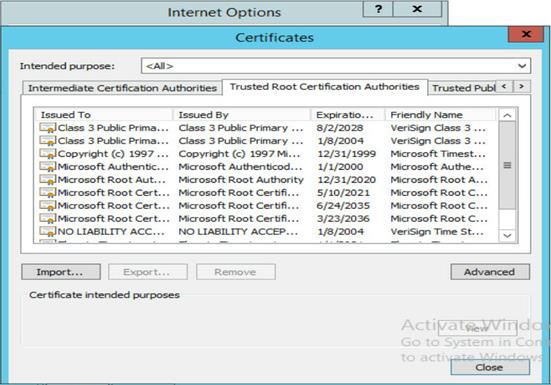
Generate an SSL certificate
Prerequisites
To generate an SSL certificate, you must have the administrator role.
Procedure
1. In the navigation pane, select Security > SSL Certificate.
2. In the work pane, click the Generate certificate tab.
3. Configure the certificate parameters, as shown in Figure 97.
Figure 97 Configuring an SSL certificate
4. Click Generate.
5. In the confirmation dialog box that opens, click OK.
If the certificate is generated, you receive a success result message.
The HDM server will use the new SSL certificate for authentication during subsequent sign-ins.
Parameters
· Common name (CN): Full domain name of the HDM server, a string of 1 to 64 characters. Only letters, digits, spaces, underscores (_), hyphens (-), and dots (.) are allowed. The common name cannot be a digits-only string.
· Organization (O): Name of the organization that owns the HDM server, a string of 1 to 64 characters. Only letters, digits, spaces, underscores (_), hyphens (-), and dots (.) are allowed. The organization name cannot be a digits-only string.
· Organizational Unit (OU): Name of the unit that owns the HDM server in the organization, a string of 1 to 64 characters. Only letters, digits, spaces, underscores (_), hyphens (-), and dots (.) are allowed. The organizational unit name cannot be a digits-only string.
· Locality (L): City or county where the HDM server resides, a string of 1 to 128 characters. Only letters, digits, spaces, underscores (_), hyphens (-), and dots (.) are allowed. The locality name cannot be a digits-only string.
· State or province (ST): State or province where the HDM server resides, a string of 1 to 128 characters. Only letters, digits, spaces, underscores (_), hyphens (-), and dots (.) are allowed. The state or province name cannot be a digits-only string.
· Country (C): Country or region where the HDM server resides. The country/region is represented as a two-letter code.
· Email address: Email address at which the HDM server owner can be contacted.
· Validity period: Validity period of the SSL certificate, in the range of 1 to 5475 days.
· Key length: Key length of the certificate.
View SSL certificate
Procedure
1. In the navigation pane, select Security > SSL Certificate.
2. In the work pane, click the View certificate tab.
3. View information about the current SSL certificate, as shown in Figure 98.
Figure 98 Viewing information about the current SSL certificate
Parameters
· Basic information: Basic information about the current SSL certificate.
¡ Version—Version number of the certificate.
¡ Serial number—Serial number of the certificate. This number is assigned by the certification authority (CA).
¡ Signature algorithm—Signature algorithm of the certificate.
¡ Public key—Public key information of the certificate.
· Issued by: Certification authority that issued the certificate.
· Validity: Validity period of the certificate.
¡ Issued at—First valid day of the certificate.
¡ Expires at—Expiration day of the certificate.
· Issued to: Entity to whom the certificate is issued.
Remote control
Use remote control to operate and manage the server remotely.
Remote console
You can configure and manage the server from a remote console, including:
· Access the BIOS and operating system of the server to configure the server.
· Power on or shut down the operating system of the server.
· Capture screenshots of the remote console.
· Record videos on the remote console and save the videos locally on the PC.
· Mount virtual media to install operating systems or transfer files.
HDM supports a maximum of four remote control sessions. If you establish the first session, you are the primary user. All subsequent remote console users are secondary users and must obtain access permissions from the primary user.
HDM supports KVM, H5 KVM, and VNC remote consoles.
Restrictions and guidelines
To use KVM, you must first set up the operating system environment. The environment setup configuration varies by OS type.
To use the VNC remote console, you must first install the VNC client. H5 KVM requires no client.
Launch a KVM or H5 KVM remote console
Restrictions and guidelines
Follow these restrictions and guidelines when you use a remote console:
· Do not use KVM and H5 KVM at the same time or start the remote console in multiple browsers on one PC.
· For security purposes, grant full permission to a trustworthy secondary user when you close the remote console session as the primary user.
Prerequisites
Before you can launch a remote control console, you must perform the following tasks:
· Make sure the KVM and Web services have been enabled for your user account from the Security > Services page. If KVM is not enabled, contact the administrator.
· To launch the KVM console, make sure your user account has the KVM extended privilege. To launch the H5 KVM console, make sure your account has the Web and KVM extended privileges. If you do not have the Web or KVM privilege, contact the administrator.
Procedure
1. In the navigation pane, select Remote Control > Remote Console, as shown in Figure 99.
Figure 99 Entering remote console page
2. In the KVM or H5 KVM section, click a launch mode:
¡ For KVM, options include Dedicated mode and Shared mode. The two modes are unencrypted modes.
¡ For H5 KVM, options include Encrypted dedicated mode, Unencrypted dedicated mode, Encrypted shared mode, and Unencrypted shared mode.
Encrypted modes transmit encrypted data and provide better security performance. Unencrypted modes transmit unencrypted data and provide higher transmission speed.
The dedicated modes are available only for HDM-1.30.08 or later.
The unencrypted modes are available only for HDM-1.30.09 or later.
The remote console sign-in page opens.
Figure 100 Remote console sign-in page (H5 KVM)
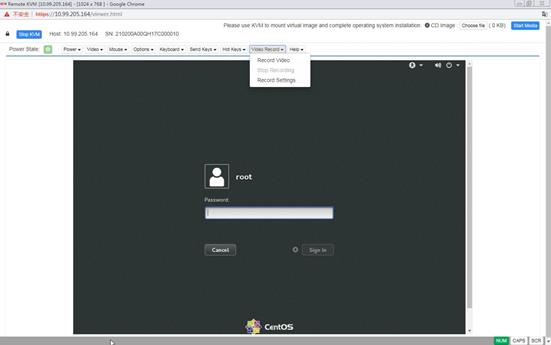
3. For a shared mode, wait for the access authorization from the primary user if you are not the first access user, as shown in Figure 101.
Figure 101 Waiting for remote console access authorization
If you are the primary user, you might need to grant access permissions to other users, as shown in Figure 102.
Figure 102 Authorizing remote console access
Parameters
· Dedicated mode: Includes Encrypted dedicated mode and Unencrypted dedicated mode. A dedicated mode allows for only one remote console session and grants the user with the full access permission. You can launch the remote console successfully in dedicated mode only if no other user is using the remote console.
· Shared mode: Includes Encrypted shared mode and Unencrypted shared mode. A shared mode allows for a primary session and multiple secondary sessions. If you are the first access user, the system assigns you with the full access permission. If you are a secondary user, the granted permission is decided by the primary user.
¡ If you are granted full access permission, you can display information and configure the server. In this situation, the primary user will have read-only access.
¡ If you are granted read-only permission, you can only view videos and screenshots, and record videos. You cannot perform any configuration tasks.
¡ If you are denied access, the KVM window closes.
¡ If the primary user does not respond in 30 seconds, you are granted read-only permission.
Operate the server from KVM
Prerequisites
1. Launch a KVM remote console.
2. To perform any server tasks except for viewing videos and screenshots and recording videos, make sure you have full permission.
Start up or shut down the server
|
WARNING! The Force Power-Off and Graceful Power-Off options only put the server in standby mode by removing power from most circuits. To maintain the server with all power removed, you must remove all power cords from the server. |
1. Select the Power menu from the top menu bar.
2. Select a menu option as needed.
|
Power menu option |
Purpose |
|
Force System Reset |
Warm reboots the server without power cycling the server. |
|
Force Power-Off |
Shuts down the server immediately by force. This action is equivalent to pressing the power button on the server for five seconds to put the server in standby mode. |
|
Graceful Power-Off |
Shuts down the operating system first, and then removes power from the server to put it in standby mode. |
|
Power On |
Starts up the server. |
|
Force Power-Cycle |
Powers off and then powers on the server. |
3. Use the power icon in the lower right corner of the console to verify the power state of the server.
¡ If
the server is up, the icon is in green (![]() ).
).
¡ If
the server is down, the icon is in red (![]() ).
).
Capture the screen
1. Select Options > Capture Screen from the top menu bar.
2. In the dialog box that opens, select the screenshot file storage path, enter the file name, and then click Save, as shown in Figure 103.
Figure 103 Capturing the screen
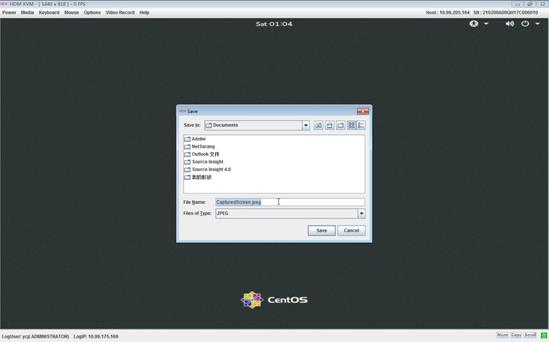
Record a video
1. Select Video Record > Settings from the top menu bar.
2. Set the video recording parameters, as shown in Figure 104:
¡ Video Length—Enter the maximum time length of the video. The value range is 1 to 1800 seconds.
¡ Video to be Saved—Click Browse to select the video file storage path.
¡ Normalized video resolution to 1024 × 768—To use the 1024 × 768 resolution, select this option. If you do not select this resolution, the screen resolution of the server monitor is used.
Figure 104 Setting video recording parameters
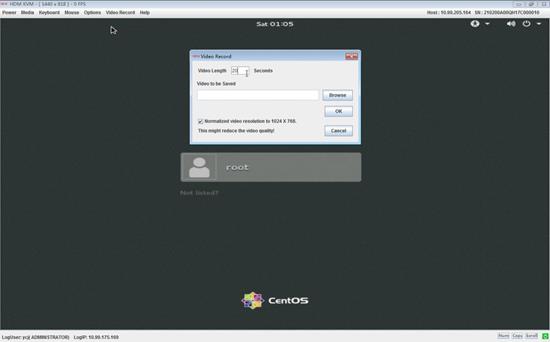
3. Select Video Record > Start Record to start video recording, as shown in Figure 105.
4. Select Video Record > Stop Record to stop video recording, as shown in Figure 105.
Figure 105 Starting or stopping video recording
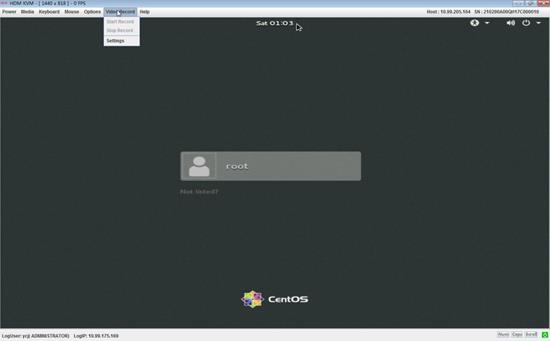
Mount virtual storage media
1. Select Media > Virtual Media Wizard from the top menu bar.
2. Mount a virtual storage medium, as shown in Figure 106:
¡ To mount a virtual CD/DVD, click the CD/DVD tab, click Browse next to a CD Image field to select a CD/DVD file or CD/DVD drive of the local PC, and then click Connect.
¡ To mount a virtual floppy disk, click the Floppy tab, click Browse next to the Floppy Image field, select a floppy disk file from the local PC, and then click Connect.
¡ To mount a virtual hard disk drive or USB, click the Hard disk/USB tab, and perform one of the following tasks:
- If the image already exists in the hard drive or USB, select HD/USB Image, click Browse next to the HD/USB Image field, select a disk file or USB device of the local PC, and then click Connect.
- If the image does not exist in the hard drive or USB but the files to be mounted exist in the local PC, select Folder Path, click Browse next to the Folder Path field to select the folder from the local PC. Then, click Browse next to the Image Path field to select a path from the hard drive or USB for saving the image generated by using the selected folder, and then click Connect.
Make sure the folder is not larger than 600 M, and the path for saving the image is different from the path for saving the folder.
Figure 106 Mounting a virtual storage medium
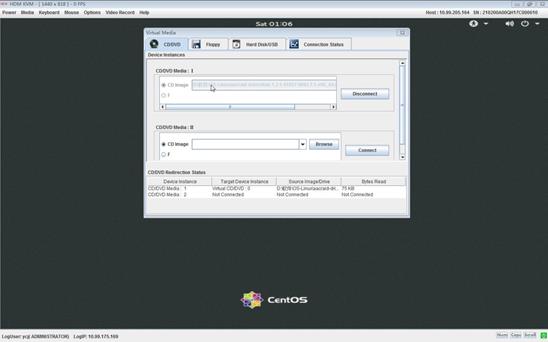
3. To unmount a virtual storage medium, access the tab appropriate to the type of that medium, and click Disconnect.
Quit the remote console
To quit the remote console and disconnect from HDM, use one of the following methods:
· Click the close button ![]() of the
remote console window.
of the
remote console window.
· As the best practice to quit the H5 KVM remote console, click Stop KVM in the upper left corner of the remote console.
· If no virtual storage media have been mounted
from the remote console, you can also click the Sign out
button ![]() on the HDM Web interface.
on the HDM Web interface.
Block full permission requests
If you are the primary user (the user that established the first console session), you might receive full permission requests from remote console users who have only read-permission.
To block full permission requests, select Options > Block Privilege Request from the top menu bar.
Configure boot options for the next boot
To configure the boot option and boot mode for the server to use at the next reboot, select Options > Boot Options from the top menu bar. For more information, see "Boot options."
Access the server
You can use the keyboard, mouse, and monitor of the local PC to access the server.
Change the language in the KVM console
1. Select Options > GUI Languages from the top menu bar.
2. Change the language to Chinese or English.
Configure the peripherals in the KVM console
· To configure keyboard settings, select the Keyboard menu from the top menu bar, and then select the desired menu option.
|
Keyboard menu option |
Task |
|
Ctrl+Alt+Del |
Perform an action equivalent to pressing the Ctrl, Alt, and Delete keys simultaneously on the keyboard. |
|
Hot Keys |
Define and use hot keys. You can define a maximum of 20 hot keys, each being a combination of up to six keys. |
|
SoftKeyboard |
Open the soft keyboard. Only American English soft keyboard is supported. |
· To configure the mouse settings, select the Mouse menu from the top menu bar, and then select the desired menu option.
|
Mouse menu option |
Task |
|
Show Cursor |
· Select this option to display mouse pointer trails. · Clear this option to hide mouse pointer trails. |
|
Mouse Calibration |
Calibrates the mouse location in relative mouse mode. |
|
Mouse Mode |
The mouse mode is used to calculate the current location of the mouse. Options include: · Absolute mouse mode—Calculates the mouse location according to the screen's absolute coordinates. · Relative mouse mode—Calculates the mouse location according to the offset of the mouse movement. · Other mouse mode—Calculates the mouse location according to the distance from the mouse to the screen center. Mouse mode recommendations for server operating systems: · Use absolute mouse mode in CentOS 6.5, CentOS 7.1, Redhat 6.5, Redhat 7.0, SLES 11, SLES 13, Ubuntu 12.04, Ubuntu 15.04, Windows 2008, and Windows 2012. · Use relative mouse mode for CentOS 6, Fedora 14, Redhat 6, or their lower versions. · Use other mouse mode in SLES 11 installation interface. · Use absolute mouse mode in any operating systems that are not mentioned above. · As a best practice, do not change the mouse mode frequently. · The Show Cursor feature will be enabled automatically if you change the mouse mode from relative or other to absolute. |
Obtain version and copyright information
To obtain version and copyright right information, select Help > About HDM KVM from the top menu bar.
Operate the server from H5 KVM
Prerequisites
1. Launch an H5 KVM remote console.
2. To perform any server tasks except viewing videos and screenshots and recording videos, make sure you have full permission.
Start up or shut down the server
|
WARNING! The Force Power Off and Graceful Power Off options only put the server in standby mode by removing power from most circuits. To maintain the server with all power removed, you must remove all power cords from the server. |
1. Select the Power menu from the top menu bar.
2. Select a menu option as needed.
|
Power menu option |
Purpose |
|
Immediate Reset |
Warm reboots the server without power cycling the server. |
|
Force Power Off |
Shuts down the server immediately by force. This action is equivalent to pressing the power button on the server for five seconds to put the server in standby mode. |
|
Graceful Power Off |
Shuts down the operating system first, and then removes power from the server to put it in standby mode. |
|
Power On |
Starts up the server. |
|
Power Cycle |
Powers off and then powers on the server. |
3. Use the power icon in the upper left corner of the console to verify the power state of the server.
¡ If
the server is up, the icon is in green (![]() ).
).
¡ If
the server is down, the icon is in red (![]() ).
).
Capture the screen
Select Video > Capture Screen from the top menu bar, as shown in Figure 107.
Figure 107 Capturing the screen
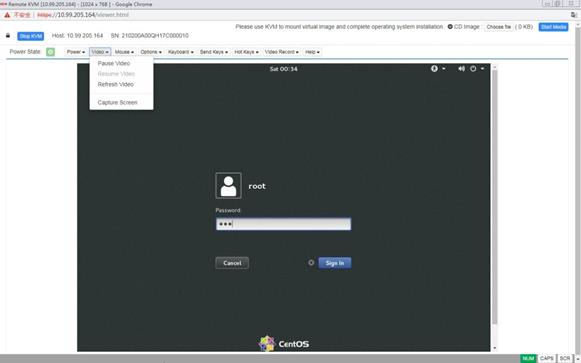
Record a video
1. Select Video Record > Record Settings from the top menu bar.
2. Set the video recording parameters, as shown in Figure 108:
¡ Video Length—Enter the maximum time length of the video. The value range is 1 to 1800 seconds.
¡ Video Compression—Set the view compression ratio. The value range is 0.1 to 1.0.
¡ Normalized video resolution to 1024 × 768—To use the 1024 × 768 resolution, select this option. If you do not select this resolution, the screen resolution of the server monitor is used.
Figure 108 Setting video recording parameters
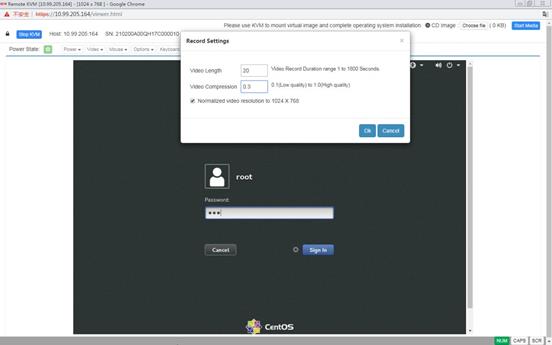
3. Select Video Record > Record Video to start video recording, as shown in Figure 109.
4. Select Video Record > Stop Record to stop video recording, as shown in Figure 109.
Figure 109 Starting or stopping video recording
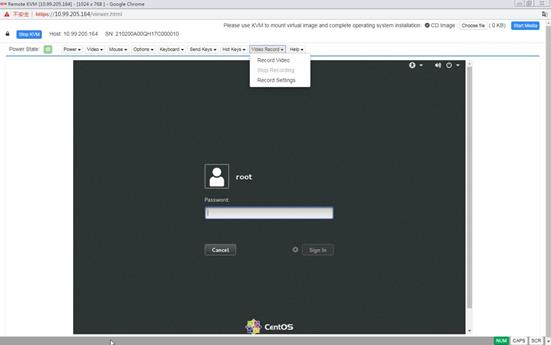
Mount virtual media
H5 KVM only supports mounting an .iso image.
1. Click Browse File in the upper right corner of the remote console.
2. Select an .iso image file.
3. Click Start Media.
To unmount the virtual media, click Stop Media.
Use keyboard buttons
The remote console provides the following keyboard buttons at the bottom right:
· NUM—Perform an action equivalent to pressing the Num key on the keyboard.
· CAPS—Perform an action equivalent to pressing the Caps key on the keyboard.
· SCR—Perform an action equivalent to pressing the Scroll key on the keyboard.
Quit the remote console
To quit the remote console and disconnect from HDM, use one of the following methods:
· Click the close button ![]() of the
remote console window.
of the
remote console window.
· As the best practice to quit the H5 KVM remote console, click Stop KVM in the upper left corner of the remote console.
· If no virtual storage media have been mounted
from the remote console, you can also click the Sign out
button ![]() on the HDM Web interface.
on the HDM Web interface.
Block full permission requests
If you are the primary user (the user that established the first console session), you might receive full permission requests from remote console users who have only read-permission.
To block full permission requests, select Options > Block Privilege Request from the top menu bar.
Configure boot options for the next boot
To configure the boot option and boot mode for the server to use at the next reboot, select Options > Boot Options from the top menu bar. For more information, see "Boot options."
Change the language in the H5 KVM console
1. Select Options > GUI Languages from the top menu bar.
2. Change the language to Chinese or English.
Access the server
You can use the keyboard, mouse, and monitor of the local PC to access the server.
Play a video
1. Select the Video menu from the top menu bar.
2. Select a menu option as needed:
¡ To pause the video while it is playing, select Pause Video.
¡ To resume video playing, select Resume Redirection.
¡ To refresh the video displayed on the remote console, select Refresh Video.
Configure the peripherals in the H5 KVM console
· To configure keyboard settings, select the Keyboard menu from the top menu bar, and then select the desired menu option.
|
Keyboard menu option |
Task |
|
English U.S |
Use the U.S. English keyboard layout. |
· To perform Send Keys operations, select the Send Keys menu from the top menu bar, and then select the desired menu option.
|
Send Keys menu option |
Description |
|
Hold Down section |
|
|
Right Ctrl Key |
Perform an action equivalent to pressing the right Ctrl key on the keyboard. |
|
Right Alt Key |
Perform an action equivalent to pressing the right Alt key on the keyboard. |
|
Right Windows Key |
Perform an action equivalent to pressing the right Windows key on the keyboard. |
|
Left Ctrl Key |
Perform an action equivalent to pressing the left Ctrl key on the keyboard. |
|
Left Alt Key |
Perform an action equivalent to pressing the left Alt key on the keyboard. |
|
Left Windows Key |
Perform an action equivalent to pressing the left Windows key on the keyboard. |
|
Press and Release section |
|
|
Ctrl+Alt+Del |
Perform an action equivalent to pressing and releasing the Ctrl, Alt, and Delete keys simultaneously on the keyboard. |
|
Left Windows Key |
Perform an action equivalent to pressing and releasing the left Windows key on the keyboard. |
|
Right Windows Key |
Perform an action equivalent to pressing and releasing the right Windows key on the keyboard. |
|
Context Menu Key |
Perform an action equivalent to pressing and releasing the context menu key on the keyboard. |
|
Print Screen Key |
Perform an action equivalent to pressing and releasing the PrScrn key on the keyboard. |
· To define and use hot keys, select the Hot Keys menu from the top menu bar, and then select Add Hot Keys.
· To configure the mouse settings, select the Mouse menu from the top menu bar, and then select the desired menu option.
|
Mouse menu option |
Task |
|
Show Client Cursor |
· Select this option to display mouse pointer trails. · Clear this option to hide mouse pointer trails. |
|
Mouse Mode |
The mouse mode is used to calculate the current location of the mouse. Options include: · Absolute Mouse Mode—Calculates the mouse location according to the screen's absolute coordinates. · Other Mouse Mode—Calculates the mouse location according to the distance from the mouse to the screen center. As a best practice, use KVM if you are using one of the following operating systems, with which the absolute mouse mode does not work well: · CentOS 6, Fedora 14, Redhat 6, or their lower versions. · SLES 11 installation interface. · As a best practice, do not change the mouse mode frequently. · The Show Client Cursor feature will be enabled automatically if you change the mouse mode from other to absolute. |
Obtain version and copyright information
To obtain version and copyright right information, select Help > About H5Viewer from the top menu bar.
Operate the server from VNC
This feature is available only for HDM-1.12.05 or later.
About VNC
VNC is a technology for remote desktop sharing. In a VNC system, the client can connect to the server and control the remote desktop of the server by using the Remote Frame Buffer (RFB) protocol. RFB is a simple protocol used for remote access to graphical user interfaces. It works at the framebuffer level and is applicable to all windowing systems and applications such as Windows and Mac. VNC allows you to access and manage the server from a local PC without logging to HDM.
HDM supports both IPv4 and IPv6 VNC sessions. The following session modes are available:
· Shared mode—Supports a maximum of two concurrent VNC sessions. Both of the sessions have access to the mouse and keyboard and have the control of the server's OS.
· Exclusive mode—Supports only one VNC session.
The session mode used in a VNC system is determined by the VNC client.
Prerequisites
Before you use VNC to operate the server, you must complete the following tasks:
· Log in to HDM, and enable the VNC service on the Security > Services page.
· Install a VNC client (UltraVNC or TightVNC). This example uses TightVNC.
Procedure
1. Open the VNC client, enter the HDM management IP address in the address bar, and click Connect, as shown in Figure 110.
Figure 110 Entering the login page
2. In the window that opens, enter the VNC password (the default is root), and then click OK, as shown in Figure 111.
Figure 111 Authenticating to VNC server
A VNC session is established between the VNC client and VNC server. The VNC client displays the server screen.
You can view the established VNC session from the Security > Services page of HDM. The IP address for the VNC session is the IP address of the VNC client.
Figure 112 VNC session information
3. Operate the server as needed.
Configure VNC
This feature is available only for HDM-1.12.06 or later.
Use this feature to configure the settings of passwords for VNC client login. By default, the password is root.
Procedure
1. In the navigation pane, select Remote Control > Remote Console.
2. In the work pane, click the VNC tab, as shown in Figure 113.
3. (Optional.) Select Enable for Complexity check.
4. Enter a new password and confirm the new password.
5. Click Save.
Parameters
Complexity check: Disable or enable password complexity check.
· If this feature is disabled, passwords must meet the following basic complexity requirements:
¡ 1 to 8 characters in length.
¡ Case sensitive. Valid characters are letters, digits, spaces, and the following special characters: ` ~ ! @ # $ % ^ & * ( ) _ + - = [ ] \ { } | ; ' : " , . / < > ?
· If this feature is enabled, passwords must meet the following enhanced complexity requirements:
¡ 8 characters in length.
¡ Case sensitive. Valid characters are the same as those supported when complexity check is disabled.
¡ Must contain characters from at least two of the following categories: uppercase letters, lowercase letters, and digits.
¡ Must contain at least one space or special character.
Set the UID LED
The unique identification (UID) LED helps identify the server you are operating.
Turn on or turn off the UID LED of the server
Procedure
1. In the navigation pane, select Remote Control > Set the UID LED.
2. Click On to turn on the UID LED, or click Off to turn off the UID LED, as shown in Figure 114.
Figure 114 Turning on or turn off the UID LED
Parameters
UID LED status: UID LED status of the current server.
· On—The UID LED of the server is steady blue.
· Flashing—The UID LED of the server is flashing blue. The server is upgrading its firmware, or its remote console has been opened.
· Off—The UID LED of the server is off.
Remarks
When the UID LED is steady blue or flashing blue, you cannot turn on or turn off the LED.
Boot options
The boot options specify one-time boot mode and boot device settings for the server to use at the next reboot.
Configure boot options for the next reboot
Prerequisites
Verify that the hard disk drive supports legacy mode if you are configuring the server to boot from a hard disk drive in legacy mode.
Procedure
1. In the navigation pane, select Remote Control > Boot Options, as shown in Figure 115.
2. Select a validity period for the next boot mode and option.
¡ To have the settings take effect only for the next reboot, select One time.
¡ To have the settings take effect for all subsequent reboots, select Permanent.
This feature is not available for the AE100, B5700, B5800, and B7800.
3. In the work pane, select a next boot mode.
¡ To boot to a UEFI compatible operating system, select UEFI.
¡ To boot to a traditional operating system in Legacy BIOS compatibility mode, select Legacy BIOS.
The legacy mode is not supported by the AE100.
4. Select the boot device for the next reboot from the Next boot option list. The BIOS option is not available if the validity period is Permanent.
To use the BIOS settings at the next reboot, select No override.
5. Click Save.
Figure 115 Configuring boot options for the next reboot
Parameters
· Next boot mode: Selects the boot mode for the next startup.
· Next boot option: Selects the boot device for the next startup.
· Current boot mode: Displays the boot mode for the most recent startup.
· Current first boot option: Displays the first boot device for the most recent startup.
SOL connection
This feature is available only for HDM-1.30.09 or later.
Perform this task to select the serial port to connect to when the SOL feature is enabled.
Prerequisites
Before setting the SOL connection mode, make sure the SOL feature is disabled.
Procedure
1. In the navigation pane, select Remote Control > SOL Connection.
2. In the work pane, select a serial port from the SOL connection mode field.
3. Click Save.
Figure 116 Setting the SOL connection mode
Parameters
· BIOS: Connects to the BIOS serial port.
· RAID: Connects to the serial port of the mezzanine storage controller.
· Smart Ethernet adapter: Connects to the serial port of the smart Ethernet adapter. Only some smart Ethernet adapters support serial port connection.
Remote media mounting
Image mounting mounts image files from a remote device to the operating system of the server. With this feature, you do not need to copy image files to the server before you can mount them.
You can mount virtual media by using the remote console (see "Remote console") or the image mounting feature. The following describes how to use image mounting to mount remote media images files.
Mount remote media
Perform this task to mount remote media to the server's operating system.
Prerequisites
Before you configure remote media image mounting, perform the following tasks:
1. Verify that the image files to be mounted are in correct format.
A CD/DVD image file must use the .iso extension, and a disk image file (for example, floppy disk, HDD or SSD) must use the .img or .ima extension.
A floppy disk image file cannot exceed 1.44 MB.
2. Make sure your user account has the VMedia extended privilege. If you do not have the VMedia privilege, contact the administrator.
3. Make sure the desired virtual media services have been enabled for your user account. If they are not enabled, contact the administrator. You can use CD-Media and HD-Media to mount two image files and use FD-Media to mount only one media.
Procedure
1. Set up the image mounting environment. For more information, see "Mount servers to HDM."
2. In the navigation pane, select Remote Control > Remote Media Mounting, as shown in Figure 117.
Figure 117 Accessing the remote media mounting page
3. In the work pane, click Settings.
4. In the dialog box that opens, enable remote media, select media types, and then click OK, as shown in Figure 118.
¡ If you select NFS as the shared file system, you must enter the server address and source path.
¡ If you select CIFS (Samba) as the shared file system, you must enter the server address, source path, username, password, and optionally, the domain name.
As a best practice to avoid image mounting failure, do not enter unnecessary special characters, such as pound signs (#).
|
IMPORTANT: If remote media mounting has already been enabled, the media settings cannot be modified unless you stop all remote media mountings. |
Figure 118 Configuring media mounting settings
5. In the navigation pane, select Remote Control > Remote Media Mounting.
6. Select an image file from the remote media list, and then click Start.
If you want to unmount the image file, click Stop.
Figure 119 Starting or stopping remote media mounting
Parameters
· Media type: Type of the remote media, including CD/DVD, floppy, and disk (which includes both HDD and SSD).
· Status: Remote media mounting status, including Started and Not started. Common reasons for the Not started status include the following:
¡ Opening error—The image file is invalid.
¡ Connection in use—The maximum number of mounting sessions has reached.
¡ Connection lost—The virtual media service has failed.
¡ Access error—The virtual media service is not enabled.
· Session index: Index of the remote media mounting session.
Disable remote media
1. In the navigation pane, select Remote Control > Remote Media Mounting.
2. In the work pane, click Settings.
3. In the dialog box that opens, select Disable for the remote media, and then click OK, as shown in Figure 118.
Manage power and power consumption
Use the Power & Thermal menu to control the power status of the server, debug software lock-up issues, and meter power for power reliability and energy efficiency.
Power control
Use power control features to view and change the server's power status remotely and debug software lock-up issues by using the non-maskable interrupt (NMI) debug feature.
View the power status of the server
1. In the navigation pane, select Power & Thermal > Power Control.
2. In the work pane, view the server power status in the Power status field, as shown in Figure 120.
Figure 120 Viewing the power status of the server
Change the power status of the server
|
CAUTION: The force power-off, force system reset, and force power-cycle actions might cause corruption or loss of data. When you perform these actions, make sure you fully understand their impact on the services. |
1. In the navigation pane, select Power & Thermal > Power Control.
2. In the Power status section of the work pane, select the desired action, as shown in Figure 120:
¡ To start up the server, select Power on.
¡ To power off the server gracefully, select Graceful power-off.
¡ To force a server power-off, select Force power-off.
¡ To reset the server, select Force system reset.
¡ To power cycle the server, select Force power-cycle.
3. Click Execute.
Enable NMI debug
This feature enables the operating system debugger to help you debug software lock-up issues by generating non-maskable interrupts.
Restrictions and guidelines
The NMI debug feature is intended for debugging only. Do not use this feature if the server is operating correctly.
Prerequisites
Verify that the operating system can handle NMIs. If the operating system cannot handle NMIs, using NMI debug might cause the operating system to crash.
Procedure
1. In the navigation pane, select Power & Thermal > Power Control.
2. In the NMI debug section of the work pane, click Execute, as shown in Figure 121.
Set the MCA policy
Machine Check Architecture (MCA) is an Intel mechanism that enables error reporting and error recovery. Perform this task to configure whether to restart the server automatically when an unrecoverable IERR error occurs.
Restrictions and guidelines
This feature is available only for HDM-1.30.08 or later.
This feature is not available for the R4950.
The MCA policy does not affect the OS restart policy.
Procedure
1. In the navigation pane, select Power & Thermal > Power Control.
2. In the MCA policy section of the work pane, select Yes or No from the Restart upon IERR error occurrence field, as shown in Figure 120.
3. Click Save.
Power profile
Use the power profile to manage power module settings, including power module redundancy, power capping, and automatic power-on.
View summary of the power supplies
1. In the navigation pane, select Power & Thermal > Power Profile.
2. In the work pane, click the Summary tab and view summary of the power supplies in the Summary section.
¡ Total power on the server.
¡ Summary of the power supplies, including their presence status, models, serial numbers, maximum power, and primary/backup mode.
Figure 122 Viewing the summary of the power supplies
View the total power of the server
|
|
NOTE: This feature is not available for the AE100, B5700, B5800, or B7800. |
1. In the navigation pane, select Power & Thermal > Power Profile.
2. In the work pane, click the Summary tab and view the total power on the server from the Current total power field.
Figure 123 Viewing total power on the server
Configure global power settings
This feature is available only for HDM-1.30.09 or later.
This feature is not available for the AE100, B5700, B5800, or B7800.
Perform this task to enable the Total_Power sensor to generate an alarm when the global power consumption reaches the specified threshold.
Procedure
1. In the navigation pane, select Power & Thermal > Power Profile.
2. In the work pane, click the Summary tab.
3. Select ON form the Power alarm field.
4. Enter the alarm threshold.
5. Click Save.
Figure 124 Configuring global power settings
View power capping information
|
|
NOTE: This feature is not available for the AE100, B5700, B5800, or B7800. |
1. In the navigation pane, select Power & Thermal > Power Profile.
2. In the work pane, click the Summary tab and view power capping information from the Power information section.
Figure 125 Viewing power capping information
Enable power capping
This feature is not available for the AE100, B5700, B5800, or B7800.
This feature is available for the R4950 only in HDM-1.12.05 or later.
Perform this task to limit the power consumption of the server to a power cap value that is lower or equal to the maximum rated power of the server.
When the power cap value is exceeded, the server attempts to decrease power consumption by automatically decreasing the operating frequency of system components such as processors. Power capping fails if the power consumption cannot drop below the power cap value in 30 seconds.
You can configure the server to shut down or continue to run on power capping failure.
Procedure
1. In the navigation pane, select Power & Thermal > Power Profile.
2. In the work pane, click the Power regulator tab, as shown in Figure 126.
3. Select ON for Power capping to enable power capping.
4. Set the power cap value.
Power capping is at the expense of system performance. Select the power cap value carefully to avoid undesirable decrease in performance, especially when the server contains power intensive components, such as GPUs and SSDs.
5. (Optional.) Set the action to take on a power capping failure:
¡ To have the server continue to run, select No for Shutdown on capping failure.
¡ To have the server shut down, select Yes for Shutdown on capping failure.
6. Click Save.
Figure 126 Configuring power capping
Manage redundant power supplies
About redundant power supplies
The server supports N + N power supply redundancy. You can place a minimum of one power supply in active state and place the remaining power supplies in standby state. Power is supplied mainly by the active power supplies. If more than one power supply is in active state, these active power supplies provide power in a balanced way.
The system has a predefined power supply redundancy mode. Users can change the default redundancy mode to place the specified power supplies in active state. The user-defined redundancy mode takes effect after the server is powered on. If the system fails to initiate the user-defined mode, the predefined mode is used.
The standby power supplies automatically become active in the following cases:
· An active power fails.
· The power consumption of the active power supplies exceeds 62% of their rated output power. The system will not attempt to restore the previous power supply state after the power consumption drops below 62% of the rated output power.
If an active power supply is hot swapped, the user-defined mode is restored. If the system fails to restore the user-defined mode, the predefined mode is used.
The power supplies operate in active mode when the server is powered off with the power cord connected.
Restrictions and guidelines
This feature is not available for the AE100, B5700, B5800, or B7800.
The server must have a minimum of one active power supply. If the server has only one active power supply, the Set as standby option for the active power supply is unavailable. To place the active power supply in standby state, you must first place a current standby power supply in active state.
Procedure
1. In the navigation pane, select Power & Thermal > Power Profile.
2. In the work pane, click the Power redundancy tab.
Information about the power supplies is displayed, as shown in Figure 127. A field displays N/A if no value can be obtained.
3. Manage the power supplies, as shown in Figure 127:
¡ To ensure power performance, verify that the power supplies on the server are the same model and are not from a third-party vendor.
¡ To place a power supply in active state, click Set as active.
¡ To place a power supply in standby state, click Set as standby.
Figure 127 Managing power redundancy
Parameters
Power input mode
· No input: The server is not connected to the power source.
· AC: The server is connected to an AC power source.
· HVDC: The server is connected to a high-voltage DC power source. The voltage is in the range of 192 V to 400 V.
· LVDC: The server is connected to a low-voltage DC power source. The voltage is in the range of 12 V to 72 V.
Configure automatic power-on
This feature is not available for the AE100, B5700, B5800, or B7800.
Perform this task to configure the power-on policy of the server when the server is connected to the power source.
Procedure
1. In the navigation pane, select Power & Thermal > Power Profile.
2. In the work pane, click the System power restore tab, as shown in Figure 128.
3. Select the power-on policy and set the power-on delay:
¡ Power-on policy—Select whether to start the server when the server is connected to the power source. Options are Always power on, Always remain off, and Restore last power state.
- To have the server always automatically start up when it is connected to the power source, select Always power on.
- To have the server stay off when it is connected to the power source, select Always remain off.
- To have the server return to the power state on the previous power-off, select Restore last power state.
¡ Power-on delay—Set the power-on delay time. Options are No delay, 15 seconds, 30 seconds, 45 seconds, 60 seconds, and Random (max. 120 seconds).
4. Click Save.
Figure 128 Configuring automatic power-on
Set the operating mode of power supplies
This feature is not available for the AE100, B5700, B5800, B7800, or R4950.
Perform this task to set the operating mode of power supplies.
Restrictions and guidelines
Before performing this task, select Socket Configuration > Advanced Power Management Configuration > CPU Advanced PM Tuning > Energy Perf BIAS from the BIOS and set the value of the Power Performance Tuning field to BIOS Controls EPB. For more information, see the BIOS user guide for the server.
Procedure
1. In the navigation pane, select Power & Thermal > Power Profile.
2. In the work pane, click the Operating mode tab.
3. Select an operating mode from the Power supply operating mode field, as shown in Figure 129. Options include:
¡ Performance—Indicates the performance first mode.
¡ Balanced Performance.
¡ Balanced Power.
¡ Power—Indicates the power saving mode.
Figure 129 Selecting an operating mode
4. Click Save.
5. Restart the server for the configuration to take effect. For more information about restarting the server, see "Power control."
Power consumption history
This feature is not available for the AE100, B5700, B5800, or B7800.
Use this feature to view the power consumption history statistics and chart for the server.
Restrictions and guidelines
HDM cannot obtain server power consumption statistics during restart.
Restoring the HDM factory defaults clears power consumption history statistics.
View the power consumption history statistics
1. In the navigation pane, select Power & Thermal > Power Consumption History.
2. In the work pane, view the history power consumption statistics in the History power consumption statistics section, as shown in Figure 130:
¡ Max power consumption updated in real time—By default, HDM displays the highest amount of power consumed in the time span from server startup to the present. To clear the history data and start a new real-time statistics period, click Restart. When you click this button, this field updates with the power at the current time.
¡ Real-time max value appeared at—Date and time at which the maximum power consumption appeared in the real-time statistics collection period.
¡ Start time of real-time statistics period—Start date and time of the real-time statistics collection period.
¡ Power consumption data for past 24 hours—Maximum, minimum, and average power consumption statistics for the past 24 hours.
¡ Power consumption data for past 7 days—Maximum, minimum, and average power consumption statistics for the past 7 days.
Figure 130 Viewing history power consumption statistics
View the power consumption history chart
Use this feature to view the 5-minute server power consumption statistics for the past 24 hours or seven days, including the maximum, average, and minimum power consumption.
To view the power consumption history chart:
1. In the navigation pane, select Power & Thermal > Power Consumption History.
2. In the work pane, hover over the lines in the power consumption history chart to view power statistics for a monitoring period, as shown in Figure 131.
To view only the maximum, average, or minimum power consumption, click the Max, Avg, or Min icon.
Figure 131 Viewing power consumption history chart
Processor power states
This feature is not available for the AE100, B5700, B5800, or B7800.
You can adjust the power consumption of processors by changing the processor power states.
Prerequisites
For the power states to take effect, set EIST (P-States) and Software Controlled T-State to Enabled, and Hardware P-States to Disabled on the Socket Configuration > Advanced Power Management Configuration screen from the BIOS. For more information, see the BIOS user guide for the server.
Procedure
1. In the navigation pane, select Power & Thermal > Processor Power States.
2. In the work pane, move the slider to select the preferred P-state or T-state value, as shown in Figure 132.
The available state values vary by processor model.
3. Click Save.
Figure 132 Configuring processor power states
Parameters
· P-State: Defines the operating frequency of processors. A smaller P-state value represents a higher operating frequency, which translates to higher performance and higher power consumption.
· T-State: Defines the duty cycle of processors. A smaller T-state value represents a higher duty cycle, which translates to higher performance and higher power consumption.
Fans
This feature is not available for the AE100, B5700, B5800, or B7800.
You can adjust the fan speed mode of the server to optimize its cooling, noise control, and energy efficiency performance.
Set the preferred fan speed mode
1. In the navigation pane, select Power & Thermal > Fans.
2. In the work pane, select a fan speed mode, as shown in Figure 133.
If you select Custom, move the slider to adjust the fan speed.
3. Click Save.
Figure 133 Setting the preferred fan speed mode
Parameters
· Optimal cooling: Enables the fans to run at the lowest speed required by heat dissipation of the server. This mode is suitable for scenarios with high noise requirements.
· Increased cooling: Enables the fans to run at a higher speed to provide balanced noise control and cooling performance.
· Maximum cooling: Enables the fans to run at the highest possible speed. This mode is suitable for scenarios where the server requires high cooling performance. For example, the server is busy and key components, such as processors, are heavily loaded, or the ambient temperature changes frequently.
Maintenance
Import and export configuration
Perform this task to import and export HDM, BIOS, or RAID configuration, and restore factory default HDM settings.
Restrictions and guidelines
The AE100 supports import and export only of HDM configuration.
To avoid HDM and operating system anomalies, do not power on or power off the server during the import process.
Do not refresh the webpage when configuration is being imported or the factory default is being restored. If you refresh the page, HDM might fail to be accessed.
If configuration import fails, troubleshoot the issue that leads to the failure as instructed and then import the configuration again.
Configuration import overwrites the existing configuration with the configuration in the imported file.
To avoid import failure, when you modify the configuration file, please be cautious and make sure the configurations are valid.
Support for configuration that can be imported or exported varies by device model.
Export HDM, BIOS, or RAID configuration
Restrictions and guidelines
Make sure the storage controller has been initialized before you export the RAID configuration.
Procedure
1. In the navigation pane, select Maintenance > Import/Export Config.
2. In the Export configuration section, select the target configuration type from the Select type field.
3. Click Export.
Figure 134 Exporting HDM, BIOS, or RAID configuration
Import HDM configuration
Restrictions and guidelines
Make sure the server model in the configuration file to import is consistent with the actual server model.
Make sure you have deleted all the comment statements in the configuration file before the import.
Make sure the user passwords are stored in plain text in the configuration file.
The import operation does not affect HDM configurations that are not covered by the configuration file to import.
After an HDM configuration import, HDM restarts automatically for the imported file to take effect.
Procedure
1. In the navigation pane, select Maintenance > Import/Export Config.
2. In the Import configuration section, select HDM from the Select type field.
3. Select the target configuration file, and then click Import.
4. In the confirmation dialog box that opens, click OK.
HDM restarts automatically after the import.
Import BIOS configuration
Restrictions and guidelines
Make sure the server model and hardware configuration (for example, storage controller and drive configuration) in the configuration file is consistent with the actual configuration.
Procedure
1. In the navigation pane, select Maintenance > Import/Export Config.
2. In the Import configuration section, select BIOS from the Select type field.
3. Select the target configuration file, and then click Import.
4. In the confirmation dialog box that opens, click OK.
5. Restart the server for the file to take effect after the import.
Import RAID configuration
Restrictions and guidelines
Make sure the server is powered on and the storage controller is in RAID mode before you import RAID configuration.
Make sure the server model and hardware configuration (for example, storage controller and drive configuration) in the configuration file is consistent with the actual configuration.
To avoid import failure, clear existing RAID configuration from the BIOS before you import RAID configuration.
After a RAID configuration import, it takes about 40 seconds for the imported file to take effect.
Procedure
1. In the navigation pane, select Maintenance > Import/Export Config.
2. In the Import configuration section, select RAID from the Select type field.
3. Select the target configuration file, and then click Import.
4. In the confirmation dialog box that opens, click OK.
Restore factory default HDM settings
|
CAUTION: After the factory default settings are restored, you can access HDM only with the default username and password. Please use this function with caution. |
Restrictions and guidelines
After the factory default restoration, HDM restarts automatically to load the default settings.
Procedure
1. In the navigation pane, select Maintenance > Import/Export Config.
2. In the Restore HDM factory default section, click Restore factory default.
3. In the confirmation dialog box that opens, click OK.
HDM restarts after the factory default is restored.
Update firmware
You can update the firmware of HDM, BIOS, CPLD, or power supplies. The supported firmware varies by server model. Use Table 15 to determine the firmware that can be updated from HDM for each server.
Table 15 Supported firmware types for each server model
|
Server model |
Firmware |
|
· AE100 · B5700 G3 · E3200 G3 · R2700 G3 · R2900 G3 · R4100 G3 · R4300 G3 · R4400 G3 · R4700 G3 |
HDM, BIOS, CPLD |
|
· B5800 G3 · R4900 G3 · R4950 G3 |
HDM, BIOS, CPLD, BPCPLD |
|
R5300 G3 |
HDM, BIOS, CPLD, power supplies |
|
R6700 G3 |
HDM, BIOS, CPLD, DBCPLD, STBCPLD |
|
R6900 G3 |
HDM, BIOS, CPLD, PDBCPLD, NDCPLD, BPCPLD |
|
R8900 G3 |
HDM, BIOS, CPLD, PDBCPLD, NDCPLD, PDBSCPLD |
|
B7800 G3 |
HDM, BIOS, CPLD, AUXCPLD |
Firmware update restrictions and guidelines
To ensure a successful firmware update, follow these restrictions and guidelines during the update:
· Do not power on, power off, or power cycle the server during the update. Doing so might result in HDM or operating system errors.
· Do not refresh the HDM webpage during the update unless you are instructed to do so. Doing so will reset the update process.
· Do not leave the webpage during the update.
Only one user can update firmware at a time. If multiple users attempt to update firmware, only the one who first started the update can perform this operation. When you successfully start a firmware update, HDM automatically signs out all other users that try to start a firmware update.
Firmware update might fail if the update image file does not contain a vendor signature or is corrupt. In this situation, obtain the desired firmware image file and try again.
For the firmware to be updated successfully, do not perform the following tasks from the Web interface during the update process:
· Change network settings, including dedicated and shared network ports, VLAN, network port mode, Ethernet adapter, DNS, and network port mode.
· Configure NTP settings.
· Configure security settings, including access service, firewall, and SSL.
· View the server power status or change power capping settings.
· Perform the following maintenance tasks:
¡ Import or export configuration.
¡ Restore the factory default.
¡ Restart HDM.
¡ Perform primary/backup switchover.
¡ Restart CPLD.
The following remote console menus are not available during the update:
· Keyboard menu in the KVM console.
· Send Keys and Hot Keys menus in the H5 KVM console.
For firmware update examples, see H3C Servers Firmware Update Guide.
Firmware update flowchart
Figure 135 Firmware update flowchart
Prerequisites for firmware update
Before a firmware update, perform the following tasks:
1. Obtain the up-to-date server firmware image. Make sure the image matches the firmware type.
2. To avoid the loss of configuration due to inadvertent mistakes, back up the configuration. You can export the HDM configuration for backup.
3. Make sure no user is updating firmware. You cannot update firmware if there is an ongoing firmware update.
Update HDM firmware
HDM supports one primary firmware image and one backup firmware image, and it always runs the primary image. HDM firmware update updates the backup firmware image.
To minimize the impact on HDM services, HDM uses the following method to update HDM firmware:
1. When you update HDM firmware, HDM replaces the backup firmware image with the uploaded update image.
2. At the restart after the update, HDM automatically changes the roles of primary and backup HDM images. Then, HDM restarts with the update image, which is now the primary image.
3. If you do not restart HDM after the update, you must manually perform a primary/backup switchover for HDM to run the updated image. For more information about primary/backup switchover, see "Switch over between primary and backup HDM firmware images."
Restrictions and guidelines
See "Firmware update restrictions and guidelines."
Prerequisites
See "Prerequisites for firmware update."
Procedure
1. In the navigation pane, select Maintenance > Update Firmware.
2. In the work pane, perform the following tasks, as shown in Figure 136:
a. Select an image upload method.
- If you select Local, select HDM as the firmware type. Then, browse to the update image file and select it.
- If you select TFTP, enter the IP address of the interface used for file upload and enter the image name. Then, select HDM as the firmware type. The image name must include the suffix and cannot exceed 45 characters in length.
b. Select the HDM restart method after the update is complete. You can have HDM automatically restart when the update is complete or manually restart HDM later.
c. (Optional.) To remove all user-configured settings after you update HDM firmware, select Enabled for Restore factory default.
d. Click Next.
|
CAUTION: The Restore factory default option removes all user configured settings when HDM starts up with the new firmware. When you select this option, make sure you understand its impact on the services. If this option is selected, you must use the default user account settings at the first sign-in to HDM after its firmware is updated. |
Figure 136 Updating HDM firmware
3. Verify that the new firmware image version is correct, and then click Next., as shown in Figure 137.
The firmware update starts and the system displays the update progress.
Figure 137 Verifying the new firmware image version
4. Follow the system instructions to complete the update.
5. If you selected manual restart, restart HDM. For more information, see "Restart HDM."
If you selected automatic restart, HDM restarts automatically.
6. (Optional.) Clear the browser cache, and then re-sign in to HDM.
Clearing the browser cache ensures the correct display of webpage contents after you re-sign in to HDM.
7. Verify the update:
a. In the navigation pane, select Dashboard > Summary.
b. In the Basic information section of the work pane, verify that the HDM firmware is updated.
8. Restart HDM or perform a primary/backup switchover as needed.
Update BIOS firmware
Restrictions and guidelines
mLOM Ethernet adapter settings will get lost after a BIOS update because these settings are stored in the BIOS.
All user-configured BIOS settings will get lost if you downgrade the BIOS firmware.
For more restrictions and guidelines, see "Firmware update restrictions and guidelines."
Prerequisites
See "Prerequisites for firmware update."
To avoid firmware update errors, make sure the power supplies are operating correctly in redundancy.
Procedure
1. In the navigation pane, select Maintenance > Update Firmware.
2. In the work pane, perform the following tasks, as shown in Figure 138:
a. Select an image upload method.
- If you select Local, select BIOS as the firmware type. Then, browse to the update image file and select it.
- If you select TFTP, enter the IP address of the interface used for image upload and enter the image name. Then, select BIOS as the firmware type. The image name must include the suffix.
b. If the server is up, select the method to reboot the server after the update is complete.
You can have the server automatically reboot immediately or at a scheduled time. Alternatively, you can choose Manual restart to manually reboot the server.
c. Select whether to restore default BIOS settings after the update.
- To retain the user-configured BIOS settings, select Retain.
- To remove the user-configured BIOS settings, select Restore or Forcedly restore. The Forcedly restore option enables the BMC to rewrite the BIOS flash and can be used when the BIOS is operating incorrectly and cannot be updated in any other ways.
d. Click Next.
|
CAUTION: The Restore factory default option removes all user-configured BIOS settings when the server starts up with the new firmware. When you select this option, make sure you understand its impact on the services. |
Figure 138 Updating BIOS firmware
3. Verify that the new firmware image version is correct, and then click Next, as shown in Figure 139.
The firmware update starts and the system displays the update progress.
Figure 139 Verifying the new firmware image version
4. Follow the system instructions to complete the update.
5. Power cycle the server.
If the server is up and you selected an automatic restart option, the server will reboot automatically.
After the reboot, the boot mode in the BIOS changes to the default (UEFI).
6. If the previous boot mode in the BIOS is legacy, access the BIOS menu during startup to change the boot mode to Legacy mode, and then continue with the server startup.
The boot mode in BIOS automatically restores to the default (UEFI) after each firmware update. This step is required for a successful reboot of the operating system installed in Legacy mode.
7. After the POST phase finishes successfully, re-sign in to HDM to verify the update:
a. In the navigation pane, select Dashboard > Summary.
b. In the Basic information section of the work pane, verify that the BIOS firmware is updated.
Update CPLD firmware
Perform this task to update the following types of CPLD firmware: CPLD, DBCPLD, STBCPLD, AUXCPLD, PDBCPLD, NDCPLD, and PDBSCPLD.
Restrictions and guidelines
See "Firmware update restrictions and guidelines."
Prerequisites
See "Prerequisites for firmware update."
Procedure
1. In the navigation pane, select Maintenance > Update Firmware.
2. In the work pane, perform the following tasks, as shown in Figure 140:
a. Select an image upload method.
- If you select Local, select CPLD as the firmware type. Then, browse to the update image file and select it.
- If you select TFTP, enter the IP address of the interface used for image upload and enter the image name. Then, select CPLD as the firmware type. The image name must include the suffix.
b. Click Next.
Figure 140 Updating CPLD firmware
3. Verify that the new firmware image version is correct, and then click Next, as shown in Figure 141.
The firmware update starts and the system displays the update progress.
Figure 141 Verifying the new firmware image version
4. Perform the corresponding task based on the server model to have the new CPLD firmware version take effect. For more information, see the firmware update guide for the server.
Update drive backplane firmware
Restrictions and guidelines
This feature is available only for HDM-1.30.09 or later.
Only the B5800, R4900, R4950, and R6900 support updating drive backplane firmware.
The system updates the firmware for drive backplanes one by one, and restarts automatically after the update finishes for all drive backplanes.
An update operation updates only drive backplanes supported by the uploaded BPCPLD image file.
To update the firmware after a drive backplane replacement, first power on the server for the newly installed drive backplane to be identified.
If the update fails for a drive backplane, the system will try again. A maximum of three update attempts are allowed for each drive backplane.
For more restrictions and guidelines, see "Firmware update restrictions and guidelines."
Prerequisites
See "Prerequisites for firmware update."
Procedure
1. In the navigation pane, select Maintenance > Update Firmware.
2. In the work pane, perform the following tasks, as shown in Figure 142:
a. Select an image upload method.
- If you select Local, select BPCPLD as the firmware type. Then, browse to the update image file and select it.
- If you select TFTP, enter the IP address of the interface used for image upload and enter the image name. Then, select BPCPLD as the firmware type. The image name must include the suffix.
b. Click Next.
Figure 142 Updating BPCPLD firmware
3. Select the drive backplanes to update, verify that the new firmware image version is correct, and then click Next, as shown in Figure 143.
Figure 143 Verifying the new firmware image version
4. If the server is powered on, power off the server. The firmware update starts nine seconds after the server is powered off.
The new firmware takes effect automatically after the update finishes.
Update power supply firmware
Restrictions and guidelines
This feature is available only for HDM-1.12.05 or later.
Only the R5300 G3 supports updating power supply firmware.
The system updates the firmware for power supplies one by one and the power supply that is being updated cannot supply power to the server. Make sure a minimum of one power supply is present and operating correctly except the power supply that is being updated.
You can update only power supplies that have the same power and vendor information as the image file.
To avoid power supply errors, do not power on the server or disconnect any power supply during the update.
If the update fails for a power supply, the power supply might fail to operate.
For more restrictions and guidelines, see "Firmware update restrictions and guidelines."
Prerequisites
See "Prerequisites for firmware update."
Procedure
1. In the navigation pane, select Maintenance > Update Firmware.
2. In the work pane, perform the following tasks, as shown in Figure 144:
a. Select an image upload method.
- If you select Local, select PSU as the firmware type. Then, browse to the update image file and select it.
- If you select TFTP, enter the IP address of the interface used for image upload and enter the image name. Then, select PSU as the firmware type. The image name must include the suffix.
b. Click Next.
Figure 144 Updating power supply firmware
3. Verify that the new firmware image version is correct, and then click Next, as shown in Figure 145.
The Present field indicates whether a power supply is present.
Figure 145 Verifying the new firmware image version
4. Power off the server.
The firmware update starts nine seconds after the server is powered off. The update process might take a long time.
To view the update result for each power supply, go to Server Health > Operation Log.
The new firmware takes effect automatically after the update finishes.
Restart firmware
Restart HDM
You can restart HDM to have the new firmware image take effect after a firmware update or when HDM is malfunctioning.
When HDM restarts, all HDM user sessions are closed. However, these sessions will be automatically re-established after HDM starts up.
HDM restart does not remove the HDM configuration.
Restrictions and guidelines
Do not power on, power off, or power cycle the server during an HDM restart operation. Doing so might cause malfunctioning of some HDM features or operating system errors.
Procedure
1. In the navigation pane, select Maintenance > Restart Firmware.
2. Click Restart HDM and then click OK to confirm the operation, as shown in Figure 146.
Switch over between primary and backup HDM firmware images
HDM supports one primary firmware image and one backup firmware image, which are stored in different storage areas. When the primary firmware image is corrupt, you can perform an image switchover to have the backup firmware image take over the primary role.
For more information about the switchover methods, see HDM online help.
Restrictions and guidelines
The switchover operation restarts HDM. Do not power on, power off, or power cycle the server during an HDM restart operation. Doing so might cause malfunctioning of some HDM features or operating system errors.
The firmware update operation updates only the primary firmware image. After an HDM update, you must perform a primary/backup switchover, and then perform the update again to update both images to the same version.
Procedure
1. In the navigation pane, select Maintenance > Restart Firmware.
2. In the work pane, click Switchover, as shown in Figure 147.
Figure 147 Switching over between primary and backup firmware images
Restart CPLD
This feature is available only for the R2700, R2900, R4400, R4700, R4900, and R5300 servers.
You can restart CPLD to have the new CPLD firmware image take effect after a firmware update. Support for this feature depends on device model.
Restrictions and guidelines
You can restart CPLD only when the server is powered off.
Restarting CPLD will cause HDM to restart immediately.
Procedure
1. In the navigation pane, select Maintenance > Restart Firmware.
2. Click Restart CPLD and then click OK to confirm the operation, as shown in Figure 148.
Unified control
This feature is available only for HDM-1.30.09 or later.
Use unified control to manage a maximum of ten devices in bulk. You can perform the following tasks:
· Launch an H5 KVM remote console
Add devices
Perform this task to add devices one by one or in bulk.
Restrictions and guidelines
The specified IP range can contain a maximum of 255 IP addresses.
If the specified IP range contains IP addresses of over ten devices, the system adds the ten devices whose information is obtained first.
If you change a username or password that has been specified for devices in unified control, these devices will become inaccessible from the unified control interface.
Only one user can add devices at a time.
Procedure
1. In the navigation pane, select Unified Control, as shown in Figure 149.
Figure 149 Entering unified control page
2. Click Add devices.
3. In the dialog box that opens, enter the start and end IP addresses, username, and password, as shown in Figure 150.
4. Click OK.
Parameters
· Start IP: Enter the IP address of a device or the start IP address of an IP range. Only IPv4 addresses are supported. This field is required.
· End IP: Enter the end IP address of an IP range. Only IPv4 addresses are supported. This field is optional.
· Username: Enter a username for HDM login. As a best practice, enter the username of an administrator user. If you enter the username of a non-administrator user, some functions will be unavailable.
· Password: Enter the password for HDM login.
View device information
Perform this task to view the information about devices that have been added, including IP addresses, product names, product serial numbers, health status, power status, and UID LED status.
Procedure
1. In the navigation pane, select Unified Control, as shown in Figure 151.
Figure 151 Viewing device information
Parameters
· IP: Management IP address of HDM.
· Health status: Displays health status of the server. Options include:
¡ ![]() Normal—All
server components are operating correctly.
Normal—All
server components are operating correctly.
¡ ![]() Critical,
Critical, ![]() Major, or
Major, or ![]() Minor—A minimum of one component is experiencing issues.
Minor—A minimum of one component is experiencing issues.
· Power status: Displays power status of the server. Options include:
¡ ![]() On—The server is powered on.
On—The server is powered on.
¡ ![]() Off—The server is powered off.
Off—The server is powered off.
· UID LED: Displays the status of the UID LED. Options include:
¡ ![]() On—The UID LED
of the server is steady blue.
On—The UID LED
of the server is steady blue.
¡ ![]() Off—The UID LED
of the server is off.
Off—The UID LED
of the server is off.
¡ ![]() Flashing—The UID
LED of the server is flashing blue. The UID LED flashes
if a firmware update is being performed on the server
or if the remote console is open.
Flashing—The UID
LED of the server is flashing blue. The UID LED flashes
if a firmware update is being performed on the server
or if the remote console is open.
Access to HDM
Perform this task to access to the HDM interface of a specific server.
Prerequisites
Make sure the specified user account for the device has the privilege to access to HDM. The user privileges are determined by the user role.
Procedure
1. In the navigation pane, select Unified Control.
2. Click the IP address link in a server entry, as shown in Figure 152.
Figure 152 Accessing to HDM by clicking the IP address link
The HDM interface for the specified server opens, as shown in Figure 153.
Figure 153 Entering HDM interface for the specified server
Perform power actions
|
CAUTION: The force power-off, force system reset, and force power-cycle actions might cause corruption or loss of data. When you perform these actions, make sure you fully understand their impact on the services. |
Perform this task to manage power status of a server.
Prerequisites
Make sure the specified user account for the device has the administrator or operator role.
Procedure
1. In the navigation pane, select Unified Control.
2. As shown in Figure 154, in the Actions column, select the desired action in a server entry:
¡ To start up the server, select Power on.
¡ To power off the server gracefully, select Graceful power-off.
¡ To force a server power-off, select Force power-off.
¡ To reset the server, select Force system reset.
¡ To power cycle the server, select Force power-cycle.
Figure 154 Performing power actions
Launch an H5 KVM remote console
Perform this task to operate a server from the H5 KVM remote console. Only the shared mode is supported.
Prerequisites
Before you can launch an H5 KVM remote console, you must perform the following tasks:
· Make sure the specified user account for the device has the KVM extended privilege. If the user account does not have the privilege, edit the user account. For more information, see "Manage user accounts."
· Make sure the user account specified for the device is enabled with the KVM service. If KVM is not enabled, enable the KVM service first. For more information, see "Edit an access service."
Procedure
1. In the navigation pane, select Unified Control, as shown in Figure 155.
Figure 155 Entering unified control page
2. Click H5 KVM in the target server entry.
For more information about H5 KVM remote console, see "Remote console."
Figure 156 Remote console for a secondary user
Delete devices
1. In the navigation pane, select Unified Control.
2. Select one or multiple target servers.
3. Click Delete devices.
4. In the confirmation dialog box that opens, click OK.
Figure 157 Deleting devices
Common operations
This section introduces common operations in HDM configuration.
Mount servers to HDM
You can perform this task to mount images to HDM through CIFS.
Mount images through a Windows CIFS server
Common Internet File System (CIFS) allows HDM to access files on a remote server. Windows OSs are embedded with CIFS software and do not require CIFS installation.
This section uses Windows 7 as an example.
To mount images through a Windows CIFS server:
1. Copy the target image file to a local path. This section takes D:\IMAGE 2 as an example.
Figure 158 Copying an image file to a local path
2. Configure file sharing.
a. Right-click the IMAGE 2 file folder, select Share with > Specific people.
b. Add users as needed. This section uses UserA as an example.
Figure 159 Configuring file sharing settings
c. Select a Read/Write permission for each user from the Permission Level column.
Figure 160 Adding a user
3. Access HDM and configure media mounting settings.
a. In the navigation pane, select Remote Control > Remote Media Mounting, and click Settings in the work pane.
b. In the dialog box that opens, enable remote media.
c. Select CD/DVD as the media type.
d. Specify the IP address of the CIFS server and IMAGE2 as the source path. In this example, the server address is 192.168.32.48.
e. Select CIFS as the shared file system.
f. Enter the username and password for access to the shared image file.
Figure 161 Configuring media mounting settings
4. Click OK.
The Remote Media Mounting page displays mounted images.
Figure 162 Remote Media Mounting page
Mount images through a Linux CIFS server
Common Internet File System (CIFS) is an open version of Server Messages Block (SMB) and allows applications to access files on a remote server.
To set up a Linux CIFS server, you must install the Samba software on the device.
This section uses Red Hat Enterprise Linux 7.3 as an example.
Install and configure Samba
1. Execute the yum –y install samba samba-common samba-client command to install Samba.
The samba-common and samba-client keyword represent the Samba server and Samba client, respectively. As a best practice, specify both keywords to install both the server and the client.
2. Execute the yum list installed | grep samba command to verify that both the Samba server and Samba client have been installed successfully.
3. Execute the testparm command to verify that Samba is configured correctly as shown in Figure 163.
Figure 163 Verifying Samba parameters
4. Execute the systemctl start smb command to start the Samba service and execute the systemctl status smb command to verify that the service operates correctly.
5. Disable the firewall and disable SELinux.
systemctl stop firewalld
getenforce
setenforce 0
6. Execute the pdbedit –L command to verify that Samba users exist. If no user exists, execute the smbpasswd -a username command to add a user. In this example, the username is ldt.
Make sure the added user already exists in the server OS. To view existing users in the OS, execute the cat /etc/passwd command.
Figure 164 Adding a Samba user
7. Execute the smbclient -L //OS_IP_address command to access the Samba server. In this example, the address is 10.99.205.165.
Figure 165 Accessing the Samba server
8. Edit the /etc/samba/smb.conf configuration file to create a shared file path. In this example, the path is /test.
vi /etc/samba/smb.conf
[mnt]
comment = /mnt dir
path = /test
9. Upload the file to share to the path. In this example, the file is named test.iso.
10. Execute the systemctl restart smb command to restart Samba.
Mount an image to HDM
1. Access HDM. In the navigation pane, select Remote Control > Remote Media Mounting, and click Settings in the work pane.
2. In the dialog box that opens, enable remote media.
a. Select CD/DVD as the media type.
b. Specify the IP address of the Samba server and /mnt as the source path. In this example, the server address is 10.99.205.165.
c. Select CIFS as the shared file system.
d. Enter the username and password of a Samba user.
e. (Optional.) Enter a domain name.
Figure 166 Configuring media mounting settings
3. Click OK.
The Remote Media Mounting page displays mounted images.
Figure 167 Remote Media Mounting page
Import HDM configuration
Import HDM user accounts
Restrictions and guidelines
Make sure the server model in the configuration file to import is consistent with the actual server model.
The password fields are empty in a configuration file exported from a server. To import the configuration file to its source server, you can leave the password fields empty or specify passwords as needed. To import the configuration file to another server of the same model, you must specify the passwords in the configuration file.
Procedure
1. Open the configuration file, and search for User Accounts.
Figure 168 Searching for user account information
2. To edit the password of an existing user, delete the comment statement for the user, and then set the new password.
To retain the password of an existing user, leave the password field for the user empty.
If the complexity check field displays 1 in Figure 168, make sure the password you enter meet the complexity requirements.
Figure 169 Configuring a new password
3. To add a new user account, delete the comment statement for the user, and then specify the username and password.
The username and password fields are required for a new user account.
If the complexity check field displays 1 in Figure 168, make sure the password you enter meet the complexity requirements.
Figure 170 Deleting the comment statement
Figure 171 Setting the username and password
4. To configure the role of a user and enable access to HDM, set the User role and Access to HDM fields, respectively. For supported options of the fields, see Table 16.
Figure 172 Configuring user privileges
5. Modify miscellaneous settings as needed.
For more information about the configurable fields, see Table 16.
Table 16 Configurable item description
|
Item |
Description |
|
User ID |
User ID, in the range of 2 to 16. A user ID must be unique. |
|
User role |
Specify the role of the user. · 2—User. · 3—Operator. · 4—Administrator. · 15—None. |
|
Access to HDM |
Enter 0 or 1 to disable or enable access to HDM. |
|
KVM |
Enter 0 or 1 to disable or enable the KVM extended privilege. When the user role is Administrator or Operator, the KVM extended privilege is enabled by default and cannot be modified. |
|
VMedia |
Enter 0 or 1 to disable or enable the VMedia extended privilege. When the user role is Administrator or Operator, the VMedia extended privilege is enabled by default and cannot be modified. |
|
WEB |
Enter 0 or 1 to disable or enable the Web extended privilege. |
|
IPMI |
Enter 0 or 1 to disable or enable the IPMI extended privilege. |
6. Save and import the configuration file.
a. In the navigation pane, select Maintenance > Import/Export Config.
b. Import the configuration file.
HDM restarts automatically after the import operation finishes.
Figure 173 Importing the configuration file
7. To verify the configuration, re-sign in to HDM after HDM restarts and access the Configuration > User Accounts page to view HDM user accounts.
Figure 174 Re-signing in to HDM
Figure 175 Viewing user accounts
Import SNMP trap settings
1. Open the configuration file, and search for SNMPTrap.
Figure 176 Searching for SNMP trap settings
2. Modify SNMP trap server settings. For example:
¡ Set the Destination_2 address to 10.99.160.75 and the Port_2 field to 161.
¡ Set the Enable_3 field to 0 to disable the SNMP trap server.
¡ Set the Destination_4 address to 10.99.160.70.
Figure 177 Modifying SNMP trap server settings
3. Modify miscellaneous SNMP trap settings as needed.
For more information about configurable SNMP trap settings, see Table 17.
Table 17 Configurable item description
|
Item |
Description |
|
SnmpEnable |
Enter 0 or 1 to disable or enable SNMP trap notification. |
|
Trap Mode |
Enter an SNMP trap mode. Options include: · 0—Node mode. · 1—Event mode. |
|
Version |
Enter an SNMP version. Options include: · 0—v1. · 1—v2c. · 2—v3. |
|
V3_User |
Enter a username used by the system to send SNMPv3 traps. |
|
Location |
Enter the location of the server, a string of up to 31 bytes. |
|
Contact |
Enter contact information, a string of up to 31 bytes. |
|
Trap_Community |
Enter the trap community string for authentication on the manager. The value range is 1 to 18 characters. The default value is public. |
|
AlarmSendLevel |
Severity levels of SNMP traps. Options include: · 0—Minor + Major + Critical. · 1—Critical. · 2—All. |
|
Port_2/3/4 |
Enter the port number at which the destination host receives SNMP traps. The value range is 1 to 65535. The default port number is 162. |
|
Enable_1/2/3/4 |
Enter 0 or 1 to disable or enable an SNMP trap server. |
|
Destination_1/2/3/4 |
IP or domain address of a destination host that receives SNMP traps. |
4. Save and import the configuration file.
a. In the navigation pane, select Maintenance > Import/Export Config.
b. Import the configuration file.
HDM restarts automatically after the import operation finishes.
Figure 178 Importing the configuration file
5. To verify the configuration, re-sign in to HDM after HDM restarts, and then view SNMP trap settings.
Figure 179 Viewing SNMP trap settings
Set up a syslog server
This section uses Red Hat Enterprise Linux 7.7 as an example.
You can set up a Linux syslog server based on UDP, TCP, or TLS.
Set up a Linux syslog server based on UDP or TCP
1. Open the /etc/rsyslog.conf configuration file.
Figure 180 Opening the configuration file
2. Enable UDP and TCP syslog reception.
a. Uncomment the line as shown in Figure 180.
b. Set the UDP server port, TCP server port, or both. If you specify both ports, make sure the specified ports are different. In this example, the UDP port is 514 and the TCP port is 518.
c. Specify the path to store remote logs as /var/log/hdm/messages.log.
Figure 181 Configuring UDP and TCP syslog reception settings
|
|
NOTE: · The $template RemoteLogs directive instructs rsyslog daemon to collect and write all remote messages to distinct files stored in the /var/log directory. · The *.* ?RemoteLogs directive indicates that the RemoteLogs template will be used to receive all log messages. · The & ~ directive instructs rsyslog daemon to stop writing messages to local files, and to write messages only to the messages.log directory. |
3. Execute commands to restart rsyslog and view its status.
Figure 182 Restarting rsyslog and viewing its status
4. Configure syslog settings on the HDM Web interface.
a. Sign in to the HDM Web interface.
b. In the navigation pane, select Configuration > Alarm Settings.
c. In the work pane, click the Syslog Settings tab.
d. In the Syslog notification settings section, select Enable for Syslog notification, select a syslog server identifier, select UDP or TCP as the transmission protocol, and then click Save.
Figure 183 Configuring syslog notification settings
e. Configure the syslog server parameters, and then click OK.
Make sure you specify the OS IP address of the server instead of the HDM management address.
Figure 184 Configuring syslog server parameters
Set up a Linux syslog server based on TLS
TLS is an encrypted transmission protocol and supports the following authentication modes.
· One-way authentication—Authenticates only the syslog server.
· Two-way authentication—Authenticates both the syslog server and the client used for HDM login.
Prerequisites
Install the OS on the server. Rsyslog is installed on the OS by default.
Procedure
1. Download the rsyslog-gnutls package for TLS transmission.
¡ If the server is connected to the network, use the sudo yum install -y rsyslog-gnutls or apt command to download the package.
¡ If the server is disconnected from the network, obtain the package from the OS image, as shown in Figure 185.
Figure 185 Obtaining the rsyslog-gnutls package from the OS image
2. Install the rsyslog-gnutls package.
Figure 186 Installing the rsyslog-gnutls package
3. Generate a self-signed CA certificate. Right-click on the desktop, select Open Terminal, and then perform the following tasks:
a. Generate a private key file in PEM format.
# cd /root/Desktop
# mkdir tls
# cd tls
# mkdir server
# mkdir client
# openssl genrsa -out cakey.pem 2048
b. Generate a root certificate signing request (CSR) file.
# openssl req -new -key cakey.pem -out ca.csr -subj "/C=CN/ST=myprovice/L=mycity/O=myorganization/OU=mygroup/CN=myCA"
c. Generate a self-signed root certificate.
# openssl x509 -req -days 365 -sha1 -extensions v3_ca -signkey cakey.pem -in ca.csr -out cacert.pem
4. Generate a private key and certificate for the server. Right-click on the desktop, select Open Terminal, and then perform the following tasks:
a. Generate a private key file.
# cd server
# openssl genrsa -out key.pem 2048
b. Generate a certificate request file. This section uses IP address 172.16.18.48 (OS IP address of the server) as an example.
# openssl req -new -key key.pem -out server.csr -subj "/C=CN/ST=myprovice/L=mycity/O=myorganization/OU=mygroup/CN=172.16.18.48"
c. Use the root certificate to issue the server certificate.
# openssl x509 -req -days 365 -sha1 -extensions v3_req -CA ../cacert.pem -CAkey ../cakey.pem -CAserial ca.srl -CAcreateserial -in server.csr -out cert.pem
d. Use the CA certificate to verify the server certificate.
# openssl verify -CAfile ../cacert.pem cert.pem
5. Generate a private key and certificate for the client. Right-click on the desktop, select Open Terminal, and then perform the following tasks:
a. Generate a private key file.
# cd ../client
# openssl genrsa -out key.pem 2048
b. Generate a certificate request file. This section uses IP address 172.16.20.168 as an example.
# openssl req -new -key key.pem -out client.csr -subj "/C=CN/ST=myprovice/L=mycity/O=myorganization/OU=mygroup/CN=172.16.20.168"
c. Use the root certificate to issue the client certificate.
# openssl x509 -req -days 365 -sha1 -extensions v3_req -CA ../cacert.pem -CAkey ../cakey.pem -CAserial ../server/ca.srl -CAcreateserial -in client.csr -out cert.pem
d. Use the CA certificate to verify the client certificate.
# openssl verify -CAfile ../cacert.pem cert.pem
6. Configure the rsyslog.conf configuration file.
a. Leave TCP and UDP settings unchanged, and modify the marked lines as shown in Figure 187.
Figure 187 Configuring the configuration file
b. Set the server port to 516.
c. For one-way authentication, add the following line to the file:
$InputTCPServerStreamDriverAuthMode anon
d. For two-way authentication, add the following line to the file:
$InputTCPServerStreamDriverAuthMode x509/certvalid
7. Turn off the firewall. Execute the following commands and set SELINUX to disabled:
# systemctl stop firewalld
# setenforce 0
# sed -i 's#SELINUX=enforcing#SELINUX=disabled#g' /etc/selinux/config
8. Restart rsyslog and view its status.
systemctl restart rsyslog
systemctl status rsyslog
9. Configure syslog settings on the HDM Web interface.
a. Copy the certificates generated in steps 3 through 5 to the host used for HDM access.
b. Sign in to HDM.
c. In the navigation pane, select Configuration > Alarm Settings.
d. In the work pane, click the Syslog Settings tab.
e. In the Syslog notification settings section, select Enable for Syslog notification, select a syslog server identifier and TLS, as shown in Figure 183.
- If you select One-way authentication, upload the self-signed CA certificate generated in step 3.
- If you select Two-way authentication, upload the self-signed CA certificate, local certificate, and private key file generated in steps 3 and 5.
f. Click Save.
Figure 188 Configuring syslog notification settings
g. Configure the syslog server parameters, and then click OK.
Figure 189 Configuring syslog server parameters
View rsyslog log
1. Log in to the rsyslog server through SSH.
In this example, the IP address of the server is 172.16.18.48.
2. View log entries in the /var/log/hdm/messages.log path.
Figure 190 Viewing rsyslog log
Configure LDAP settings
HDM supports both Windows Active Directory and Linux OpenLDAP. This section uses Windows Server 2012 R2 Datacenter as an example to describe LDAP configuration.
Install an OS
Install Windows Server 2012 R2 Datacenter. For more information, see H3C Servers Operating System Installation Guide.
Set up an LDAP server
Prerequisites
Install the OS and access the OS as administrator.
Install a DNS server
2. From the left navigation pane, select Local Server to enter the PROPERTIES page of the local server.
Figure 191 PROPERTIES page of the local server
3. Click Manage in the upper right corner and select Add Roles and Features.
4. In the window that opens, click Next.
Figure 192 Add Roles and Features wizard
5. Select Role-based or feature-based installation as the installation type, and then click Next.
Figure 193 Selecting an installation type
6. Select Select a server from the server pool, select the current server as the destination server, and then click Next.
Figure 194 Selecting the destination server
7. Select DNS server as the server role, and then click Next.
Figure 195 Selecting the server role
8. Select NET Framework 4.5 Features, and then click Next.
Figure 196 Selecting the features of the server
9. On the DNS Server tab, click Next.
10. Verify that the server configuration is correct, and then click Install.
Install Active Directory Domain Services on the server
1. Repeat steps 1 to 6 in DNS server installation.
2. On the Server Roles tab, select Active Directory Domain Services, and then click Next.
Figure 197 Selecting the server role
3. Select NET Framework 4.5 Features, and then click Next.
Figure 198 Selecting the features of the server
4. On the AD DS tab, click Next.
5. Verify that the service configuration is correct, and then click Install.
Configure Active Directory Domain Services
1. From the left navigation pane, select AD DS, and then click More....
Figure 199 AD DS menu
2. In the window that opens, click Promote this server to a domain controller in the Action column to open the AD DS configuration wizard.
Figure 200 All Servers Task Details window
3. Select Add a new forest, enter an Active Directory domain name in the Root domain name field, for example, hdmldap, and then click Next.
Figure 201 Active Directory Domain Services configuration wizard
4. On the Domain Controller Options tab, enter the password for the domain controller, and then click Next.
Figure 202 Domain Controller Options menu
5. Click Next as instructed until you enter the Paths tab. Specify the location of the AD DS database, log files, and SYSVOL, and then click Next.
Figure 203 Configuring Active Directory paths
6. Click Next as instructed until you enter the Prerequisites Check tab, and then click Install.
The OS automatically restarts after the installation is complete.
Figure 204 Prerequisites Check menu
Install Active Directory Certificate Services on the server
1. Access the OS as administrator.
To access the OS successfully, you must add the domain name to the front of the username.
2. Repeat steps 1 to 6 in DNS server installation.
3. On the Server Roles tab, select Active Directory Certificate Services, and then click Next.
Figure 205 Selecting the server role
4. Select NET Framework 4.5 Features, and then click Next.
Figure 206 Selecting the features of the server
5. On the AD CS tab, click Next.
6. On the Role Services tab, select Certification Authority and Certification Authority Web Enrollment, and then click Next.
Figure 207 Selecting role services for AD CS
7. On the Web Server Role (IIS) tab, click Next.
8. On the Role Services tab, select role services for the Web server, and then click Next.
As a best practice, use the default role services.
Figure 208 Selecting role services for the Web server
9. On the Confirmation tab, click Install.
Configure Active Directory Certificate Services
1. From the left navigation pane, select AD CS, and then click More....
Figure 209 AD CS menu
2. In the window that opens, click Configure Active Directory Certificate Services on the server in the Action column to open the AD CS configuration wizard.
Figure 210 All Servers Task Details window
3. On the Credentials tab, click Next.
Figure 211 AD CS configuration wizard
4. On the Role Services tab, select Certificate Authority and Certificate Authority Web Enrollment, and then click Next.
Figure 212 Selecting role services
5. On the Setup Type tab, select Enterprise CA, and then click Next.
6. On the CA Type tab, select Root CA, and then click Next.
7. On the Private Key tab, select Create a new private key, and then click Next.
8. Select RSA as the cryptographic provider, 2048 as the key length, and SHA1 as the hash algorithm, and then click Next.
Figure 213 Specifying the cryptographic options
9. Specify hdmldap-test02 as the CA name, and then click Next.
Figure 214 Specifying the CA name
10. Enter a validity period, and then click Next. The default validity period is 5 years.
11. On the Certificate Database tab, specify the database locations, and then click Next.
Figure 215 Specifying the database locations
12. Verify that the configuration is correct, and then click Configure.
After the configuration is complete, restart the server to make the configuration take effect.
Configure the LDAP server
Prerequisites
After the OS restarts, access the OS as administrator. To access the OS successfully, you must add the domain name to the front of the username.
Create organizational units
LDAP supports levels of organizational units. You can create an organizational unit of any level as needed. This section creates a first-level organizational unit and its second-level units as an example.
To create organizational units:
1. Open Server Manager.
2. Click the Tasks button in the upper right corner, and then select Active Directory Users and Computers.
Figure 216 Active Directory Users and Computers window
3. Right-click hdmldap.com in the left navigation pane, and select New > Organizational Unit.
Figure 217 Right-clicking a domain name
4. In the window that opens, enter an organizational unit name, for example, company, and then click OK.
First-level organizational unit company is created successfully.
Figure 218 Creating a first-level organizational unit
5. To create a second-level organizational unit for the first-level organizational unit, right-click company, and select New > Organizational Unit.
6. In the window that opens, enter an organizational unit name, for example, product, and then click OK.
Second-level organizational unit product is created successfully.
Figure 219 Creating a second-level organizational unit
Create a role group
You can create a role group for an organizational unit of any level.
To create a role group:
1. Right-click an organizational unit and select New > Group. This section takes second-level organizational unit product as an example.
2. In the window that opens, enter a group name, for example, group1, select the group scope and group type, and then click OK.
As a best practice, specify the same group name in the Group name and Group name (pre-Windows 2000) fields.
Figure 220 Creating a role group
Creating a user
You can create a user for an organizational unit of any level.
To create a user:
1. Right-click an organizational unit and select New > User. This section takes second-level organizational unit product as an example.
2. In the window that opens, configure the user settings as required, and then click Next.
The usernames in the User logon name and User logon name (pre-Windows 2000) fields will be used for HDM sign-in.
Figure 221 Creating a user
3. Set the password, cancel the User must change password at next logon option, and click Next.
The password will be used for HDM sign-in.
Figure 222 Setting the password
4. Verify that the user configuration is correct, and click Finish.
Add a user to a role group
You can add a user to a role group by configuring the role group or configuring the user. This section configures the user as an example.
To add a user to a user group:
1. Right-click the target user, for example, user1, and select Add to a group.
2. In the window that opens, enter a role group name, for example, group1, and then click OK.
Figure 223 Selecting a role group
Configure LDAP settings from HDM
Configure LDAP settings
1. In the navigation pane, select Configuration > LDAP.
2. In the work pane, click Settings.
3. In the dialog box that opens, enable LDAP authentication, and then configure the following LDAP parameters, as shown in Figure 224:
a. Select No encryption as the encryption type.
b. Select IP as the common name type.
c. Enter the OS IP address of the LDAP server in the Server address field.
d. Use the default port number.
e. Enter the DN information of a user, for example, user1, including the common name, organizational units in ascending order of levels, and the domain names. Separate these parameters with commas.
In this example, enter cn=user1,ou=product,ou=company,dc=hdmldap,dc=com.
f. Enter the password of the user.
g. Enter the domain information of the user in the Search base field.
h. Select cn as the user identification method.
Figure 224 Configuring the LDAP parameters
4. Click OK.
Add a role group
1. In the navigation pane, select Configuration > LDAP.
2. In the work pane, click Add in an empty role group entry.
3. Configure the role group parameters, as shown in Figure 225.
4. Click OK.
Figure 225 Adding a role group
Verify the LDAP configuration
Perform this task to verify that the LDAP configuration is complete and has taken effect.
To verify the LDAP configuration:
1. Sign in to HDM with a username and password in role group group1. This section uses user user1 as an example.
Figure 226 Signing in to HDM
2. In the navigation pane, select Configuration > LDAP.
Figure 227 Viewing LDAP settings
LDAP keywords
|
Keyword |
Full name |
Description |
|
dc |
Domain component |
Domain name. For example, domain name example.com can be translated into dc=example,dc=com. |
|
uid |
User ID |
ID of a user. |
|
ou |
Organizational unit |
Container of Active Directory that can manage Active Directory objects such as users and groups. |
|
cn |
Common name |
N/A |
|
sn |
Surname |
N/A |
|
dn |
Distinguished name |
Distinguished name that uniquely identifies an entry in a directory. |
|
c |
Country |
Country or region code, for example, CN. |
|
o |
Organization |
Organization name. |
FAQ
I allowed the browser to remember the password at the first login, but at consecutive logins, the system prompts login failure after I press Enter on the login page. What should I do?
You must click the Login button at logins because Chrome security settings forbid remembered password obtaining unless you click the button manually.
When the server is powered off, removing a fan generates an event log. Why do the health status displayed on HDM and health LED indicate no errors?
When the server is powered off, the fan status sensor can still detect the fan removal operation and reports a warning event. In this situation, the absence of the fan does affect heat dissipation, so the system health status is normal.
The network cable is removed from the PC during BIOS configuration import. Why an HDM operation log entry indicates that the import succeeded, but the HDM Web interface prompts operation failure?
The network disconnection might interrupt information exchange between the front end and the back end. In this case, it is normal that the operation log synchronized from the back end indicates operation success but the Web interface prompts operation failure.
I mounted a CD image file through KVM and then removed or deleted the image file, but why does HDM still indicate that the image file is connected?
HDM cannot synchronize the state of a mounted image file in real time, because once mounted, the floppy and hard drive image files are locked.
Why does KVM request me to enter a username and password?
This is because a proxy is set on the PC. You can enter the proxy username and password to access KVM. If the system still prompts access failure, cancel the proxy settings.
Why is the shared network port in disabled state after I reconnect the network cable during the shared network port change?
Before changing the shared network port, HDM disables all the ports first, and then enables only the specified shared network port. To prevent AEN packets on the disabled ports from affecting port status, HDM discards AEN packets on the disabled ports.
If you reconnect the network cable during the shared network port change, the port state might switch between disabled and enabled, which affects AEN packet processing and thus affects port status.
Why can't I save the configuration if I specify only IPv4 or IPv6 address for the server from HDM?
If you specify static IP addresses for the server, HDM requires you to specify both IPv4 and IPv6 addresses because the addresses will be issued at the same time to the server. If you specify only one address, the system prompts invalid input.
The processor power states settings configured from HDM are restored to the default after I refresh the page, but the same settings configured from the OS can take effect successfully. Why?
The processor power state settings are configured on the server through standard ME commands issued by the BMC. Currently, the ME commands used for processor power state configuration take effect only in the OS, which is determined by the ME.
With an LSI storage controller, the same group of drives can be used to create multiple RAID arrays from the BIOS, but only one RAID array from HDM. Why?
In HDM, only drives in Unconfigured state can be used to create RAID arrays. Once used, the drive enters Configured state and is unavailable for RAID array creation. This is because BMC does not support using one physical drive for multiple RAID arrays.
Appendix Downloaded log files
|
Level 1 |
Level 2 |
File name |
Description |
|
dump |
|
dump_end |
Dump end time |
|
HDM_SDS_DUMP_DUP_01 |
Dump encryption information |
||
|
HDM_SDS_DUMP_DUP_02 |
Dump encryption information |
||
|
HDM_SDS_DUMP_DUP_03 |
Dump encryption information |
||
|
HDM_SDS_DUMP_DUP_04 |
Dump encryption information |
||
|
event |
|
*.sbe |
Internal record for event log |
|
*.csv |
Internal record for event log |
||
|
hdm |
|
pack.info |
SDS log compression information |
|
sdmmc0p4 |
log |
auth |
HDM login authentication information |
|
operate |
Operation log |
||
|
update |
Update log |
||
|
visible |
Audit log |
||
|
static |
|
board_cfg |
System board or mainboard information |
|
conf.bak |
BMC system configuration |
||
|
firmware_version |
System firmware version information |
||
|
FruInfo |
FRU information |
||
|
hardware.info |
Hardware information |
||
|
hardware_info |
Hardware information |
||
|
net_cfg |
Net configuration |
||
|
nvme_info |
NVMe drive information |
||
|
psu_cfg |
Power configuration |
||
|
sensor_info |
Sensor list |
||
|
test |
SDS log |

